[An * means an affiliate relationship; see footer] City guide | Search the site | Tips for May
Visiting Vienna

Walking tours & themed walks

Enjoy a selection of ways to tour Vienna on foot, including self-guided and guided alternatives, along with suggestions for some themed options.
- Book a guided tour * from a central hub
- Tours overview for Vienna
- Hop on hop off buses
- Self-guided walk around the centre
Guided tours
- Eras & historical locations
- Composers, artists & architects
- All-Inclusive Pass
Self-guided walk

(You start at the State Opera House…)
Many of the historical sights in Vienna live in the compact, largely flat, and eminently walkable city centre.
I’ve put together a set of suggestions for seeing the important locations on your own with photos, instructions, visitor tips, and links to more information on what you pass.
Wander the old town at your leisure (or take a total of around 90 minutes if you don’t hang around):
- Part 1 : you begin at the Staatsoper and walk to the edge of the Habsburg’s Hofburg palace complex
- Part 2 : historical Michaelerplatz square and through the Hofburg to Heldenplatz square
- Part 3 : along a stretch of the old town city limits flanked by many of Vienna’s most famous buildings
- Part 4 : back through the pedestrianised centre to end at Stephansdom cathedral
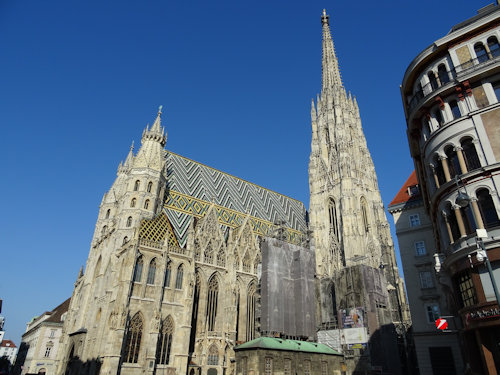
(…and end at the cathedral)
If you prefer a more rural wander around the city, Vienna has numerous formal and clearly-marked hiking routes . Most take you into the surrounding woods and hills, with a couple of notable exceptions (like the social housing walk).
Since Vienna has dozens of certified tour guides willing to take you on all sorts of trips, I would simply send you to three other websites:
- City tours *: various scheduled tours in Vienna for direct online booking. Many on foot, but also bus & bike tours
- Findaguide.at : the Chamber of Commerce directory of guides you can hire
- Guides-in-vienna.at : directory of the Association of Licensed Guides in Vienna
With few exceptions, working as a tour guide in Vienna needs a state license (awarded after completing a lengthy training & education programme and then passing an exam).
A strong alternative to a general guided walking tour is, of course, one of the hop on hop off bus services .
Themed tours
Aside from any specialist tours provided by the above, I have a few articles and links for those looking to explore particular themes. We begin with…
History & architecture
Many locations offer their own specialist in-house tours , notably the two Habsburg palace complexes, the cathedral, the Spanish Riding school, and traditional music venues like the State Opera House or Musikverein.
Architectural epochs
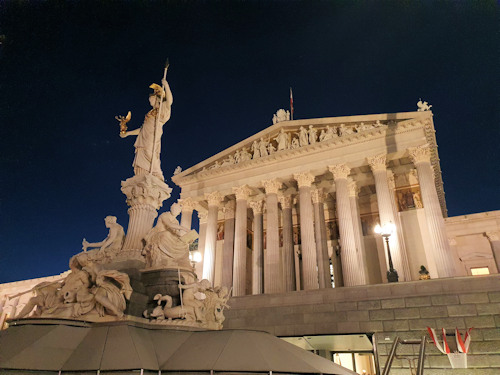
(The refurbished parliament building, constructed in the Hellenic style)
Within the following introductions to architectural and design eras relevant to Vienna, you’ll find tips on where to see examples.
- Baroque : an ostentatious style from the 1600s and early 1700s. Several of Vienna’s more popular palaces and churches date back to this period.
- Biedermeier : a more conservative, homely approach that developed in the first half of the 19th century as a consequence of what we’d probably call a police state today.
- Historicism : where architects and designers drew inspiration from the past. Particularly popular in the second half of the 1800s, which explains all the neogothic, neorenaissance and similar buildings from that time.
- Jugendstil : Vienna’s Art Nouveau movement whose heyday was the late 1800s and early 1900s. The pedestrianised centre has notable architectural examples , as does the rest of the old town .
Other themed historical location tips

(The Sisi memorial in the Volksgarten park)
- Empress Elisabeth : explore those sights closely associated with the famous Sisi , including her apartments and a dedicated museum
- Vienna Modernism : Vienna’s creative flame probably burned brightest around 1900 (though my current calender and to-do list are a remarkable experiment in modernist creativity).
- Jewish Vienna : the article covers significant locations.
- Social housing : experts consider Vienna a role model for urban development, thanks in large part to the availability of high-quality city-owned housing. This harks back to the remarkably farsighted social housing projects of post-WWI, whose legacy remains in the cityscape.
Music and art
As mentioned above, major concert venues have in-house tours. I can particularly recommend the tour of the Staatsoper . Quite apart from the gorgeous interiors, the guide has enough anecdotes to fill a 5-hour Wagner opera.
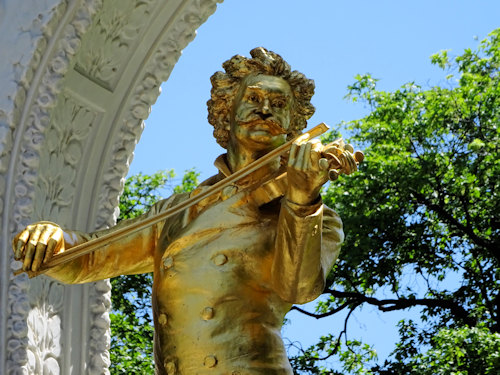
(The golden Strauss monument)
A musician-themed walking tour is very easy. Just stand anywhere in the older parts of Vienna and look around. Chances are you’re next to where some baton-wielding giant of classical music lived / died / composed / played (not necessarily in that order).
But for detailed tips on places to see, I have a famous footsteps page that lists locations for Mozart, Beethoven, Strauss (II), Haydn, Schubert, Brahms, Mahler, Liszt, Lehár and Bruckner.
Most of the composer guides split into three sections: life locations (residences and similar), music locations (venues for premieres and similar), and memorials & more (monuments, museums and similar).
Artists & architects
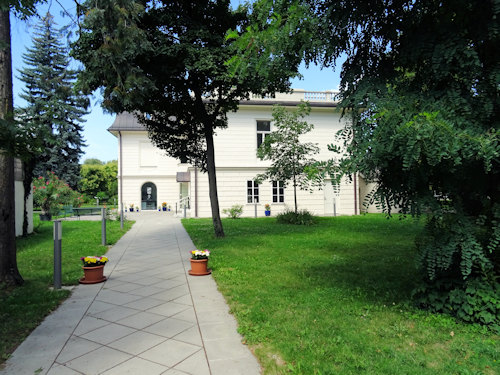
(Gustav Klimt’s final studio)
That same On the trail of… page also has location guides for the artists Gustav Klimt and Egon Schiele, the artist/architect Friedensreich Hundertwasser, and the architect Otto Wagner.
All the guides cover places to see their works (or buildings in the case of Wagner and Hundertwasser) and those places associated with their life and legacy.
Vienna All-Inclusive Pass
As a final tip, the Vienna All-Inclusive Pass from Go City is the tourist pass with the greatest focus on tours and activities. At the time of writing, for example, it included one-time free access to 10+ walking, bike and bus tours.
11 Top Walking Tours of Vienna Austria in 2024
Vienna, Austria is a gorgeous city full of ornate palaces and wide boulevards. It is packed with history, from the Hapsburgs and the Austro-Hungarian Empire, through Anschluss and World War II. So much has happened on these streets and behind these palace walls. A walking tour of Vienna is a great way to not only get to know the old town but to learn more about this complex history and the cafe culture Vienna is known for.
We spent a month in Vienna with our kids, walking the streets, visiting the top sights, and of course tasting some of the famous pastries! We also had my parents visiting for the holidays, so we were three generations all learning about this city together.
In this post, we’ll cover the best Vienna walking tours, these five-star tours range from classic Vienna old-town walking tours that are a terrific introduction for first-time visitors, to in-depth tours that cover the history of a specific period. You might also like a market and food walking tour or even a dessert and pastry walking tour.
This article may contain affiliate links, which means we may earn a small commission if a reader clicks through and makes a purchase. As an Amazon Associate, we earn from qualifying purchases at no additional cost to you. All our recommendations are our own and are in no way influenced by any advertiser or commercial initiative.
At the bottom of this post, download free Mobile Wallpaper images to satisfy your wanderlust!
If you are interested in budget travel to Europe, join our free Facebook Group: Europe Travel with Families on a Budget .
Editors Pick: Best Classic Old Town Walking Tour of Vienna Book our Top Pick: Vienna Old Town Highlights Walking Tour
Table of Contents
Why Take a Walking Tour in Vienna Austria?
A walking tour of Vienna is a great introduction to Vienna for first-time visitors. A classic old town walking tour will cover the basic history of the city, from the famous Empress Sisi and the Hapsburg Empire to the bombings during World War II. As the capital city of Austria and the former capital of the Austro-Hungarian Empire, so much has happened here.
For those who are already familiar with Vienna, historical walking tours or food tours offer a way to learn more about Austrian culture- from sites specific to Hitler and World War II, to a Christmas market tour focused on Austrian holiday traditions.
All of these walking tours are best if you can arrange them toward the start of your visit to Vienna. On a walking tour, you’ll pass by many interesting sites, but usually not go inside, so you’ll want time to return to places that interest you.
Walking tour guides are also wonderful sources of local information, and will often give you tips on where to eat and where to go in Vienna that will be useful for the remainder of your visit.
Quick Guide: The Best Walking Tours of Vienna Austria
Vienna Old Town Highlights Walking Tour
⭐ ⭐ ⭐ ⭐ ⭐ 2 1/2 hours, 6 People or Less
Hitler and WWII Walking Tour of Vienna Covers Hitler’s time in Vienna, Anschluss, and WWII
Vienna Food, Coffee, and Market Walking Tour
6 Hour Market and Food Tour Includes Lunch and Drinks
11 Best Walking Tours of Vienna Austria
These are the best walking tours of Vienna, from the classic old town walking tour that helps you navigate and understand the city, to historical tours that dig deeper into Vienna’s tumultuous past.
We’ve also got the best Vienna Christmas market tours, a Jewish heritage tour, and of course, several food and pastry tours! We found that Vienna is a largely flat city, which makes it very easy to walk around.
1. Old Town Highlights Classic Vienna Walking Tour
🌟 Rating: 5 Stars ⏳ 2 1/2 Hours ✅ Very Small Group, City Center 🔎 Check Rates
This highly rated, very small group tour starts at the Albertinaplatz, home to the Albertina Museum, and visits such iconic places as St. Stephen’s Cathedral, the Hofburg Palace complex, the Volksgarten (a park known for its roses), and the Vienna State Opera House.
“ Highly recommend this tour if you’re into history, architecture and the best places to get coffee in Vienna! Our guide was amazing and very informative. “ eva_T ( Read more reviews )
This classic walking tour of Old Town Vienna is limited to 6 people or less, you’ll get a very personal experience. This is the perfect introduction to Vienna and the history and culture of Austria.
We love this tour for all ages- if you have older family members visiting with you, this tour is a great introduction for everyone.
Book Now: Old Town Highlights Classic Vienna Walking Tour
2. Vienna City Center Small Group Walking Tour
🌟 Rating: 5 Stars ⏳ 2 1/2 Hours ✅ City Center, Small Group 🔎 Check Rates
On this walking tour of Vienna’s city center, you’ll see the highlights of the old city, from St. Stephens to Graben Street and the Hofburg.
You’ll also visit a few places you might miss on your own- like the former residence of Ludwig van Beethoven, and the Frestel Passage, which is even more interesting with a bit of explanation and history.
“ Wonderful tour given by our guide Dace! We learned so much Austrian history and architecture. She gave us so much tidbits to keep even my teens engaged. We loved this tour on a VERY hot day. “ jabina_R ( Read more reviews )
This tour ends at St. Stephen’s Church, so you’ll be free to explore more from there. This tour has more than 600 5-star reviews. It is limited to 15 people or less, so a fairly small group for a walking tour.
Book Now: Vienna City Center Small Group Walking Tour
3. Historical Walking Tour of Vienna
🌟 Rating: 5 Stars ⏳ 3 Hours ✅ Led by a Historian, Small Group 🔎 Check Rates
This historical walking tour of Vienna starts at Michaelerplatz, where you’ll learn about the city’s kings, queens, and revolutionaries while viewing the ornate architecture of the Hofburg Palace. You’ll head down the famous streets of Kohlmarkt and the Graben to visit Stephansdom, the central Cathedral.
“ We enjoyed the history along with the anecdotes about various elements of Austrian and Viennese history like the kidnapping of Richard the Lion Hearted. This was our best walking tour by far on our trip across Europe. “ richard_S ( Read more reviews )
This walking tour also includes the old city walls, Belvedere Palace, the Museums Quartier and Maria Theresien Platz, as well as the Naschmarkt. Since this is a slightly longer tour than others, you’ll cover a bit more ground. This is a very small group, with a maximum of 8 travelers.
Book Now: Historical Walking Tour of Vienna
4. Vienna Food, Coffee and Market Walking Tour
🌟 Rating: 5 Stars ⏳ 6 Hours ✅ Food Tour, Includes Lunch 🔎 Check Rates
On this 6 hour market tour you’ll learn where the locals eat and shop. This tour starts with a Vienesse breakfast of coffee and strudel and then works its way from the city center to the bohemian district of Mariahilf, and then back through the Naschmarkt market.
You’ll visit Vienna’s longest street market, and have a typical Austrian lunch including dessert and local wine or beer.
“ Lots of amazing food, history and laughter. You will be truly stuffed by the end of this tour so bring your appetite. Highly recommend this tour. “ kimberly_P ( Read more reviews )
This tour provides plenty of tastings, travelers report being stuffed! You may take public transportation for part of this tour. The maximum group size for this walking tour is 16 people.
This is the tour for foodies! You’ll go really in-depth, and eat your way through the city. My kids always make fun of me for buying all the snacks and local specialties.
Book Now: Vienna Food, Coffee and Market Walking Tour
5. Vienna Pastry and Dessert Walking Tour
🌟 Rating: 5 Stars ⏳ 3 1/2 Hours ✅ Pastry and Dessert 🔎 Check Rates
This 3 1/2 hour walking tour explores the sweet side of Vienna’s famous cafe culture. You’ll visit some of the best bakeries, pastry shops, and chocolatiers in the city. But don’t worry about having too many sweets, your third stop will be a savory stop where you’ll enjoy schnitzel or dumplings, so you’ll be ready for more desserts!
Simply the BEST tour we did in Vienna. Incredible food while learning about life in Vienna. Each stop brought us to parts of the city we would have never thought to visit. Such an amazing and thoughtful host/guide!” shawn_F ( read more reviews )
This walking tour in Vienna gets solid 5-star reviews, while you’ll mostly be walking, you may take public transportation between areas of town. This is a small group tour, expect to have ten or fewer travelers.
We love trying all the delicious pastries in Vienna- this tour gives you an excuse to do that for a few hours!
Book Now: Vienna Pastry and Dessert Walking Tour
6. Vienna Christmas Markets Walking Tour
🌟 Rating: 4 1/2 Stars ⏳ Up to 3 Hours ✅ Christmas Markets, Small Group 🔎 Check Rates
This walking tour of Vienna’s Christmas markets is a small group tour that includes four lovely Christmas markets, each of which is quite different. You’ll start at Mariahilfer Kirche, then head to the Spittleberg market, then to the MuseumQuartier, one of the hippest markets, and then end in Maria Theresien Platz at the Christmas Village there. Throughout the walking tour, you’ll learn about Christmas in Austria- from local traditions to specialty foods.
“ What a wonderful way to visit a few of the Christmas Markets with a local guide. We were able to see some of the markets that were more intimate with organic food and drinks from local merchants. “ ingrid_S ( Read more reviews )
Drinks and snacks are included, so you’ll have a chance to taste some of the most traditional foods at the Christmas markets. This walking tour has a maximum of 20 travelers, children are welcome, but guests must be 18 or older for alcoholic drinks (non-alcoholic are also available).
Book Now: Vienna Christmas Markets Walking Tour
The Christmas markets are such a fun part of the Vienna experience in the winter, we loved visiting each and every one!
7. Private Vienna Christmas Market Walking Tour
🌟 Rating: 5 Stars ⏳ 2 1/2 Hours ✅ Christmas Markets, Private Tour 🔎 Check Rates
Take a walking tour through the Old Town where you learn about Christmas traditions and visit Vienna’s famous Christmas markets. On this private tour, you’ll start at the Art Mart at Karlskirche, stroll along the famous pedestrian street Graben past the Hofburg Palace, and visit the most traditional Christmas Market at Freyung.
“ Walter was a great guide. The tour was interesting and the markets were really fun! It was just the right amount of time and walking. “ melinda_F ( Read more reviews )
This private tour can be customized to your interests, or you can choose specific markets. You’ll end your tour at the world-famous Rathausplatz Christmas market, the largest of the Vienna Christmas markets, where you can continue to explore on your own.
Book Now: Private Vienna Christmas Market Walking Tour
Visiting Vienna in Winter? We’ve got the best things to do in Vienna in December as well as a full guide to the Vienna Christmas markets . We’ll help you figure out where to visit and what to eat!
8. Hitler and WWII Walking Tour of Vienna
🌟 Rating: 4 1/2 Stars ⏳ 2 1/2 Hours ✅ Hitler, WWII Focus 🔎 Check Rates
This WWII walking tour focuses on the history of Vienna from Hitler’s time in the city as a youth (where he was rejected from art school), through Anschluss, to the end of World War II. This tour includes visits to the Jewish synagogue, as well as the Memorial to the Austrian Jews killed in the Holocaust.
“ Very knowledgeable about the historical involvement of Vienna during WW2. Kept everyone engaged and provided insight of Hilter’s life in Vienna. Highly recommend this tour to every age group. “ angiekrebs ( Read more reviews )
You’ll also see areas of the city damaged by bombing during the war, including where the Metropole Hotel stood. This hotel became one of the most brutal Gestapo headquarters during the Third Reich. This tour has a maximum of 25 travelers.
This is a great tour for families with slightly older kids, who can handle this difficult history.
Book Now: Hitler and WWII Walking Tour of Vienna
9. Vienna Poverty and Homelessness Walking Tour
🌟 Rating: 5 Stars ⏳ 2 Hours ✅ Poverty, Ex-homeless Guide 🔎 Check Rates
This tour on poverty and homelessness in Austria is run by an ex-homeless person who can speak to their personal experience as well as to the politics and policies in place in Vienna and throughout Austria today. This is not a history tour, but rather a walking tour focused on the current situation and the contrasts within the city.
“Vlads tour included educational facts, insights in austrian policy, his own story (which was moving as well as thought provoking), and some interactive back-and-forth with the group. This experience will likely stay with me longer than I can imagine at this time.” Fer_T ( Read more reviews )
This tour has over 500 5-star reviews. This is a great way to get off the main tourist track and gain a new perspective on Austria and the city of Vienna. Please note that the tour does not visit shelters or expose homeless people. This educational small-group tour is limited to 15 people.
This is a fantastic tour to get older kids and teens to think differently about the city they are exploring, and their own privilege as a traveler.
Book Now: Vienna Poverty and Homelessness Walking Tour
10. Jewish Culture and Crisis in Vienna Walking Tour
🌟 Rating: 5 Stars ⏳ 3 Hours ✅ Jewish History, Small Group 🔎 Check Rates
This unique walking tour covers the history of the Jewish people in Vienna. Once one of the largest Jewish populations in Europe, you’ll learn about expulsion, genocide, and finally, the revival of the Jewish population in Vienna. This tour also includes information about famous Jewish Viennese intellectuals, from Sigmund Freud to Gustav Mahler.
“ The tour covered a broad history of the Jewish community in Vienna, and Annelie brought every moment alive with her narration and her visuals. She gave us the benefit of her wide range of knowledge and understanding of Viennese Jewish life through the ages. “ susan_K ( Read more reviews )
You’ll visit the site of two synagogues, as well as a holocaust memorial. This tour may use public transportation, it has a maximum of 8 travelers so you’ll always have a personal experience.
Whether you are Jewish or not, this is a timely tour to think about how Jewish history and the greater world around us. Perfect for families with older kids and teens.
Book Now: Jewish Culture and Crisis in Vienna Walking Tour
11. Historical Crimes Walking Tour of Vienna
🌟 Rating: 5 Stars ⏳ 2 Hours ✅ Crimes, Dark History 🔎 Check Rates
This historical crimes tour is a fun take on Viennese history, focusing on tales of crimes and legendary tales of nobles. You’ll learn about the “Bloody Countess” and visit St. Stephens to learn its dark history.
“ There were so many fascinating stories, the explanation was very vivid and it felt like traveling in time.The tour guide is very knowledgeable and knows the stories in depth and is generally very passionate about history. “ besa ( Read more reviews )
This tour may accommodate up to 25 people. It is the perfect tour for fans of dark legends, true crimes, the macabre, or those looking for fascinating behind-the-scenes stories not told in most guidebooks.
This is a great tour for families with teens or preteens who may not be interested in a more traditional old town walking tour, without dealing with difficult or heavy subjects.
Book Now: Historical Crimes Walking Tour of Vienna
What Will I See on a Walking Tour of Vienna?
Vienna is a very safe city , you can walk alone in the central districts during the day and at night without worrying about safety. It is also an easy city to walk around , you’ll find that many of these longer walking tours of Vienna include a short ride on public transportation in between neighborhoods.
There’s so much to see in Vienna, which is one of the reasons we like visiting this city so much. No tour will cover everything, even in the historic center.
Depending on the theme of the guided walking tour, you may see different locations, or have a different focus. However, many of the best Vienna walking tours will include the following locations in the old city.
St. Stephens Cathedral
The tallest church in Austria, Stephansdom is in the center of Old Town Vienna. Its four towers are a landmark in the city- you can go to the top of two of them. The Roman Catholic seat of the Archbishop of Vienna, this cathedral is a symbol of Austria and the burial site of many Habsburgs as well as cardinals and archbishops.
Hofburg Palace
The home of the Hapsburg royal family for more than 600 years, this palace complex started as a Medieval castle and was slowly expanded into almost an Imperial city-within-a-city.
It now contains more than 2,600 rooms that house multiple museums, the Spanish Riding School, the offices of the Federal President of Austria, and the offices of various government ministries.
Vienna State Opera House
The Vienna State Opera House is the opera house with the largest repertoire in the world- they put on a different ballet or opera each evening, necessitating a set change every day. Each season they put on more than 50 different productions. This beautiful building is also the site of the annual Vienna Opera Ball each spring.
The Graben is Vienna’s most famous shopping street. On this pedestrian-only street you’ll find the Plague Column, as well as many expensive stores. This street dates back to Roman times, legend says that Richard the Lionheart walked here.
Rathausplatz
The Vienna city hall, the Rathausplatz is an ornate neo-gothic building that sits in front of a City Hill park famous for its festivals and winter Christmas market. This is part of the Ringstrasse- the outer ring that circles Vienna’s old town.
It is important to note that walking tours in Vienna generally do not enter cathedrals or museums but give you a historical overview, you’ll then want to plan to return to certain landmarks to explore them in more depth.
FAQ: Best Vienna Walking Tours
Yes, Vienna is a walkable city , especially its city center. There are also trams, buses, and trains to get you from neighborhood to neighborhood easily and inexpensively.
Yes, there are free walking tours of Vienna, but of course, tips are expected at the end of the tour. These free walking tours are generally about 2 hours, and give you a basic introduction to Vienna. Many of these tours accommodate groups of up to 35 or more people. These tours are offered to give the tour companies a chance to introduce you to other tours they offer that you may be interested in. Free tours can be great if you are looking for a basic introduction to the city. The walking tours we recommend here are smaller group tours that go deeper into a specific part of Austria’s history or have a more specific theme (such as a food tour).
There You Have It: Best Walking Tours in Vienna Austria
There are so many wonderful walking tours in Vienna, Austria. Which is the best walking tour in Vienna for you? We love walking around Vienna as a family and learning new things about the complicated history of this city.
If you are a first-time visitor, we recommend our top pick: Vienna Old Town Highlights Walking Tour . For food lovers, from schnitzel to pastry, we recommend a day-long food and market tour .
If you are already familiar with Vienna and its history, consider a more in-depth Hitler and WWII Walking Tour of Vienna , or treat yourself to a pastry and dessert walking tour !
Cynthia Matthews von Berg is the founder of Sharing the Wander. She is a passionate traveler, mom, and travel coach specializing in long-term travel and family travel. She and her family embarked on a Family Gap Year in 2021, and haven't looked back.
Similar Posts
Day trip to salzburg, austria: the ultimate one day itinerary (2024), 14 best vienna christmas markets: where to go and what to eat in 2023, vienna in december: 35 magical things to do in winter (2024), is vienna safe a guide for tourists in 2024, is vienna worth visiting 13 reasons to visit vienna austria in 2024, is vienna walkable a guide to getting around vienna, austria in 2024.

Austria > Vienna > Free Vienna Walking Tour
Top 10 Vienna Tips | Suggested Itineraries For Vienna
- Top 10 Things To Do
- Old Town Walking Tour
- Ring Tram Tour
- Schönbrunn Palace
- More Sights
- Best Day Trips
- Helfpful Visitor Tips
- Suggested Itineraries

Old Town Vienna Walking Tour:
Location : Vienna’s Historic City Center Cost : Free, Self-Guided ( Museum and sight costs below ) Style : Do-It-Yourself Walking Tour ( Self Guided ) Start : State Opera House ( Karlsplatz Metro stop ) End : Museum Quarter ( Volkstheater Metro stop ) Walking Distance : 2.5 miles Time : 90 minutes for walk ( with sights 4-5 hours ) Fun Scale : 9.5 out of 10
The heart and soul of Vienna ( Wien ) is by far its beautiful Old Town which is filled with historic sights. Modern buildings mix in with tons of Medieval and Renaissance elements, making the city center quite magical. From cathedrals to beer gardens, and shopping to museums, there is diversity to entertain all travelers. Maybe the best thing about our free Vienna walking tour is that most of Old Town is very compact and easily seen on foot. Because the city center is so easy to walk, we created this free do-it-yourself Vienna walking tour map for you to follow which covers all the best stops with some insider tips. Enjoy our free Old Town Vienna walking tour!
History Of Old Town Vienna:
Settlement of Old Town Vienna began with Celtic tribes in 500BC with a riverfront camp called Castrum. The area grew thanks to the Romans who arrived in 15AD and built a walled military fort in 97AD to ward off Germanic forces. The Roman fort, called Vindobona ( meaning White Village ) took up about 1/3 the area of today’s Old Town. While mentioned in the movie Gladiator, Vindobona was where the real-life Emperor Marcus Aurelius died in 180AD. On this free Vienna walking tour, we will see some of the original Roman ruins, follow the outlines ancient camp’s wall, and give you a better understanding of early day Vienna.
At its peak, Vindobona had 6,000 legionary soldiers in its walled fort and 24,000 civilians in the surrounding suburban area, but was much smaller than the 50,000-person regional capital of Carnuntum. The Hun armies crossed the Volga River into Europe in 370AD and invaded as far west into the Roman region as Castra Constantias ( modern-day Budapest ). This broke down the Limes Road connecting the Roman camps along the Danube and the large regional capital of Carnuntum was sacked by Germanic tribes ( Goths ) in 395AD. By 433AD most of the Northen Roman Empire had fallen apart, the soldiers withdrew, the remaining citizens around Vindobona moved inside the walls of the abandoned camp.
The old Roman camp was refortified including a small castle Berghof Restsiedlung built in 800AD over the thermal baths to help defend against Magyar ( Hungarian ) armies. Shortly after, in 881, Vindobona took the name Vienna ( Wein ) after the Vienna River ( Weinfluss ) which is Celtic for Wood Creek . Under the rule of the Babenbergs and the Habsburg Dynasty ( 1153-1918 ), Vienna’s Old Town wall expanded outward and the city even became the seat of the Holy Roman Empire for over 300 years ( 1483–1806 ).
Vienna truly blossomed into one of the cultural hubs of Europe during the 18th & 19th centuries through the arts, classical music, and opera. The Waltz and Viennese Balls were born here and Vienna’s city center became home to musicians such as Mozart, Beethoven, Brahms, and Strauss.
Emperor Franz Joseph I and his wife Elizabeth ( Sisi ) made the biggest changes to modernize Vienna in the 1800s replacing the Medieval wall with the Ringstrasse Boulevard, fixing up nearby palaces, and tearing down homes in the Old Town to make way for new grand buildings. During this transformation, the Austrian Empire and Kingdom of Hungarian were merged and Vienna’s population quickly grew. While losing two World Wars greatly stunted city’s 200 years of booming progress, a modern second coming has made the historic Old Town Vienna a world class place to visit once again.
Free Vienna Walking Tour:
1. vienna state opera house ( staatsoper ):.
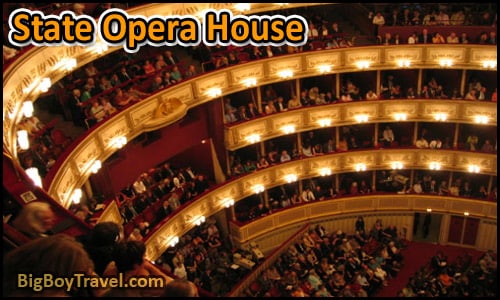
About The State Opera House : In a city famous for music and the arts, it is the grand Vienna State Opera House ( Staatsoper ), that definitely takes the prize. Opened in 1863, this gorgeous 1200 seat theater has housed some of Austria’s most famous classical musicians and still hosts over 300 performances a year. The beautiful theater and grand common areas make touring the Opera House amazing. If you are looking to catch a show, you can expect to choose from famous operas, ballets, and can even take part in large Viennese Balls each February.
This monument to music is the perfect place to start our free Vienna walking tour as the arts have been such an important part of the city’s culture and history. It was in Vienna where the Waltz was born and where Mozart wrote his famous opera The Marriage of Figaro. The building of the opera house was part of a larger protect in the mid-1800s where the Emperor replaced Vienna’s Medieval moated wall with grand buildings and a modern boulevard known as the Ringstrasse. Will will revisit the Ring Road at the end of this walking tour.
Guided Tours : 9€ for Adults; 4€ for kids; also includes the Opera Museum; 1-6 tours daily ( check website ). Tour is great and brings you to a lot of backstage areas. Live Performances : Tickets range from 16-215€, can be bought online , and go fast. Ticket Tip : If a show is sold out or if you just want a taste of a show without sitting through a 3-hour opera or ballet, they sell 567 standing room tickets the day of each performance, 160 of these tickets are right below the Emperor’s Box. Standing Room tickets are cheap, 2€ upstairs and 3.50€ downstairs, and allow you to easily leave when you’ve had your fill. These tickets go on sale 60 minutes before each show at the front door and 80 minutes before the show inside the side door at the Standing Room ( Stehplätze ) booth which always has a short line. Interactive 360 Degree Tour : ( 360 Degrees During a Viennese Ball ). Opera House Website : ( HERE ).
2. Castle Park ( Burggarten ):
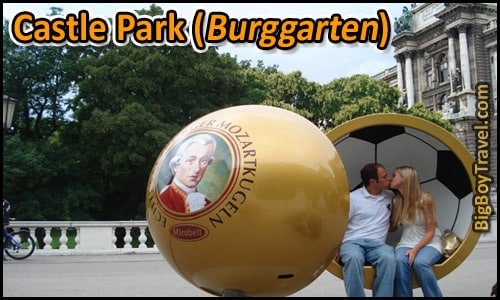
About Burggarten : Covering the entire backside of Hofburg Palace’s Neueburg wing is the large and peaceful Castle Park ( Burggarten ). From the 1200s through the 1500s, the Castle Park you see today part of a wide protective moat that circled Vienna’s Medieval city wall. It was these strong defenses that protected the city and stopped the Ottomans from taking over Europe in Siege of Vienna in 1529. After some further attacks in the mid-1600s, this Western section of the city wall was bumped outward to create a buffer zone for the nearby Hofburg Castle which also allowed the castle to gradually expand into a sprawling multi-wing palace.
By 1710, there was a vast private Royal park that started here and stretched a 1/2 mile to the Northwest along the inside of the expanded city wall. With the new found space in this huge Castle Park, the Habsburg rulers were able to build over their former private park, called the Paradise Royal Garden , to establish the Winter Riding School and National Library. We will visit both the riding school and library later on this free Vienna walking tour.
In 1806, Napoleon Bonaparte and his French forces heavily damaged the city wall and bastions near Castle Park before occupying the city, declaring an end to the Holy Roman Empire , and later marrying into the Habsburg family in 1810. A new curtain wall was added to repair the damage left by the French and Emperor Franz Joseph I got to work transforming this section of the park into a fenced-off private English Garden . During the park upgrades, around 1819-1820, Emperor Franz Joseph I had a statue of himself on a horse moved from the old Paradise Royal Garden to the pond in Castle Park. Cast in 1781, the statue is the oldest equestrian statue in Vienna and still a focal part of Castle Park.
Today the Castle Park has an awesome backdrop of the enormous Neueburg wing of Hofburg Palace ( built from 1881-1913 ), which was we will visit later on this free Vienna walking tour. The new building divided the Royal park in two separating the English Garden which forms today’s park from the rest of the grounds.
Just five years of Neueburg was finished, the monarchy fell in 1918 and the private Castle Park became a public park almost overnight. More statues were brought into Castle Park from around Vienna after WW2 including one of Hercules originally cast in 1770. Our favorite piece that was brought in is the white-wash Mozart statue which was carved in 1896 and previously sat in nearby Albertina Square. Make sure to take time to relax in the park just like the Viennese royals used to do.
3. Palm Tree House ( Palmenhaus ):
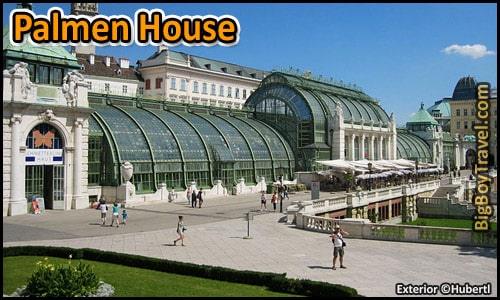
About The Palm House : While revamping his private Castle Park in 1823, Emperor Franz Joseph I also had a huge two-winged greenhouse built on the Northeastern end of the royal garden dubbed the Palmen House. This gigantic greenhouse was built right over the foundation of a section of Vienna’s Medieval city wall that dated back to the year 1200. The Palmen House was a huge luxury for the royal family as it was able to grow tons of tropical plants and palm trees even in the coldest Austrian days.
In 1902, the Palmen House was expanded to over 22,000 square feet and remolded in its current Art Nouveau-style . In modern times, the Palmen House has been turned into a really unique restaurant where you can eat under the palms trees even in the dead of Winter. Especially if you have kids with you, consider stopping at the tropical Butterfly House ( website ) which is attached to the North side of the restaurant.
Palmen House Restaurant Hours : Monday-Friday 10am-Midnight; Saturday 9am-Midnight; Sunday 9am-11pm. The outdoor terrace bar is open until 2am in Summer. Restaurant Website : ( here ). B utterfly House Cost : Adults 7€; kids 4€.
3. Albertina Museum :
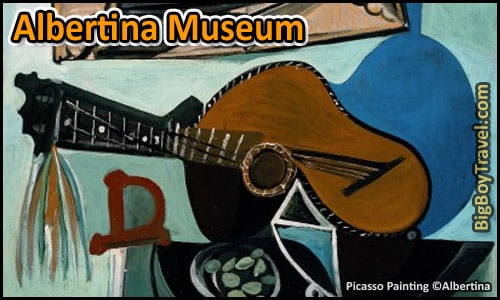
About The Albertina Museum : The Albertina Museum is a breath of fresh air house priceless art inside a stately villa. The most prized pieces are the works by Albrecht Dürer including the Young Hare from 1502 ( original is displayed twice every 5 years, but an exact copy is shown daily ). Other paintings & sketches include works by Monet, Picasso, Chagall, Klimt, Raphael, Warhol, and Rubens.
Like the Palmen House, the Albertina Museum was built over part of the early-Medieval wall section ( called the Augustine Bastion ) dating back to the 1200s. The property first served as the office for the Royal Court Building Authority before it was rebuilt as a mansion for Count Emanuel in 1744. This stately villa was later gifted to Duke Albert by Emperor Franz II in 1794. After moving in, the powerful Duke Albert started to display his private collection of works from old world master painters in the mansion which laid the groundwork for today’s museum. The works include the artists Da Vinci, Michelangelo, Dürer, Rembrandt, and Ruben.
Over the generations the Duke Albert’s family owned the villa, the back of it was expanded into parts of the neighboring Augustiner Monastery . The historic Augustiner Church was the only part of the block-long monastery complex ( built in 1327 ) which was spared from the expansion of the Albertina Mansion. The church is famous as the location of many of the Habsburg imperial weddings including that Marie Louise to Napoleon Bonaparte in 1810. The Augustiner Church also holds the hearts of the former Hapsburg rulers.
The most famous of the 20 staterooms added onto the villa are the ones built for Maria Christina ( 1858-1929 ), the only one of Marie Antoinette’s siblings who was allowed to marry for love. The opulent rooms are typically called the Spanish Apartments because of Maria Christina’s marriage to the Spanish King Alfonso XIII. Her sister Marie Antoinette even stayed in the apartments before being sent off to France for her arranged marriage with King Louis XVI. Our favorite of the staterooms is the Hall Of Muses which is ringed with Greek statues and lit with 5 crystal chandeliers holding 258 candles.
Make sure to check out the wonderful bronze statue of Duke Albert on the terrace near the museum entrance. At the street level below the statue, there is also a magnificent fountain depicting the river God Danuvius and the embodiment of Vindobona, Vienna’s name in Roman times.
Museum Cost : 16€ for Adults; 19-26 years old 11€; Children under 19 are free; guided tour 4€. Online Tickets : To skip the line and get a mobile-friendly ticket you can book HERE . Museum Hours : Daily from 10am-6pm; until 9pm on Wednesdays & Fridays; best after Noon. Museum Website : ( here ).
4. Sacher Café :
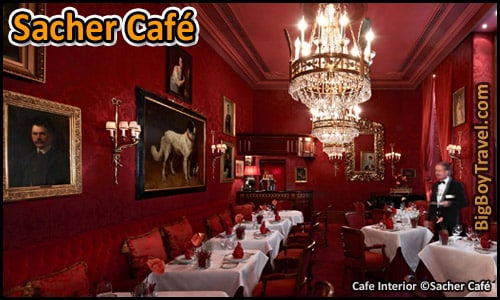
About Sacher Café : Sacher Café is known for having the best slice of chocolate cake you can find anywhere. Their world-famous cake , known as the Original Sacher-Torte, was the creation of chef Franz Sacher who was asked to make a dessert for a Hapsburg royal party in 1832 while only 16 years old. Word of the Sacher’s amazing cake spread and he quickly became a household name.
Forever known as the family of rich cake, Sacher’s son Ed opened the Sacher Hotel and Café in 1876 and spared no expensive decorating every elegant detail. When Ed died 16 years later, his wife Anna took over and pushed the property to gain global recognition as one of the best hotels , all while continuing to sell the famous cake of course.
The Gürtler family has been running the Sacher Hotel and Café since 1934 and it remains one of the very few privately owned five-star luxury hotels in the World. The Sacher Café has been the meeting point for famous figures from Gandhi, and Queen Elizabeth II to John F Kennedy. A visit to Sacher is truly a must while in Vienna and even if you are on a budget just 8€ can get you a really good coffee and an excellent slice of cake.
Inside the Sacher Hotel, there are three different colored fancy salons for dining in addition to the main cafe plus the 2-story Eck which views over the Opera House. If there are crowds hoarding the fancier dining area of the cafe consider buying your Sacher cake at the neighboring Sacher Stube Café which is run by the same family. If you are confused and which coffee goes best with the cake, the traditional drink in Vienna is hot black coffee with foamed milk and whipped cream.
Hours : Daily 8am-Midnight. Photos : ( Treat Photos via their Facebook Page ). Restaurant Website : HERE . Cafe Website : HERE .
6. Anti-War & Fascism Monument :
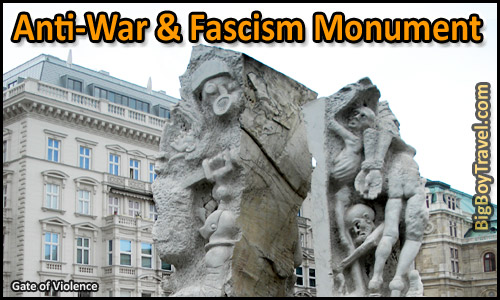
About The Monument : In the late-1800s a huge luxury apartment complex named Philipphof was built right in the middle of this large open courtyard overlooking Albertina Square. Previously the courtyard had been a Medieval pig market before being turned into the apartments in 1882. During the construction, they found even more history when they dug up an ancient Roman grave and a 21-foot section of Roman road.
Sadly in the height of WW2, hundreds of residents sought shelter in the basement of the Philipphof Apartments and were buried alive in an air raid on March 12th, 1945. The bombing was so heavy that most of the victims’ bodies couldn’t even be recovered from the rubble. With the memory of the war victims in mind, a series of statues were erected in 1988 on the site of the former apartment which now serves as the Anti-War and Fascism Monument.
The Anti-War Monument is primarily made up of four artistic pieces which highlight the violence and tragedy that Austrians faced in WWII while under Nazi rule. The most predominant part of the monument are the two large carved marble columns called the Gate of Violence which represent the victims of war and the concentration camps. The graphic images on the columns are actually carved into stone that came from Austria’s Mauthausen Concentration Camp. Another heartfelt piece is the bronze figure kneeling and covered in barbed wired while scrubbing the street which is meant to be a reminder of the humiliation many Jews went through before being more formerly persecuted. There is also a memorial for the people who died in an air raid of the Philipphof Apartments and the final section celebrates a free Austria after the end of Nazi rule.
In 2009, the open square was renamed Helmut Zilk-Platz after the Mayor of Vienna who pushed for the monument to be built in the 1980s. The gravity of a visit is definitely is worth a moment of silence and reflection to take it all in. Knowing the history behind what you are looking at makes the Anti-War & Fascism Monument one of the most moving stops on our free Vienna walking tour.
7. Imperial Crypt ( Kaisergruft ):
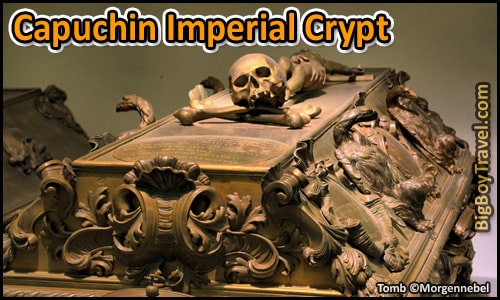
About The Imperial Crypt : The unique and slightly creepy Imperial Crypt below the Capuchin Church is a true must-see on our free Vienna walking tour. The church was part of the Capuchin Monastery, founded in 1617 by the Holy Roman Emperor Matthias’ wife Anna. Just one year later Anna died followed by her husband in 1619 which lead the way for their nephew Ferdinand II to take over as Holy Roman Emperor. In honor of his family, Ferdinand II started work on a royal crypt below the Capuchin Monastery in 1622 which took 11 years to finish because of delays from the 30 Years War.
The tombs of Emperor Matthias and Empress Anna were the first to be moved in the Imperial Crypt which has since been expanded eight times to hold elaborate tombs of some of Austria’s greatest leaders. In total there are bodies of 150 members of the Hapsburg royal family buried at under the Capuchin Church. Oddly it is really only the bodies in the tombs as the Habsburgs’ organs are not buried here . The royal guts are actually housed below Saint Stephen’s Cathedral and their hearts are in the Augustiner Church. While the Crypt has huge visual and photogenic appeal, it is also a very informative experience. The most visited tombs are those of Empress Maria Theresa and Emperor Franz Joseph.
In front of the Capuchin Church is New Market Square which served as one of the main markets in Roman times when this area of town was a civilian settlement just outside the walls of the Vindobona fort. The square was given a makeover as the new city of Vienna was laid out in the 1200s and became it a grain market. The beautiful fountain from the 1700s is called the Fountain of Providence ( Providentiabrunnen ). This is a replica as the original fountain was moved from here to Belvedere Palace because the central statue had a bare-chested lady on it. Many of the buildings surrounding the square were leveled by bombing in WW2.
Crypt Cost : 7.50€ for Adults or 4.50€ for kids. Visiting Hours : Daily from 10am-6pm ( last admission 5:30pm). Guide Tours : Wednesday-Saturday 2pm in German and 3:30pm in English for 3€ extra. Crypt Website : HERE .
8. Carinthia Road ( Kärntner Strasse ):
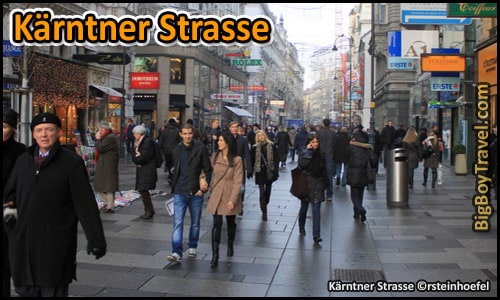
About Kärntner Strasse : Today the pedestrian-only Kärntner Strasse is one of Vienna’s most popular streets lined with great shops and places to eat. If you need to get any souvenirs for yourself or gifts while in Vienna then Kärntner Strasse is a perfect place to look. A stroll down the street offers excellent people watching, window shopping, and even your fix of American fast food, but we suggest sticking to the local cafes to get the true Viennese feel.
Back when Vienna was fortified military camp of Vindobona ( 97-433AD ), Kärntner Strasse cut right through the 24,000-person urban settlement surrounding the fort. Initially called the Strata Carinthianorum , it cut straight South from the fort’s Eastern gate and past the main civilian market. The name Kärntner Strasse comes because the road led to Austria’s Southernmost state of Carinthia ( Kärntner ) which sits on the modern Alpine border with both Italy and Slovenia.
Kärntner Strasse became more important after the 50,000-person regional Roman capital of Carnuntum just 30 miles East of town fell in 395. This caused the North-South trade route called the Amber Road ( Bernsteinstraße ) to be re-routed from Carnuntum right down the center of Vindobona. The route which started in Saint Petersberg, Russia on the Baltic Sea and transferred precious amber to Rome, Greece, and even Egypt in the South with access later to the port of Venice.
While many of the Roman camps never recovered after the Northern part of the Empire collapsed by 433AD, Vindobona was reborn as Vienna ( Wien ) in 881AD . The re-foritifcation and re-settlement of the town was largely thanks to its river access and ability to sustain itself with trade routes like Kärntner Strasse.
The road finally got its own gate into the city when the old Roman walls were expanded outward in 1257 to make way for a growing Vienna. Through Medieval times, Kärntner Strasse even had a drawbridge and bastion over the city’s moat. Over the centuries, modern-day Kärntner Strasse was re-revamped along with the town and has remained one of the busiest shopping streets in Vienna.
8. Staff In Iron Square ( Stock-im-Eisen Platz ):
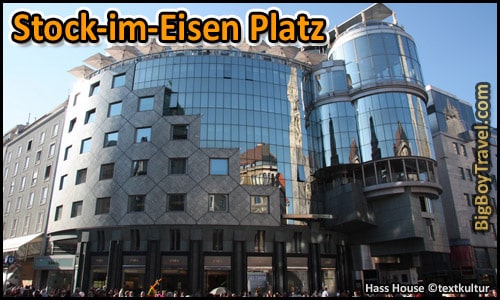
About Staff In Iron Square : As you reach the end of Kärntner Strasse, look immediately to your left and check out the Palais Equitable before getting distracted by any nearby sights. The humongous mansion was built for an American insurance company in 1891 in place of five Medieval buildings on what was once the small square called Staff In Iron Square ( Stock-im-Eisen Platz ). The square, which in ancient times was a Roman cemetery, was named after the historic nailing tree which sits encased in glass on the corner of the Palais Equitable.
The nailing tree ( nagelbaum ) grew nearby in the early 1400s and was used by travelers who pounded nails into it for good luck. The gesture was considered a sacrifice because in the Middle Ages iron nails were quite valuable. While the tree was cut down in 1440, the trunk continued to be used as a nailing tree, was put on display in 1548, and later iron banded by the former homeowner Hans Buettinger. As you inspect the Palais Equitable mansion, you’ll see reliefs on the doors showing the legend of the nailing tree.
In the 1900s, the North side of Staff In Iron Square was opened up to connect to Saint Stephen’s Square which we will visit next on this free Vienna walking tour. The focal point of this new construction is the very modern 8-story tall Haas House with flowing, curved glass walls. The building truly was meant to blend the old with the new as it sits right on the Southern corner of the former Roman camp Vindobona.
During the construction of the Haas House in 1990, it was very controversial that it was built anchored into some of the ancient Roman wall ruins. Make sure to get some photos of the Saint Stephen’s Church reflecting in the windows . If you are not too rushed and want the best view of Saint Stephen’s Church, head to the coffee house on the top floor of the Haas House for a unique perspective. The concept behind the design was to trace the Roman wall and provide a mirror image of Vienna’s largest church.
If you have an extra minute, make sure to go down into the subway station to see the underground Saint Virgil’s Chapel ( Virgilkapelle ) which was unearthed 40 feet below the ground in 1973. The old world chapel was carved out below the former Roman graveyard in 1220 as a private place for the Vienna’s wealthy residents to worship. Greek crosses, which can still be seen on the stone walls today were painted in 1246. In 1338 the funeral Chapel of Saint Mary Magdalene was built above the Saint Virgil’s which then became a bone house. A faint an outline of the former Saint Mary’s Chapel ( burned down in 1782 ) can be seen in the pavement as you approach Saint Stephen’s Square.
10. Saint Stephen’s Church ( Stephansdom ):
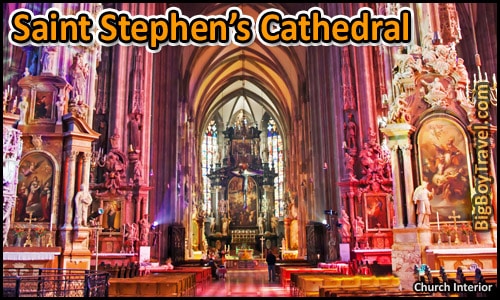
About Saint Stephen’s Church : The massive Gothic-style Saint Stephen’s Cathedral is the focal point and geographic center that modern Vienna orbits around. Saint Stephen’s started as a small parish in 1137 , in a large Roman cemetery in the former civilian area just outside of the walls of Vindobona. While Saint Stephen’s Chapel wasn’t finished until 1160, it was dedicated early in 1147 in the presence of King Otto II who was heading out to join the 2nd Crusade.
From 1230 to 1245, the chapel was completely redone as a larger Romanesque church with an impressive door and towers. Unfortunately, the Romanesque church burned down in 1258, but the front door and towers were saved and worked into the facade of the rebuilt church which was completed in 1263 over the ruins.
Looking at the front of Saint Peter’s today, you can still see the outline of the original Romanesque church towers. Working their way about halfway up today twin peaks you can see the change in the stone as they were extended upward in the rebuild and named the Roman Towers ( Heidentürme ) . The 213-foot-tall towers got their name because they were built using pieces of the former wall of the heathen ( heiden ) Roman military camp called Vindobona. Keep in mind that during the time of the Roman settlement here, the Empire did turn Christian under Constantine so calling them heathen was more of the Medieval Duke’s way of appearing greater than their predecessors.
Saint Stephen’s finally got official Cathedral status shortly after the construction began on the Gothic-style Albertine Choir on the North end of the Church in 1359. The large choir, with three naves, has fantastic Medieval stain glass windows which are the only ones in the church to survive WW2. Instead of merely remodeling the rest of Saint Stephen’s original Romanesque interior to match the Gothic choir, they built a new church around it instead. New sidewalls were added outside of Saint Stephen’s, with a vaulted wooden roof hovering 125 over the floor. After the new walls and roof completely encapsulated Saint Stephen’s Church, the old side walls were simply removed.
By far the most iconic thing to come out of the Gothic-remodel is the mega-sized South Tower called Old Steve ( Alter Steffl ) . At 466 feet tall, the gigantic tower dominates Old Town Vienna from every angle. We highly suggest taking the tiring 363 steps up to the top for the best views of Vienna. If you aren’t up for the hike up the Old Steve, consider taking the elevator up the North Tower ( Nordturm ) instead. The stumpy North Tower was supposed to be a complete match to Old Steve, but construction stopped in 1511 freezing it at 231 feet tall. While excavating for North Tower in 1443, they found a thighbone of a mastodon and placed it above the church’s front door nicknaming it the Giant’s Door ( Riesentor ) .
The North Tower is best known for its large bell, appropriately named Boomer Bell ( Pummerin ) , which famously rings each year at midnight on New Year’s Eve. The was cast out of Turkish cannons after the Siege of 1683, is over 20 tons in weight and 10 feet in diameter. It is considered the 2nd largest free-swinging bell in Europe. From either side tower, you will also get a great view of the brightly colored ceramic tiled roof which replaced the wooden one burn in WW2. The patterns on the roof include a double-headed eagle which is the crest of Vienna.
As you wander around Saint Stephen’s Cathedral there are a lot of exciting details worth noting. We really love the centrally located sandstone pulpit carved in 1510. It shows faces of the four fathers of the Latin Church ( Ambrose, Jerome, Gregory and Augustine ) as well as the artist who carved it peaking through a window near the stairs. Below the Medieval glass windows of the nave is the baroque New City Altar ( Neustädter Altar ) carved in 1447. Near the altar is the tomb of Emperor Frederick III who is one of the only Habsburgs to be buried outside of the Imperial Crypt. Below Saint Stephen’s Cathedral, you can tour the catacombs where the guts of the Habsburgs rulers are stored along with the bodies of Vienna’s cardinals and archbishops. The catacombs also have stacks of bones as bodies were tossed down here during a plague in the 1700s when the cemetery surrounding Saint Stephen’s Church was closed.
Around the Saint Stephen’s exterior, you can see the stark color difference where coal pollution darkened the church’s white limestone and where it has been cleaned. You will also see dozens of headstones from former church cemetery’s worked into the building’s facade. Speaking of death, Mozart had his funeral at Saint Stephen’s in 1791. The famous composer not only spent time working at the church, but was also married here in 1782.
Cathedral Hours : Monday-Saturday 9-11am & 1-4:30pm ( restricted access starting at 6am ); Sundays not until 1pm; Tower Climbs Daily 9am-5:30pm. Cost : Cathedral entrance is free but restricted unless you pay 6€ for the audio guide; North Tower 6€; South Tower 5€; Treasury 5.50€, Catacombs 6€ ( takes 30 minutes ). Discounted Online Tickets : You can skip the lines, save money, and get a mobile combo ticket for the South Tower, North Tower, Cathedral tour, Catacombs Tour, Treasury Tour, and audio guide HERE . Religious Service : Sundays & Holidays at 10:15am, 9:30am in July & August. Tower Access : South Tower via 363 steps or North Tower with elevator. Cathedral Website : ( here ).
11. Mozart’s Vienna Apartments ( Mozarthaus ):
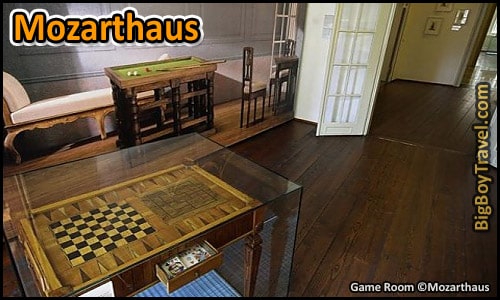
About Mozart’s Apartments : Most of Mozart’s life was spent in his hometown of Salzburg, but he also had close ties to Vienna. It started when Empress Maria Teresa brought the young prodigy in to play a concert at Schönbrunn Palace as a child and continued when Mozart moved here in 1781 to get out from under the thumb of Salzburg’s archbishop.
Mozart was taken in by Vienna’s Archbishop Colloredo and lived his monastery for six weeks in the year 1781 from March 16th until May 2nd. The monastery was built in 1375 for the Teutonic Knights, and its intimate Sala Terrena concert hall where Mozart performed still hold live chamber music performance you can attend. Sala Terrena is Vienna’s oldest concert hall and was painted the Venetian late Renaissance style in the mid-1700s making it a fantastic place to hear a string quartet.
After leaving the monastery in 1781, Mozart moved in on the Graben near Saint Peter’s Square with the Weber who was in Vienna from Mannheim, Germany. Mozart had met the family in German in 1777 where he tried to court the daughter Aloisa, but ended up marrying their younger musician daughter Constanze in 1782 at Saint Stephan’s Cathedral. The couple moved around before settling on a lavish apartment behind the cathedral known today at the Mozarthaus Museum where they lived from 1784-1787.
The family’s apartment only had 4 main rooms, but with its city center location and rich details cost 450 florins a year to rent which was more than Mozarts dad’s annual salary. Although Mozart was horrible at saving money, he was making a lot of it teaching piano to young aristocrats mixed in with significant commission works. To the sculptured ceiling in the Camesina room. The Mozarthaus Museum is quite popular with theatergoers as the apartment is where Mozart wrote his famous opera The Marriage of Figaro which premiered in Vienna.
Most of the items on display at the Mozarthaus Museum today are from the time of Mozart and not actually his stuff , but it all helps to give a peek into his time here. Tours start on the 3rd floor of the building covering details of Mozart’s time in Vienna. The displays focus on where Mozart lived and performed, who his friends and supporters were, his relationship to the Freemasons, his passion for games and much more. The presentation on the 2nd-floor deals with Mozart’s operatic famous works he wrote while living here, and the apartment on the 1st floor focuses more on Mozart and his family. The basement also has a vaulted ceiling event space that often holds piano concerts.
Mozarthaus Cost : 11€ for Adults, 4.5€ for Children, also has a family rate of 24€ ( up to 2 Adults, 3 kids ). Discounted Tickets : You can save money and get a free audio guide by pre-booking HERE . Mozarthaus H ours : Daily from 10am-7pm; last entrance 6:30pm; least crowded 10am-Noon. Mozarthaus Website : ( here ). Sala Terrena Concerts : 90-minute concerts are on Thurs, Fri, & Sun at 7:30pm and Sat at 6pm. Sala Terrena Website : ( here ).
12. Graben & Plague Monument ( Pestsäule ):
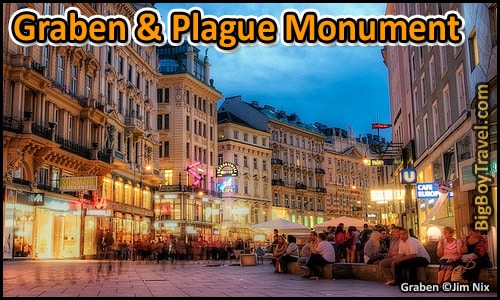
About The Graben : The Graben ( meaning ditch ), was once used as a dry moat by the Romans along the Southern wall of their ancient military camp Vindobona ( 97-433AD ) which pre-dates Vienna. With Vienna’s population growing the graben was filled in and the walls were expanded outward in the 1200s. A King’s ransom largely funded this massive project, and it’s from a tail you may have heard of before.
After fighting together in the 3rd Crusade, Duke Leopold V of Austria captured King Richard I of England ( also known as Lionheart ) over a dispute. King Richard ( of Robin Hood fame ) was held as a prisoner for 14 months from 1192-1194 while his brother Prince John sat on the throne. It’s said that Pince John offered to pay the Duke to keep his brother longer so he could stay on the throne. King Richard, I was finally released after a colossal ransom to the Holy Roman Emperor, of which Austria got 35 metric tons of silver ( worth over $15 million today ).
For the next 60 years, this ransom money was used on projects in Vienna from establishing the Austrian Mint, filling the Graben, building churches, and expanding the city wall. With the wall expansion completed by 1257, the Graben quickly became a market and busy shopping street. The first of two elegant fountains along the Graben is dedicated to Duke Leopold V for getting the money to start the project.
The half-timber Medieval homes first lined the boulevard are now gone, can see the wealth the shopping has generated by the elegant facades of massive buildings that line the Graben. We love walking here as the Graben became Vienna’s first pedestrian-only area in 1974 and it feels built for people watching. If you happen to be in Vienna during Advent ( late-November through Christmas ), you need to put a night-time stop at the Graben on the top of your list as its endless strings of holiday lighting are magical.
Americans visitors often overlook the impact of the epidemics in Europe during the Middle Ages making the Plague Monument ( Pestsäule ) in the center of the Graben an important attraction. The 69-foot-tall column was built in 1693 to honor the 1/3 of Vienna’s population who died in the Plague of 1679 and pays thanks to God for the ones who survived. The golden-capped Baroque column replaced a previous column dedicated to the Holy Brotherhood. It was the Brotherhood of the Holy Trinity who was among the first groups in Europe to use science to stem the plague in a time where religion and superstition trumped all.
Photos : ( Night Time During Advent ).
13. Saint Peter’s Church ( Peterkirche ):
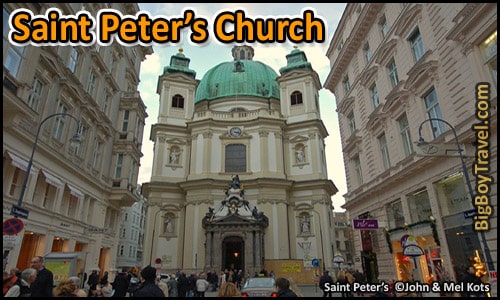
About Saint Peter’s Church : As you turn the corner off the Graben down Jungferngässchen Alley you catch your first glimpse of the green-domed Saint Peter’s Church. Entering the alley, you are also crossing what was once the Southern wall of the Roman fort Vindobona ( 97-433AD ). Local folklore says a larger Romanesque-style church was built here by Emperor Charlemagne between 792-800AD while the former camp was being re-fortified.
While Charlemagne church story may be true, records show that the first church here named Saint Peter’s was finished in 1137 before the original city walls were expanded outward. The church which was later run by the Scottish Monastery which burned down in the late-1600s giving way to the Baroque masterpiece you see today.
Completed in 1732, today’s Saint Peter’s Church is one of the hidden gems on this free Vienna walking tour. We are amazed the builders were able to fit such a large structure tightly tucked into a small square . When you get inside the church, you quickly forget how small the plot of land is that it sits on. This is because the builders used an open layout and unique dome to make Saint Peter’s Church feel huge. Unlike most churches, Saint Peter’s is actually oval shaped instead of round to take maximizing the space to a whole new level.
Most people walk by taking a couple of pictures of the exterior and leave, don’t be one of those people. Take a couple of minutes to step inside, inspect the beautiful marble interior, and see if you can make out the dome’s oval shape.
Hours : Monday-Friday 7am-8pm; Weekends 9am-9pm. Cost : Free. Tours : Daily 9-10am & 1-3pm. Interactive 360 Degree Tour : ( Interior ). Church Website : ( here ).
14. Vindobona & In Court Square ( Am Hof ):
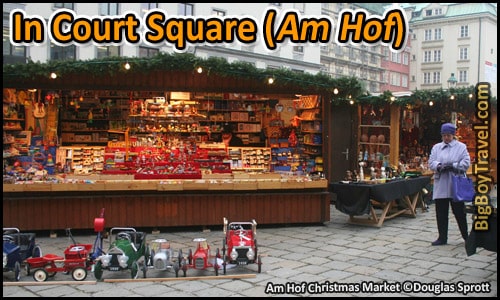
About Vindobona & Am Hof : Lightly settled by the Celts in 500BC, the groundwork for modern-day Vienna was laid out from 15-97AD as a fortified Roman camp named Vindobona ( meaning White Village ). Outlined on our free Vienna walking tour map, the walled Vindobona fort marked the edge of the Roman Empire at the time and was used to help fight off Germanic forces North of the Danube River.
While the nearby regional Roman capital of Carnuntum was much more significant with over 50,000 residents, at its peak Vindobona was home to 6,000 soldiers inside its walls and another 24,000 residence in the surrounding urban area. The most famous moment in the history of the camp was when Roman Emperor Marcus Aurelius died here in 180AD. After the Northen Roman Empire fell in 433AD, the remaining citizens around Vindobona moved inside the walls of the abandoned camp, and the population drastically declined.
The former camp was re-fortified in the 800s including a small Berghof Restsiedlung Castle to help defend against Magyar ( Hungarian ) armies. The castle was built over the Roman thermal baths between the Hoyer Market and Saint Ruperts Church. Shortly after the refortification, Vindobona took the name Vienna ( Wein ) in 881 after the Vienna River ( Weinfluss ) which is Celtic for Wood Creek .
In 1156, Heinrich II of Babenberg was forced by the Holy Roman Emperor to give up his title Duke of Bavaria to Henry the Lion and was named the 1st Duke of Austria by the in return. With a fresh canvass at his disposal, Heinrich II moved to Vienna and built Castle Babenbergerpfalz inside the old Roman wall. The new castle sat right on the foundations of Vindobona’s former barracks and armory in the former fort’s Southwest corner ( where today’s Am Hof Church and Park Hyatt Hotel are ). The large square next to the castle became the city’s 1st established Royal Court ( Am Hof ) . So if you stay in the Park Hyatt ( website ) today, you are not only staying at one of the best hotels in town, but also over the former castle.
The Duke really wanted to impress his wife Theodora Comnena, who was a Byzantine princess, with is new city plans. He used is former home, and capital of Bavaria at the time, Regensburg, Germany as the model to layout Vienna. Under Heinrich II’s rule, Vienna quickly became the 2nd largest city in the Holy Roman Empire behind Cologne, Germany.
Five years after the last Duke in the Babenberg family died in 1246, Ottokar Duke of Moravia ( King of Bohemia ) was elected Duke of Austria and significantly expanded the Kingdom to stretch all the way to the Adriatic Sea. Ottokar also started to expanded Vienna’s city walls outward and built a new four-towered royal castle called Hofburg on the Southern edge of town ( see photo ).
In 1273, Rudolf I of Hapsburg ( King of Germany ) was elected the new Duke of Austria, but Ottokar wouldn’t give up his title which led to his death on the battlefield. Rudolf’s success led to 645 years of Hapsburg rule over Austria including over 300 years as Holy Roman Emperors ( 1483–1806 ). While the royal court was officially moved to Hofburg Castle, Am Hof Square at Castle Babenbergerpfalz continued to be used for jousting tournaments and a market.
While most of the old Castle Babenbergerpfalz was removed, part was rebuilt as the Gothic-style Am Hof Church in 1386. The church was given its current white Baroque facade in 1662, and the Mariensaeule ( Marian Column ) was added to the center of the square. The column, finished in 1667, was commissioned by the Holy Roman Emperor Ferdinand III to thank the Virgin Mary for repelling the Swedish forces during the 30 Years’ War. In 1806, having defeated the Austrian army, Napoleon announced the end of the Holy Roman Empire from the balcony of the Am Hof Church. This move split the former territories up and established the Austrian Empire.
Am Hof Square got a rise in pop culture thanks to the hit 1949 movie The 3rd Man . Many scenes from the famous film take place here from Anna’s door to Orson Welles’ character Harry Lime casting a long shadow in the alleyway North of the Church. In the cellar of the Am Hof Square’s Fire Brigade Building, you can still find the remains of a main brick drain from the ancient Roman sewer system beneath Vienna.
For more Vindobona sites check out the Roman Museum ( website ) under Hoyer Market. Located on one of Vienna’s oldest market squares, the museum has a great collection of authentic Roman era artifacts. The best objects are the intact sections of soldier homes and underground heating they found below the square. We also like stopping Saint Rupert’s Church which is Vienna’s oldest church dating back to 740 and sits near a maze of Medieval streets.
15. Kohlmarkt & Demel Café :
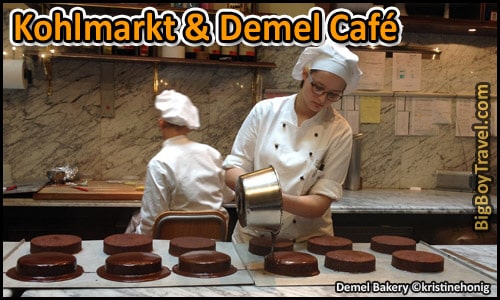
About Kohlmarkt : The prestigious Coal Market ( Kohlmarkt ) shopping lane is home to Vienna’s most luxurious stores . From Tiffany’s to Gucci and Louis Vuitton you’ll find a little bit of everything for today’s high-end buyers. In Roman times, this road led to the main Southern gate tower ( Peilertor ) of the walled fort called Vindobona ( 97-433AD ) which pre-dates Vienna. It was an important road as two blocks outside the walls it intersected with a civilian bypass of the Lime Road ( Limesstrasse ) trade route around the fort before continuing all the way through Linz to Salzburg ( then called Juvavum ).
When the Roman wall was extended outward in 1257, the lane remained vital as it connected the new Royal Castle ( Hofburg ) to the heart of Vienna. While the name Coal Market came from the coal dealers who once set up shop here, it quickly became a prestigious shopping area. Kohlmarkt was soon home to the shops of various jewelers appointed by the Royal Family and gained the nickname the Golden U .
During the 1700s, the street blossomed into a well-rounded, high-end shopping street. Even the original city gate tower, called the Direction Finder Tower ( Peilertor ), also remained an essential feature of Kohlmarkt. Through Medieval times the tower ( rebuilt in 1511 ) served as a watchtower and jail until it was removed for traffic concerns in 1867.
Today the lane is a real treat, especially during Advent when hanging lights give Kohlmarkt a beautifully lit temporary ceiling. While you window shop along Kohlmarkt, the one place you have to make sure to stop at is the Demel Café & Bakery . Dessert artist and baker Ludwig Dehne moved to Vienna from Wuerttemberg in 1786 and quickly impressed the Emperor with his skills. In the bakery’s early days, all the ladies of importance in Vienna came to the cafe to drink a cup of hot chocolate on the first cold day of the year.
Ludwig’s cafe business did so well that it gained the esteemed prefix K. u. K., or König und Kaiser , meaning “good enough for the king”. With Vienna being a trend-setting cafe town, Ludwig’s bakery became a favorite meeting point of the aristocracy as well as of the bourgeoisie. In 1857, Ludwig son August sold the shop to his first assistant Christoph Demel giving the cafe its current name. Even though it is a fancy place, Demel offers a 10€ cake and coffee deal, along with their other amazing chocolates and desserts to make your mouth water.
Demel Hours : Daily 9am-7pm. Demel Website : ( here ).
16. Michael’s Square ( Michaelerplatz ):
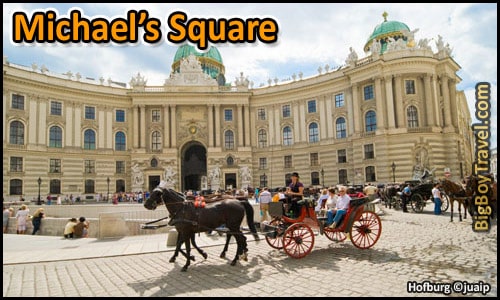
About Michael’s Square : Michael’s Square is dominated by the Baroque facade of Hofburg Palace’s Saint Michael Wing . This huge building was completed in 1889 in place of the old Royal Theater ( Burgtheater ). The former theater had opened here in 1741 inside an unused Royal banquet hall and was where many famous musical premieres took place. These premieres included Mozart’s Marriage of Figaro in 1786 and Beethoven’s 1st Symphony in 1800. While the first sections of the Royal Castle ( Hofburg ) were built near the Square in the mid-1200s, it’s been a critical intersection for nearly 2,000 years .
In Roman times, a civilian bypass of the Limes Road ( Norica Limes ) around the legion fort Vindobona ( early day Vienna ) met the main road into the fort’s Southern gate at Michael’s Square. The intersection also connected to a secondary route to Linz and Salzburg, but the diagonal bypass off the Limes Road ( seen as Herrengasse Street on modern maps ) was the big driver of traffic. The Limes Road essentially marked the Northern border of the Roman Empire while linking the 30 main legion camps along the Rhine and Danube Rivers from the North Sea all the way to the Black Sea.
At the crossroads of Michael’s Square stood a large guarded Roman Legion outpost ( Canabae Legionis ) to help protect the South side of the fort, its 6000 soldiers, and the 24,000 area civilians who lived outside of Vindobona’s walls. Eventually, the Limes Road broke down from hostile invasions ( Huns & Germanic Goths ) and most of the Northern Roman Empire collapsed by 433AD. Vindobona was largely abandoned until it was re-fortified as Vienna in 881AD, but luckily remains from its Roman roots are still easily found.
Ruins of the Roman Legion outpost at Michael’s Square were excavated in 1990, unearthing an entire neighborhood of Roman building foundations and ancient sewers. In addition to the guard houses, the outpost buildings were believed to have included shops, an inn guesthouse, and a brothel. Further excavations around Michaelerplatz have shown that the Romans also had created a long aqueduct to get water from the surrounding hills as well as several canals dug all the way to the Danube River.
The Roman Legion outpost was essentially like a small suburb , although it wasn’t given a town charter. The civilian settlement spread out many blocks from Michael’s Square and foundations of half-timber homes have been found in the courtyard of the Globe Museum ( Herrengasse #9 ), Porcia Mansion ( Herrengasse #9 ), and the Harrach Mansion ( Freyung #3 ). You can see the extent of the civilian settlement centered on Michael’s Square to the South of the square Vindobona fort here .
Before leaving the square, make sure to check out Saint Micheal’s Church which it is named after. First completed as a small Romanesque chapel from 1221-1252, it was rebuilt in 1792 as you see it today. The church is best known for its captivating crypt with the bodies of 4,000 wealthy residents who are buried here with many of them mummified or with open caskets. The crypt is very interesting, but is one of the most overlooked tourist spots on this free Vienna walking tour. Investigating the open ruins and sights around Michael’s Square is one of the best windows into Vienna’s Roman past.
17. Spanish Winter Riding School :
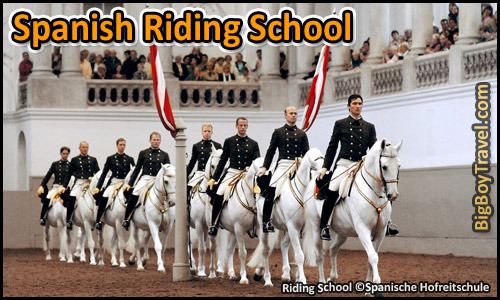
About Spanish Winter Riding School : The Spanish Riding School has been operating in Vienna since 1565 when it was a wooden stable in nearby Josefsplatz Square making it the oldest riding school in the World . The beautiful Spanish Winter Riding School building you see today was built into Hofburg Palace in 1735 in place of the former Paradise Garden.
This historic riding school gets its name from the stars of the show, the delightful white Lipizzaner horses from Spain. Getting accepted into the Spanish Riding School has always been a very prestigious thing. In its early days, the riding school was limited to young aristocrats and royals who used it to practice jousting and horse dancing called dressage. The horse dance training helped the riders the gain agility and control needed military campaigns. Outside of occasional public festivals, watching the horse dancing practices were reserved for the Royal family and guests of the court until the monarchy fell in 1918 which opened the shows up to the public.
Tickets for the horse dancing shows can be hard to come by so make sure to book ahead if possible. Even if you can’t make a dressage show, consider one of the school’s architectural tours that brings you through every nook and cranny of the building including the rafters. In addition to the horse ballet shows, the training space also hosts a series of elegant Viennese Balls throughout the year.
Across the street from the Winter Riding School is the Renaissance-style Royal Horse Stables ( Stallburg ) . The stables were first built from 1559 to 1569 as a mansion for crown prince Maximilian II by his dad Emperor Ferdinand I. Folklore says that the Emperor wanted his son under a different roof as they had differing religious views. The mansion later housed part of the royal art collection which helped to launch Vienna’s Art History Museum. When the new Winter Riding School opened in 1735, the mansion was turned into the official Royal Horse Stables and is now an active museum.
Ticket Office Hours : Tuesday-Sunday 9am-4pm; on Fridays when there is a performance they are open until 7pm. Morning Exercise : Most weeks Tuesday-Friday from 10am-Noon you can watch Morning practice to music for 15€ which is lighter on the jumping. Check the schedule here as some months have training every day. You book at the box office each morning. Main Performances : The full dressage show performances typically happen on Saturday and Sundays at 11am and can sell out far in advance. Standing tickets room start out at 25€ and go up to 135€ for the lower level seats. You can book online here or at the box office. Please note that from late-June through early-August they typically don’t run the full show, but will have practice. Guided Tours : Most afternoons they have 2-5 time slots for 50-minute guided tours of the grounds and stable for 18€ ( kids half off ) with the most time slots on Mondays while the horse training is off. You can book at the box office each morning. Riding School Website : ( Here ).
18. Joseph’s Square ( Josefsplatz ):
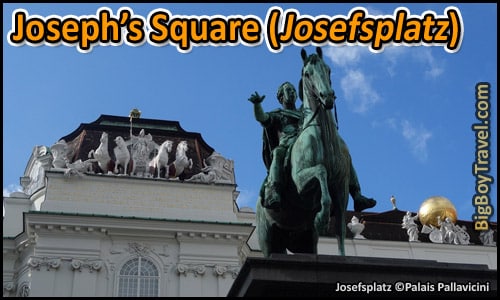
About Joseph’s Square : Before checking out the beautiful National Library, it is essential to inspect the often overlooked Joseph Square ( Josefzplatz ). Today the main feature of the square is the giant equestrian statue from 1795 of Emperor Joseph II in Roman clothing riding a horse.
The equestrian statue is actually a take on an ancient statue of Roman Empire Marcus Aurelius which sits on Capitoline Hill in Rome, Italy. The connection is important both because Marcus Aurelius died in the Roman camp Vindonba ( early day Vienna ) in 180 AD and the Habsburgs always claimed to have a bloodline connection to the Roman leaders. This equestrian statue is also fitting as Joseph Square was once the home to the original Spanish Riding School back when it was just a small wooden structure.
As you circle the square, there are a couple of old mansions that are worth mentioning. The 1st is the beautiful Pálffy Mansion ( website ) which served as a law office in the 1300s, was rebuilt as the home of a banker in the 1600s, and given a new facade after damage from WW2. Mozart performed at Pálffy Mansion as a child and did screenings of this opera The Marriage of Figaro with a small audience before premiering it at the Royal Theater that once sat a block away at Michaelplatz. Every night at 8pm ( except Wednesdays ) you can get tickets for the Vienna Walzer Orchestra which performs for small crowds just like Mozart once did here.
Next door to Pálffy Mansion is the impressive Pallavicini Mansion ( website ) which was once the site of the Queens Monastery ( 1581-1782 ). Unlike Palffy, this mansion was largely untouched by WW2 and serves as a time capsule for Viennese life in the late 1840s.
On the South side of the Joseph’s Square is the former Augustiner Monastery Complex ( built in 1327 ), which still has some of its original inner courtyards and main chapel. The monks had been operating in Vienna since 1260, and Pope John XXII directly approved the building of this complex. The small Loreto Chapel next to the main altar holds the hearts of various Habsburg rulers. Earlier in this Vienna walking tour, we saw the royal bodies in the Imperial Crypt and their guts in Saint Stephen’s Cathedral. The church probably the most famous as the place of many Habsburg imperial weddings including that of Marie Louise to Napoleon Bonaparte in 1810.
19. Austrian National Library :
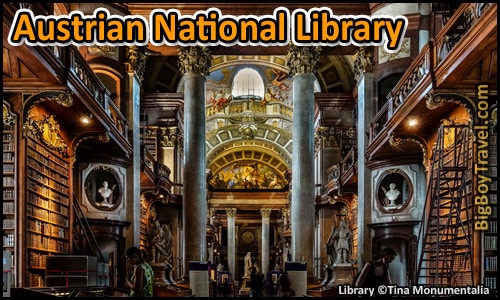
About The Austrian National Library : Built by Emperor Charles and Empress Maria Theresa from 1720-23, the Austrian National Library remains one of the most beautiful libraries in the world to this day. It is easy to find the entrance as the building is capped by a large golden globe supported by a statue of the Greek God Atlas. A walk through the Baroque State Hall is bound to leave any visitor with a sense of wonder.
The library’s marble accents are fantastic and the ceiling paintings are among some of the best for any building of its era. The paintings are so detailed that it’s no wonder they took an extra 7 years to complete after the library was open. The scenes show the virtues of the Hapsburg rulers as well as depictions of their territories.
The Habsburg Dynasty was a dominant one who had already had a private library collection started as early as the 1300s. This meant that the new library was able to be filled with over 400 years of treasures the day it opened. Mix in an over 300-year span where the Hapsburgs served as Holy Roman Emperors ( 1483–1806 ), you have the makings of one of the best book collections in the world . Construction plans even had to be expanded mid-build in the 1700s as the family’s collection continued to grow.
Two of the most popular exhibits run by the library are the impressive Papyrus and Globe Museums. The Papyrus Museum is best accessed through the reading rooms entrance of Heldenplatz ( Stop 21 ) while the Globe Museum is just down the street ( Herrengasse Avenue #9 ).
Library Hours : Daily 10am-6pm; Open Thursdays until 9pm. Cost : 7€ for State Hall; Add for 4€ the Papyrus and Globe Museums; Discounts for kid & families. Audio guide 5€ for 2 people. Library Website : Here .
20. Hofburg Castle’s Swiss Court ( Schweizerhof ):
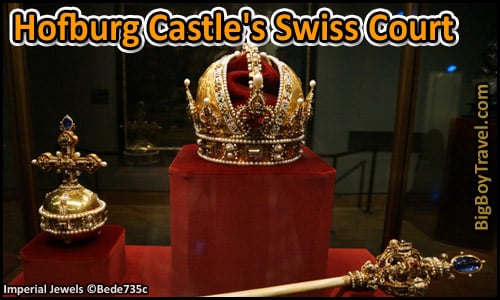
About The Swiss Court : This was the original portion of today’s Hofburg Palace ( or Imperial Castle ), built from 1220 to 1278 as a square Gothic castle with corner towers. The most construction happened along the expanded city walls under Ottokar II who became the Duke of Austria in 1251 and also soon became the King of Bohemia ( 1253-1278 ). After failing to win the Imperial crown numerous times and raising arms about it, Ottokar II was crushed in battle in 1278 and his castle was taken by the Habsburg who ruled Austria for the next 750 years ( 1278-1918 ).
Only fragments of the original castle remain today as it was given a Renaissance makeover in the 1400s. This project included a complete rebuild of the Palace Chapel ( Burgkapelle ) in 1449. A beautiful wooden statue of the Virgin Mary near the altar was carved in 1410 and is quite stunning. The royal chapel was first established in 1296 ( remodeled again in the 1700s ) and is famous for the angelic Vienna Boys Choir ( website ) who have been signing High Mass since 1498. They are one tour in July & August so if you miss out on the Boys Choir, the nearby Augustiner Church ( built in 1327 ) also has music at their 11am religious services.
In 1745, the original castle got another facelift during an expansion of the Palace, and the central courtyard was renamed the Swiss Court ( Schweizerhof ) after the guards who protected the Royal family. This substantial makeover also saw the removal of the corner towers and the castle’s drawbridge which once led to the preserved red-black Swiss Gate ( Schweizertor ) from 1552. The impressive gate displays the Holy Roman Empire’s Imperial Coat of Arms in the variation of the Order of the Golden Fleece which is a secret Medieval fraternity established in 1430. On the ceiling inside the Swiss Gate are murals showing the titles and lands ruled by Emperor Ferdinand I.
The core of the former castle now houses the Royal Treasury in over 21 Medieval rooms. While touring the Treasury, you will see the jewels of the Holy Roman Empire, including the Imperial Crown and the Holy Lance, the Crown of Emperor Rudolf II, and gems including one of the world’s largest emeralds. You will also see a ton of Holy Relics in the Treasury as the Habsburgs had become obsessed with collecting them as a status symbol. There are items from the Order of the Golden Fleece, and Counter-reformation among other secular treasures. Our favorite piece is the giant narwhal tooth from the 1500s which Medieval times was believed to be a unicorn horn.
Hofburg Treasury Hours : Wednesday-Monday 9am-530pm; open until 6pm in July and August; Closed Tuesdays. Admission Cost : 11.50€ for Adults; 10.5€ for Kids; which includes an audio guide. Royal Treasury Website : ( HERE ). Imperial Chapel Hours : Chapel is available for Free Mondays & Tuesdays 10am-2pm & Friday 11am-1pm. Vienna Boys Choir Shows : From September through June you buy a ticket can hear the Boys Choir sign in the chapel most Sundays at 9:15am. Vienna Boys Choir Tickets : You can buy tickets online here or on Fridays in person. Tickets are 5-29€ plus there is free stand room only tickets available for the first 60 people in line. Vienna Boys Choir Secret : You only hear and don’t see the Boys Choir with your ticket, but you can watch it on a screen for FREE in the small lobby to the right of the Chapel entrance. Imperial Chapel Website : ( HERE ).
21. Hofburg Imperial Apartments :
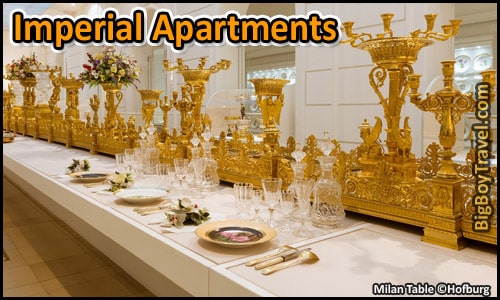
About The Imperial Apartments : The Imperial Apartments are our favorite part of the Hofburg Palace as they were the residential and state rooms used by Emperor Franz Joseph I and his wife Elizabeth , known as Sisi. The apartments are filled with over 165,000 pieces of original furniture from the Hapsburg Dynasty spanning over 300 years. There is also a section for the over-the-top Imperial furniture and a small museum dedicated to Sisi which includes many of her preserved dresses.
If you think the apartments and decor are fancy, just wait until you check out the Royal Sliver Collection ( website ). It seems like there is an endless amount of wealth on display, but they actually only display about 7,000 of the Habsburgs over 150,000 silver and gold items at a time. Our favorite part of the collection is the golden centerpiece spanning the entire length of the 90-foot-long Milan Table . The amazing work was commissioned for the coronation of Emperor Ferdinand in 1838.
Hofburg Palace Hours : Daily 9am-530pm; open until 6pm in July and August. Admission Cost : 15€ for Adults; 9€ for Kids; which includes an audio guide. Guided Tours : A guided tour is required to see the Imperial Apartments and Sisi Museum. They last for 55 minutes, leave daily at 2pm and adds only 2€ to admission cost. Combined Sisi Ticket : The Sisi ticket ( 34€ for Adults; 21€ for Kids ) is the best deal as it includes Schönbrunn Palace, Imperial Furniture Collection, Hofburg with the Imperial Apartments, Sisi Museum, and the Imperial Silver Collection.
22. Hero’s Square ( Heldenplatz ):
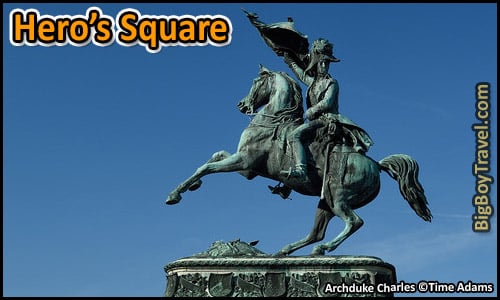
About Hero’s Square : As enter the large Hero’s Square ( Heldenplatz ) you’ll quickly get drawn to the backdrop of the beautiful Neue Burg Wing ( New Castle ), but the square itself is worth investigating. Heldenplatz and 2 other large gardens ( Burggarten & Volksgarten ) were laid out after parts of a Medieval castle wall that stood here were destroyed Napoleonic Wars.
While the other Gardens in Vienna have remained green, most of Heldenplatz has been paved over during the decades. Luckily a couple of the original equestrian statues still remain in the square. The first great statue is Archduke Charles of Austria riding a horse while triumphantly holding a flag. The statue of Charles, erected in 1860, was meant to portray the Habsburg Dynasty as great Austrian military leaders.
While the statue of Archduke Charles is cool, our favorite is of Prince Eugene of Savoy which sits right by Neue Burg’s main entrance. Eugene left France for Austria after being denied entrance to their military for appearance and went on to become the greatest General in Austrian history. He led military campaigns for 60 years over 3 different Holy Roman Emperors based out of Vienna and was very successful. Eugene’s claim to fame with battles over the Ottomans later gaining heavy praise fro Napoleon all while getting super rich from his endeavors. To this day Eugene serves as a point of Austrian pride and willpower.
If you want more of a true garden experience visit the People’s Garden ( Volksgarten ) on the Northern end of Hero’s Square. This garden, featured in our Vienna Ring Tram Tour has a wonderful rose garden, a replica of the Greek Temple Hephaestus ( Theseion ), and a memorial to Empress Sissi.
Before leaving Heldenplatz, make sure to check out the huge gateway going over the road on the South side of the square called Outer Castle Gate ( Äußeres Burgtor ) . The columned gateway is all that remains from a curtain wall built around the Palace in 1817 after the original castle wall was damaged during the Napoleonic Wars in 1809.
This new Palace wall section didn’t last long as it and the entire Medieval wall that surrounded all of Old Town Vienna were torn down in 1860 by Emperor Franz Joseph I to making way for the Ringstrasse loop. This move helped the growing city expand and was part of a large series of enhancements the Emperor made to the City.
23. New Royal Palace ( Neue Burg ):
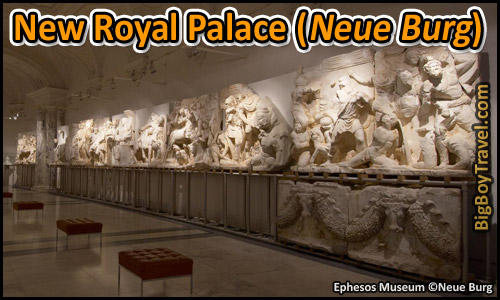
About The New Royal Palace : Emperor Franz Joseph’s had a dream of creating Kaiserforum complex to how off Austria’s might through architecture and arts. As seen in this 1865 mockup sketch , the complex covered the Neue Burg Wing ( or New Castle ) wing of Hofburg Place, the Museum Quartier, and numerous other buildings.
The huge Neue Burg section was started in 1881, but its construction was drug out for over 30 years into the beginning of WW1 which Austria lost, further delaying the project. Because of the lengthy, delays most of the rest of the Kaiserforum complex was scrapped for the most part, but overall the completed buildings are really impressive.
Once inside Neue Burg, it is easy to be in awe of the marble-lined corridors, grand staircases, and our favorite is called the Hunting Plateau which is a common place for weddings. The amazing details of the grand Neue Berg make it the perfect setting for the building many museum collections. The 1st collection that was housed here came from Archduke Franz Ferdinand in 1908 after he got back from an extensive trip around the World. After Archduke Franz Ferdinand was assassinated in 1914, which sparked WW1, his entire collection was given to Neue Berg giving a starting to a series of wonderful museums.
Today the building houses Papyros Museum, Ephesos Museum ( website ) , Collection of Ancient Musical Instruments and the Collection of Arms and Armor ( website ) which takes up the entire Southside. Our favorite of these museums is the Ephesos which has a great collection of classical and even ancient statues. The highlight of the Ephesus Museum is the Parthian Monument, part of an antique altar erected at Ephesus ( modern-day Turkey ) during the Hellenistic Period. In Roman times, Ephesus was the capital of the Province of Asia and one of the largest early-Christian communities in the world with around 200,000 inhabitants.
Neue Burg Museum Hours : Wednesday-Sunday 10am-6pm; Closed Monday & Tuesdays. If you only have time for one museum stop, consider the world-class collection of museums at nearby Museum Quartier instead of Neue Berg. Museum Cost : 15€ for Adults; Children are free; and guided tours are 3€ extra. Your ticket covers all of Neue Burg’s Museum plus the Art History Museum ( Kunsthistorisches ) in Museum Quartier. You can also get a combo ticket to include the Natural History Museum and Leopold Modern Art Museum for a couple of euros more. We’ve bought the combo ticket and they let us see the two museums on different days, but ask to make sure. Neue Burg Website : Here .
24. Museum Quartier :
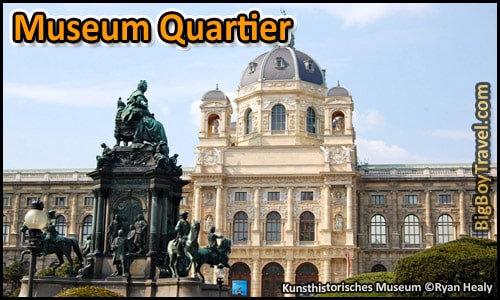
About Museum Quartier : As Emperor Franz Joseph designed his grand Kaiserforum complex, a series of museums built around a park was an integral part of his plans, but is was never fully completed. As seen in this 1865 mockup sketch , there were to be a ton of buildings, but at least the 2 large museums they did finish turned out to be masterpieces.
On the Eastside of the square is the highly rated Art History Museum , or Kunsthistorisches ( website ), which holds Vienna’s greatest collection of paintings covering very fun loving art from over a 200-year span. The Koonst as it’s called, also holds an amazing Egyptian Museum.
The twin building on the Westside of the Maria Theresa Square is the Museum of Natural History , or Naturhistorisches ( website ), whose vast collection holds Austria’s most famous work of art, the 4-inch-tall Venus of Willendorf Statue. This statue depicts a chubby, naked female figure carved into limestone and dates back to 24,000-22,000 BC.
Behind these two massive main museums is a third section worth a stop for any modern art lover, the Leopold Modern Art Museum ( website ) & Mumok Museum . Of favorite piece at the Modern Art Museum comes right away and is an upside down house home smashed into the side of the Museum called House Attack.
Art History Museum Hours : Tuesday-Sunday 10am-6pm; on Thursday until 9pm; Closed Mondays ( except June & August ). Art History Cost : 15€ for Adults; Children and teens are free, but a guided tour is +3€ and audio guide is +4€. Combo ticket with Neue Berg and Imperial Treasury is 20€ -or- with Neue Berg and Modern Art Museum is 24€. Natural History Museum Hours : Wednesday-Monday 9am-6:30pm; Wednesdays until 9pm; closed Tuesdays; best before Noon. Tours in English are every Friday, Saturday and Sunday at 3pm. Natural History Museum Cost : 10€ for Adults; Children and teens are free, but a guided tour is +3€ and audio guide is +4€. Modern Art Museum Hours : Tuesday-Sunday 10am-6pm; Thursdays until 9pm; closed Mondays. Modern Art Museum Cost : 13€ for Adults, students 8€, buy a mobile ticket online HERE . Combo ticket with Kunsthistorisches and Neue Burg is 24€.
Other Sights Near Old Town Vienna:
25. ringstrasse tram tour :.
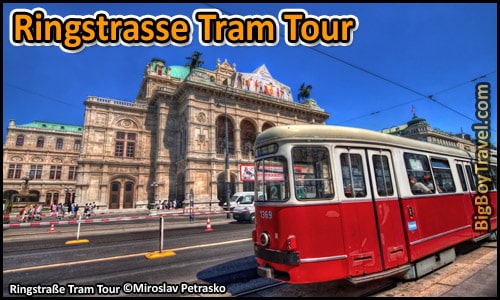
About The Ring Tram : When Vienna’s original Roman wall was expanded outward in 1257, it followed the path of today’s Ringstrasse. This new wall was very heavily fortified with watchtowers & bastions, was surrounded by a moat, and ringed with a wide building-free meadow ( glacis ) separating the city from the suburbs. This protection helped Vienna fight off the Turkish Sieges of 1529 & 1638 which may have saved the rest of Europe from being overtaken.
In 1860, the growing city of Vienna needed more room so Emperor Franz Joseph I tore down the Medieval wall and filled in the former moat that circled old town to create today’s grand boulevard. This was a boom time for Vienna and grand buildings sprung up all along the new Ringstrasse circling around Vienna.
Thanks to a modern system of tram lines, making the mile loop around the Ringstrasse to check out the sights is super easy. The entire loop can be done in less than 30 minutes , but we suggest hopping off at various points to explore and fully experience the Ringstrasse attractions. To help make your trip a smooth one we have put together a great guide to the best sights and tips for using the trams along with a helpful printable map.
Read More : Vienna Ring Tram Tour .
26. Saint Charles Church ( Karlskirche ):
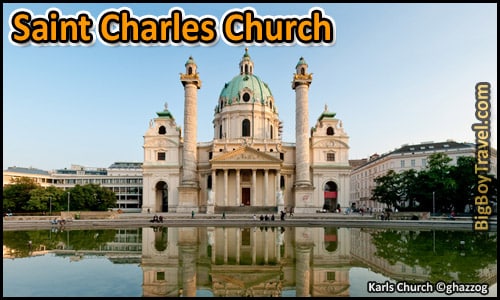
About Saint Charles Church : The giant white St. Charles Church dates back to the early 1700s and is a favorite of photographers with its large green dome and huge reflecting pool . The Church was commissioned by the Emperor after Vienna’s last bout of Plague as he felt that his prayers were the reason why the Plague stopped. This train of thought was a common theme throughout Vienna’s history as after each tragedy the ruling Emperor would use the event as a reason to build an even bigger and more extravagant Church.
Cost : 4€. Hours : Daily 9am-7pm. Website : HERE .
27. Naschmarkt :
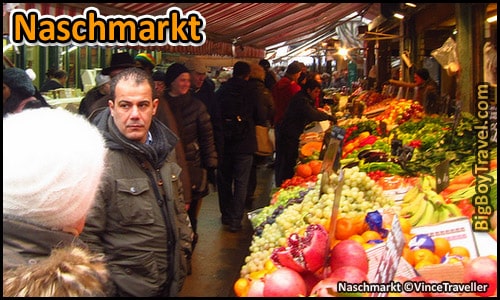
About Naschmarkt : The 6 block long Naschmarkt is Vienna’s most popular produce market. An active market has been operating here since 1780 and today has 100 vintage stalls.
Cost : Free. Hours : Stalls open Monday-Friday 6am-7:30pm; Saturday 6am-6pm; food & drink Monday-Saturday until 11pm. Website : HERE .
Featured Article

Sign Up For Our Newsletter For Free Travel Tips
Email Address *
Disclaimer: Information on this page and in our walking tours were deemed accurate when published, however, details such as opening hours, rates, transportation, visa requirements, and safety can change without notice. Please check with any destinations directly before traveling.
- Vienna Travel Planning
- Vienna Notes Newsletter
- Help Centre: Ask a Question
Vienna Unwrapped Inspiration and Planning For Independent Travellers who are visiting Vienna
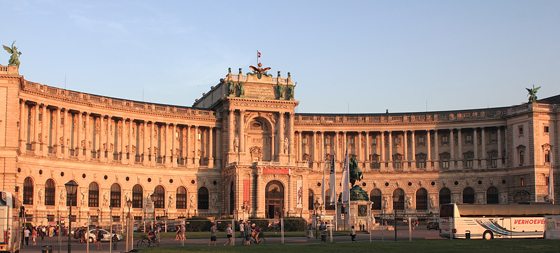
Vienna Walking Tours: 9 Thought-Provoking Walks
- share
- save
- RSS feed
If you belong to the smart 27% of Vienna visitors*) who are keen to learn about the city while there check these eight Vienna walking tours. Since my home city offers almost 100 guided walks start on top with this manageable list of the best group tours: from basic orientation walks to expert-led tours, from Jewish to architectural, shopping and movie tours.
Basic Vienna Walking Tour
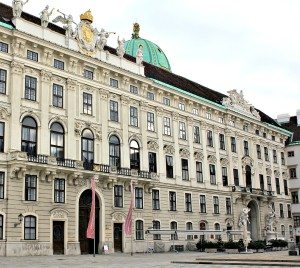
Essentially, Herbert provides first time visitors to Vienna with an ‘excellent’, ‘informative’, ‘entertaining’, ‘cheerful’ yet ‘relaxed’ overview of the city, its people, culture and food, and will help you connect with the best places to visit in Vienna.
You will step right into the Imperial Palace ( Hofburg ), a town within a town. Follow Herbert through baroque alleys and historic squares of Michaelerplatz and Josefsplatz, to the Vienna State Opera . Vienna’s landmark St. Stephen’s Cathedral and the Mozart house right next finish off the tour. Don’t hesitate to ask about current developments in Vienna and Austria. You will get a great response. The 2-hour tour is available in various languages.
Small Group Walking Tour
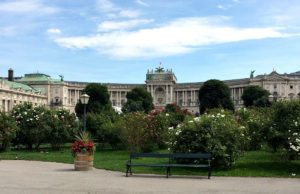
On the one hand you will cover a vast range of top landmarks such as Hofburg Imperial Palace, the Spanish Riding School, the Vienna State Opera and St. Stephen’s Cathedral. On the other hand, the tour also lets you discover lovely Volksgarten and Burggarten, and brilliant gems such as Lobkowitz Palace, where Beethoven first conducted his Eroica Symphony. That tour feels less than the regular 2.5 hours hours, thanks to an entertaining and knowledgeable tour guide. Learn more about the
Walk With An Expert Intellectual
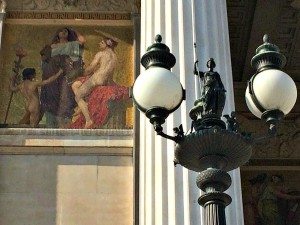
This Vienna walking tour is guided by historians, professors, art critics, journalists and doctoral students. Because they see Vienna through different eyes so will you. The tour covers key highlights such as Stephansdom , Graben and Kohlmarkt boulevards, Museumsquartier, Ringstrasse, church St. Charles Borromeo, Belvedere Palace and historic Naschmarkt. Expect to see iconic gems such as modernist Loos House.
Insider Food, Coffee and Market Tour
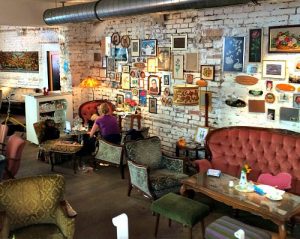
Soon you will leave the tourist center to discover trendy Mariahilf and Vienna’s most famous food market Naschmarkt before moving on to coffee tasting in Neubau. What I love most about this tour is that it includes a deep dive into our much loved Viennese breakfast ( Wiener Frühstück ) that I regularly recommend to my trip planning clients and exploring locally made beer and wine. With all this action you will find that the 4.5 hours will pass in a flash.
Vienna City Walking Tour
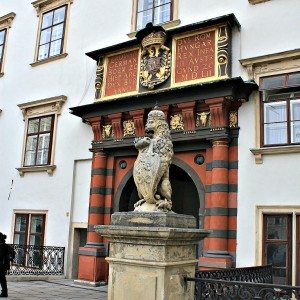
As to the participants’ mix, this tour is popular with young to middle aged people and a good way to connect with other travellers.
Themed Vienna Walking Tours
Themed walking tours cultivate your personal interests. You can choose to dive into architecture, neighborhood shopping, films or Jewish history. Here are my tried and tested BEST OF.
Vienna Jewish Tour
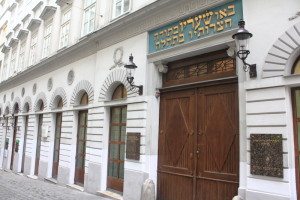
During this private Vienna Jewish Tour I could basically call the shots. The tour was individually put together. In my case we visited the Jewish Museum in Vienna, the area of the Jewish Temple and other monuments and places where Jewish history happened.
If you prefer a group tour, join the Jewish Vienna walk . I participated in that, too. The tour guide was from one of the best tour companies in Vienna, what a passionate and knowledgeable lady.
Private Culinary Tour Through Vienna
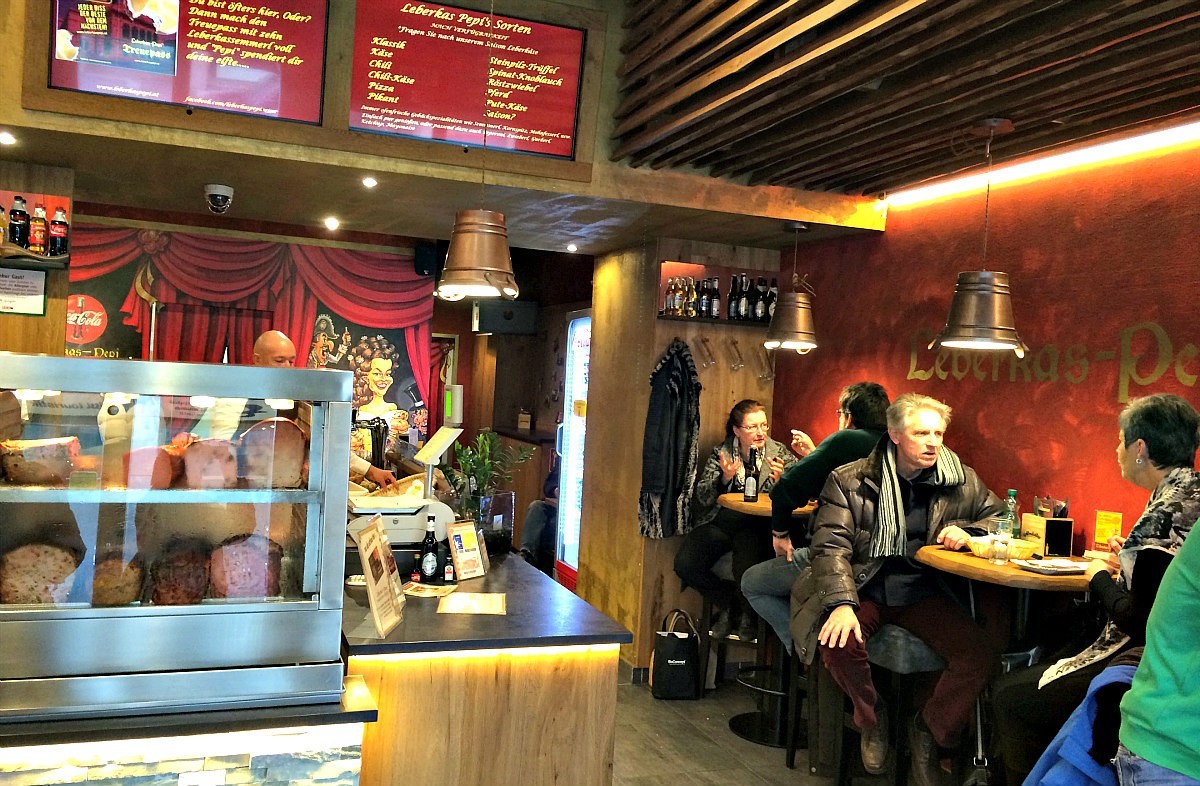
Insider Shopping in Vienna : Vintage And Luxury
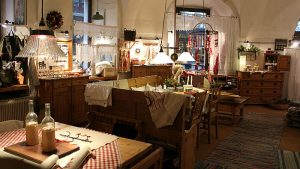
These shopping tours are fantastic for buying original souvenirs and for treating yourself. Since I joined that passionate tour guide on a private walk do read my review where to buy when shopping in Vienna.
Third Man Movie Tour
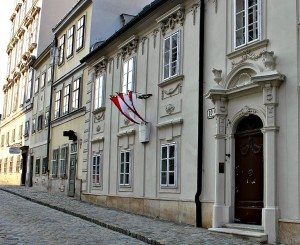
The two-hour tour is conducted in both German and English. More information about the tour .
Jean Nouvel Buildings: Gasometers
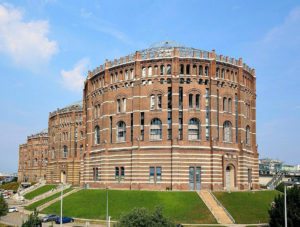
Vienna’s four iconic gasometers host stunning interiors designed by architects such as Jean Nouvel and Coop Himmelblau. Find out what to expect from a guided tour .
*) Source: ‘Vienna visitor survey 2017/2018; Vienna Tourism Office
explore Vienna tours by bike find out about Vienna tours by segway go to Vienna tours: private sightseeing look for self-guided Vienna Walks – Six Routes With Map For Your Sightseeing back to Vienna Tours – 5 Ways To See Tourist Places in Vienna back to Vienna Unwrapped homepage
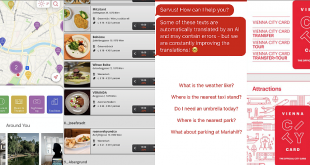
Resources You Need To Plan Your Vienna Vacation
To fast track your planning for a Vienna vacation I have packed a ton of …

The Perfect 2 to 3 Days in Vienna Itinerary
Disclaimer: This article contains affiliate links. That means if you click a link and make a purchase, we may make a small commission. As an Amazon Associate we earn from qualifying purchases. For more information, see our privacy policy.

Planning the perfect Vienna itinerary can see a bit overwhelming when you realise on every cobbled street corner, there’s something to admire here. There are baroque facades, imperial palaces and Viennese coffee houses. A home for intellects, artists and politicians, in order to soak in all of the sophistication Vienna has to offer, you’ll need 2 to 3 days in Vienna.
Austria’s capital city is filled with world-famous paintings, artefacts and relics of one of the most impressive European royal dynasties, and it has picturesque views of the Alps too. To make sure you don’t miss the best attractions or skip out on the lesser-known sites, read our Vienna itinerary to plan the perfect trip.
Table of Contents
How Many Days in Vienna?
The majority of tourists are drawn to Vienna for its history. To feel truly satisfied with your trip, you’ll be wondering how many days you’ll need to spend in Vienna in order to get the most out of your trip.
A weekend will give you plenty of time to tick off all of those bucket-list attractions. Those 2 days in Vienna will give you ample time to explore palaces, museums and even have a slice of Sacher torte too.
But you might be wondering if you should extend your holiday by one day to give yourself a long weekend in the capital. If you have the time, 3 days in Vienna will give you time to squeeze in a day trip to the neighbouring capital city of Bratislava or over to Salzburg .
If a day trip isn’t your ticket, then a third day in the city will give you time to explore Vienna’s lesser-well known attractions.

Getting To and Around Vienna
For international arrivals, the easiest way to arrive into the city is by Vienna international airport. The airport is well-serviced by several public transport links, but the most convenient way to arrive is via the rapid transit railway (also known as the S-Bahn).
Services arrive at several stations including Wien Hauptbahnhof. A one-way single ticket costs €4.10, so they’re highly economical too.
If you’re travelling across mainland Europe, the easiest way to get to Vienna is by train to Vienna Central Station (Wien Hauptbahnhof). You can jump on a direct train into Vienna from Rome , Budapest , Munich , Bratislava, Prague and many many more. You can check schedules and prices here.
Now that you’ve arrived in the city, you’ll want to know how to get around Vienna. On the whole, the city is a highly walkable city with most of its top sites located within walking distance of one another.
Because some of the sites are further out of the city, you will need to navigate Vienna’s public transport during your 3 days in Vienna. The best way to move through the city is on Vienna’s U-Bahn (the metro).
They’re highly frequent and run from 5 am all the way through to midnight. Vienna also has an extensive tram and bus network too – use CityMapper to navigate these. If you end up purchasing the Vienna City Card , public transit is included – along with entry into a number of different sites and museums. You can also get a travel card with the purchase of the Vienna Pass .

2 to 3 Days in Vienna Itinerary
Now that you’ve got a vague idea of Vienna’s sites and surroundings, you’ll be after a step-by-step Vienna itinerary to make the most of your 2 or 3 days in Vienna.
This is a great travel itinerary for first-time visitors getting to know the city who want to see the major attractions in Vienna.
Day 1 – City Centre Highlights
Free walking tour.
As we’ve already mentioned, Vienna is a highly walkable city so we recommend jumping on a free walking tour. Our favourite is the Red and White Walking Tour . They have an informative bunch of guides who offer tidbits about the city and local recommendations.
If you’re ever on a free walking tour, it is generally expected that those on the tour will tip their tour guide at the end. How much you’d like to tip is at your discretion (the tip is really about how much you enjoyed the tour).
But if you don’t fancy hopping on a free walking tour, then you can easily build your own or join a paid walking tour if that suits your schedule better. This will allow you to join more specialised tours such as this food tour .
Vienna Opera House
To see Vienna in 2 days, start your first day outside its world-renowned Opera House – the Vienna State Opera. Also known as the Wiener Staatsoper, this Opera House first opened its doors in 1869 and has since received a global reputation.
Its facade is grand and striking, a beauty that deserves to be admired.
If you want to watch an evening performance, then purchase tickets online well before you arrive in Vienna. Tickets for a night at the opera can be purchased for as little as €14 – it’s a bit of a bargain really.

The Albertina Museum
After you’ve ogled at the might of the Vienna Opera House, take a short walk over to Albertinaplatz where you’ll find the Albertina Museum.
The Albertina Museum houses one of the most important collections of art in the world. Inside its walls, there are around one million prints including paintings by Monet and Picasso. You can book entry tickets here.
Austria National Library
Once you’ve finished staring at some works of art, walk over to the Austrian National Library. The library houses several different attractions including the State Hall, the Literature Museum, the Papyrus Museum, the Globe Museum, the Esperanto Museum and the House of Austrian History.
Individual tickets can be bought for each attraction, if you want to visit more than two it is worth buying a combined ticket. At the moment, the State Hall is under refurbishment and will re-open its doors in 2023.

The Hofburg
Finally, it is time to walk on over to the Hofburg – an incredible place to visit on any trip to Vienna. The Hofburg is a labyrinth of monumental buildings and wings. To experience it in all its glory, make sure you enter from Michaelerplatz’s cobbled courtyard.
This part of the Hofburg is lined with statues of Heracles and soothing fountains. Here, you’ll find the classic horse-drawn carriages from the Spanish Riding School (they should be on your left).
As you walk through the Hofburg, you’ll find yourself in a courtyard with a large monument to Emperor Franz I. While you’re there, make sure you visit the Swiss Gates. These red and gold gates date back to the 16th Century and give the Hofburg’s exterior a pop of colour.
Straight ahead from the Swiss Gates is Heldenplatz (also known as Heroes Square). The balcony in Heldenplatz is where Hitler addressed a rally in 1938 – just standing in the square will give you the chills.
As well as walking around the Hofburg, there is plenty to see inside the imperial palace’s formidable walls. Inside the building you’ll find the Sisi Museum, the Imperial Apartments, the Imperial Silver Collection, the Spanish Riding School and many more.
You can gain entry to the Sisi Museum by itself, or you can purchase a combined ticket that will include a grand tour of the Schönbrunn Palace, the Sisi Museum, the imperial apartment and the silver collection as well as entry into the Vienna Furniture Museum.
You can also get tickets to the Spanish riding school or you can book a guided tour here.

Stephansdom
From the Hofburg, walk 10 minutes along Vienna’s winding cobbled streets to St. Stephen’s Cathedral. The Gothic cathedral stands in a busy, bustling square.
Before touring around the cathedral, we recommend stopping for a drink or a light snack at one of the many bars surrounding the cathedral. Even though these bars are in a tourist hotspot, the prices are relatively affordable.
As you sip your drink, admire the outside features of the cathedral. One side of the roof is adorned with Green tiles including the Hapsburg house crest (a double-headed eagle). You’ll also notice a golden ladder on the side of the spire, which is referred to as the stairway to heaven.
Now, it’s time to head inside. The Cathedral’s attractions are separated into these distinct parts: the cathedral, catacombs, south tower and the north tower. If you’re planning on going to only one or two of these attractions, then you’ll want to purchase separate tickets.
That being said, it makes more sense to purchase a combined ticket if you want to visit the entirety of the cathedral. You can also purchase tickets to see a concert here.

Day 2 – Schönbrunn Palace, Schloss Belvedere & Museums Quartier
Schönbrunn palace.
To see Vienna in 2 days, you’ll want to start your second day bright and early at the summer residence of the Hapsburg family, the Schönbrunn Palace.
It is one of the most famous examples of Baroque architecture in Europe. Head into the palace and move through the 44 rooms, including private apartments and staterooms, and other precious 18th-century interiors. A tour around the palace will take hours, and once you’ve come outside it’s not over there.
Take a stroll through the palace gardens to the viewing point. You’ll be able to soak in tremendous views of Vienna as well as glimpses of the Alps. When you’re here, sit down and have a coffee so you can really soak in those views.
There are numerous different tickets to purchase at Schönbrunn. Have a browse through the ticket options and pick one that piques your interest. You can also book a guided tour here if you want to learn more about the history with a travel guide and skip the line.

Karlskirche
After visiting the Schönbrunn Palace, it’s time to visit Karlskirche – an 18th Century cathedral. It dominates Vienna’s skyline, so it isn’t very easy to miss. On the outside, you’ll notice a large dome and two long columns. Entry into the cathedral is paid, and it’s worth paying the price for panoramic views of the city.
Schloss Belvedere
After visiting the cathedral, jump onto tram line D and head over to Schloss Belvedere. Formally two palaces, Schloss Belvedere is now a museum complex. Its collection of art ages from the middle ages all the way up to the present day.
Access to the majority of the gardens is largely free and accessible to the public. To visit inside, you’ll have to purchase a ticket here for the Upper Belvedere and you can purchase tickets here for the Lower Belvedere.

Museums Quartier
Spend the rest of the afternoon in the Museums Quartier. This former imperial stable is one of the largest cultural quarters in the world.
It’s an urban, edgy, part of the city where locals enjoy long summer evenings lounging around on bean bags and deck chairs.
You can easily spend a day in the Museums Quartier, but if you’re short on time make sure to see the Leopold Museum (you can pre-book tickets here ) and the Museum of Modern Art.

Day 3 – Day Trip from Vienna
Day trip to bratislava.
If you want to see Vienna in 3 days, there are a few ways you can spend your final day in the city.
Firstly, you can continue to explore Vienna a little deeper. You might want to return to the museum quartier and visit another museum or you might want to sit back and relax with a warm mug of coffee and a slice of cake. Take the time to, perhaps, visit the city hall and the nearby Rathauspark.
Alternatively, you could send your final day in another country. Bratislava (the capital of Slovakia) is only a one-hour train ride away from Vienna Central Station. Visiting Bratislava is really worth it if you have more time in Vienna to spend.
Because Bratislava is a small city, it can be easily explored within one day. Trains run every hour between the two capitals and can be purchased here. Alternatively, it is also possible to book a guided day trip if you don’t want to do the trip independently.
Once you’ve arrived in the capital, make a beeline for the Old Town. Head straight to St Michael’s Gate – one of the city’s last remaining fortresses. For great views of the city, climb to the top of the tower, but get there early to beat the crowds.
After you’ve taken in the views of the city, walk over to St Martin’s Cathedral. While it may not look impressive from the outside, underneath the cathedral lies a labyrinth of catacombs, which are worth a visit.
From here go for a wander around the main square where you’ll find brightly-coloured buildings. One colourful building in Bratislava that stands out, in particular, is the Blue Church. Officially known as the church of St Elizabeth of Hungary, it is a must-see if you’re a lover of whimsical buildings fit for a fairytale.

Where to Stay in Vienna
Vienna is a massive city with a range of choice when it comes to accommodation. Whether you’re looking for an ultra-budget option or a plush luxury hotel, you’ll be sure to find it in the Austrian capital. If you’re wondering where to stay in Vienna, have a look at these great options:
Motel One Wien – Hauptbahnhof — For those travelling on a mid-range budget in Vienna , then this hotel is a fantastic option. Situated within easy reach of Vienna’s main train station they have a number of clean, comfortable and nicely decorated rooms on offer. There is also a breakfast option available each morning. Click here to see their availability
Hotel Brauhof Wien — If you’re looking for a luxury option in the Austrian capital, then this 4-star hotel is a great choice for you. They have a myriad of luxe rooms available, a fantastic location for exploring the city and a number of other great amenities to ensure you have an excellent stay. Click here to see their availability
Hostel Ruthensteiner — For budget or solo travellers, this hostel can be a fantastic option in Vienna. Family-run, they have both private rooms and dorm beds available, a central location for exploring the city and there are plenty of great common areas that make it easy to meet other visitors to the city. Click here to see their availability
Not quite what you’re looking for? Click here to browse more Vienna hotels!

Vienna is a city of grandeur, dynasty and culture, so it’s easy to feel sophisticated when you’re exploring palace after palace. However you’ve chosen to spend your 2 to 3 days in Vienna, we hope you found our Vienna itinerary useful.
Are you planning a trip to Vienna? Have any questions about this itinerary? Let us know in the comments!

Related Posts:

The Perfect One Day in Graz Itinerary
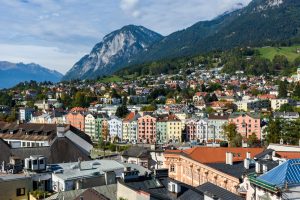
The Perfect 1, 2 or 3 Days in Innsbruck Itinerary

The Ultimate One Day in Hallstatt Itinerary

About Hope Brotherton
Hope is a writer for The World Was Here First. Originally from Birmingham, England, she is passionate about budget-friendly travel and incorporating greener and more eco-friendly travel into her adventures. She keeps returning to Italy but loves to travel around any European country.
Leave a Comment Cancel reply
Turn your dream vacation into reality

Ultimate First-Time Vienna Itinerary (+ Map)
- December 26, 2023
A complete Vienna itinerary for first-timers (+ a map, the best day trips and how to save more than €60 with Vienna Pass).
Vienna (Wien) is the capital of Austria and its largest city. Once home to the powerful Habsburg monarchy, the city still preserves its imperial grandeur. Splendour Baroque architecture, imperial palaces and lavish coffee houses, the capital of Austria has it all!
Vienna is also known as a City of Music. Many famous musicians and composers lived and worked here (for example Strauss, Beethoven, Schubert, Mozart and Brahms).
The perfect Vienna itinerary
This Vienna itinerary for three days is perfect for you if you are visiting the city for the first time. It covers all the places you must see.
If you want to try some of the restaurants from the itinerary for dinner, better make a reservation or go for an early dinner.
Already have a hotel booked? See whether your hotel is in a good area in my guide to Where to stay in Vienna .
At the end of the article, you can find a map of this Vienna itinerary (with all attractions and restaurants’ websites).
The perfect Vienna itinerary (for first-timers)
Day 1 : St. Stephen’s Cathedral, Plague Column, St. Peter’s Church, Imperial Palace, Parliament Building, Vienna Rathaus, Giant Ferris Wheel
Day 2 : Spanish Riding School, Burggarten, Vienna State Opera, St. Charles’s Church, Soviet War Memorial, Belvedere Palace
Day 3 : Schönbrunn Palace, Danube Tower
Vienna itinerary – Day 1
Have breakfast at le bol.
08:30 AM – 09:30 AM Start the day with a breakfast at Le Bol or L. Heiner .
L. Heiner has the typical atmosphere of a Viennese café. Take a cup of coffee and a delicious piece of cake to sweeten your day.
Le Bol is a French café and it is a great place if you want something substantial for breakfast. Their Croque-monsieur is mouth-watering.

See the iconic St. Stephen’s Cathedral
09:30 AM – 11:30 AM The Gothic cathedral, Stephansdom, is one of the most famous sites in the city. The entrance is free, but there are areas within the church that you have to pay for.
The Treasury is worth it unless you are also planning to see the Imperial treasury in Hofburg. In this case, choose one of them.
The catacombs can be visited only with a guide ( see more info here ).
You’ll need about 2 hours to explore all areas of the cathedral (including the paid ones). The free visit takes no longer than 30min.

Admire the Plague Column
11:45 AM – 12:00 PM The Plague Column (Pestsäule) is erected to celebrate the end of the Great Plague epidemic in 1679. The column is right in the centre of the most famous shopping street in the city – Graben.

Visit St. Peter’s Church
12:00 PM – 12:30 PM St. Peter’s Church (Peterskirche) is easy to miss, but don’t! Although this Baroque Roman Catholic church is small, it is a real gem inside.

Have lunch at Trześniewski
12:30 PM – 02:30 PM For lunch stop at Trześniewski or Hopferl . Trześniewski offers delicious little sandwiches. You can choose from many variations. They go along great with a cold beer.

Hopferl is a traditional Austrian pub and it is a nice option for a longer lunch.
Explore the Imperial Palace
02:30 PM – 04:30 PM Hofburg is the former Imperial Palace. It houses three museums: the Imperial Apartments, the Sisi Museum and the Silver Collection. Buying a ticket for Hofburg allows you to enter all of them.

Continue your walk through the imperial Wien with a visit to the Imperial Treasury. It is a stunning museum and a must even for a limited time. Here you can see one of the largest emeralds in the world. You need to buy a separate ticket for the Imperial Treasury (it’s not included in the ticket for Hofburg palace).
Austrian Parliament Building
04:45 PM – 05:00 PM You can’t pass without noticing this beautiful white building in a Greek style. Since the 19th century, this is the place where the Austrian parliament conducts its sessions.

Be amazed by Rathaus
05:00 PM – 05:15 PM Rathaus is the City Hall. The word “Rat” in German means council. The Neo-Gothic building of the Rathaus is outstanding, especially at night. If you have a chance to take a look at it in the evening, do it!

Prater and Viennese Giant Ferris Wheel
05:45 PM – 07:00 PM No visit to Wien is complete without a ride on the Giant Ferris wheel. The 64.75-metre (212 ft) tall Ferris Wheel does only one slow turn (a 20min ride).
This attraction is in the Prater, a huge amusement park. If you are not into such parks, you can skip it. Just go for the Ferris Wheel.
To get there take metro line U2 (Direction Seestadt): from station Rathaus to Praterstern Bf – 4 stop.

For dinner, I suggest you take the metro back to the city centre instead of looking for a place to eat around the Prater. There are two great places to dine close to St. Stephen’s Cathedral.
If you love spare ribs, go to Ribs of Vienna . They offer more than 20 variations of ribs.

If you prefer a traditional Austrian restaurant, try Gasthaus Pöschl .

More ideas for your Vienna itinerary – Day 1
If you have more time check out these attractions, too. They are close to the sites from the first day, so you can easily add any of them to your Vienna itinerary (if you are ahead with time).
Learn more about Mozart’s life
Mozarthaus is the only remaining home in the city of the famous composer Mozart. He lived here from 1784 to 1787. Discover the musical side of Wien by visiting Mozart’s former apartment ( book your ticket here ).
Watch the clock show at Anchor Clock
Ankeruhr Clock is a famous clock in Art Nouveau style. At every hour the clock shows some historical figures and at noon all of them parade. If you want to see the show at 12:00 PM, go 15 minutes early as there is usually a big crowd.

Clock Museum
I found the Uhrenmuseum fascinating. It houses about 700 clocks from around the world, some of which date even to the 15th century.

Judenplatz Holocaust Memorial
Judenplatz Holocaust Memorial is a moving memorial in the heart of the Jewish quarter. It commemorates the Austrian victims of the Holocaust. It’s also known as the Nameless Library. This concrete library is filled with books put backwards on the shelves.

Visit the cat café Neko
Tucked away in some side streets, this cat cafe is a must for every cat lover. It’s not fancy, has no entrance fee and five lovely cats are there to welcome you. Go early on weekdays for fewer crowds.

Votive Church
If you take a walk along Ringstraße a beautiful sandstone church in neo-Gothic style will come in your sight. The history of Votive Church (Votivkirche) began with a failed assassination attempt. In 1853 during one of his regular walks around the city, Emperor Franz Joseph was attacked from behind.
He was stabbed in the collar with a knife by the Hungarian nationalist János Libényi. The attack was unsuccessful. Although the emperor was heavily wounded, his life was out of danger. János Libényi was arrested for an attempted regicide and later he was executed.
The emperor’s brother, Archduke Ferdinand Maximilian, decided to build a church in gratitude to God for the salvation of the emperor. Maximilian asked the people for donations and after a year the needed amount was gathered.
The name of the church Votive Church (Votivkirche) derives from the fact that it is built entirely by donations (votive offerings).

Vienna itinerary – Day 2
Have breakfast at joseph brot.
08:30 AM – 09:30 AM Start the second day of the Vienna itinerary for 3 days with breakfast at Joseph Brot. A great bakery for pastries, coffee and of course Eggs Benedict.
Spanish Riding School
09:30 AM – 11:30 AM The Spanish Riding School is a traditional riding school for Lipizzan horses with a history of more than 450 years. You can attend a morning exercise of the school and see the beautiful and lively Lipizzan horses in action.
The performances take place at the Winter Riding School (Winterreitschule) in Hofburg.
To look behind the scenes, take a Spanish Riding School Guided Tour . You’ll learn about the lives of the horses and even see them in their stables.
Burggarten and Mozart Statue
11:45 AM – 12:15 PM Take a rest in the Burggarten and see the famous Mozart Statue that is created in 1896.

Wien State Opera
12:15 PM – 12:30 PM Pass along the beautiful 19th-century-old building of the Wien State Opera (Wiener Staatsoper).

12:30 PM – 02:30 PM Choose between Café Museum and Phil . Café Museum is a traditional Viennese café where you can order a lunch beside the usual cakes and coffee. Or you can eat a few pieces of cake instead of lunch as I did. Phil combines a regular coffee shop with a bookstore.
Visit St. Charles’s Church
02:30 PM – 03:00 PM St. Charles’s Church (Karlskirche) is an outstanding Baroque church from the 18th century. There is a fee to visit the church, but the entrance ticket also includes the elevator to the dome.

Schwarzenbergplatz and Soviet War Memorial
03:15 PM – 03:30 PM The memorial is built to commemorate the Soviet soldiers who fell in the Battle of Vienna in World War II.

Tour the royal Belvedere Palace
03:45 PM – 05:30 PM Belvedere Schloss used to be the summer residence of Prince Eugene of Savoy. The Palace is housed in two buildings separated by a huge park.
The Upper Belvedere houses the world’s largest collection of Gustav Klimt’s paintings. Here you can see his iconic masterpiece the Kiss (Lovers).
The Lower Belvedere houses temporary exhibitions, but it’s worth visiting because of the few restored rooms. So if you want to find out how the palace looked back in its glorious days, don’t miss the Lower Belvedere.

Taste some Viennese food
Finish the day with dinner at Wiener Wiazhaus or Salm Bräu .
Salm Bräu is a few centuries old brewery. It is worth visiting for the beer.

However, I love the food in Wiener Wiazhaus more.

More ideas for your Vienna itinerary – Day 2
Natural history museum and kunsthistorisches museum.
These identical buildings from the 19th-century house the Habsburgs’ collections.
If you are into art and history, Kunsthistorisches Museum is the better choice. I found their Egyptian and art collections fascinating. You can buy a combo ticket for the Kunsthistorisches Museum and Imperial Treasury and save some money.
On the other hand, the Natural History Museum houses the unique 29,500-year-old statue of Venus of Willendorf and enormous dinosaur skeletons. It’s a really tough choice if you’re short on time.

Admire the art at Albertina
Albertina served as a residence of Habsburgs for more than 100 years. Nowadays it’s a must-see art museum. You can admire exhibitions of French and German expressionism, Russian avant-garde and many more. The museum also houses one of the largest graphical collections in the world.
Tour the sumptuous staterooms and see some incredible art. Get your fast-track ticket to Albertina here .
Austrian National Library
The Austrian National Library is a must-see for every book lover. Its lavishing interior is something not to be missed. You can visit the State Hall, Literature Museum, Globe Papyrus and Esperanto museum. Keep in mind that State Hall is located separately from the other museums.

Imperial Crypt
The Imperial Crypt lies beneath the plain-looking Capuchin Church. It’s the final resting place of the Habsburg dynasty. About 150 Habsburgs are laid to rest here, among them are 12 emperors and 18 empresses. You can tour the crypt on your own.

St. Michael’s Church
Michaelerkirche is one of the oldest churches in the city. The church is mostly known for its crypt. Around 4,000 bodies are buried in the crypt from 1631 to 1784. Due to specific climatic conditions, the corpses are well preserved. The crypt can be visited only on a guided tour. It takes place from Thursday to Saturday at 11:00 AM and 01:00 PM in front of the church.
Explore the food market, Naschmarkt
Naschmarkt is the best-known market in the city since the 16th century. The market has about 120 stands and restaurants, that ensure you a colourful culinary experience.
To learn more about Naschmarkt and try delicious delicacies, take a gourmet food tour .
Vienna itinerary – Day 3
Have breakfast at waldemar tagesbar.
08:30 AM – 09:30 AM Start the last day of the 3 perfect days in Vienna itinerary with breakfast at Waldemar Tagesbar .
Explore the royal Schönbrunn Palace
09:30 AM – 01:30 PM
Schönbrunn Palace (Schloss Schönbrunn) is the former imperial summer residence of the Habsburgs. It has over 1400 rooms! The rooms in the palace are well preserved and you can see only 40 of them. There are different kinds of tickets for Schönbrunn Palace .
To get to Schönbrunn Palace take metro line U4 from Karlsplatz or Schwedenplatz to Schönbrunn metro station.

The gardens are huge, so be prepared for a long walk.

There a lot of fearless squirrels you can feed with nuts. I don’t go there without a package of walnuts in my pocket.

The most interesting sites in the gardens are Gloriette, the Maze and the Palmenhaus. For all of them, you will need a ticket.

At the entrance of the palace, there is an Imperial Carriage Museum (Kaiserliche Wagenburg).

As you see there are a lot of options to choose from and you will have to make a choice. If you want to see all of this you will need a full day, not only the morning. It is up to you.
Also, you can attend an Apple Strudel Show. You’ll see how the original Viennese apple strudel is made. Also, a tasty warm piece of strudel will wait for you at the end of the show.
Don’t forget to book your Apple Strudel Show ticket in advance.
Where: Schönbrunn Palace’s Café Residenz When: Daily 11:00 AM – 04:00 PM at the top of the hour Duration: 15-20 min

01:30 PM – 02:30 PM Have lunch at Café Restaurant Residenz or Landtmann’s Jausen Station . Both of them are located on the grounds of the palace.
Zoo or Danube Tower
02:30 PM – 06:00 PM If you are done with the palace and the gardens you have two options for the afternoon. You can visit the amazing zoo in the garden of the palace or the Danube Tower.
The Zoo (Tiergarten Schönbrunn) is the oldest one in the world and it is huge. It takes hours to see it all. You need an additional ticket for the Zoo unless you choose a Schönbrunn Pass that includes an entrance to the zoo.
If you stick with this option you can have dinner at Brandauers Schlossbräu or Plachutta. Brandauers Schlossbräu is a typical Austrian pub, while Plachutta is a little more formal.

Danube Tower
The tower (Donauturm) is far away from the palace and you have to use public transport.
Take metro line U4 (Direction Heiligenstadt): from station Schönbrunn to Schwedenplatz – 9 stops. Then change to metro line U1 (Direction Leopoldau): from station Schwedenplatz to Kaisermühlen – 5 stops. From there you have to walk about 1,5km to reach the Danube Tower.
A huge calm park surrounds the tower. From the top of the 252 metres (827 ft), you can enjoy spectacular views. Book your skip the line ticket for Danube Tower here .

For dinner return to the city centre and try Gasthaus Pfudl or Restaurant Pürstner . Both of them serve delicious Austrian food.

Mozart and Strauss Concert
Finish the day with the magical works of Mozart and Strauss. Attend a concert of Wien Mozart Orchestra in period costumes at the Golden Hall (it’s the most famous concert).
More ideas for your Vienna itinerary – Day 3
Museum of technology.
This is one of the best technology museums I’ve ever been to. It’s very interactive and it’s huge. The museum is close to Schönbrunn Palace, so you can combine it with a visit to the palace.

St. Francis of Assisi Church
The church is built to celebrate the 50th anniversary of the reign of Emperor Franz Joseph I of Austria. It’s very different from the other churches in the city, it resembles a small castle. The church is located a bit out of the city centre. Yet you can easily reach it from the metro, getting off at Vorgartenstraße station.

Hundertwasser House
Hundertwasser House (Hundertwasserhaus) is a colourful and extraordinary house. It’s designed by the famous architect Friedensreich Hundertwasser. The house can’t be visited, but you can tour Kunst Haus Wien . It is also designed by Friedensreich Hundertwasser.

Schönbrunn Palace – it’s one of the most popular attractions with long queues. Buy your tickets in advance from the official website or use Vienna Pass to skip the line.
Spanish Riding School – one of the most popular activities in Vienna, so book tickets in advance here .
Giant Ferris Wheel – if you don’t have a Wien Pass, book tickets ahead to avoid waiting in line.
Attend a classical music concert – tickets for the most popular concerts sell out fast, so book as early as you can ( see all concerts here ).
How to save money on your Vienna itinerary
The Wien Pass is a great way to save money from entrance fees. Find out more details in this Vienna Pass review .
The pass includes:
- free admission to over 60 attractions
- fast-track entry at many sites
- unlimited rides on the hop-on-hop-off buses
- boat cruise along the Danube Canal
- guided walking tour
By using Wien Pass (€149 for 3 days) you will save €61 .
- sightseeing – €135 (all sites from the itinerary except Karlskirche)
- hop-on hop-off buses – €36
- boat cruise – €24
- walking tour – €15
Total without the card – €210 If you use the card – €149 Total savings – €61
Getting around in Vienna
Find a detailed map of the itinerary here .
Wien has a well-developed public transport network. You can get to every part of the city in no time. In most cases, you’ll need to use the metro only to go to Schönbrunn Palace or Danube Tower. Otherwise, the city can be explored easily on foot. There are different types of tickets .
During my trip, I mostly used the Weekly Pass (Wochenkarte). It’s a great option for a longer stay within a week. This ticket is valid from Monday 12:00 AM until next Monday 09:00 AM. To reach the airport by the S-Bahn (if you have the weekly pass), you’ll need only a supplementary ticket for Vienna outer zone (Aussenzonen).
Another option is the hop-on-hop-off bus . It’s a great and easy way to tour the city.
Also, you can take a ride on the famous Vienna Ring Tram . This tram is the only one that completes an entire round of the Ringstrasse boulevard.
How to get to Vienna
Vienna is easily accessible by train from any major European city. The Central train station is about 2km away from the Historic centre (you can easily reach it by metro). Check timetables and book tickets online at ÖBB official site .
If you’re arriving by car, it’s best to choose accommodation with available parking. Find more information about parking in Vienna .
Vienna International Airport (Flughafen Wien-Schwechat) is located about 20km outside the city. There are several ways to get to the city centre from there:
- if your accommodation is close to Wien Mitte – Landstraße, use the City Airport Train that takes you to the city centre only for 16min
- another option is to take the S-Bahn (suburban train)
Day trips from Vienna
Wachau valley and melk abbey.
A trip to the magnificent Melk Abbey is one of the most popular excursions from Vienna. Leopold II, Margrave of Austria founded the abbey in 1089. Soon it became famous for its extensive manuscript collection. Today, the abbey is a stunning example of Baroque architecture.
During the winter you can visit the abbey only with a guided tour.
How to get to Melk Abbey
- organized tour – this Wachau Valley tour is one of the most booked day tours. It combines a visit to the medieval Melk Abbey with a boat cruise on the Danube River.
- by train – take a regional train from Wien Westbahnhof to Melk Bahnhof (1-hour journey). From there it’s about 800m to the abbey.

Bratislava, the charming capital of Slovakia, is one of the most popular places to visit near Vienna. It’s a vibrant city with a unique mixture of 18th-century buildings and Soviet-era architecture. An impressive castle, quirky statues and a modern UFO tower add a little bit of atmosphere to the city.
Find out how to see everything in just one day with this Bratislava itinerary .
How to get to Bratislava
- by bus – it’s the cheapest option (3 times cheaper than the train, 1h journey). Take FlixBus from the Erdberg bus terminal (the FlixBus station is right next to the metro station Erdberg).
- by train – take a train from Wien Hbf to Bratislava hl.st. (1h journey). From there it’s about 1.5km to the Old Town.
- by water – take the Twin City Liner boat (1h 15min journey).
Salzburg Located at the heart of the Alps, this picturesque city is a true Baroque gem. It’s also the birthplace of the world-famous composer Wolfgang Amadeus Mozart. Highlights of Salzburg include the Cathedral, Mirabell Palace, Hohensalzburg Castle and Mozart Museum.
You’d better spend at least 2 days here and explore the city at your own pace. See the best hotels to stay in Salzburg .
The easiest way to get from Vienna to Salzburg is by train (2h 30min journey). Check timetables at ÖBB official site .

Budapest is known as Paris of the East. And there is a reason why. It’s an outstandingly picturesque city due to its architecture spanning from Baroque to Art Nouveau style. Some of the top attractions are Buda Castle, Fisherman’s Bastion, Hungarian Parliament Building and St. Stephen’s Basilica.
Find out the must-see sites in this Budapest itinerary . It’s better to add an overnight stay for this destination.
How to get to Budapest
- by bus – the cheapest option. Take FlixBus from Erdberg bus terminal (about 3h journey).
- by train – take a train from Wien Hbf to Budapest-Keleti train station. (2h 40min journey).
A colourful city with medieval charm. Prague is located about 4 hours away by train or car. Thus you’d better add it as a next stop in your itinerary, not a day trip. For more information check out my complete itinerary for 3 days in Prague .
How to get to Prague
- by bus – the cheapest option. Take FlixBus from Erdberg bus terminal (about 4h journey).
- by train – take a train from Wien Hbf to Praha hl.n. (4h journey).
How many days in Vienna
Are 3 days in vienna enough.
3 days (or 3 nights in Vienna) is the perfect amount of time. You’ll need 2 days to explore the main attractions in the Historic Old Town and 1 full day for Schönbrunn Palace.
I hope that my suggested itinerary for Vienna will be helpful for you.
2 or 3 days in Vienna?
The Historic Centre is walkable and you can tour it in one day. However to visit the Imperial Palace, St. Stephen’s Cathedral, Spanish Riding School and Belvedere Palace you’ll need one more day. So, 2 days in Vienna are enough to visit almost all popular attractions (without Schönbrunn Palace).
Regarding the Schönbrunn Palace, it’s located out of the city centre (a 30min journey from the city centre). You’ll need at least half a day to explore the palace and its gardens. In addition, there is a lovely zoo. Thus, if you want to see everything you’ll need one whole day.
What if I don’t have 3 full days in Vienna?
If you have less than 3 days, skip the last day of the itinerary that includes Schönbrunn Palace, Zoo and Danube Tower. They are all located a bit far from the city centre and you’ll lose time in transportation. All other attractions are within walking distance from each other.
Best time to visit Vienna
For sunny weather, visit the city from May to September. The high season starts in June and ends in August. If you want to avoid the crowds, visit the city in late spring or early autumn.
Vienna Philharmonic Summer Night Concert takes place every summer in May-June in the gardens of Schönbrunn Palace. It’s a spectacular event, not to be missed.
In September-October, the famous Wiener Wiesn-Fest takes places. This is the Viennese version of Oktoberfest.
Winters are freezingly cold and windy. Nevertheless, December is a great time to visit Vienna because of the Christmas markets. Find out which is the best Christmas market in Vienna .
Practical information about Vienna
Austria is a part of the Schengen Agreement (the European border-free area). So you don’t need an Austrian visa, but rather a Schengen visa. If your country is part of the Schengen Agreement, you’ll need only a valid passport or ID card.
The official currency of Austria is Euro. The most popular credit cards are Visa and Mastercard and they are accepted in many places. However many of the restaurants or even supermarkets accept payments only in cash. Also, American Express is not popular and accepted in only a few places.
Austria is a German-speaking country. However, most people speak good English, too.
Austria operates on a 230V supply voltage and 50Hz. The associated plug type is F.

Follow now for exclusive content
About the author
Leave a Reply Cancel Reply
Your email address will not be published. Required fields are marked *
Name *
Email *
Add Comment *
I accept the privacy policy
Post Comment
This site uses affiliates. Thank you for buying through our links and supporting this blog.

Vienna Itinerary – best things to do in Vienna in 1, 2, 3, and 5 days
- February 17, 2024
- Austria , Europe
Vienna, the capital of Austria, is a city known for its rich history, beautiful art, and lively culture. It’s a place where you can see grand palaces like the Hofburg, admire amazing art at the Belvedere Museum, and discover traditional Viennese coffee culture.
As an Austrian, it’s no surprise that I’ve spent a lot of time exploring the capital and I’ve gotten to know the city really well. There are many things to do in Vienna, and I want to share with you not just the famous spots, but also the hidden gems that make this city so special.
Vienna itinerary overview – the best of Vienna, Austria
How many days in vienna, where to stay in vienna, day 1 – city center & ring, day 2 – the habsburgs, day 3 – gardens & culinary delights, day 4 – art & culture, day 5 – day trip of choice, day 3 – art & culinary, day 1 – city center & habsburgs, day 2 – art & culinary, 1 day in vienna itinerary, best time to visit vienna, getting to vienna , getting around vienna, planning a trip to vienna.
Below I’m sharing crafted itineraries and recommendations on the best things to do (and eat) in Vienna in 1, 2, 3, and 5 days.
In these itineraries, you’ll find must-see places in Vienna like Schönbrunn Palace, where you’ll be transported back in time and feel like royalty. I’ll also show you where to find the best coffee and cake in town because visiting Vienna without trying its famous coffee culture would be a miss. Plus, I’ll share tips on enjoying the city’s music scene, which is one of the richest in the world.
No matter what brings you to Vienna – its history, art, or just the chance to wander around and soak in the vibes – these itineraries are designed to make sure you get the most out of your visit.

In a hurry? Book your Vienna must-dos:
These are the absolute best things to do in Vienna that you shouldn’t miss out on:
Guided walking tour Vienna river cruise Belvedere Palace guided tour Schonbrunn Palace guided tour St. Stephen’s Cathedral concert Vienna Ferris Wheel
I’ve put together itineraries for 1, 2, 3, and 5 days in Vienna. Each one is packed with must-see sights, great places to eat, and a few hidden gems to make your visit special .
The longer you stay, the more you’ll get to explore beyond the city’s main attractions, including day trips to nearby picturesque towns.
For every place or activity mentioned, I’ll provide a quick link and more information the first time it comes up. This way, you can easily find out more about what interests you. To avoid repetition, I kept the shorter itineraries as a list and you can easily refer back up to their more detailed descriptions when needed.

The top sights in Vienna can be visited in one action-packed day. However, having two or three days in the Austrian capital will give you more time to explore the city’s major attractions and rich cultural scene.
If you’d like to fully experience Imperial Vienna with its rich culture and take a day trip to explore the wider region, I’d recommend spending 5 days in the city.
When planning a trip to Vienna, the best area to stay for sightseeing is the first district (Innere Stadt). This central area is the heart of Vienna and is close to iconic landmarks like the Hofburg Palace, the State Opera, and the Albertina Museum.
The area is also well-connected by public transportation, allowing easy access to other parts of the city. With a variety of accommodations ranging from luxury hotels to charming boutique options, the first district offers the perfect base for experiencing all that Vienna has to offer.
Hotel Sacher Wien
HISTORY & LUXURY
This famous 5-star hotel in Vienna combines timeless elegance with modern comfort and is an all-time favorite.
CHECK PRICES
Hotel Am Parkring
Located in the highest building on Ringstrasse, this hotel offers modern rooms with the best views over Vienna’s city center.
Check prices
Residence Wollzeile
CENTRAL HOME
This spacious and beautifully decorated apartment offers the comfort of home in the heart of the city center, just a stone’s throw away from St. Stephan’s Cathedral.
Read next: Where to stay in Vienna
Vienna 5 day itinerary
Spending 5 days in Vienna allows you to explore not only the main tourist spots but also discover some of the city’s hidden gems and rich culture. This itinerary covers all must-see attractions and gives you time to explore the wider region on a day trip.
Plus, you’ll get to discover the traditional Viennese coffee culture and taste authentic local dishes.

St Stephan’s Cathedral
St Stephan’s Cathedral is a well-known landmark in the heart of Vienna. It is renowned for its Gothic architecture, featuring an intricately tiled roof and a towering spire that dominates the skyline. Inside, you’ll find beautiful art such as altarpieces and statues.
Make sure to book this tour which includes the catacombs, the Dom Museum Wien, as well as both North and South towers. As you climb up the towers, you’ll be rewarded with panoramic views of Vienna. This is a perfect way to begin your Vienna adventure.
Book your visit: St. Stephen’s Cathedral & Dom Museum Tickets
Walking Tour in the City Center
Taking a guided walking tour through Vienna’s historic center is an excellent way to get to know the city’s imperial past. This tour not only covers the capital’s major landmarks but also provides insights into Vienna’s rich history and its development over the centuries.
If you prefer to discover Vienna from a different perspective, a walking tour of Vienna’s hidden sights will introduce you to the city’s lesser-known stories and locations.
Book your tour: Vienna guided walking tour Vienna’s hidden sights tour
Kärtnerstraße & Graben
Kärtnerstraße and Graben are Vienna’s premier shopping streets lined with Renaissance-era buildings that add to their charm. Here, you will find a mix of popular international brands and local boutiques, while foodies can enjoy the traditional Viennese restaurants dotting the area.
Whether you’re looking for some retail therapy or simply want to enjoy a relaxing stroll along these historic streets, here you will experience an integral part of Viennese life.
Lunch at Bitzinger Würstelstand
For a taste of authentic Viennese street food, head to Bitzinger Würstelstand near the Albertina Museum. This iconic sausage stand is a favorite among locals, serving traditional Austrian sausages like classic Wiener, Debreziner, or Käsekrainer, served with mustard and bread.
It’s my favorite spot for a quick and tasty lunch in the city center.
Albertina Museum
The Albertina Museum is known for its impressive collection of prints, drawings, and modern graphic works. Here you will find one of the largest and most important print rooms in the world, with over a million pieces including works by Dürer, Raphael, Michelangelo, and Picasso.
Make sure to book your ticket online to save time and avoid waiting in line.
Additionally, the Albertina Museums served as a Habsburg residence and offers insights into the lifestyle of Vienna’s former imperial family.
Book your tickets: Albertina Museum admission ticket
Vienna State Opera
The Vienna State Opera (Wiener Staatsoper) is one of the leading opera houses in the world, offering spectacular ballet and opera performances almost daily. If you’re interested in music and theater, make sure to attend one of their performances.
You can also visit the State Opera building to marvel at its impressive architecture including the grand foyer, the marble staircase, and the auditorium itself.

The Hofburg Palace was the center of the Habsburg empire and today houses several museums, such as the Sissi Museum and the Imperial Treasury. Here you will explore the Imperial Apartments, offering insights into the imperial family’s private and public lives. Plus, you’ll see the Silver Collection showcasing their luxuries and their roles in European history.
National Library
The Austrian National Library is located in the Hofburg Palace and is one of the most beautiful libraries in the world. A visit here is not just an opportunity to admire one of Vienna’s most stunning interiors but also an educational experience.
Its State Hall (Prunksaal) is home to over 200,000 volumes, including medieval manuscripts and rare books. The library tells the story of the Habsburgs’ dedication to arts and sciences and offers a unique insight into the intellectual pursuits that shaped their empire.
Coffee at Café Central
Café Central is not just a coffeehouse, it’s a Viennese institution that hosted poets, intellectuals, and revolutionaries throughout history. With its traditional coffee specialties, cakes, and a stunning interior featuring arched ceilings and marble columns, Café Central offers a taste of the traditional Viennese café culture.
It’s the perfect spot to take a quick break and enjoy a Wiener Melange, the Austrian version of a cappuccino. The Wiener Melange is traditionally prepared with milder coffee and less steamed milk but more milk foam than a cappuccino.
Volksgarten
The Volksgarten is a public park located next to the Hofburg Palace and is known for its beautifully sculpted gardens, old statues, and the Theseus Temple. It’s a favorite spot for both locals and tourists looking for a quiet spot within the busy city.
The rose garden, with more than 3,000 rose bushes, is particularly lovely and smells amazing.
Parliament building
Vienna’s Parliament Building is the political center of Austria. Here you can admire its stunning neo-classical architecture and beautiful exterior, including the Pallas Athene fountain.
While the building is primarily a place of legislative work, tours are available and offer insights into Austria’s political history and the building’s architectural features.
The Vienna City Hall (Rathaus) is an impressive Gothic-style building that serves as the administrative center of the city. Its tower is one of the most recognizable silhouettes in Vienna’s skyline.
The Rathausplatz in front hosts various events throughout the year, including the famous Christmas market, making it a lively spot for visitors regardless of the season.
Dinner at Westpol
End your day with dinner at Westpol, a restaurant known for its modern take on Austrian cuisine. The ambiance here combines elegance with a touch of casual, making it a great place to relax after a day of exploring the city.
Whether you’re in the mood for a classic Wiener Schnitzel or something more creative, at Westpol you will have a great meal.

Schönbrunn Palace & Gardens
Schönbrunn Palace is the former summer residence of the Habsburgs and a masterpiece of Baroque architecture and design, showcasing the lavish lifestyle of Austria’s historic rulers. As you wander through its opulent rooms, you’ll encounter the Mirror Room, where Mozart used to perform as a child.
The gardens surrounding the palace are beautifully sculpted and my favorite part of Schönbrunn. Take your time to stroll through them and don’t miss walking up to the Gloriette, you will be rewarded with one of the best views over Vienna.
Maximize your time by taking this guided tour of the palace and gardens including skip-the-line access to the Palace. Schönbrunn Palace is one of the most important things to see in Vienna.
B ook your visit: Schönbrunn Palace guided tour
Sisi Museum
The Sisi Museum within the Hofburg Palace offers a glimpse into the life of Empress Elisabeth, known as Sissi. Through her personal belongings, you’ll uncover the story of a woman known for her beauty and spirit, but also her solitude and the tragedies she faced.
This museum is a journey into the heart of one of Austria’s most beloved figures and offers insights into her profound impact on the country and its culture.
Take this guided tour including skip-the-line access to make the most of your time.
Book your visit: Sisi Museum skip-the-line tickets and guided tour
Imperial Treasury (Schatzkammer) Hofburg
At the Imperial Treasury in the Hofburg, you’ll see the Habsburg’s artifacts, including the imperial crowns, jewels, and holy relics. Make sure to book your tickets in advance.
This collection takes you through hundreds of years of European history, showing off how rich and powerful the Habsburg family was. You will see the Holy Roman Empire’s crown and the Burgundian treasure.
Book your visit: Imperial Treasury admission tickets
Lunch at Burg.ring1
Take a lunch break at Burg.ring1, where you’ll enjoy a modern twist on Austrian cuisine. This restaurant is known for its creative dishes that utilize fresh, local ingredients and serve traditional flavors.
Here, you can enjoy classics reimagined, such as truffle-infused Wiener Schnitzel, as well as innovative vegetarian options.

The Burggarten, once the private garden of the emperor, is now a public park that offers a green retreat in the city. In this beautifully sculpted garden, you will find a variety of plants, statues, and the famous Mozart monument. The garden’s historical ambiance, combined with its lush greenery, makes it a popular spot for locals to relax.
Imperial Butterfly House
Located within the Burggarten, the Imperial Butterfly House (Schmetterlinghaus) is a magical attraction that houses hundreds of free-flying tropical butterflies in a beautiful rainforest environment. This glasshouse not only provides you with a stunning visual experience but also educates you on the lifecycle of its inhabitants.
If you’re lucky, one of the butterflies might even land on your hand, so make sure to bring your camera! It’s a good idea to pre-book your ticket to avoid queueing as it can get quite busy.
Book your visit: Imperial Butterfly House admission tickets
Kaiserschmarrn at Café Demel
No visit to Vienna would be complete without trying the famous Kaiserschmarrn at Café Demel, a legendary coffeehouse known for its exquisite pastries. Here, the Kaiserschmarrn is not just a dessert, it’s a culinary tradition.
This shredded pancake is believed to have been the emperor’s favorite dish and today is still traditionally served hot with powdered sugar and stewed plums. Eating Kaiserschmarrn is a must-do in Vienna!
Spanish Riding School
The Spanish Riding School is famous for its Lipizzaner horses and represents Vienna’s royal past. Here, you will see how skilled and elegant these horses are in classical dressage when you visit the Winter Riding School.
Attending a morning exercise or a gala performance will give you a taste of this special kind of art.
Book your visit: Spanish Riding School Performance admission tickets
Carriage Ride
A carriage ride through Vienna’s historic streets offers a unique way to see the city. As you enjoy the view from the traditional Fiaker, you’ll pass by iconic landmarks like the Opera House or Hofburg Palace and the Ringstraße.
Book your adventure: Traditional Fiaker ride
Dinner at L’Osteria
End your day with a meal at L’Osteria, my favorite Pizza restaurant in Vienna. It’s known for its thin-crust pizzas and generous portions, but the menu also features a variety of Italian classics, from fresh pasta dishes to savory antipasti, complemented by a selection of wines.

Belvedere Palace & Gardens
The Belvedere Palace was the summer residence of Prince Eugene of Savoy and is one of the most visited tourist attractions in Vienna. The complex consists of two Baroque palaces (the Upper and Lower Belvedere), the Orangery, and the Palace Stables.
Today, the Upper Belvedere houses an impressive art collection, including Gustav Klimt’s famous “The Kiss”. In the Lower Belvedere and Orangery, you will find temporary exhibitions.
Book this guided tour to discover the famous art collection and find out about the stories behind the individual pieces.
Make sure to visit the Belvedere Gardens after admiring the artwork. The Gardens feature symmetrical patterns, elaborate sculptures, and water fountains. These gardens are said to be Europe’s most beautiful Baroque gardens.
Book your visit: Belvedere Palace & Gardens skip-the-line tickets and guided tour
St. Charles Church & Gardens
Karlskirche (St. Charles Church), located on the edge of Karlsplatz, is known for its unique baroque architecture with its two distinguishing columns, which draw inspiration from Trajan’s Column in Rome.
Inside, you can admire the frescoed dome, elaborate altars, and a lift that offers a closer view of the ceiling frescoes. The Karlsplatz Gardens surrounding the church offer a peaceful spot in the busy city and serve as a communal space.
Naschmarkt Food Tour
Naschmarkt is Vienna’s largest and most famous outdoor market. It stretches over a kilometer with over 100 stalls that offer an array of international and local foods.
The literal translation of the German word Naschmarkt means “snacking market” and reflects the market’s huge selection of foods perfect for sampling and enjoying on the go. Here you will find everything from fresh produce to exotic spices, cheeses, pastries, and local delicacies.
I highly recommend this guided food tour to explore Austria’s culinary traditions through tastings and stories shared by vendors. If you’re a foodie like me, this is one of the best things to do in Vienna!
Book your adventure: Naschmarkt guided food tour
Augarten is Vienna’s oldest public garden and offers a unique combination of cultural history and recreational space. This expansive park is characterized by its meticulously maintained gardens and historical flak towers from World War II.
Strolling along its tree-lined avenues is one of my favorite things to do to get a break from the busy city center.

River Cruise on the Danube
This river cruise on the Danube lets you discover Vienna from a unique perspective. You get to enjoy the city’s stunning waterfront architecture and landscapes while cruising along the Danube Canal.
Plus, while you learn more about the sights along the route you’ll get to sip a traditional Wiener Melange and enjoy a tasty Apfelstrudel.
Book your adventure: Vienna river cruise on the Danube
Prater and Ferris Wheel
The Prater is Vienna’s iconic amusement park, known for its mix of traditional attractions and modern rides, including the famous Wiener Riesenrad (Giant Ferris wheel).
Opened in 1897, the Giant Ferris wheel is one of the city’s most iconic landmarks and the oldest Ferris Wheel of its type that is still in operation worldwide.
Take a ride and enjoy the panoramic views over the city from its gondolas. This is one of the top things to do in Vienna at sundown when the sky is filled with orange and red tones. This is a popular attraction so make sure to book your ticket online to avoid queues at the cash desk.
Book your adventture: Vienna Ferris Wheel tickets
Cooking Class
You can’t get enough of the tasty Viennese food? Then take this hands-on cooking class led by a local chef and dive into the heart of Austrian cuisine.
During this class, you’ll learn the ins and outs of how to prepare the iconic Wiener Schnitzel and authentic Apfelstrudel. Plus, you’ll leave with the chef’s secret recipe, making sure you bring your favorite Austrian dishes into your home kitchen.
Book your adventure: Wiener Schnitzel and Apfelstrudel cooking class

House of Music
The House of Music in Vienna is an interactive sound museum where you can conduct the Vienna Philharmonic Orchestra virtually, dive into the world of operatic music, and even experience the sensation of being in the womb, listening to the sounds from the outside world.
This innovative museum will give you insights into the science of sound as well as Austria’s rich musical heritage, highlighting the lives and works of famous composers such as Mozart, Beethoven, and Strauss.
Book your adventure: House of Music admission tickets
Vienna Mozart House
The Vienna Mozart House is the only residence of Wolfgang Amadeus Mozart in the city that has been preserved. Today it gives you a glimpse into the everyday life and works of the legendary composer.
Situated in the heart of Vienna, this museum showcases not only Mozart’s personal objects and manuscripts but also offers insights into his family life, his relationships with other important figures, and his impact on the world of classical music.
Plus, you’ll get insights into the classical music scene in Vienna at the time of Mozart.
Book your visit: Vienna Mozart House admission tickets
Myth Mozart
Myth Mozart is a unique multimedia project that immerses you in the world of Mozart with all your senses. Get to know his music, his secrets, and the stories surrounding his life and death while experiencing five important scenes of his life interactively.
The building where this interactive museum is located stands on the grounds where Mozart composed the Magic Flute and the Requiem, and where he died in 1791
Book your adventure: Myth Mozart admission tickets
Lunch at Der Bettelstudent
Have lunch at Der Bettelstudent, one of my favorite restaurants in Vienna. Named after the famous operetta, this restaurant offers authentic Austrian cuisine served in a lively and historic setting.
The Tradition of Viennese Coffee
Vienna is known for its historic coffee houses, which have been central to the city’s social life for centuries. Discover the history of coffee in Vienna, taste the different specialties, and learn about Vienna’s famous coffee culture in this Viennese Coffee Experience .
At the famous Café Hawelka, you will get to taste several types of Viennese coffee, such as the Melange, Einspänner, and the Wiener Kaffee, each with its own unique preparation and taste profile. This experience is one of the most unique things to do in Vienna and an absolute must for any self-respecting coffee lover.
Book your adventture: Viennese Coffee Experience and tasting
Vienna Coffee Museum
In the Vienna Coffee Museum, you’ll explore the city’s coffee history and the role of coffee houses in Viennese culture. It covers everything from historic coffee-making apparatuses to the evolution of coffee-drinking customs.
The museum highlights how Vienna’s coffee houses became key social spots, where people would meet, chat, and exchange ideas.
This makes the museum not just about coffee, but also about the social fabric of Vienna. It will give you an understanding of why coffee is much more than just a beverage in this city. If you’re a coffeeholic like me, you’ll find this to be one of the coolest things to do in Vienna!
Kunsthistorisches Museum
The Kunsthistorisches Museum is one of Vienna’s most prestigious cultural institutions, housing an extensive collection of artworks from various periods. It includes famous paintings, and sculptures by renowned artists such as Raphael, Rembrandt, and Velázquez, as well as an impressive collection of ancient Egyptian, Greek, and Roman artifacts.
The museum’s architecture itself is a masterpiece as well, offering a great setting for the pieces it houses. Book your skip-the-line tickets online to maximize your time.
Book your adventture: Kunsthistorisches Museum skip-the-line tickets
Dinner at Takumi Ramen Kitchen
Have dinner at Takumi Ramen Kitchen, a restaurant in Vienna that specializes in authentic Japanese ramen. The chefs focus on creating rich, flavorful broths and perfectly cooked noodles, offering a real taste of Japan. Takumi Ramen Kitchen has become a favorite among locals and tourists alike, so it’s no surprise it’s also my favorite ramen restaurant in Vienna.
Night out at U-Bahnbögen
Get ready for Vienna’s vibrant nightlife and have a night out at U-Bahnbögen, located along the stretch where U6 separates the 16th and 8th districts. The U-Bahnbögen is a lively area located right under the arches of Vienna’s raised subway tracks and is packed with bars and clubs.
Places like Loco, Chelsea, and B72 offer a variety of music and atmospheres, from dance floors to live bands. Whether you’re in the mood for indie rock, electronic beats, or live DJ sets, U-Bahnbögen has something for you.
My favorite way to experience the dynamic and diverse nightlife here is to start the night with a drink at Loco and then change the bar after every drink or two. Simply follow the U-Bahnbögen, there are plenty of cool places to discover.

Vienna’s location and excellent connections to cities within Austria and abroad make it a great base for exploring the wider region. Below, I share with you my favorite destinations for day trips from the lively capital.
Hallstatt is one of Austria’s most beautiful lakeside villages and a UNESCO World Heritage site. Here you’ll enjoy stunning Alpine scenery, explore ancient salt mines, and marvel at charming 16th-century architecture.
Budapest , Hungary’s capital, is a dynamic city that combines rich history with a lively contemporary culture. Known for its thermal baths, stunning architecture, and wild party scene, Budapest is a fantastic day trip from Vienna.
Salzburg with its UNESCO-listed Old Town is known as Mozart’s birthplace. Tour the stunning Hohensalzburg Fortress for panoramic city views, explore the Mirabell Palace and Gardens, and indulge in retail therapy at Getreidegasse, one of the most charming shopping streets in Austria.
Prague , the capital of the Czech Republic, is a bit further but well worth the journey for its stunning historical and architectural sights. Explore the “City of a Hundred Spires” and its Old Town Square, the astronomical clock, Charles Bridge, and the Prague Castle complex, which offers panoramic views over the city.
Bratislava , the capital of Slovakia, lies just an hour away from Vienna, making it one of the easiest and most convenient day trips. This city combines medieval grandeur with a modern vibe. Discover the Old Town on a walking tour before you enjoy a hearty meal and finish at a local brewery, where you’ll taste different traditional beers.
Book your day trip: Hallstatt day trip from Vienna Budapest day trip from Vienna Salzburg day trip from Vienna Prague day trip from Vienna Bratislava day trip from Vienna

Vienna 3 day itinerary
Three days in Vienna lets you explore the most important attractions of the city while still having time to relax and enjoy the city’s charm. By following this 3 day Vienna itinerary You’ll get a good mix of history, art, and local culture.
This itinerary covers must-see sites like St. Stephen’s Cathedral and the State Opera House, but also gives you time to explore the Naschmarkt and enjoy coffee specialties in a traditional Viennese coffeehouse.
St Stephan’s Cathedral | St. Stephen’s Cathedral & Dom Museum Tickets
Walking Tour in the City Center | Vienna guided walking tour
Albertina Museum | Albertina Museum admission ticket
Coffe at Café central
Schönbrunn Palace & Gardens | Schönbrunn Palace guided tour
Sisi Museum | Sisi Museum skip-the-line tickets and guided tour
Imperial treasury Hofburg | Imperial Treasury admission tickets
Butterfly House | Imperial Butterfly House admission tickets
Spanish Riding School | Spanish Riding School Performance admission tickets
Horse carriage ride | Traditional Fiaker ride tickets
Belvedere Palace & Gardens | Belvedere Palace & Gardens tour
Naschmarkt Food Tour | Naschmarkt guided food tour
Viennese Coffee Tasting | Viennese Coffee Experience and tasting
Prater and Ferris wheel | Vienna Ferris Wheel tickets
Cooking Class | Wiener Schnitzel and Apfelstrudel cooking class

Vienna 2 day itinerary
With 2 days in Vienna, you’ll focus on experiencing the city’s most iconic sights. This itinerary is all about seeing Vienna’s highlights, like the breathtaking Schönbrunn Palace and the historic beauty of the Ringstrasse, where you can admire buildings from Vienna’s imperial past. You’ll walk through the heart of the city, visiting its famous old town and markets, and indulge in local specialties.
St Stephan’s Cathedral | St. Stephen’s Cathedral & Dom Museum Tickets
Walking Tour in the City Center | Vienna guided walking tour
Lunch at L’Osteria
Schönbrunn palace & gardens
Belvedere Palace & Gardens | Belvedere Palace & Gardens tour
Naschmarkt Food Tour | Naschmarkt guided food tour
Viennese Coffee Tasting | Viennese Coffee Experience and tasting
Prater and Ferris wheel | Vienna Ferris Wheel tickets
Cooking Class | Wiener Schnitzel and Apfelstrudel cooking class
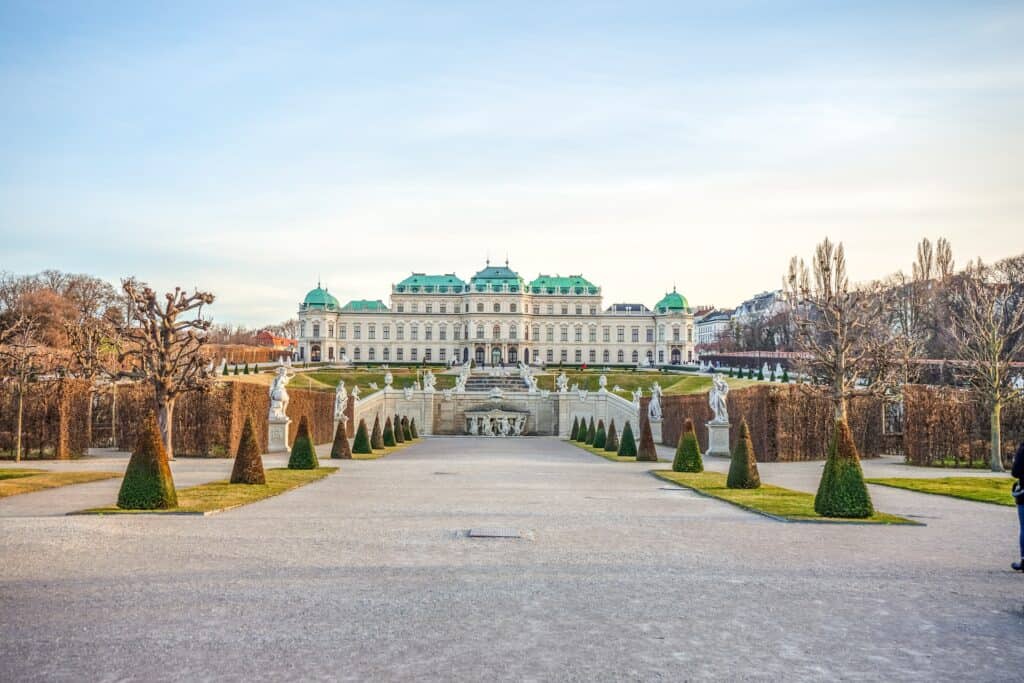
You don’t have much time and are wondering what to do in Vienna in 1 day? Don’t worry, this itinerary ensures you see the city’s star attractions. This day is about capturing the essence of Vienna, seeing its most famous landmarks, and experiencing the city’s atmosphere. While it’s a quick and packed visit, you’ll leave with a sense of Vienna’s pomp and its vibrant cultural scene.
St Stephan’s Cathedral | St. Stephen’s Cathedral & Dom Museum Tickets
Walking Tour in the City Center | Vienna guided walking tour
Albertina Museum | Albertina Museum admission ticket
Belvedere Palace & Gardens | Schönbrunn Palace guided tour
Naschmarkt | Naschmarkt guided food tour
Schönbrunn Palace & Gardens | Schönbrunn Palace guided tour

The best time to visit Vienna for sightseeing is during spring (April to June) and fall (September to October). During these months, the city enjoys mild weather, making it perfect for exploring Vienna’s stunning architecture, beautiful parks, and outdoor cafes.
Additionally, these months are generally less crowded than the peak summer season, allowing for a more relaxed experience at Vienna’s top attractions.
Vienna is a great city to visit in winter as well, especially around the holiday season when the capital comes alive with festive Christmas markets.
Vienna is easy to reach as it is well-connected with the rest of Austria and the world.
By air: Vienna International Airport is located 18 km southeast of the city center and is the largest and busiest airport in Austria. It offers connections to various international destinations. Book this train to the city center for a smooth and hassle-free ride from the airport.
You can also fly to Bratislava Airport in Slovakia, which is located just 60 km from Vienna. Book this private transfer from Bratislava Airport to Vienna’s city center.
By bus: If you’re traveling from within Austria or the neighboring countries, taking a bus to Vienna is a budget-friendly option. The bus terminal is located in the city center and is well-connected with most European cities.
By car: Getting to Vienna by car is pretty straightforward. From within Austria, most major highways take you to the city. On top, Vienna’s road network is well-connected to Bratislava, Budapest, and the Czech Republic. Keep in mind that you need the vignette to use Austrian highways.
By train: Austria offers an excellent railway network that connects Vienna to various major destinations within Austria and neighboring countries. The main train station is situated to the west of the city center and is easily accessible via public buses and subway. I mostly travel by train to Vienna, it’s affordable and super convenient.

Vienna offers excellent public transport including buses, trains, trams, and subways, making it very easy to explore the different corners of the city. Many of the popular attractions are located in Vienna’s city center or along the Ringstrasse and are within walking distance of each other.
This hop-on hop-off bus tour is a great way to explore Vienna and its main sights, especially on those cold winter days.
Vienna is a must-visit city filled with historic architecture, rich culture, and classical music scene. The city’s imperial palaces, famous art galleries, and lively neighborhoods offer a unique blend of past and present.
Austria offers diverse experiences, from rich culture, stunning landscapes, and historic cities like Vienna and Salzburg, to outdoor activities like skiing and hiking in the Alps. For insights on must-visit attractions and tips to make the most of your experience in this wonderful country make sure to check all my articles on Austria!
Vienna: Where to stay in Vienna Vienna in winter Best day trips from Vienna
Salzburg: Salzburg Itinerary Where to stay in Salzburg Salzburg in winter
Hallstatt: Your guide to visiting Hallstatt
Travel Insurance
Good travel insurance is an absolute must when traveling abroad, and I’ve learned that the hard way!
Now I always get insured before we leave and Travel Insurance Masters is my go-to platform to find the best insurance options for the specific trip.
The TIM platform works as a search engine and suggests the best insurance company and insurance plan for your criteria so you don’t end up paying more for things you don’t need! It also takes into account your age, nationality, destination etc. which can greatly impact the final price.
You can get your quote & provider recommendations here.
Doris Aschauer
Doris is a Salzburg local who has lived in the Mozart city for the past 10 years. She’s had the pleasure of calling different parts of this beautiful city home, which helped her discover all its hidden gems and the city’s real charm. While Doris loves Salzburg in all its seasons, there’s something truly magical about winter, making it her favorite time of the year in Salzburg.
When she’s not in Salzburg, you’ll find her traveling to the best scuba diving destinations in the world and sharing her experiences on her blog Doris Gone Diving.
Leave a Reply Cancel Reply
Your email address will not be published. Required fields are marked *
Name *
Email *
Save my name, email, and website in this browser for the next time I comment.
Post Comment
Self-guided Walking Tour of the Vienna City

- 29 audio recordings narrated by a professional historian
- Audio Guide App for iPhone and Android
- Illustrations to identify the landmark
- Lifetime access to the tour, available in your preferred language.
- Offline map with route for easy GPS navigation
- Human Guide
- Smartphones and headphones
- Transportation
- Stephansplatz, 1010 Wien, Austria Tour starts at Stephansplatz, launch the app and start 'Vienna Sightseeing Tour' on your smartphone.
- Near public transportation
- Not wheelchair accessible
- Confirmation will be received at time of booking
- Most travelers can participate
- Tour duration consists of time spent on tour stops and time for walking the route
- This is a private tour/activity. Only your group will participate
- For a full refund, cancel at least 24 hours in advance of the start date of the experience.
Similar experiences

- You'll start at Stephansplatz Stephansplatz, 1010 Wien, Austria Tour starts at Stephansplatz, launch the app and start 'Vienna Sightseeing Tour' on your smartphone. See address & details
- 1 St. Stephen's Cathedral Stop: 15 minutes See details
- 2 Church of the Teutonic Order Stop: 10 minutes See details
- 3 Plague Column (Pestsaule) Stop: 10 minutes See details
- 4 St Peter's Catholic Church Stop: 10 minutes See details
- 5 Demel Stop: 10 minutes See details
- 6 Michaelerplatz Stop: 10 minutes See details
- 7 Statue Emperor Joseph II Stop: 10 minutes See details
- 8 Donnerbrunnen Stop: 10 minutes See details Pass by Imperial Crypt
- 9 Memorial Against War & Fascism Stop: 10 minutes See details Pass by Albertina Vienna State Opera
- 10 Mozart Monument Stop: 10 minutes See details
More to explore in Vienna

Buy it with

Self-guided Walking Tour of the Vienna City - with unbiased reviews
Finding the Universe
Travel tales, photography and a dash of humor
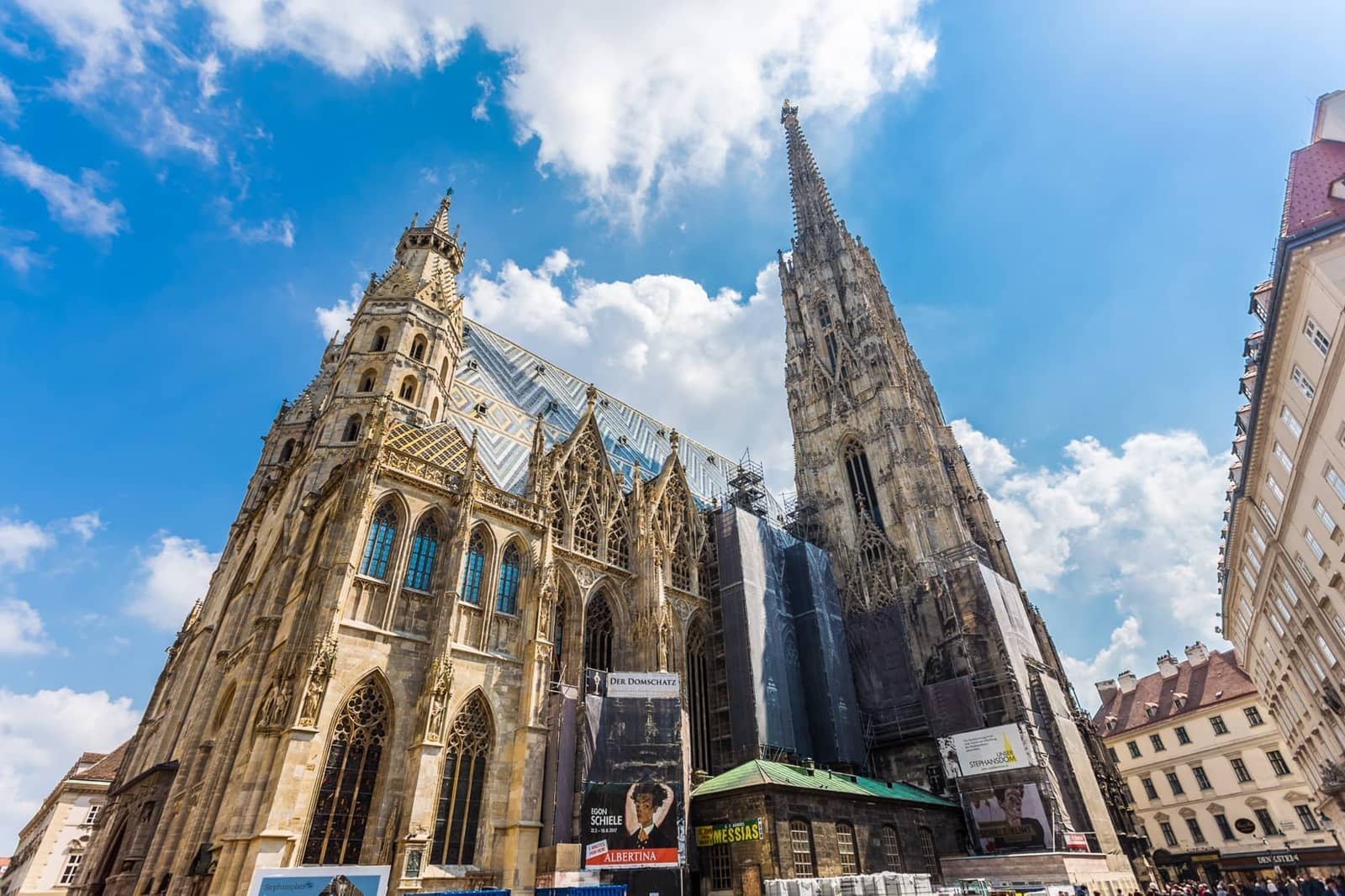
A 2 Day Vienna Itinerary
Last updated: March 25, 2024 . Written by Laurence Norah - 52 Comments
Jess and I have visited Vienna in Austria a number of times, and it’s always a city that we are excited to visit. It’s a fantastic place for culture lovers, having played home to such icons as Mozart, Haydn, and Strauss. It was also the seat of the vast Habsburg empire, which for a time was one of the largest empires in the world.
As you can imagine therefore, there’s quite a lot to see and do here, whatever time of year you are visiting. In summer you can enjoy warm days and pleasant strolls through the streets, whilst if you visit Vienna in winter, you’ll find some of the best Christmas markets in Europe.
This guide is designed to give you some ideas for what to do on a two day visit to Vienna. I will warn you up front – two days is definitely not going to give you enough time to see everything! Vienna is stuffed full of museums, palaces, art galleries, churches and restaurants, and you could spend a great deal of time here sight-seeing.
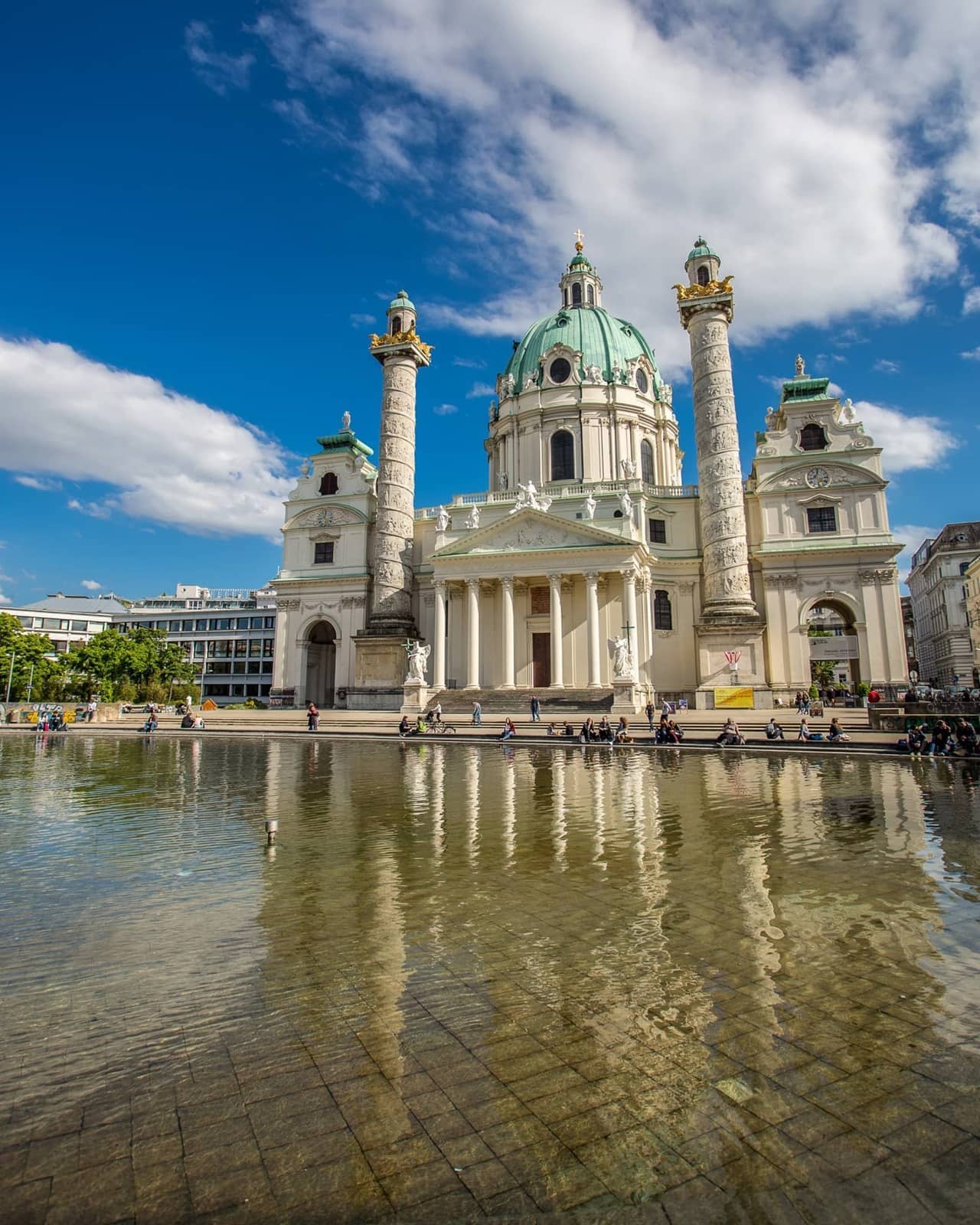
So in this post I’ve tried to focus on some of the highlights and our favourite activities. We’ll also be putting together some longer itineraries if you’re lucky enough to have a bit more time to spend in this wonderful city.
If you have more time, take a look at our suggestions for three days in Vienna.
2 Days in Vienna Itinerary
Day 1: vienna itinerary, st. stephens cathedral.
Right in the centre of Vienna, St. Stephens Cathedral is an icon of the city skyline, and the seat of the Catholic church in Vienna. There’s been a church on this location since the 12th century, although the current version with its stunning multi-coloured tiled roof was largely completed in the early 16th century.
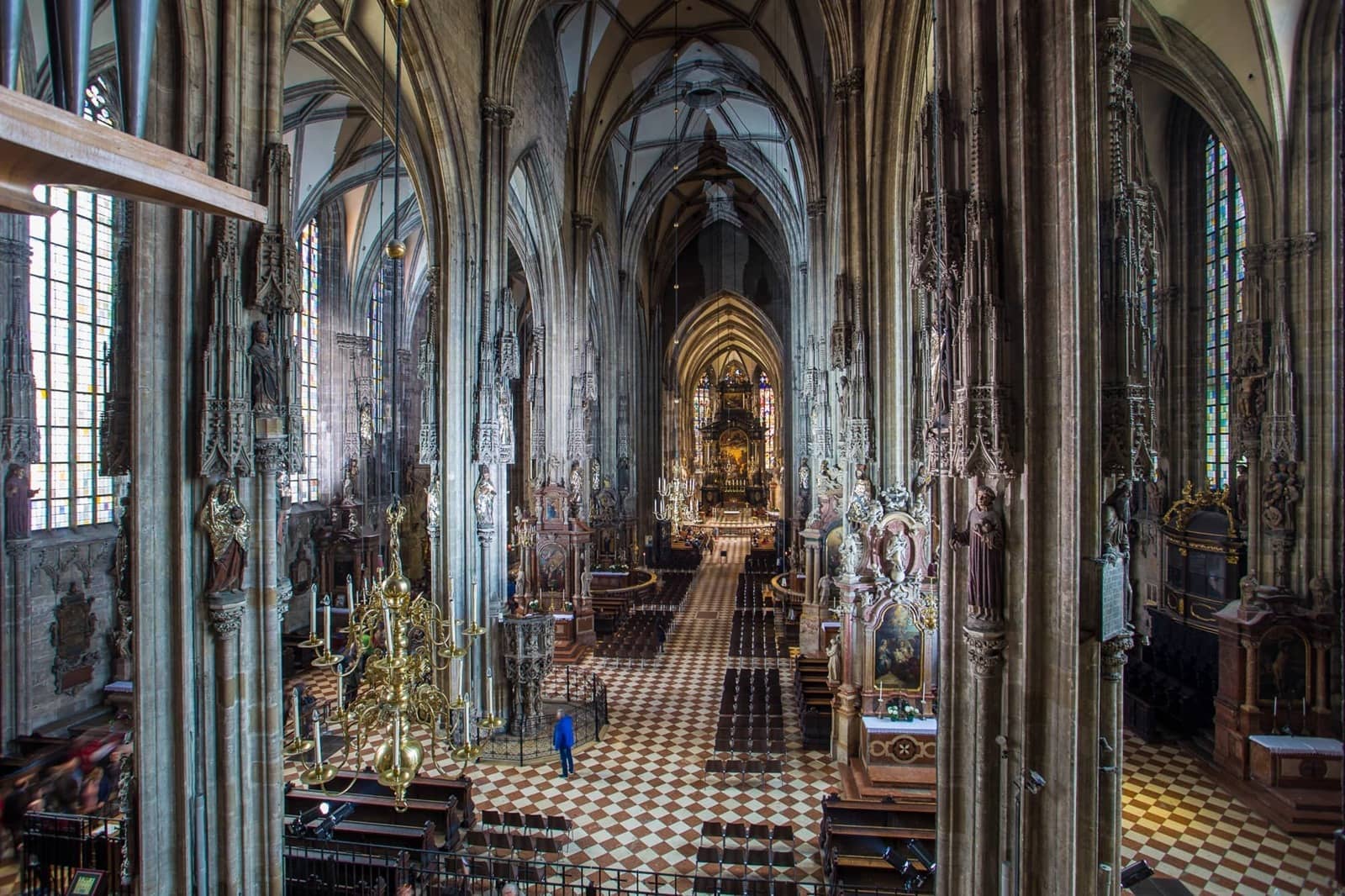
The church itself is free to enter, and being a popular attraction, it gets very crowded. We’d definitely recommend that you visit the treasury. This is a paid attraction, however it takes you up a floor or so above the main church floor, and as far fewer people visit, you can enjoy the views of the church interior with less of the crowds. It’s also included on the Vienna Pass .
You can also head up both the south (136m high) and north (68m high) towers. These have individual prices – the south tower requires a certain level of fitness as it has 343 steps, whilst the north tower is accessible via a lift. Both offer close up views of the roof, although the south tower being higher offers more expansive city views.
Time Travel Vienna
To get a fun overview of some of the history of Vienna, our next stop is the Time Travel Vienna experience. This is a 50 minute partly guided tour through an underground “adventure area”, which features a 5D cinema ride, animated mannequins, and guides who provide commentary and information (audioguides are also available in 10 languages).
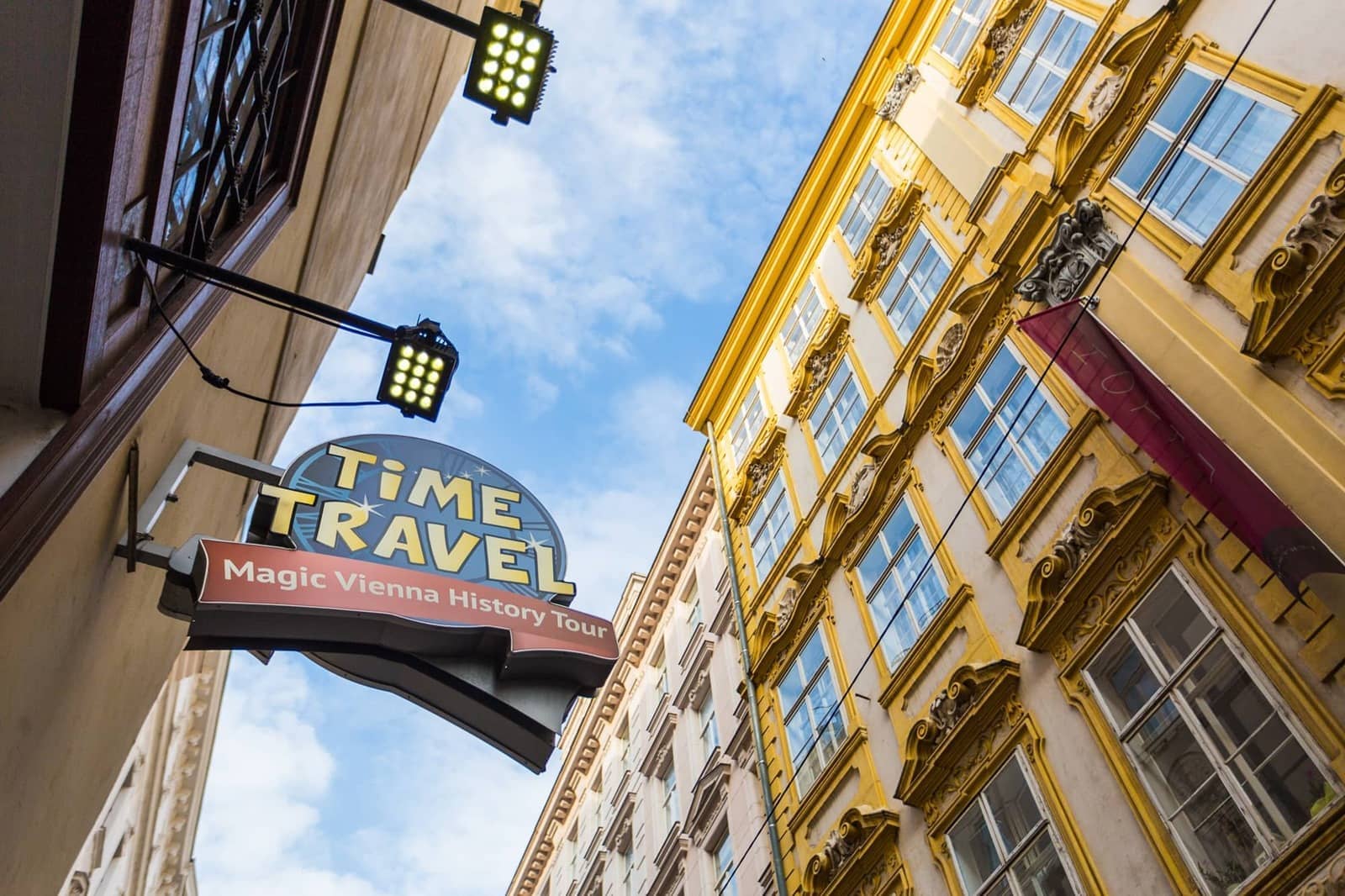
We really enjoyed this experience – it helped give us an overview of some of the key events that have shaped Vienna, from the time of the Romans through to the present day. It’s an excellent (and fun!) orientation, and should appeal to all ages.
Time Travel Vienna is open daily from 10am – 8pm, with the last tour starting at 7pm. There’s a fee for entry, and you can check times and prices here , and book your tickets in advance here .
This is included on the Go City Vienna Pass .
Time for some museums. Vienna has a huge range of museums covering nearly every niche, so do feel free to swap different museums into this itinerary depending on your interests.
There’s everything from Mozart’s House to a museum entirely dedicated to globes (one of Jess’s favorites!).
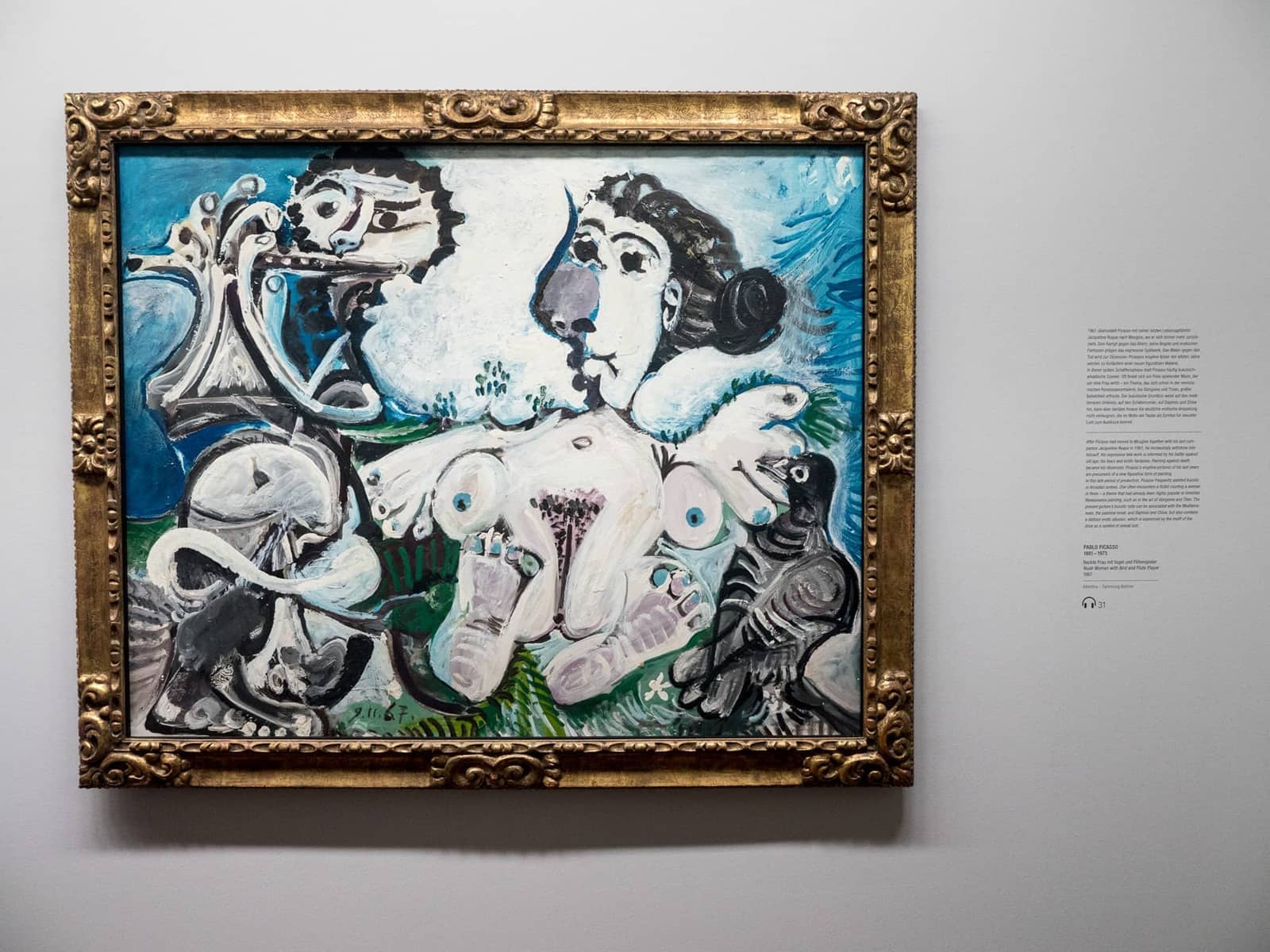
The Albertina though, is definitely worth having on your itinerary. Partly a palace and partly a museum, it has an excellent collection of classic modernist paintings, including a number of works by Monet and Picasso on permanent exhibition. They also have over 100,000 photographs in their collection, some of which are displayed on a rotating basis.
There are also rotating exhibitions from the Albertina’s collections of modern art, contemporary art, graphic art and architectural art, as well as guest exhibitions. Check their official website for details of what will be on when you visit. And don’t forget to also visit the staterooms when you do.
The Albertina is open daily from 10am to 6pm, and until 9pm on Wednesdays and Fridays. There’s an admission fee – you can see more at the official website here . Entry is included on the Vienna Pass, or you can buy a ticket online in advance here .
Lunch at Augustinerkeller
Directly underneath the Albertina and in the site of one of Vienna’s few remaining ancient monastery cellars, this Austrian restaurant has been in the hands of the Bitzinger family since 1954.
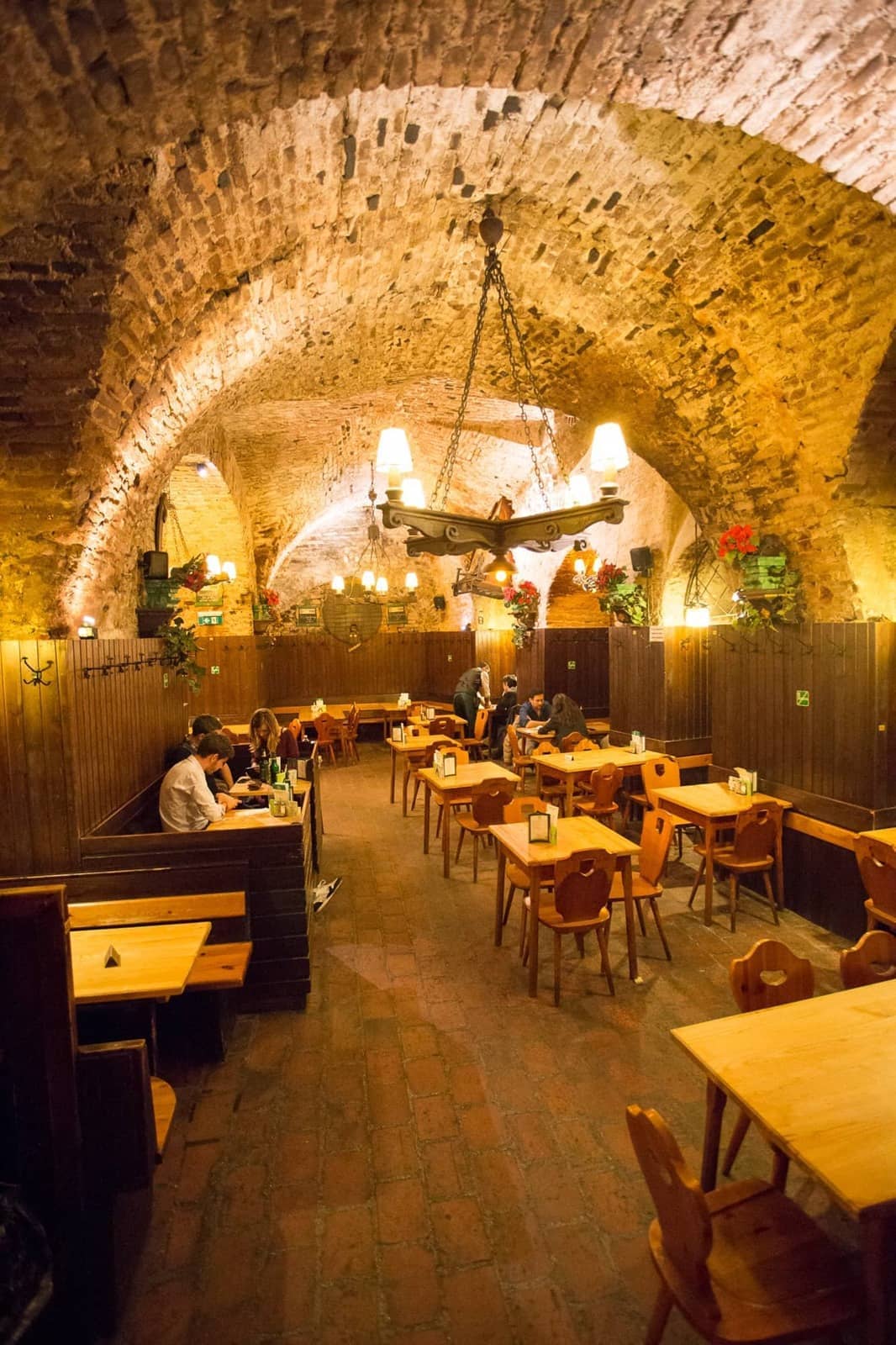
There’s a focus on excellent, traditional Viennese food, as well as their own brand of beer. This is an excellent place to grab yourself some lunch in between adventures in gorgeously traditional surroundings.
Food in Austria tends to be fairly heavy (but delicious), so we recommend not over-ordering. Local specialities include Schnitzel, Goulash, Tafelspitz (boiled beef) and of course, Appel strudel. We loved eating here and are sure you will too. See their official website for opening hours and menu examples.
Note – the Augustinerkeller has been closed for some time. We hope it reopens, but in meantime, we also enjoyed meals at both Zwolf Apostkeller and Glacis Beisl .
Natural History Museum & Kunsthistorische Museum
Full from lunch, it’s time to push on for a bit more culture. Again, so much to choose from in Vienna, but we’re going to suggest two popular options which happen to be directly opposite each other and of the same exterior design.
These are the Natural History Museum , and the Kunsthistoriche Museum , which sit right beside the Hofburg Palace complex and also Vienna’s Museum Quarter . Yes, Vienna has a whole museum quarter!
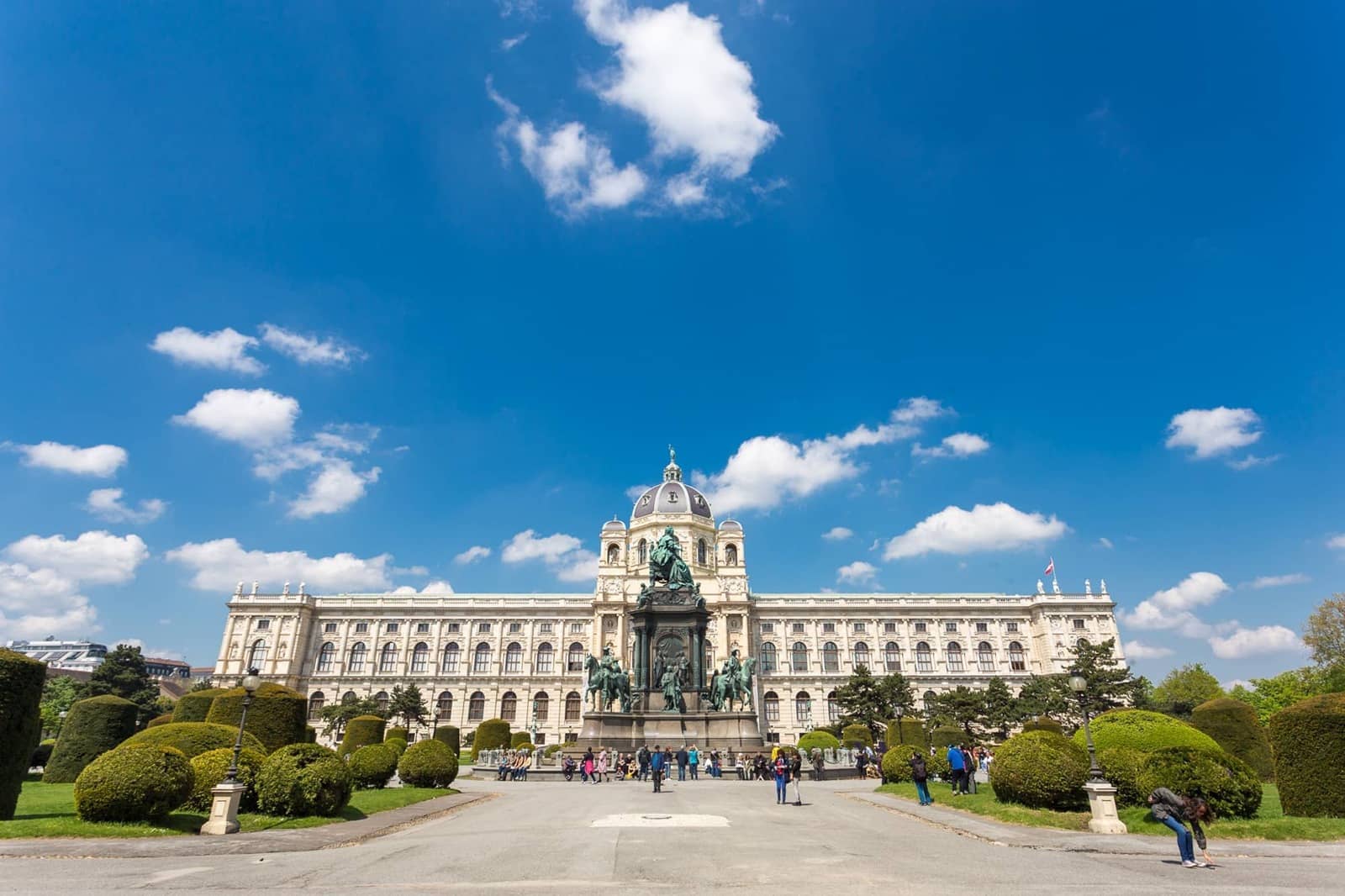
The Natural History Museum, opened in 1889, focuses on the natural history of the world, with everything from meteorites to dinosaur skeletons. The building itself is truly magnificent, built in a palatial style, and is worth visiting of itself.
Directly across from the Natural History Museum is the Kunsthistoriche Museum, or Museum of Art History.
This is a massive museum dedicated to the arts which opened in 1891 – both of these buildings were originally built to house the rather extensive Habsburg collection and make it accessible to the public.
The Kunsthistoriche Museum in particular features a large number of pieces from the Habsburgs, and includes paintings, sculptures and antiquities. You can book your tickets for the Kunsthistoriche Museum online in advance here .
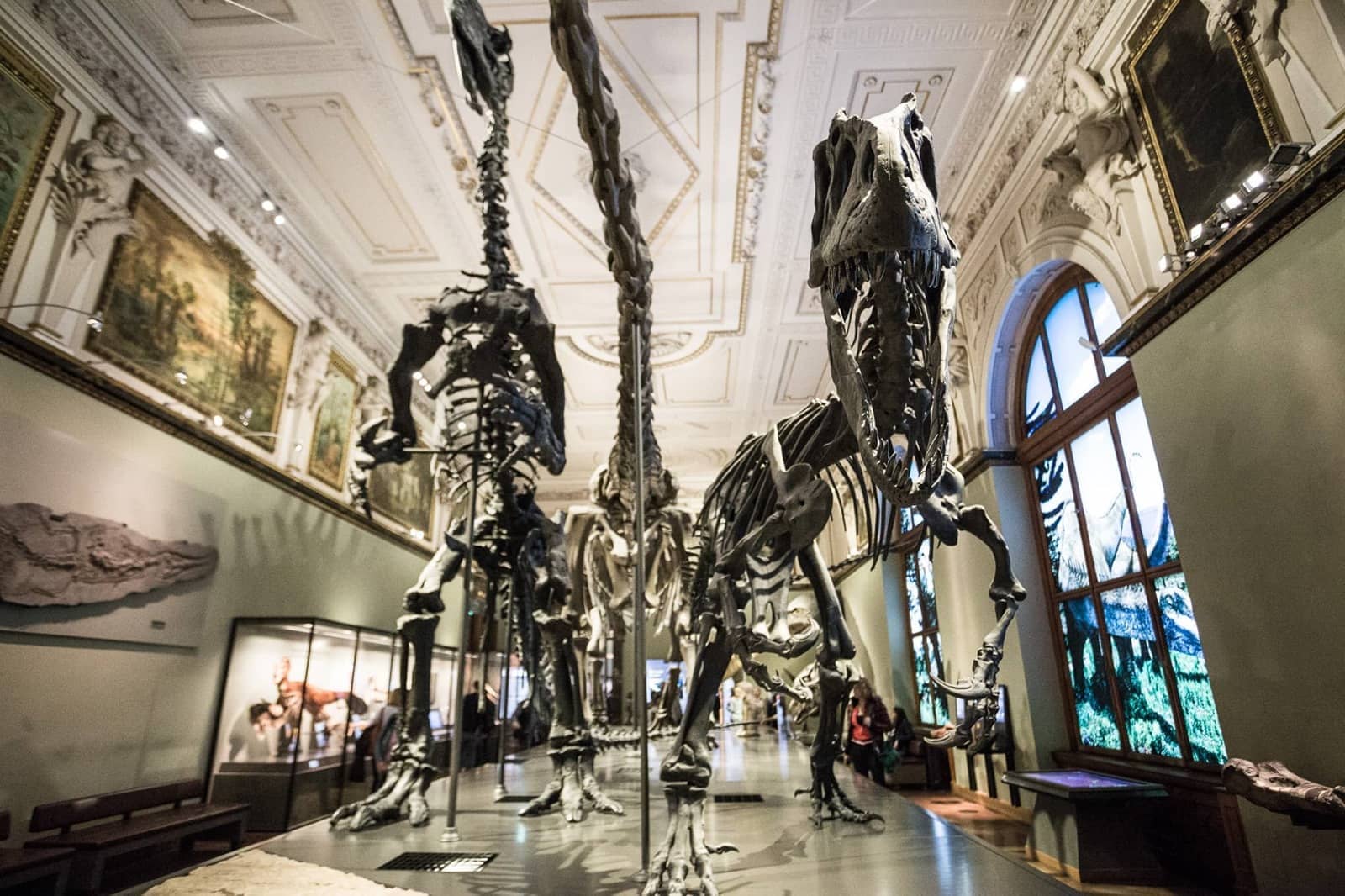
Fear not if neither of these museums pique your interest. Only a few minutes walk from both of these you’ll find the Papyrus Museum , the Modern Art Museum , the Leopold Museum and of course the various Habsburg museums. You will definitely not run out of museums to visit in Vienna!
Most of these museums are included on the Vienna Pass and/or the Go City Vienna Pass .
City River Cruise
All that museum time might have you hankering for a more relaxing way to spend your afternoon, so we suggest that you allocate some time to taking a river cruise along the Danube River, or at least, the Danube Canal, an arm that branches off the main river and runs near to the old part of Vienna.
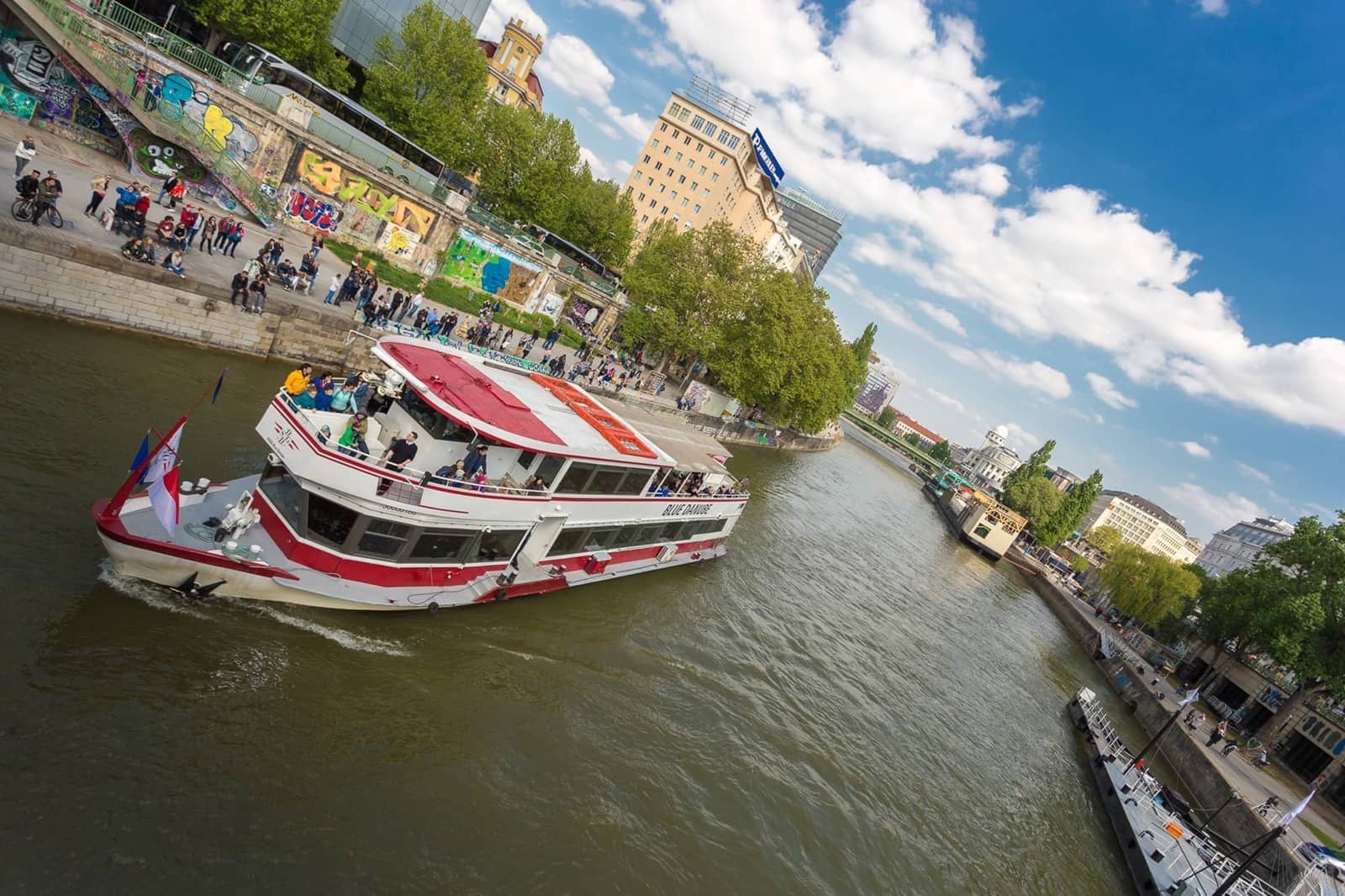
There are a number of companies that offer river cruises of varying lengths.
We took the option that was included on the Vienna Pass , a 75-minute cruise aboard the MS Blue Danube, which we enjoyed very much, watching the sights of Vienna roll by accompanied by a cold beer and some Viennese schnitzel. Definitely a good way to spend the afternoon!
If you don’t opt for the Vienna Pass, you can book a cruise online in advance here .
A Ride on the Giant Ferris Wheel
As you come towards the end of your first day, we think you might enjoy heading up into the sky for great views over the city. Ideally, you’ll have timed this for sunset, although of course this will depend on the time of year you visit.
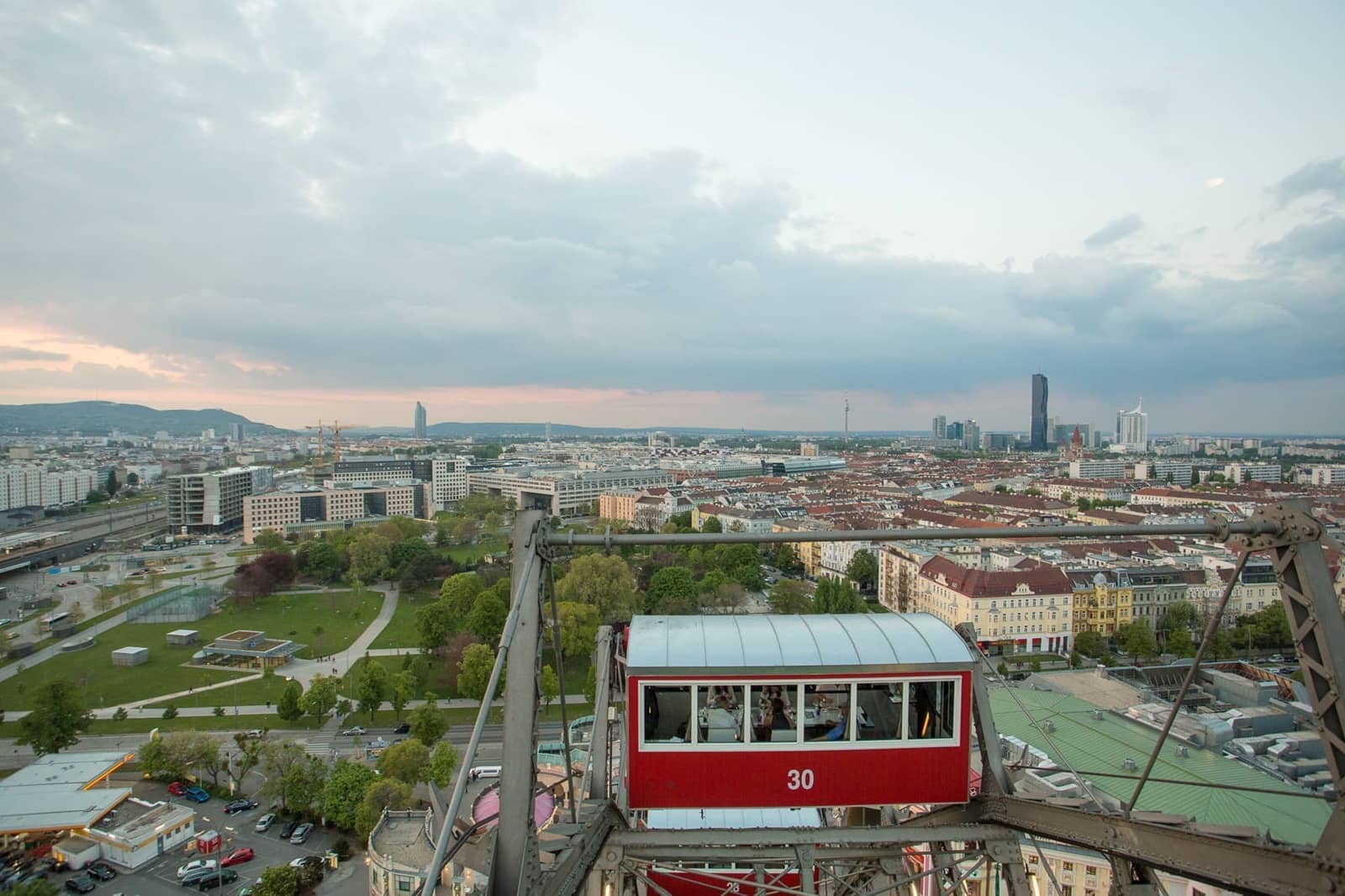
One of the best ways to get a great view of the city skyline is aboard the Vienna’s “Giant Ferris Wheel”, officially known as the Wiener Riesenrad . This is found in the Prater amusement park a couple of metro stops from Schwdenplatz where the city cruise departs and returns to.
Originally built in 1897, the wheel was the world’s largest of its type for 65 years, and is one of the few surviving 19th century Ferris wheels. It was however heavily damaged in World War 2, so much of it dates from 1945.
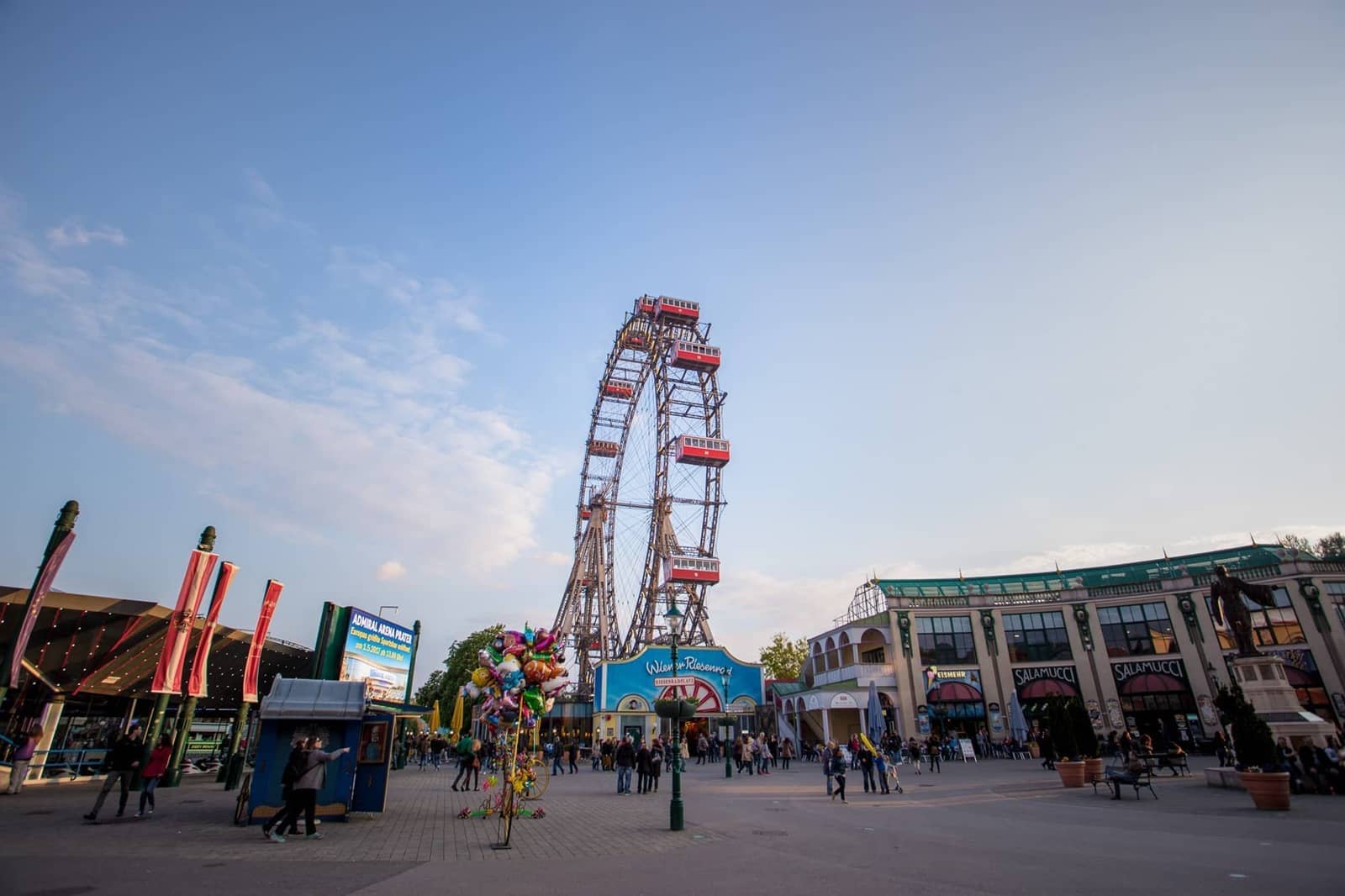
History aside, it’s an excellent place to get a great view of the Vienna skyline, especially at sunset. The ride takes around 20 minutes for one full revolution and is a nice way to end your day of exploring.
There is a fee to ride it, and it’s also included on the Vienna Pass. You can also purchase tickets in advance here .

Day 2: Vienna Itinerary
Schönbrunn palace.
Schönbrunn Palace is a must-visit when in Vienna, and even though it will take up at least half of your second day in the city, we’d suggest it’s more than worth it.
There’s a huge amount to do here, and we’d even forgive you for spending the whole day here and skipping the other attractions on our itinerary – there’s just so much to do here!
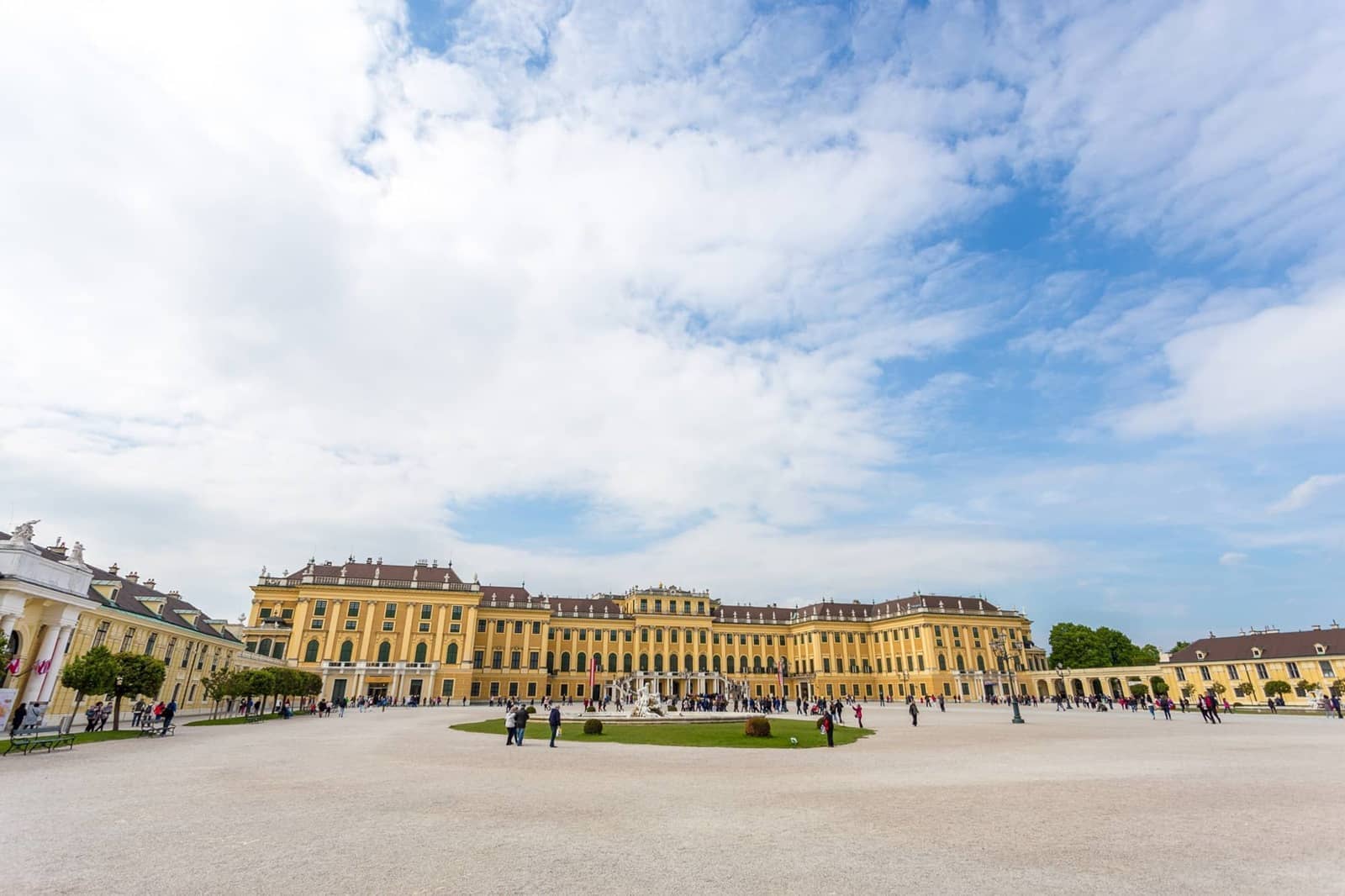
The Palace itself, now a UNESCO world heritage site, was the centre of Viennese court life in the 18th century, and is one of the finest examples of Baroque architecture in Vienna.
It was witness to a number of historical events, and was where a six year old Mozart had his first major concert. With over 1,400 rooms, it’s not exactly small, and there are hundreds of acres of garden to explore, with a number of attractions to visit as well.
Being so popular means that you’ll want to arrive as early in the day as possible, especially if you want to do the tour inside the palace itself, as this gets booked up very quickly. We arrived at the palace before 10am, and the first tour wasn’t available until after 12!
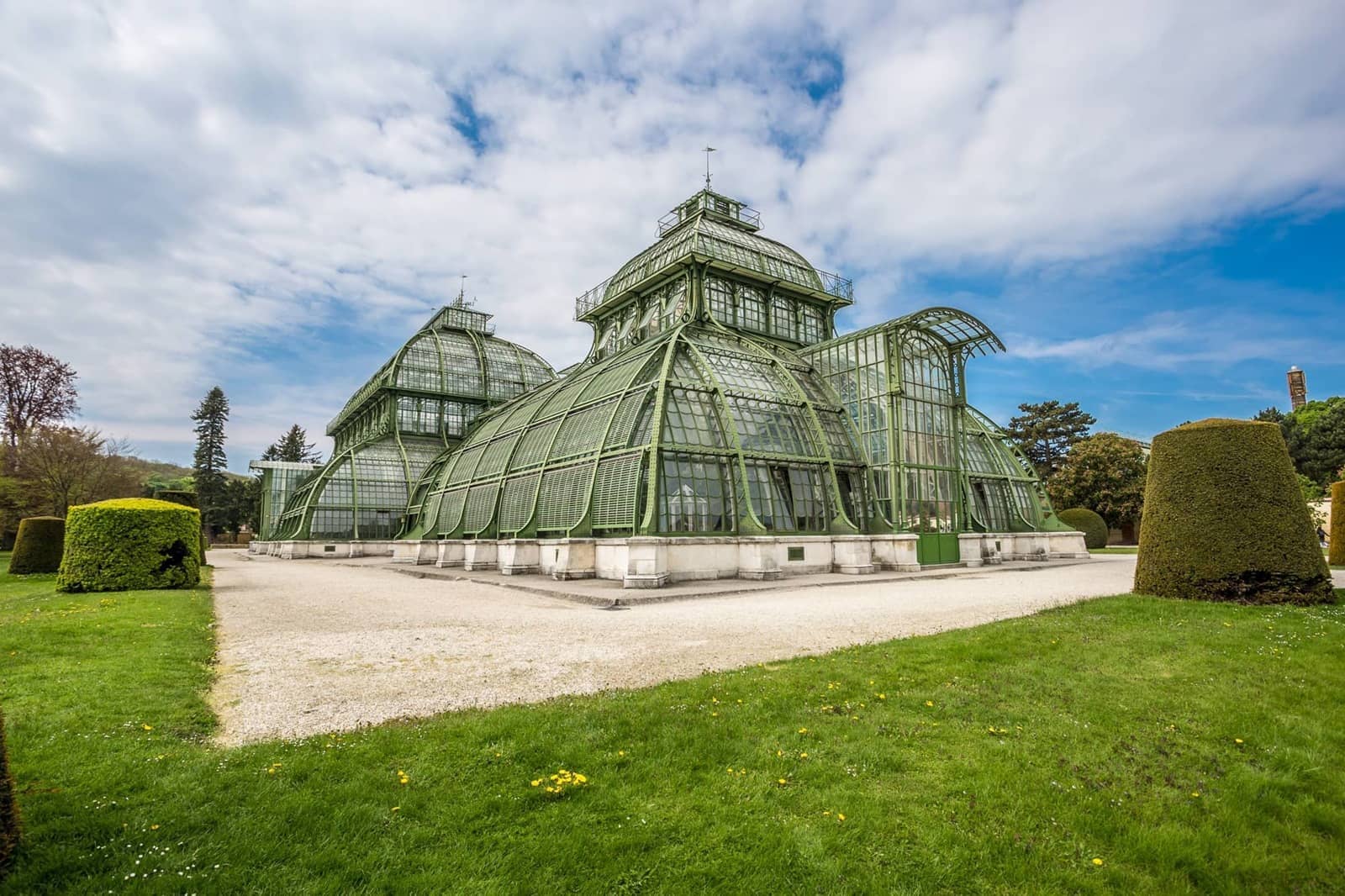
Thankfully, there’s plenty more to do than tour the palace. We’d highly recommend you visit the Carriage House, the world famous Schönbrunn Zoo (the oldest zoo and one of the best zoos in Austria), the Glorietta (which offers incredible views of the palace and Viennese skyline), the labyrinth, the Palmhaus and the Princes Gardens.
We also loved the Strudel show, where you’ll learn how the famous Austrian dessert is made, plus get a slice of your own!
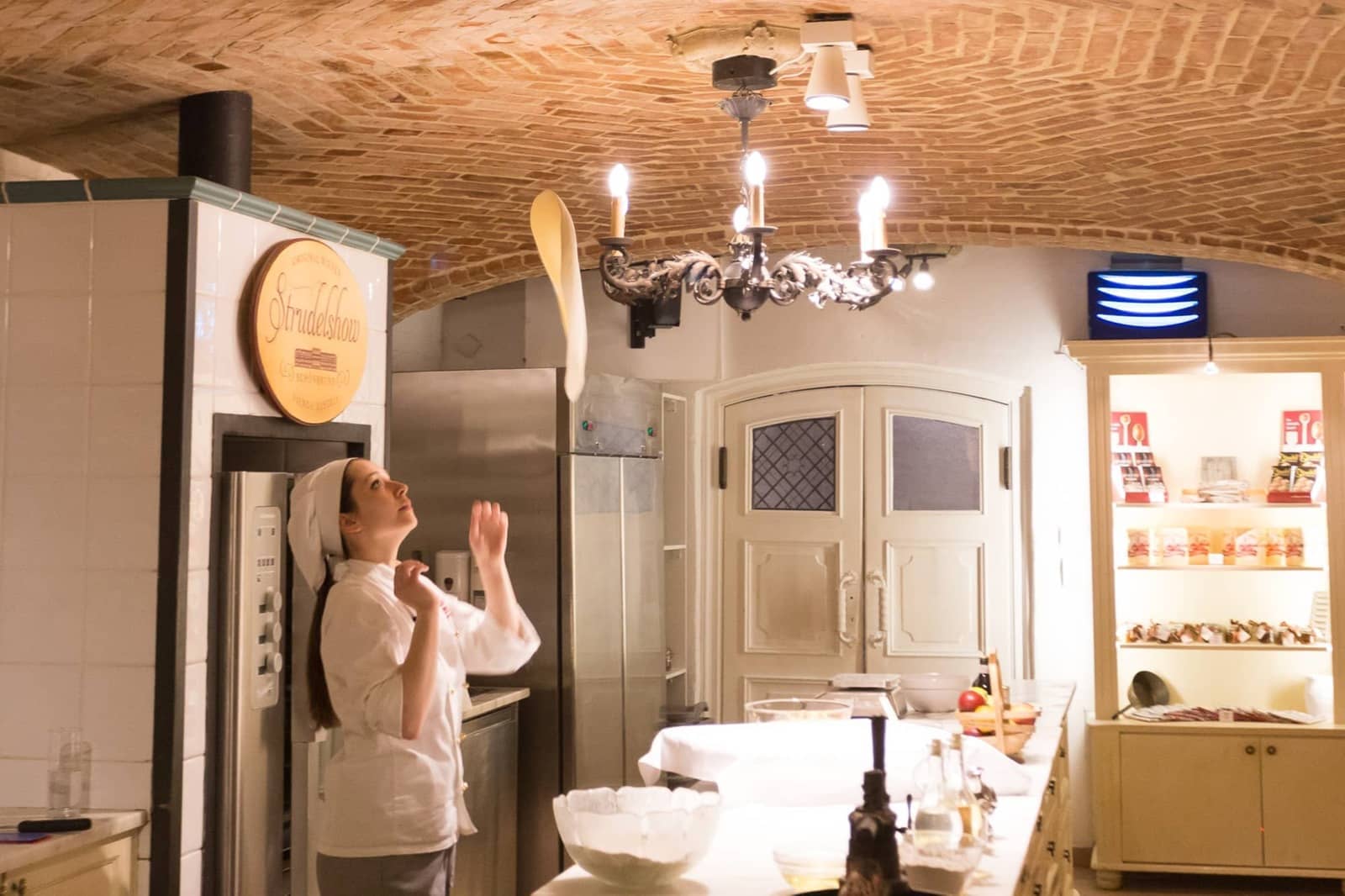
Just wandering the grounds on a nice day is a pleasure of itself, and you could even bring a picnic to make a real day of it. Definitely not to be missed when visiting Vienna!
Schönbrunn is a few kilometres outside of the city centre. It’s easily accessible by metro from central Vienna, and is also on the hop-on hop-off bus route.
Schönbrunn Palace is open every day, including public holidays. Closing times vary depending on the time of year, but it opens every morning at 8am, when tickets and display rooms are opened. You can see opening times and prices here .
Schönbrunn Palace is also included on the Vienna Pass, and we highly recommend the pass if you are planning on visiting the palace, which is relatively expensive due to all the various attractions on site.
If you don’t want to buy a pass, we highly recommend buying a ticket in advance to skip the lines, which you can do from the official site here .
Another option is to take a guided walking tour of the palace, such as this well reviewed one . This will also skip the lines, as well as give you lots of information and historical context about the palace.
Military History Museum
If you manage to pull yourself away from Schönbrunn, we’d suggest taking the hop-off hop-on bus (also included in the Vienna Pass) to a couple more locations before returning to the city centre.
First of these is the Vienna Museum of Military History.
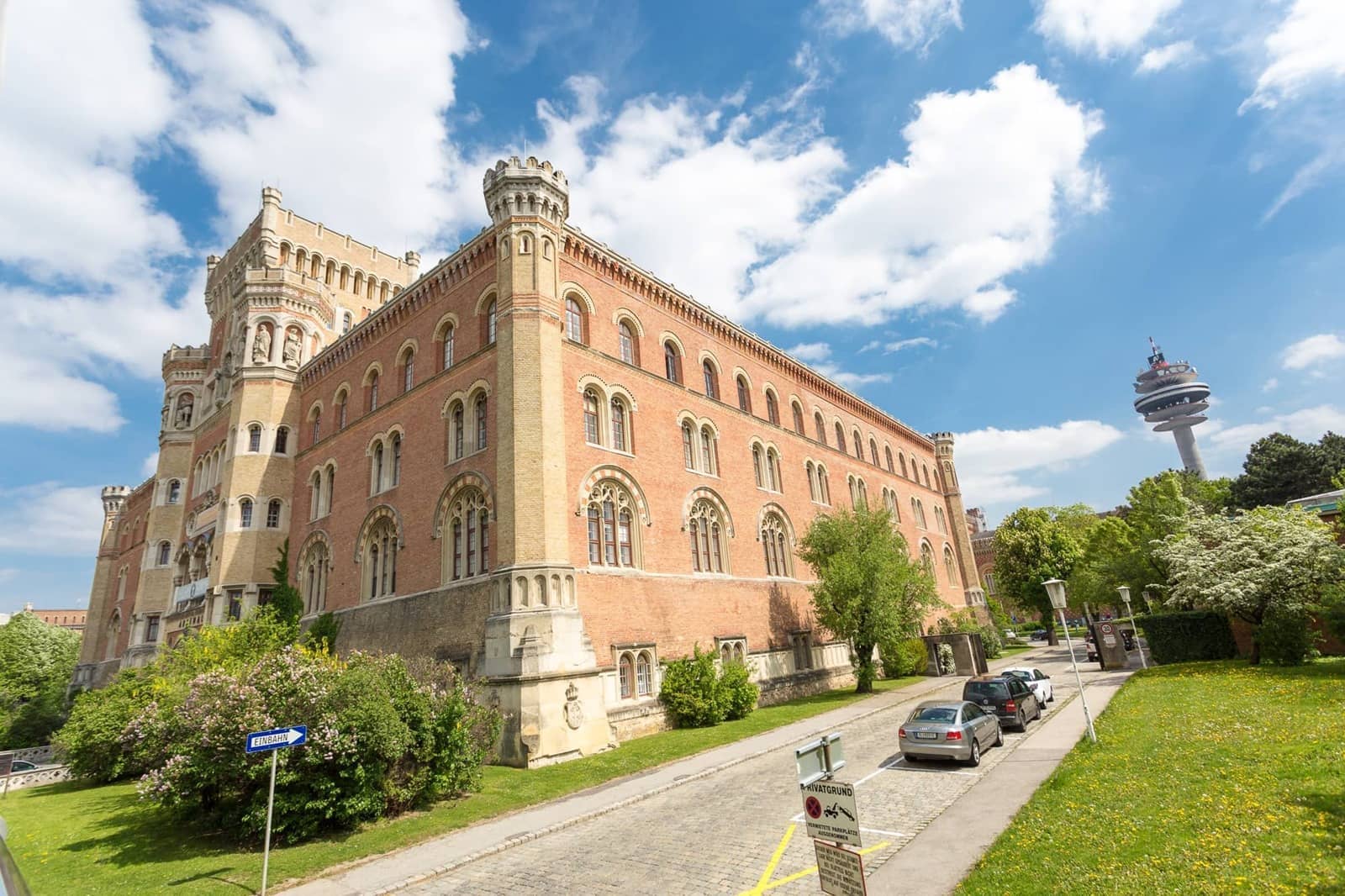
This museum covers the full history of the Austrian military, with everything on display from military weapons and vehicles through to uniforms and medals, spanning a time period of the 16th century up to the present day.
It’s housed in Vienna’s oldest purpose built museum building, which formed a part of Vienna’s original arsenal complex. Again, almost worth visiting for the building alone!
The Museum is open daily from 9am – 5pm, with some exceptions for public holidays. There’s an admission fee, and you can see full details of fees and opening hours here . Included on the Vienna Pass.
Belvedere Palace
Further along from the Military History Building on the hop-off hop-on bus route (or a relatively short walk), you will come to the UNESCO listed Belvedere palace complex. This consists of two palaces, the Upper and Lower Belvedere and is home to the Belvedere Museum.
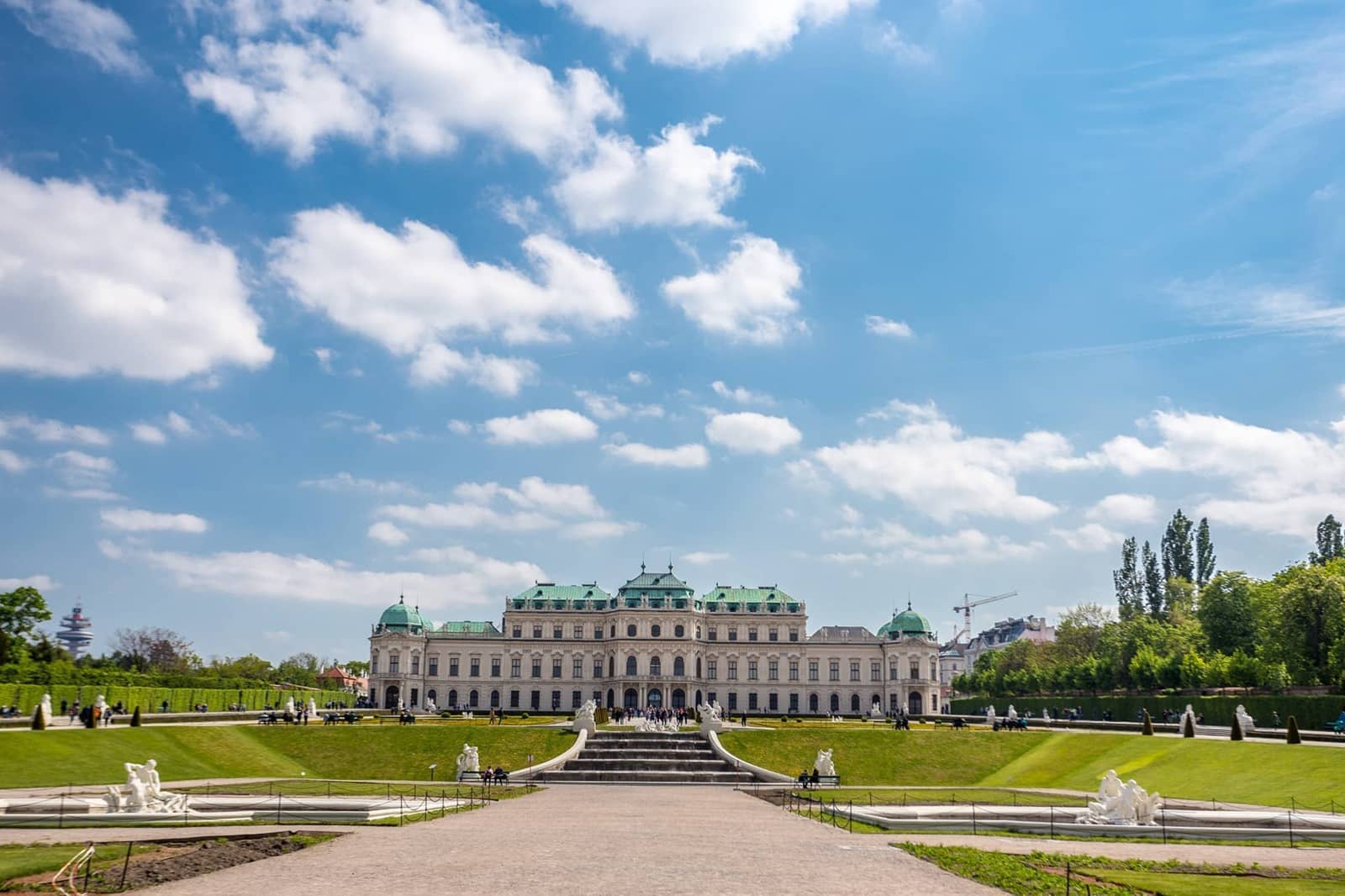
These were constructed in the late 17th and early 18th century by Prince Eugene, at a time when magnificent buildings were popping up all over Vienna. The two palaces are constructed at opposite ends of the landscaped gardens, and were used by Prince Eugene as his summer residence.
Today, as well as being able to visit the grounds, you can tour the Baroque-style palaces, which are home to one of Vienna’s best collections of Austrian Art, including the famous “Kiss” painting by Gustav Klimt.
The Upper Belvedere is open daily from 9am – 6pm (9pm on Fridays), and the Lower Belvedere is open daily from 10am – 6pm (9pm on Fridays). Each palace has an individual entry fee, and you can see full details of fees and opening times here .
Both are also included on the Vienna Pass, or you can buy your tickets online in advance here .
Rooftop Bar
It must be time to relax after all that culture, and what better place to do that than at one of Vienna’s rooftop bars?
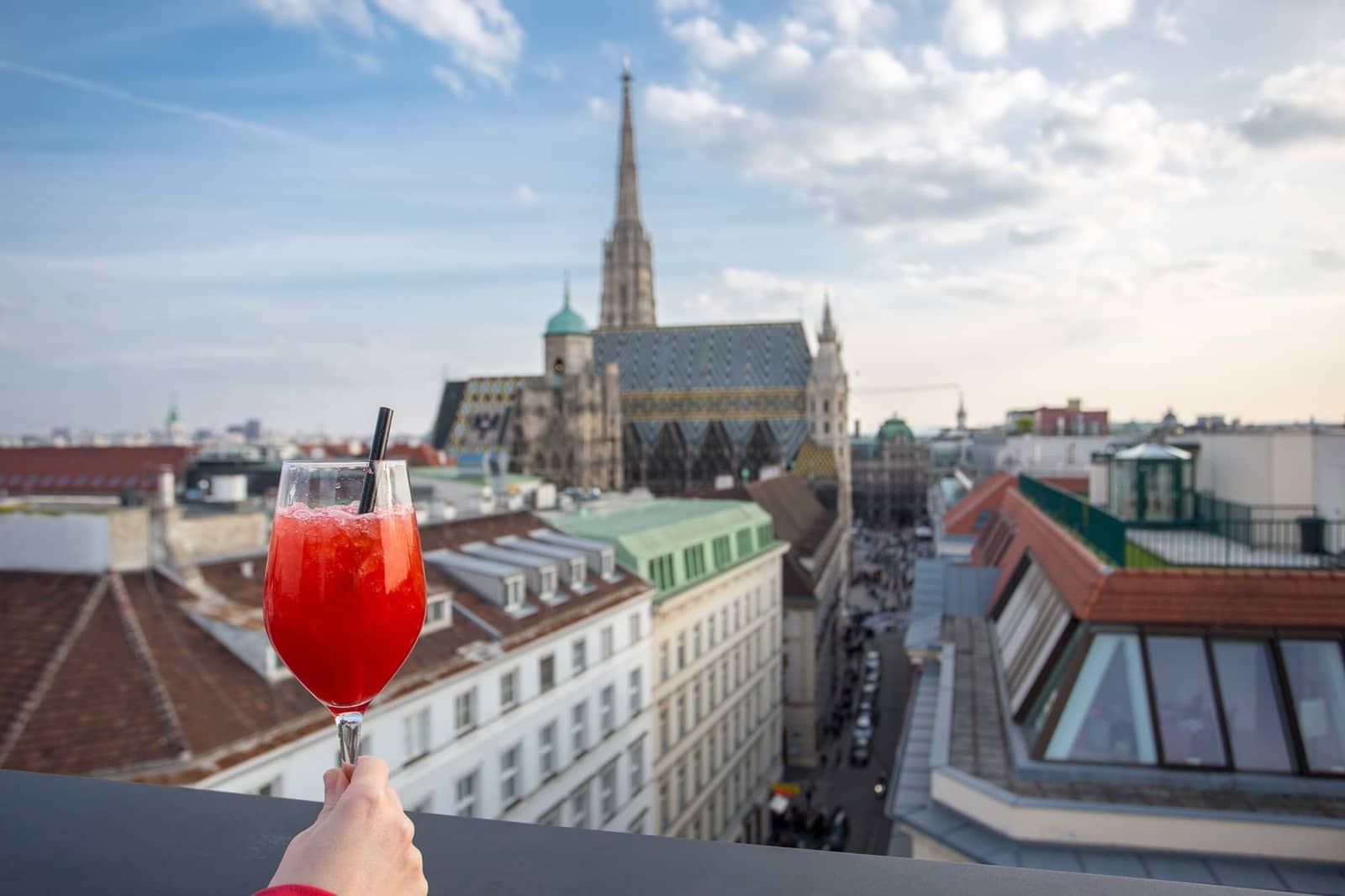
There are many to choose from – we enjoyed cocktails at Cafe Bar Bloom accompanied by lovely view of Stephansdom and the sun setting over the city. They also serve snacks on the rooftop or you can head downstairs for a meal.
Dinner at Zwolf Apostkeller
Just round the corner from Cafe Bar Bloom is another of Vienna’s monastery cellar restaurants – the Zwolf Apostkeller . Housed in a building that dates from at least 1339, this winding maze of arched brick ceilings offers authentic old-world charm with classic Viennese dining and drinking options.
You might also be serenaded by live musicians as you dine! A wonderful way to round out the end of this two day Vienna itinerary.
Map of Itinerary for 2 Days in Vienna
To help with your planning we have put together this map of all the attraction you can visit during your 2 days in Vienna. You can also see this on Google Maps here .
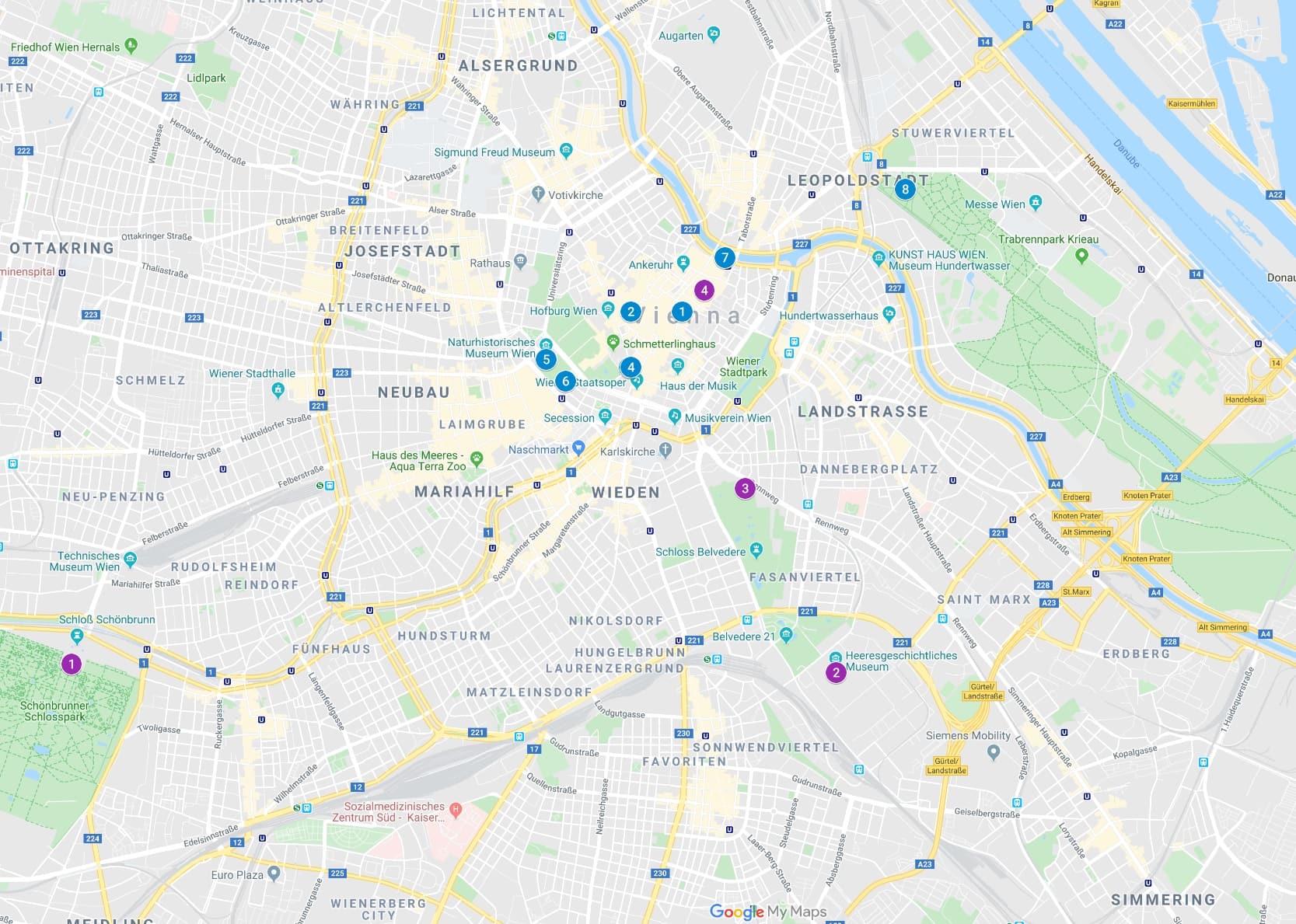
2 Days in Vienna Itinerary Overview
- Day 1: St. Stephen’s Cathedral, Time Travel Vienna, Albertina, Lunch at Augustinerkeller, Natural History Museum & Kunsthistorische Museum, City River Cruise, Giant Ferris Wheel
- Day 2: Schönbrunn Palace, Military History Museum, Belvedere Palace, Rooftop Bar, Dinner at Zwolf Apostkeller
Practicalities for Visiting Vienna
Now we’ve covered what to see for a two day stop in Vienna, let’s look at some of the practicalities for visiting this wonderful city. Starting with:
How to Get Around Vienna
Central Vienna is incredibly walkable, with the majority of the attractions located inside the “ring road”, which runs around the central city and follows the route of the old city walls.
For attractions that are further out, Vienna has a good public transport system which will get you easily and quickly to all the main sights. If you think you’ll be using public transport extensively, investing in a transport card for your time in Vienna is likely going to be the cheapest option, although in our experience, we hardly needed them.
The cards can be purchased at ticket machines located at all the subway stations in time periods of 24, 48 and 72 hours, and let you use all the public transport options in the city.
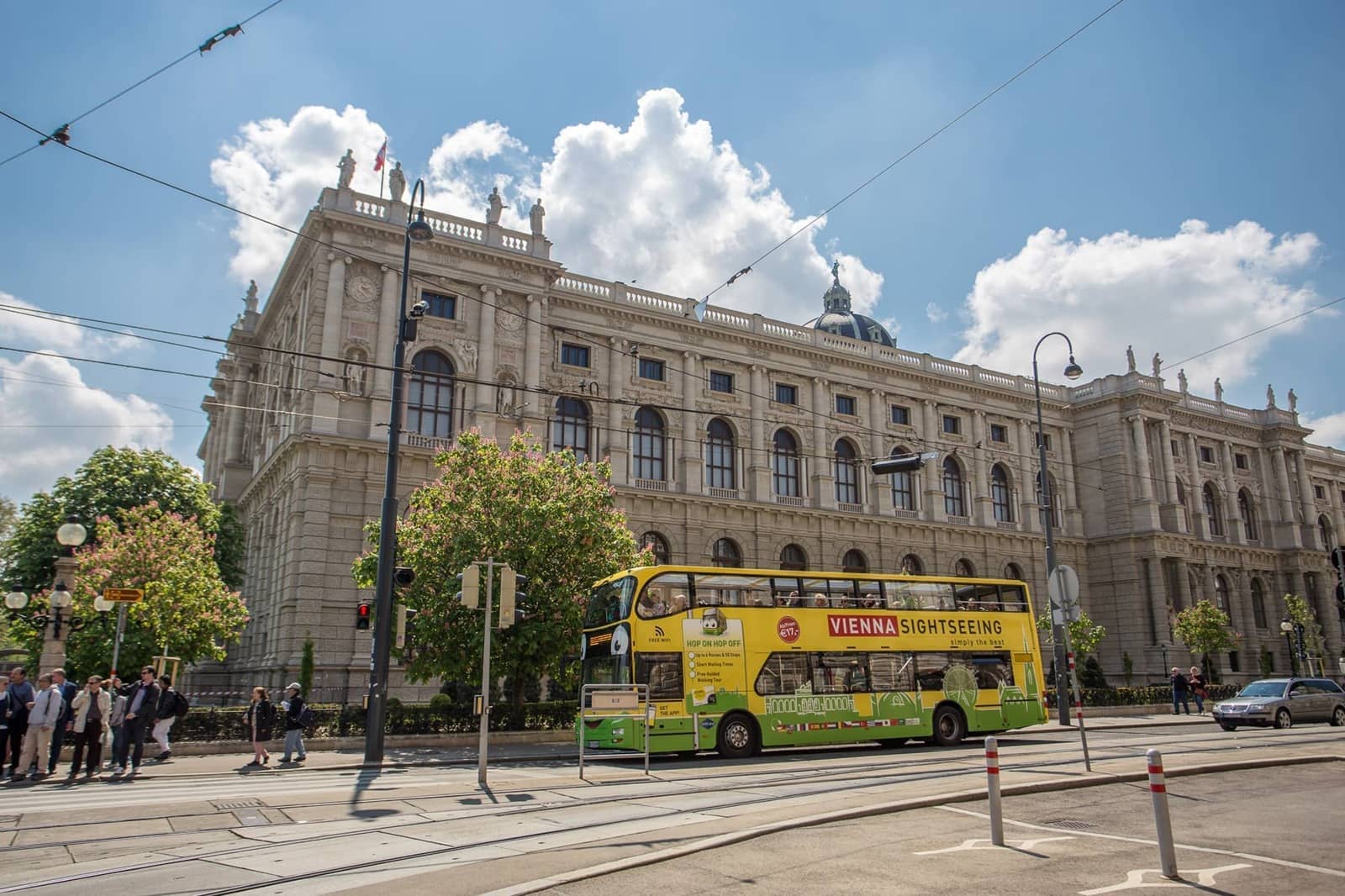
Alternatively, you can buy tickets for the hop-on hop-off sightseeing bus which offers narrated sightseeing and transportation. It is also included as part of the Vienna Pass . This covers all the major attractions in the city, including those further out destinations like Schönbrunn Palace, across a number of routes.
More on how to use the Vienna Pass to save money on your Vienna trip towards the end of the post.
If you don’t pick up a Vienna Pass or a travel card, instead consider the Vienna City Card . This includes free transport around the city, as well as discounts at the major attractions and museums.
We bought one of these but actually didn’t end up using it as much as we thought we would as Vienna is so walkable.
When to Visit Vienna
Like much of Europe, Vienna is a city that can be visited year round. A great many of the attractions are indoor, so even if the weather isn’t great, there will be no shortage of sights to see.
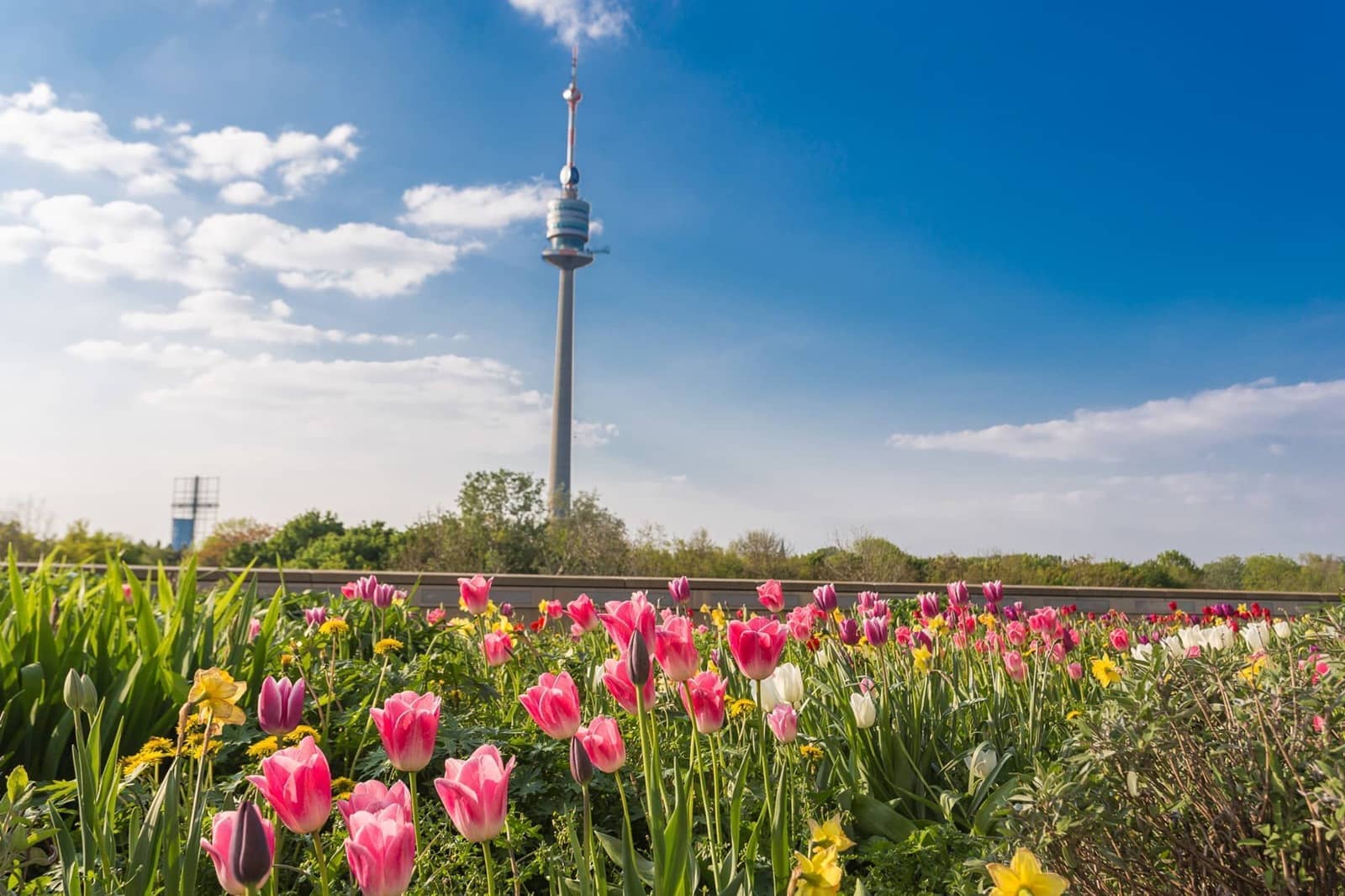
However, we’d definitely suggest that the months of May and September are likely to be the best for visiting. The weather will be warm but not too hot, there’ll be lots of sunlight hours for exploring, and you’ll miss the majority of the summer crowds.
Of course, sunshine isn’t guaranteed, so packing a light raincoat is advised, but on the whole you should get good weather in these months.
If you can’t avoid travelling over the summer, check out our top tips for surviving a European city in summer to preserve your sanity!
Internet Access in Vienna
Your accommodation is very likely to come with free Wi-Fi, and you’ll also be able to get online in most cafes, bars, and restaurants. For mobile data, you have a number of options depending on your phone.
First, check if your cell phone provider has some form of overseas roaming policy. For example, if you are travelling from the USA, consider a Google Fi package which lets you use your data overseas.
You can also buy a pay as you go SIM locally in Austria when you arrive – see a list of prices and packages here . You should be able to pick up a pay as you go SIM for under €20 with more than enough data for your trip.
Finally, another option to consider is an eSIM package if your smartphone is compatible with this technology. See my review of Airalo for more about how this works.
Electricity in Vienna
Austria uses a two pin 220v system like the majority of continental Europe. If you’re coming from the UK you’ll need an adapter. Travellers from the US will also need an adapter , and to check that their equipment supports the 220v standard. In our experience, laptop and mobile phone chargers will support voltages from 110 – 240v, whilst hairdryers and curling irons may not.
Supported voltages should be clearly marked on the power adaptor for the device – if in doubt, don’t plug your device in as it could cause serious damage.
See more on travel adapters and how to choose one for your trip in our guide to the best travel adapters .
Where to Stay in Vienna
As we often do when visiting a city like Vienna, we opted for an apartment . This was right in the city center, and meant that we had room to work, cook meals and do our laundry.
Of course, there are plenty of accommodation options in Vienna, with everything from hostels through to luxury five star hotels. We recommend you check out the Vienna listings on Booking.com if you prefer a hotel stay, we find they usually come back with the widest choice and best deals – plus they have apartments now too.
Here are some recommended options to consider:
- wombat’s CITY Hostels Vienna – Found in Naschmarkt, near the large city market, and close to the museum quarter, this is a highly rated hostel that offers both dormitory and private rooms at a great price. For hostels, also consider CH-Hostel .
- CH-Budget Centre Rooms – at the budget end of the spectrum, this is a well located guesthouse offering free wifi, private bathrooms and TV’s, with a good value breakfast also available.
- Motel One Wien-Staatsoper – just 100 yards from the Vienna State opera, this three star property is fantastic value. Air conditioned rooms are all en-suite, and WiFi is available throughout.
- Hotel Am Parkring – A highly rated and great value four star property that offers stunning views over the city from its high floor location
- Hotel König von Ungarn – Vienna’s oldest hotel, this four star property is well reviewed and rooms come with free wifi and air conditioning
- Hotel Imperial – a great value yet impressive 5 star luxury hotel in the heart of the city, with a range of rooms that include luxury amenities, marble bathrooms, and at the higher end, a butler service
- Grand Hotel Wien – a highly rated and centrally located 5 star historic property which offers 5 restaurants, luxurious rooms, spa and business centre. A fantastic choice at the high end
We recommend you checkout the Vienna listings on Booking.com if you prefer a hotel stay, we find they usually come back with the widest choice and best deals, plus once you book a few times you get access to Genius discounts, which can save you even more.
For more tips and ideas on how to get the best deals on accommodation (and more!), check out our comprehensive travel resources page .
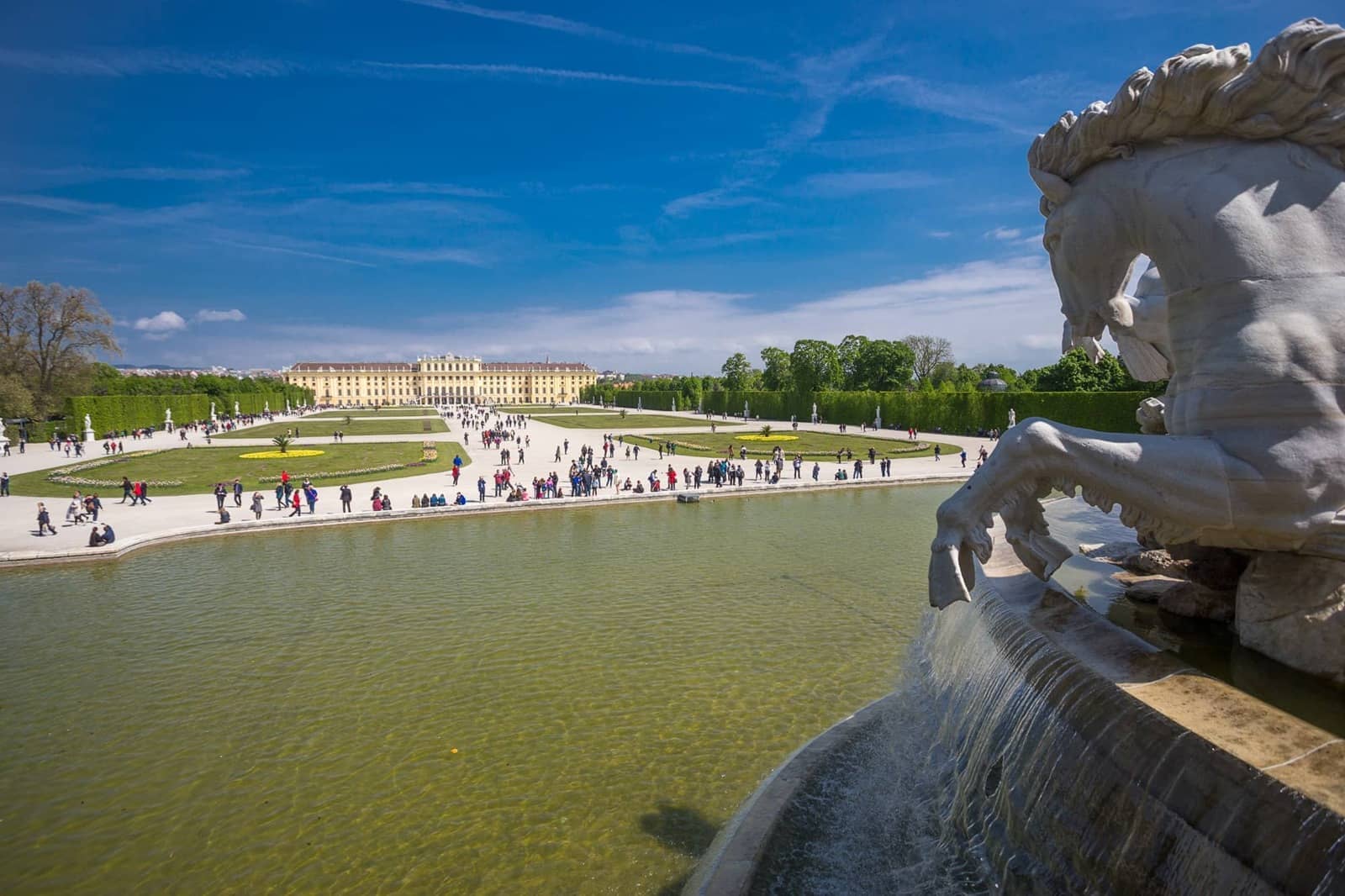
Where to see Live Music in Vienna?
A popular question that we are asked from visitors to Vienna is where to attend a classical music concert in the city.
There are many venues throughout the city which offer live music, from the opera house through to performances in churches, many of which will be classical music concerts.
Popular performances include:
- Vivaldi’s Four Seasons at Karlskirche
- Mozart and Strauss at Kursalon Vienna
- Classical Concerts in St. Anne’s Church
- Classic Ensemble Vienna in St. Peter’s Church
For more options, visit this page on the official website for Vienna, which has event listings for every type of musical event, and in particular, classic music lovers will want to check out the Classical Music listings .
You can also purchase tickets for live music in Vienna on this website .
How to Save Money on Your 2 Day Vienna Itinerary
Vienna is definitely not a budget city, and the majority of the attractions listed on this two day itinerary have an entry fee.
You can however save serious money on Vienna sight-seeing by investing in the awesome Vienna Pass . Seriously, it’s awesome.
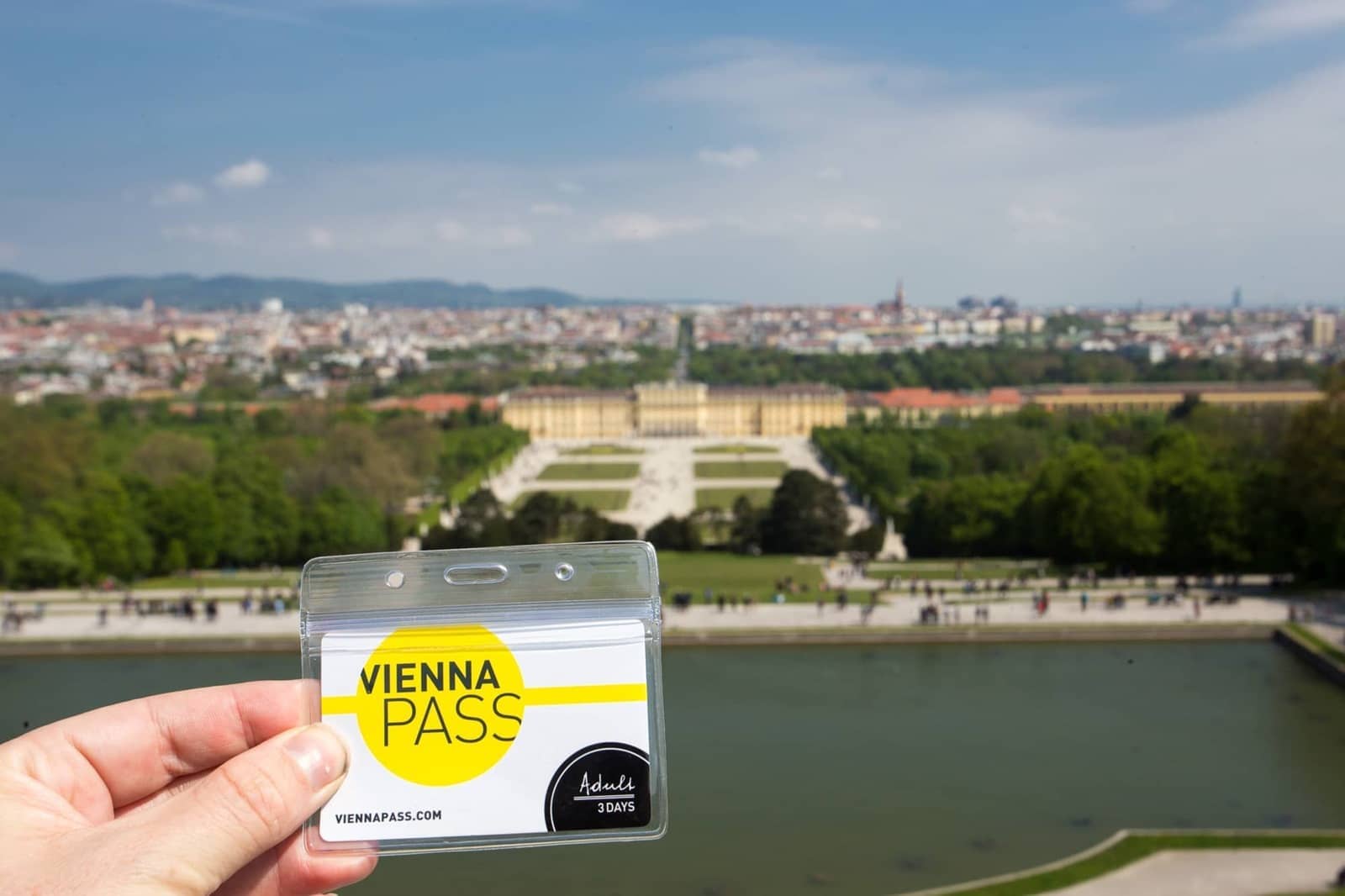
To give you an idea of how much you can save, visiting all the attractions I’ve listed on this itinerary would cost you well over 200 euros. In particular, the various sights at Schönbrunn each carry an individual price – just visiting all the highlights I’ve mentioned at Schönbrunn would add up to nearly 70 Euros!
Conversely, a two day Vienna Pass only costs €123 (as of April 2023). It’s incredibly easy to use, normally requiring just a quick scan when you arrive at an attraction and it also includes skip the line access at a number of locations as well, meaning you can make the most use of your time.
Nearly everywhere I’ve listed in this itinerary, with the exception of Time Travel Vienna and St. Stephen’s north and south towers (and meals of course!) are included on the Vienna Pass. In fact, the pass comes with free entry to over 60 of Vienna’s most popular attractions, meaning you can slip in a few more sights onto the list above without it costing you anything more.
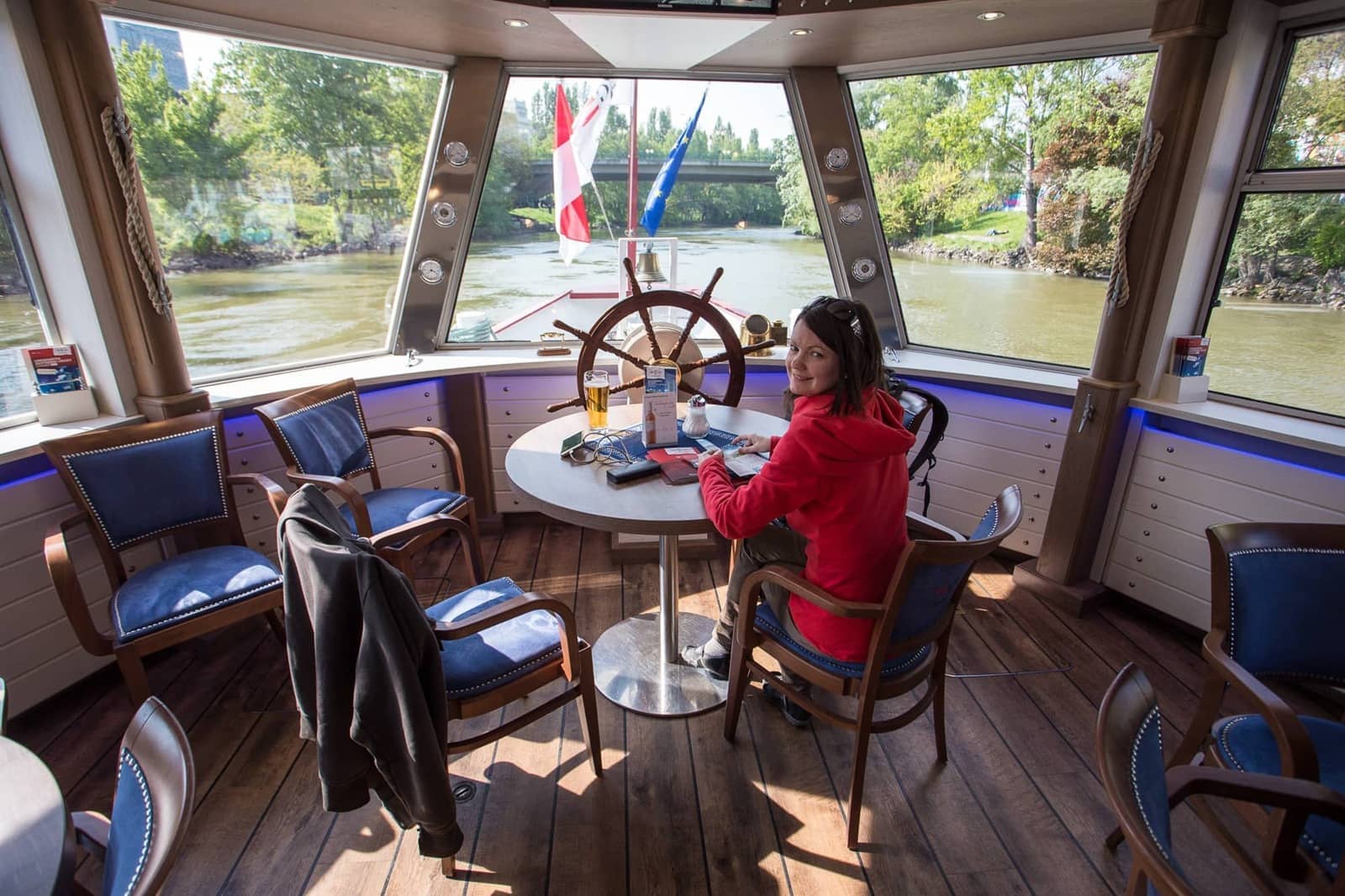
We’ve used city passes and museum cards in destinations around the world, and love how much money they save us on sight-seeing.
We highly recommend the Vienna Pass to anyone looking to save money in Vienna – it’s definitely one of the best value city passes we’ve ever used! You can reserve one in advance here , for easy collection on arrival in the city.
Also check out the Go Vienna pass from Go City, which offers a customisable pass for Vienna, which might work out better for you depending on your interests.
If you don’t think you’ll use a Vienna Pass enough to get value out of it, you might instead consider the Vienna City Card . This includes free transport around the city, as well as discounts at the major attractions and museums.
Further reading for your visit to Vienna
This post should give you nearly everything you need to plan out your two day Vienna itinerary.
On top of all the above, we also have some additional content and resources we think you might find useful.
Some of this is content we’ve written ourselves, and some is content from around the web or that you can take with you. Do check back from time to time and bookmark this page, as we’re always updating and adding new content to our sites to help you make the most of your travels!
- If you have a bit longer in Vienna, check out our detailed guide to spending 3 days in Vienna
- If you liked this itinerary, check out some of our other detailed itineraries , which cover cities, countries and road trips around the world.
- Visiting Vienna in summer? Take a look at our tips for visiting Europe in summer to make the most of your time
- Looking for a guidebook? We used the DK Eyewitness Travel Guide to Vienna , and found it very informative
- Planning to stay in an apartment? Check out our guide to over 20 websites that allow you to book apartments online to make sure you get the best deal
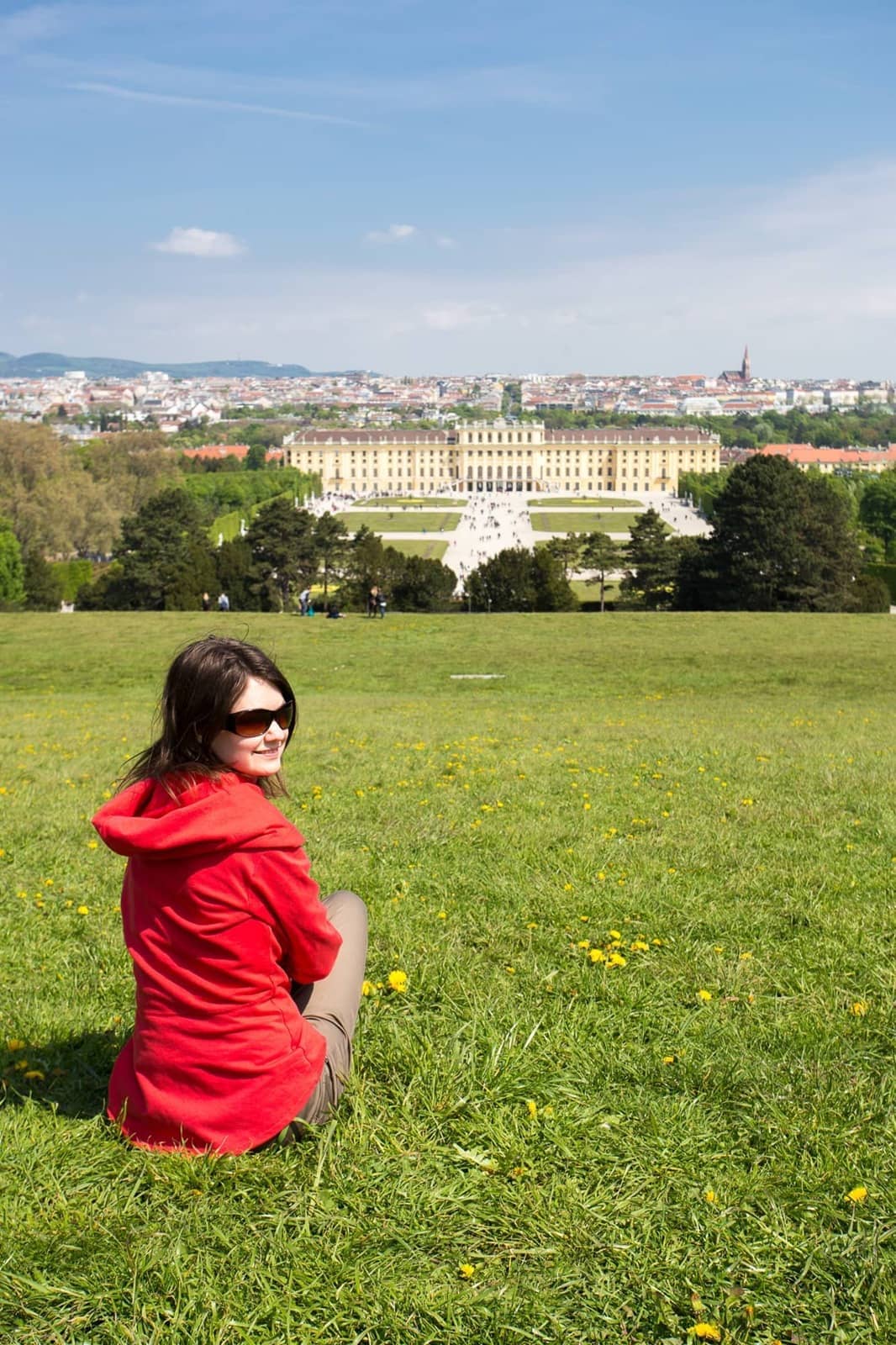
And that sums up our post on how to spend two fantastic days in Vienna! There’s lots to do here for many more than two days, and we’re going to be putting some more posts together covering longer itineraries. In the meantime, if you’ve got any questions or thoughts on how to spend two days in Vienna, let us know about them in the comments below!
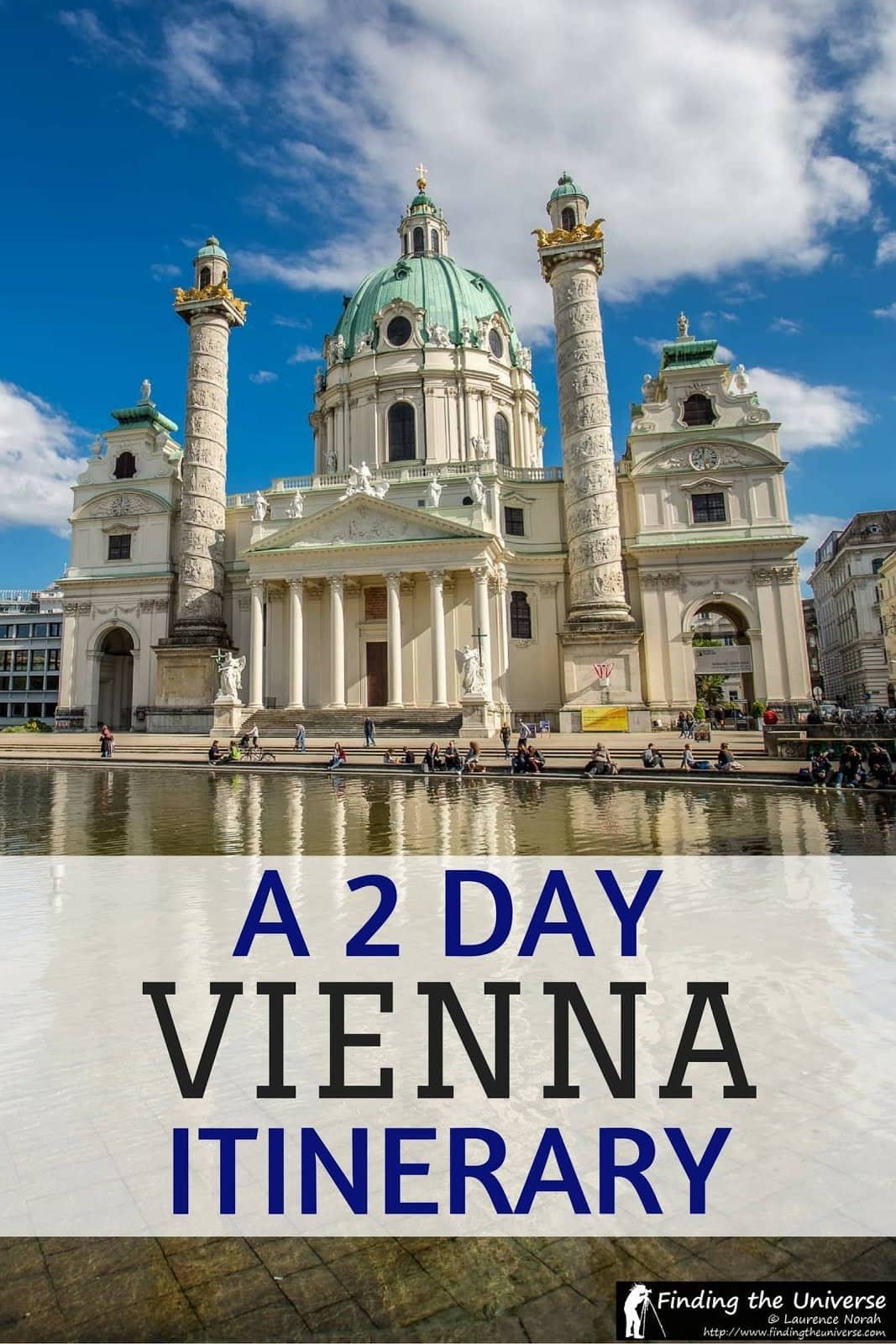
Enjoyed this post? Why not share it!
There are 52 comments on this post
Please scroll to the end to leave a comment
Patty Abraham says
27th July 2022 at 12:14 pm
Thanks .We are traveling to Vienna in August 2022.Your article was very informative
Laurence Norah says
28th July 2022 at 10:57 am
My pleasure Patty, have an amazing time in Vienna!
31st October 2019 at 9:46 am
We will reach Vienna on 13th nov evening and leave for Budapest on 16th nov…just wanted to how’s hotel steigenberger hereenof Wien located…is it nearby to all the major attractions that you mentioned on your blog. And also please recommend what can we do on 13th as we just have the evening to explore the city and as we are short on time, how can we accommodate everything?
31st October 2019 at 10:50 am
That hotel is well located, so that would work.
For the evening of the 13th, it’s really up to you. I’d recommend looking at our 3 day Vienna itinerary and seeing what extra activities you might be interested in. Just try to find some things that are open later in the winter time.
Have a lovely time in Vienna!
Teresita Padilla says
25th September 2019 at 9:03 pm
I like to travel to Vienna but I’will be alone, 75 years old and is on a shoestring budget. Is it safe to stay in a hostel? Your article is very interesting and informative and it makes me want to go there!
26th September 2019 at 10:45 pm
Hi Teresita
Vienna is a very safe city, and we think you will have no problem staying at a hostel. We’d suggest perhaps the My Mojovie Hostel which is well reviewed and quite central. However, the dorm rooms have an age limit of 50 so you would need to book a private room. Another option if you prefer a dorm is the Wombats City Hostel Vienna which has female only dorms and is also quite central 🙂
I hope you get to visit Vienna soon 🙂
Anne Bond says
26th June 2019 at 1:52 pm
My friend and I are hoping to visit in October and looking at hotel in Schwedenplatz 3-4 area. Would this be a convenient area to stay near main attractions.
26th June 2019 at 5:37 pm
Yep, that would be within walking distance of the city centre and most of the attractions on this itinerary 🙂
Have a great trip!
Ashley says
15th April 2019 at 1:01 am
How exactly does one book the strudel show at Schönbrunn? Can I do it in advance, or do I do it during my visit? If so, where do I go to register?
15th April 2019 at 11:44 am
You can do it in person, which is what we did, however, if you prefer to book in advance you can just e-mail them: [email protected] .
You can see more here: https://www.cafe-residenz.at/en/apple-strudel/strudel-show.html
24th March 2019 at 1:18 pm
I was always interested in Vienna, but now I’m sold. Your blog definitely encouraged me to go, lots of good info.
24th March 2019 at 1:58 pm
Thanks very much Eddie – have a lovely trip and let us know how it goes!
3rd February 2019 at 4:29 pm
What form of transportation did you rely on most for this itinerary? The hop-on/hop-off buses, the tram, or the subway? Thanks!
3rd February 2019 at 4:45 pm
It was a combination of walking and the hop on hop off bus. We did buy a Vienna travel card which was good for the subway and bus, but we ended up using those far less than we initially thought.
Let me know if you have any more questions 🙂
3rd February 2019 at 4:48 pm
Great! Thanks for your help!
Kanika Bakshi says
27th December 2018 at 11:26 am
A superb article with a piece of very helpful information which really help all travelers who want to go to Vienna. Nicely done everything. Keep it up the best work.
27th December 2018 at 11:54 am
Thanks Kanika 🙂
Yoana Dimitrova says
5th November 2018 at 10:35 am
How did you travel around Vienna,did it take you too much time to get around different places.Also did you get the Vienna travel card.
5th November 2018 at 11:43 am
For the most part we walked, which was easy to do. For the palace, we took the hop on hop off bus which was included with the Vienna Pass, which took us straight there. For some of the other locations we took the metro. We did get a 3 day travel card, but to be honest, we didn’t use it enough to make it worth it as the hop on hop off bus was pretty good, and then we walked nearly everywhere else!
I hope this helps 🙂
1st September 2018 at 3:39 am
I will be in Vienna Sep 8th at night and leave Vienna to Budapest on Sept 11th at 6:30 night. i bought two days Vienna pass for 9th and 10th. we are not found of musumes but love castles and other activites. would you be able to provide an itenary for two days and what to do without Vienna pass on 11th for more than half day.
1st September 2018 at 11:14 am
I’d recommend checking out my 3 day itinerary as that has more attractions listed, and from that you should be able to put together a good itinerary:
https://www.findingtheuniverse.com/3-day-vienna-itinerary/
I’d definitely recommend Schönbrunn Palace, Prater Park and Ferris Wheel, St. Stephen’s Church and the state opera tour. I know you say you don’t really like museums, but Venice has some really amazing musuems, so hopefully you visit one or two of them 🙂
When you are looking for things to do without the pass, there’s the Naschmarkt, and also there are some really nice cafe’s that you might want to visit.
27th July 2018 at 11:45 pm
I always check your blog before planning a trip – always extremely helpful.
Thanks a lot for all the effort you put into this.. Happy travels 🙂
28th July 2018 at 4:08 pm
That’s lovely to hear Afif – pleased we could help out 🙂
Satish says
4th August 2018 at 9:04 pm
Hi, I have purchased 1 day Vienna pass. What sightseeings can I cover along with Schonbrunn palace on that day? My thinking is: Schonbrunn palace,Hofburg,Ferry wheel at Prater and St. Stephen’s Cathedral Treasury. Do let me know if covering all this is possible in a day? Kindly provide some editing if this is not possible.(Note: Would like to cover mixture of architecture and history) Thanks.
5th August 2018 at 11:28 am
That sounds very possible to us – just don’t spend too long at Schonbrunn to be sure you see everything else you want to see.
Tarek Soliman says
6th April 2019 at 12:21 pm
Amazing description to Vienna attractions. thank you very much for making my trip easier and for saving too much of my limited time. I will follow your advice to enjoy my short two day trip to Vienna and sure, I will share my experience with you and your followers once returned. Greetings from Egypt
6th April 2019 at 12:30 pm
Thanks very much Tarek! Have a great trip and do let us know how it goes 😀
Mayank says
16th July 2018 at 1:38 pm
One more thing I need clarity on, I will reach my hotel in Vienna on 13th August around 3:30 p.m. I will leave from Vienna to Innsbruck on 15th August at around 11:30 a.m. I am confused whether I should buy 24 or 48 hour Vienna pass.
18th July 2018 at 6:55 pm
The Vienna Pass lasts for only one full day, from midnight to midnight. So if you started using it at 3.30pm, that would count as a full day. So my advice is to take the one day pass, and just to use it on the 14th. Otherwise you don’t have enough time to take advantage of it on the afternoon of your first day, or morning of your last day.
25th July 2018 at 1:40 pm
Thanks for your reply. Just have few more questions, I will stay in 25hours Hotel MuseumsQuartier at Vienna. We have our evening free on 13th August and entire day of 14th August. What should be done on 13th Aug(assuming I do not take a Vienna pass for that day). Also can you pls suggest an itinerary for 14th August regarding sightseeing to be done. Thanks in advance.
25th July 2018 at 4:32 pm
Hi Mayank! It’s really up to you what you do. A popular option in Vienna is to see a classical concert (see the post for instructions on how to find one of those). Some of the attractions are also open later in the day.
It’s hard to give individual itineraries without knowing what people like, so my suggestion is to pick from the two day itinerary, and from what is included on the Vienna Pass, those attractions which you are most interested in seeing, and then checking on the map to see how far apart they are. Then you can come up with a plan for what is feasible for your visit 🙂
Mayank Rathod says
16th July 2018 at 8:08 am
Hi, I am visiting Vienna in mid August 2018. How is the climate/weather likely to be?
16th July 2018 at 10:29 am
August is likely to be pretty good, temperatures should be around 22C – 28C, and it should be sunny. Of course, rain is possible at any time of year, but is less likely in August. I hope this helps!
16th July 2018 at 1:32 pm
Thanks for your prompt response, however will the climate be too hot? We are visiting Swiss and Austria in mid August. I am from India.
18th July 2018 at 6:54 pm
HI Mayank – I think it’s unlikely you will find it to be too hot, as Europe is not too humid. I haven’t visited India, but my understanding is that it is usually quite hot and humid there, so I think you will be fine!
18th July 2018 at 1:46 pm
Hi, Should 1 day Vienna pass be taken?
3rd July 2018 at 7:18 pm
A 2nd question about a train from Munich to Austria. Are there various? If so pros/cons? If not, thanks.
3rd July 2018 at 7:47 pm
My pleasure Cyndi 🙂 There are a number of direct trains between Munich and Vienna (I assume you want to go to Vienna :)).
It takes between four and five hours, and there are around twenty per day. My advice is to book in advance so you get a cheaper ticket, with the best site for trains out of Germany being the official German trains ticket website, which has an English version here: https://www.bahn.com/en/view/index.shtml
There is also a night train service if you want to try a sleeper train. These can be a fun way to get around Europe, plus you save on a nights accommodation. The train service is called Nightjet and it takes around seven hours I think. You can book those on the DB website too, from here: https://www.bahn.com/en/view/offers/europe/nightjet.shtml
Happy to help with any more questions of course!
1st July 2018 at 10:27 pm
My adult daughter and I are finishing our August 2018 trip in Vienna. I fantasize attending a Strauss concert (possibly with dinner) although the music is the priority. Your thoughts???
3rd July 2018 at 10:28 am
Hi Cyndi! This is quite a popular request, so I’ve updated the post with a little section on attending concerts in Vienna. In summary though, my suggestion is to check out the official city website for classic music event listings ( https://www.wien.info/en/music-stage-shows/classic ). A church concert is a popular option, but the cafe’s also host music if you want it accompanied by some food. I hope this helps – have a wonderful trip to Vienna!
3rd July 2018 at 7:17 pm
Thank you for your reply and link. Much appreciated.
Dr. Vikram Jain [eye surgeon] says
19th May 2018 at 5:32 pm
Hi, me and my co-brother [husbands of 2 sisters] are reaching Vienna by car from Salzburg via Melk on the evening of 12th June. We have 2 full days [13,14] before we drive off to Budapest. Your itinerary appears very useful and we will definitely keep it in mind all the advise u have given.
19th May 2018 at 8:45 pm
Thanks Vikram – have a great trip!
Arline says
2nd May 2018 at 7:26 pm
Going in Aug for 2 days. Would love to go to a concert as well as some of the other things on your itinerary . Any suggestions?
2nd May 2018 at 8:26 pm
Of course, there’s the Vienna opera house, but after that it very much depends – lots of the churches for example have live music performances, but it will depend on the timing of your visit as to what is on – also it will depend on what you are specifically interested in seeing! My advice would be to check out this page on the Vienna tourist board: https://www.wien.info/en/music-stage-shows/classic/church-concerts – which will give you more ideas for what is on and when 🙂
2nd May 2018 at 8:38 pm
Thank you very much. I am really interested in hearing Strauss waltzes so I will look into that venue.
17th April 2018 at 5:47 pm
Thank u so much for the blog…very detailed and have all information i was looking for …one of t best vienna blogs i have read so far…going to vienna this may…thank u for all help!
18th April 2018 at 6:19 am
My pleasure – have an excellent trip!
Lynda Ellis says
12th March 2018 at 9:32 am
What excellent information – thank you – I am so very excited about my forthcoming trip ( on the 15th March with my daughters – my Christmas Present from them!)
13th March 2018 at 8:35 pm
That is a fantastic Christmas present – you’re going to have an amazing trip. Enjoy!
4th March 2018 at 3:30 pm
We are going next month, thank you for helping me plan our vacation!
4th March 2018 at 3:33 pm
Our pleasure Anna – have a wonderful trip!
Leave a Reply Cancel reply
Your email address will not be published. Required fields are marked *
Let me know when there's a reply to my comment (just replies to your comment, no other e-mails, we promise!)
Subscribe to our monthly Newsletter where we share our latest travel news and tips. This also makes you eligible to enter our monthly giveaways!
We only ask for your e-mail so we can verify you are human and if requested notify you of a reply. To do this, we store your data as outlined in our privacy policy . Your e-mail will not be published or used for any other reason other than those outlined above.
- Meet the Team
- Work with Us
- Czech Republic
- Netherlands
- Switzerland
- Scandinavia
- Philippines
- South Korea
- New Zealand
- South Africa
- Budget Travel
- Work & Travel
- The Broke Backpacker Manifesto
- Travel Resources
- How to Travel on $10/day
Home » Europe » Austria » Vienna
EPIC 3-DAY VIENNA ITINERARY (2024)
Vienna is not only Austria’s capital, but it is also a hub for artistic and intellectual genius! This vastly beautiful and sophisticated city was once the home of Mozart, Beethoven, and Sigmund Freud. Even Einstein was known to enjoy the splendor of Vienna!
It’s easy to see how people worldwide flock to enjoy the exquisite glory that Vienna provides, as well as explore the many historical and fascinating sites it boasts.
Our complete three day Vienna itinerary will take you on an unforgettable journey, leading the way and making sure that your trip is overflowing with non-stop beauty. Let the stress of planning ease, and keep this guide with you to ensure you have yourself an amazing three days in Vienna!
This ancient city lies on the banks of the Danube River and is known for being the birthplace of free-thinking and artistic advancement! Vienna’s cafes are set within an inspiring ambiance, and it is said that you will feel as if you have consumed both time and space, yet only coffee will be found on your bill!
A Little Bit About this 3-Day Vienna Itinerary
Where to stay in vienna, vienna itinerary day 1: innere stadt and neubau, vienna itinerary day 2: schönbrunn, weiden, and mariahilf, vienna itinerary day 3: leopoldstadt and landstrabe, what to do with more than three days in vienna, best time to visit vienna, how to get around vienna, what to prepare before visiting vienna, faq on vienna itinerary, final thoughts.
You can see Vienna’s gorgeous sites walking along the streets, and exploring this picturesque city on foot is a must! Take in the upbeat rhythm of Vienna’s streets as you enjoy many statues and imperial architecture. There are cafes everywhere, as well as art galleries and plenty of museums. Walking is one of the best ways to get around Vienna as a lot of the attractions can be found close to each other.
However, Vienna is huge and there can be times when you will need a faster and less strenuous way to get around! The train stations and underground subways are wonderful ways to get from A to B in Vienna, and they can be found in most of the big cities.
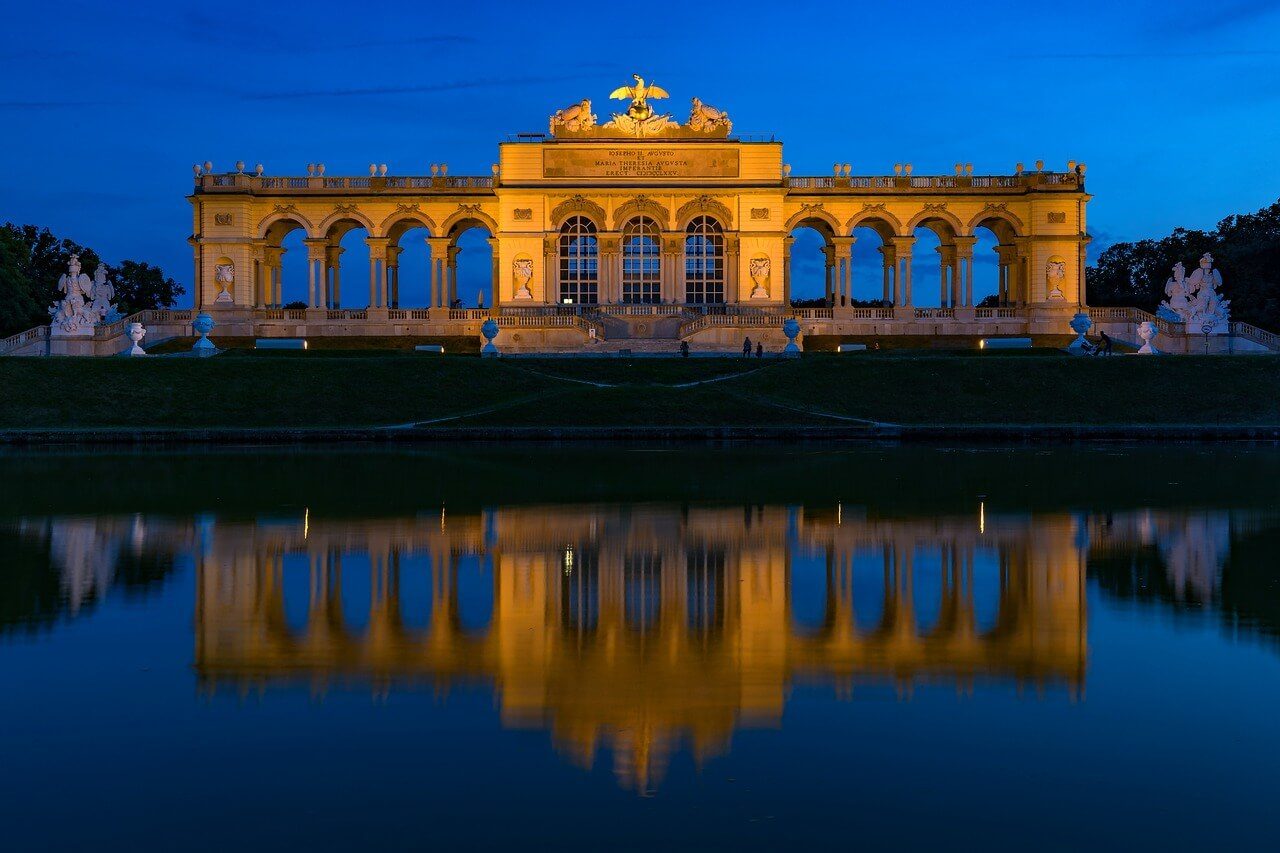
The Broke Backpacker is supported by you . Clicking through our links may earn us a small affiliate commission, and that's what allows us to keep producing free content 🙂 Learn more .
You can also book tickets with U-Bahn metro systems. You can see the places for these buses quite easily as they are marked with a blue cube that has a white ‘U’ on it. You can save money with these by booking a day pass online or getting Vienna’s local travel card. There are also buses and taxis found within Vienna, and this makes for a quick way to travel.
If you are wanting to travel in your own time, you can also hire a car or bike in Vienna. This is a great option when travelling, and it gives you a lot more freedom. If you don’t trust your GSP, you can hire a private driver to take you from place to place and show you some of the best streets!
If need be, the airport also offers reasonable ticket prices for a flight from one part of Vienna to the next.

Unlock Our GREATEST Travel Secrets!
Sign up for our newsletter and get the best travel tips delivered right to your inbox.
3-Day Vienna Itinerary Overview
Day 1 in Vienna: Kunsthistorisches Museum Wien , Austrian National Library , St. Peter’s Catholic Church , St. Stephen’s Cathedral , Vienna Opera House
Day 2 in Vienna: Schönbrunn Palace , Naschmarkt , Secession , Karlskirche , Albertina , Mariahilf
Day 3 in Vienna: Volksgarten , Rathaus , Prater , Museum of Applied Arts , Hundertwasser Apartment House and Museum , Danube Canal
More Places to See in Vienna: Central Cemetery , Wien Museum Mozart Apartment , Belvedere Palace , MuseumsQuartier

With a Vienna City Pass , you can experience the best of Vienna at the CHEAPEST prices. Discounts, attractions, tickets, and even public transport are all standards in any good city pass – be sure invest now and save them $$$ when you arrive!
A huge part of planning a trip to Vienna is knowing which neighborhood you want to stay in! Ask yourself what kind of place you are looking for – peaceful or bustling? Do you want to be close to Vienna points of interest or do you enjoy long journeys? Would you like to experience the luxurious side of Vienna, or are you more interested in the quirky parts? All of this comes into play, but we will share some of the best options of where to stay in Vienna!
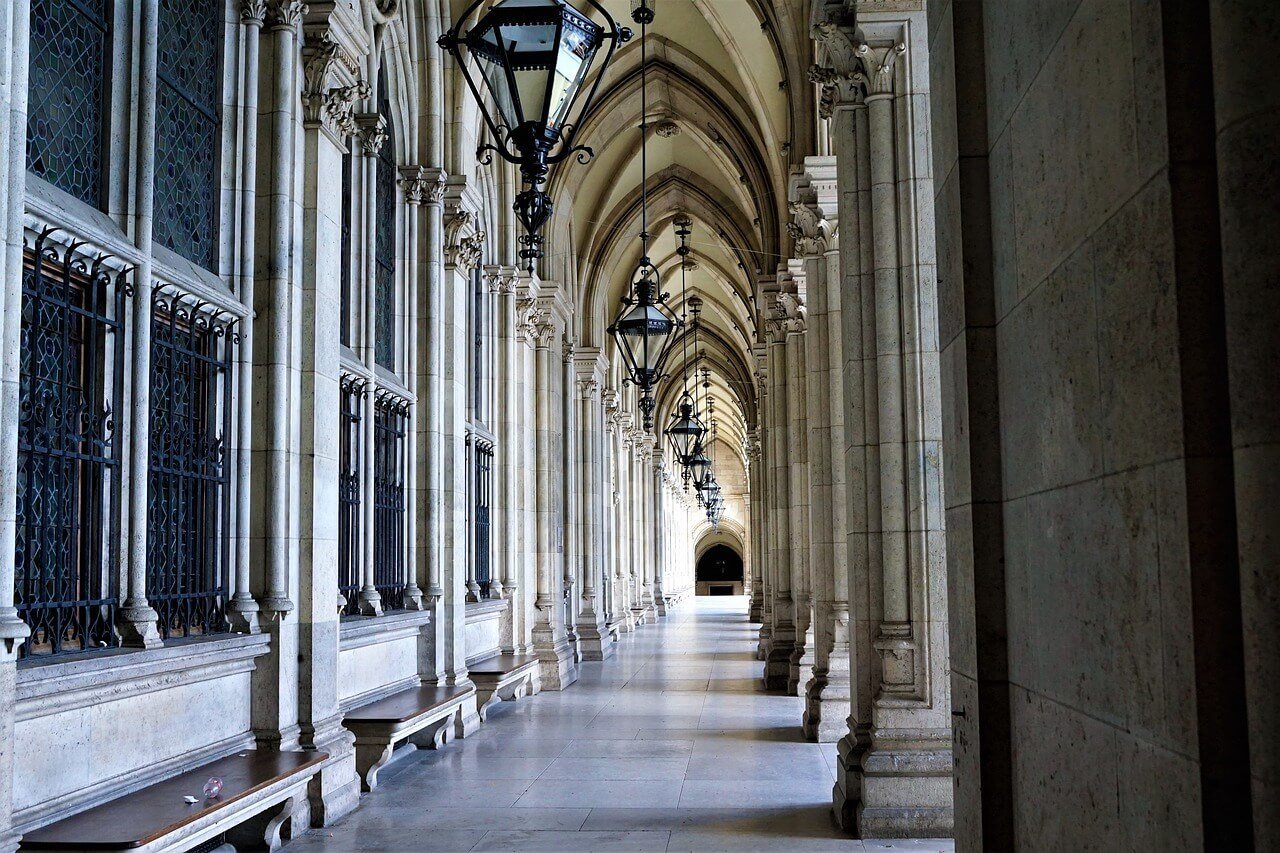
If it’s your first time in Vienna, then the area of Innere Stadt is the best place for you to stay. This neighborhood is central and is also where most of Vienna’s beautiful historical sites can be found. You can see all of the best architecture and do some magical sightseeing without having to travel far. One of the best parts about this neighborhood is that it is surrounded by the Ringstrasse wall, which once used to be the city’s official wall.
Neubau is by far the coolest place to stay in Vienna! This is where Vienna showcases its trendy art galleries, cafes with unique character, and plenty of designer clothing shops. The restaurants in this area are also well worth checking out and provide tasty cuisine set in unusually decorated buildings.
If you want to learn more, be sure to read our awesome guide on the COOLEST areas in Vienna !
Best Hostel in Vienna – Hostel Ruthensteiner Vienna
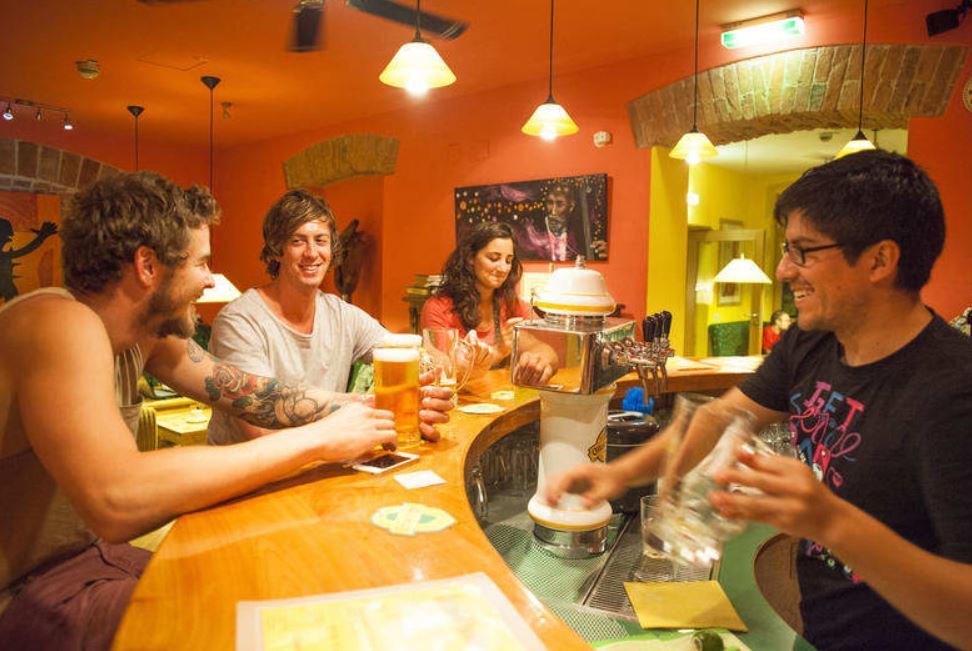
This remarkable hostel provides spotless accommodation that is also conveniently close to the Wein Westbahnhoff station. The hostel members pride themselves on the cozy and friendly vibe that exudes from their establishment. There is also an amazing garden and music area for you to put your feet up and relax after a long day of adventuring!
Best Airbnb in Vienna – Unbeatable Home in Prime Location
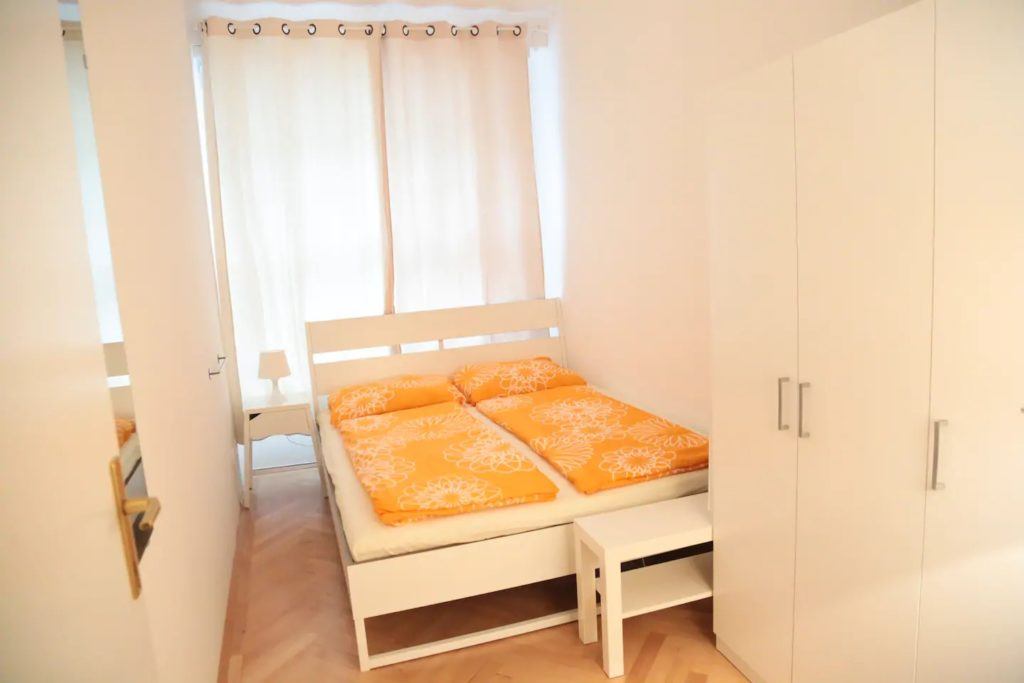
Discover Vienna on foot while staying smack dack in the city center in this modern but cozy apartment. And if you do plan to venture out, this home is footsteps from the bus station.
Do you like meeting new people on your travels? If that’s you, this is the spot to be; the private room is in a huge home where you share the space with a few people that will quickly feel like family you may end up going o future adventures with during your time here.
Not to mention, even with a house full of people, the place continues to stay immaculate. With a full kitchen to use whenever you please as well as a cozy living area that has an organized space to play board games or cards, you may not even leave home!
Best Budget Hotel in Vienna – Pension Wild
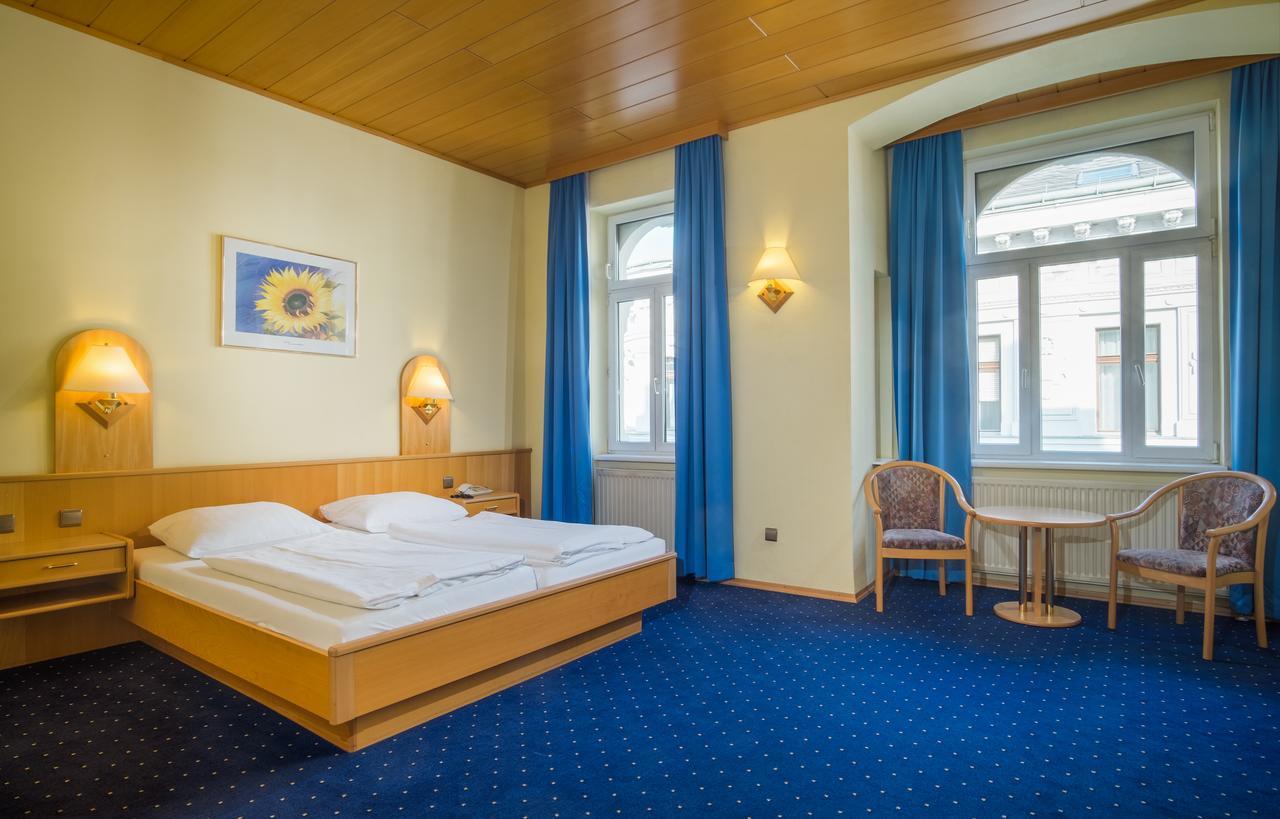
This budget-friendly hotel also happens to be a historical building in Vienna dating back to 1904! It has been renovated and provides elegant accommodation for those in Josefstadt. The hotel is close to two subways, both the Rathaus and Volkstheater Underground Stations. The rooms are comfortable and the staff is always smiling. This may be the best place to stay in Vienna during your visit!
Best Luxury Hotel in Vienna – House of Time
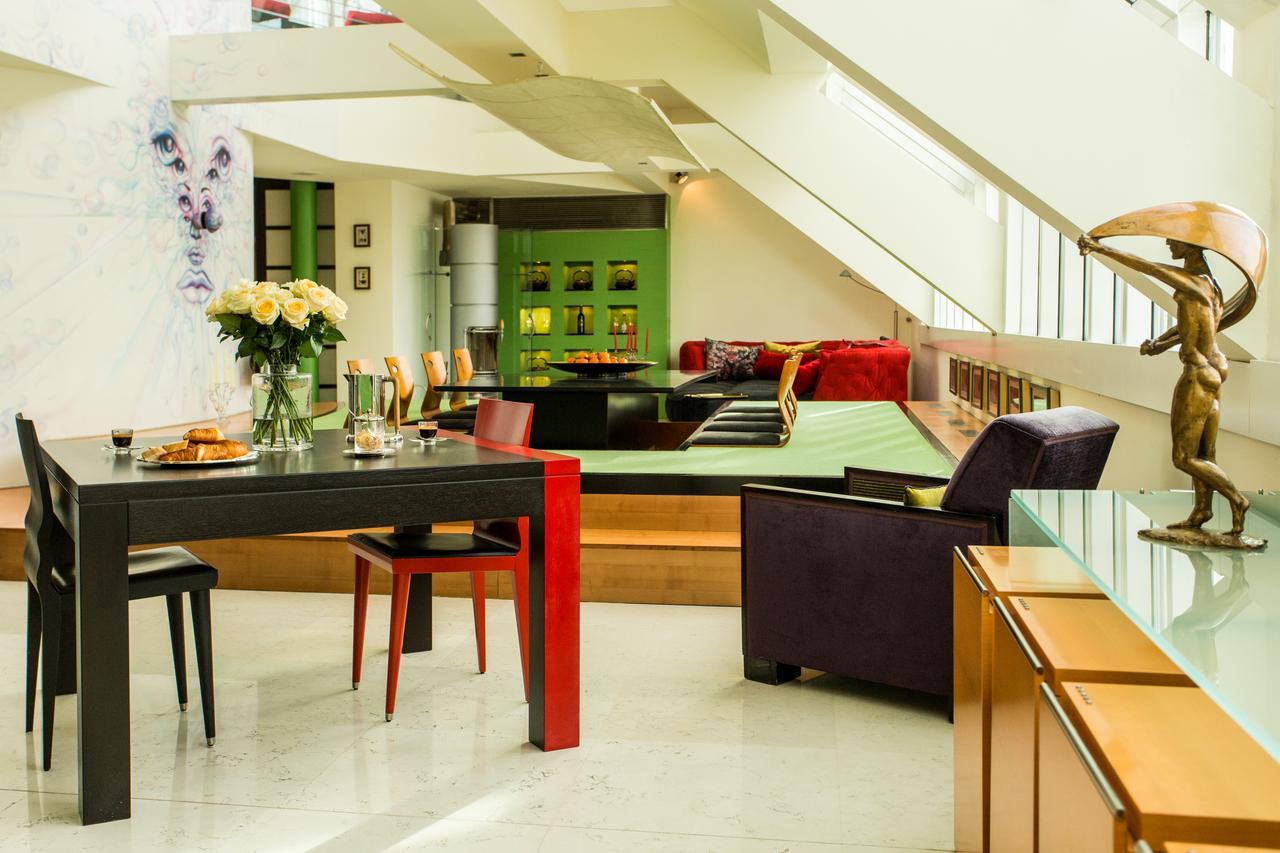
Enjoy 5-star treatment with an incredibly charming, artistic touch at The House of Time. These fancy suites are exquisite, each with their own theme. The hotel offers not only luxury accommodation, but style and an unforgettable hotel ambiance like no other. You can even book a room that has its own private room service, onsite bar, mini bar, and so much more are offered at the House of Time.
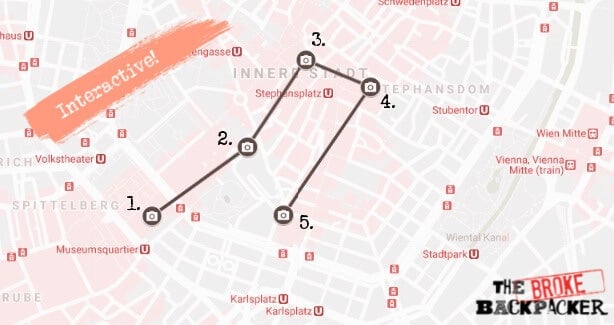
We’re going to spend our first day in Vienna admiring some of the finest landmarks in the city.
9:00 AM – Kunsthistorisches Museum Wien
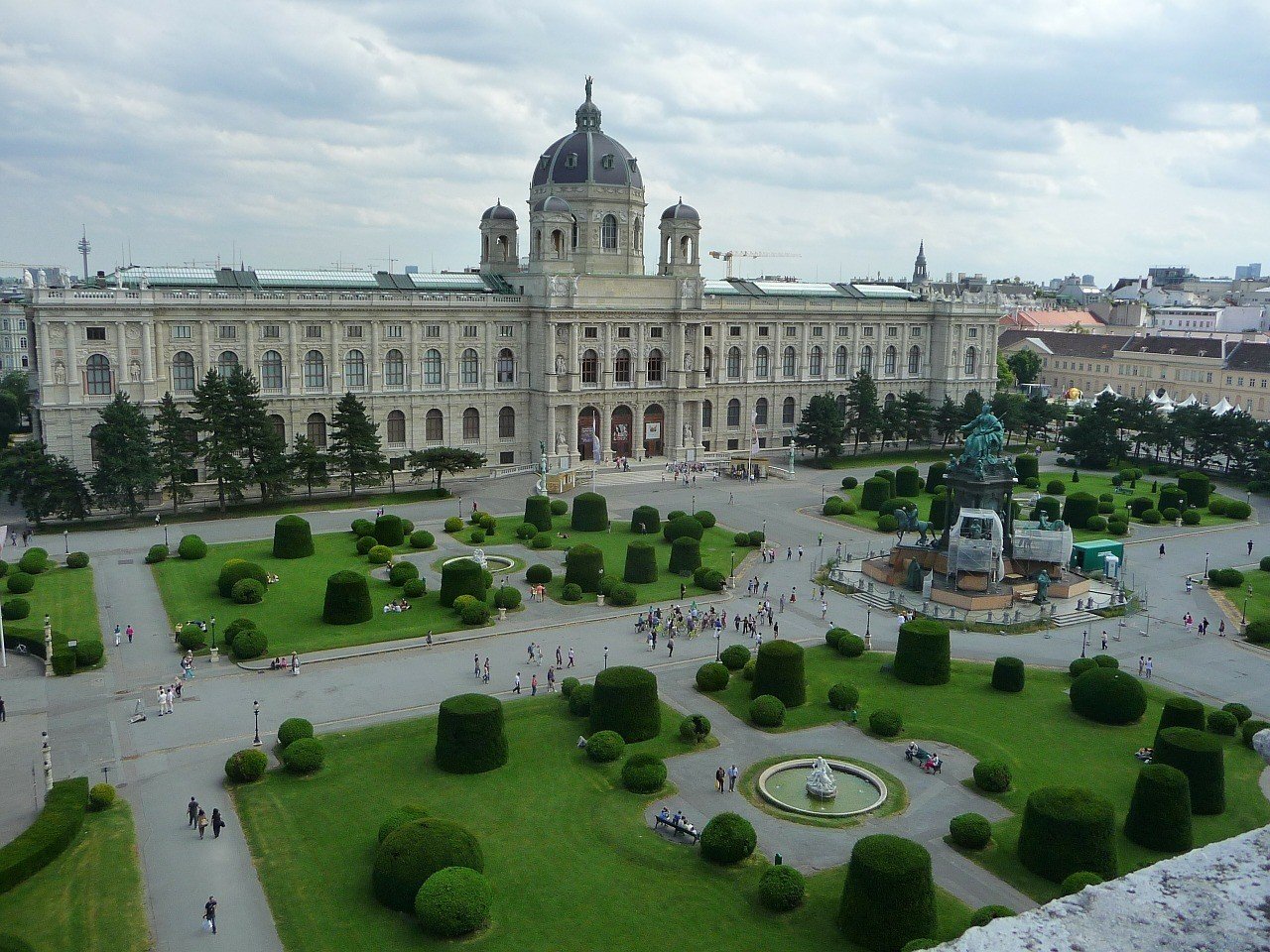
One of the best things about Vienna is its unique and rich artistic history; we’re going to start the largest art museum in the country on our first day in Vienna! The Kunsthistorisches Museum Wien is a magnificent building that hosts many priceless artworks, but its very structure is also a masterpiece.
It showcases excellent architecture with an artistic ambiance! Stroll the gardens and admire the external features of the building, then make sure to tour its interior. One of the most unforgettable parts of this museum is the signature octagonal dome.
Enjoy remarkable exhibitions, displays, and breathtaking artwork from the Viennese masters.
By the time you finish with the museum, you’re probably going to need a jolt of energy. Sit down for a relaxed meal and a cup of fresh coffee or a hot cup of tea at the museum’s cafe before leaving.
- Cost: €16.
- How long should I stay here? 2-3 hours.
- Getting there: There are two U-Bahn stops nearby: Volkstheater (Line 3) and the Museumsquartier (Line 2).
12:00 PM – Austrian National Library
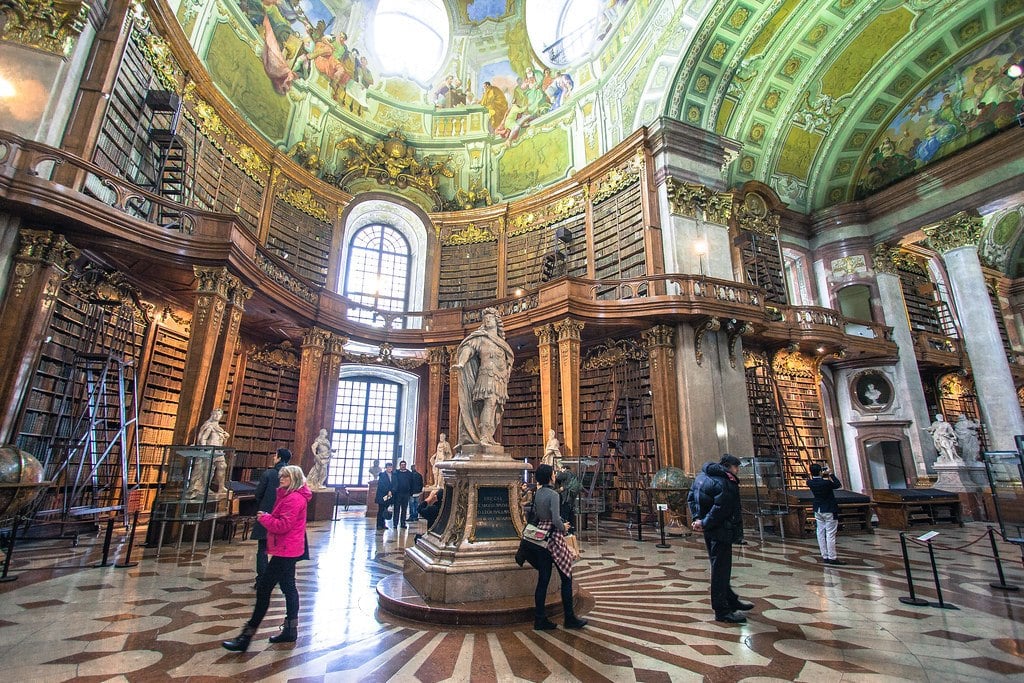
The Austrian National Library is the largest library in the country so expect a library that oozes with grandeur of a whole new kind! There are over twelve million items in its enormous collection. The library building itself has been standing since the fifteenth century and carries a beautiful history of its own (that you can read up about when you are there). It was originally built as a part of the glorious Hofberg Palace and Sisi Museum.
The Austrian Library is also made up of three wonderful museums, the Papyrus Museum, the Globe Museum, and the Esperanto Museum. The oldest book in the entire library is a medieval clerical scripture called ‘Evangeliar of Johannes of Troppau’, from 1368. It’s worth looking at because it is full of coloured drawings and beautiful calligraphy!
The impressive baroque State Hall is an immeasurable beauty! Marvel and stand in the middle of the cathedral-like oval dome, which is suspended by marble columns that are entirely covered in magnificent frescoes. There are also galleries of carved wood where you will find over 200,000 books that have been meticulously bound with precious leather.
There are wooden stairs on wheels to cross over the two stories of books! You will also see historic personalities that have been sculpted from pine marble and plenty of earth globes that are over 400-years-old.
When you’re ready to move on and/or you’re feeling a bit hungry, head over to Café Hawelka for some lunch!
- Cost: €8. Free for those nineteen and younger.
- How long should I stay here? 1-2 hours.
- Getting there: It’s a 10-minute walk to the Library from the Kunsthistorisches through the Burggarten.
3:00 PM – St. Peter’s Catholic Church
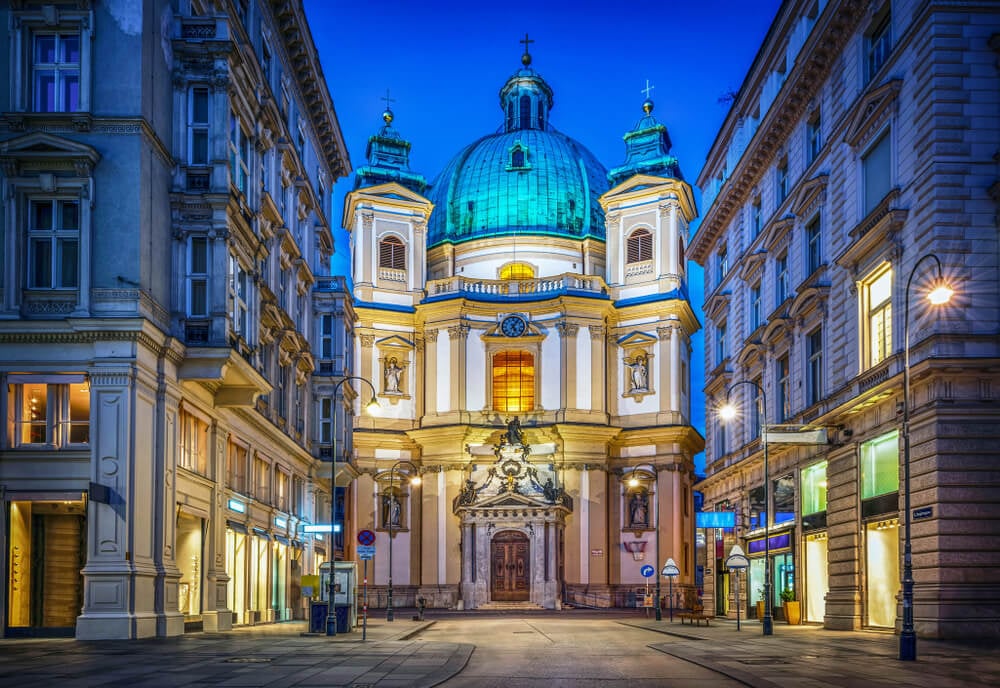
Also known as the Peterskirche, this Roman Catholic Church is one of the major Vienna landmarks and a highlight for any Vienna itinerary! Even from its exterior, it boasts a magnificent amount of classic domes, reliefs, and exquisite statues. Once you open those doors and step inside, you will have your breath taken away by this church’s uniquely colorful interior and form.
St. Peter’s Church was originally built in the 18th century, and it embodies all the architectural design qualities of that time. You can catch free concerts and recitals, so there is always a chance to enjoy an extra bit of fun when you visit!
This church is a captivating Baroque structure and has so much to offer everyone who visits! From gorgeous domes and artwork to well-designed interior details, there is a lot of magnificence fitted into a small space.
Begin your trip in Vienna with a place that captures the soul of this wonderful city!
Insider Tip: You won’t need to go inside the church to marvel at its beauty, and most of its best features are seen from outside. Be sure to ride the elevator to experience one of the best views in Vienna!
- Cost: €8-10 depending on if you want to go up to the dome by elevator or by foot.
- How long should I stay here? An hour or less.
- Getting there: If you dropped by Café Hawelka for a bite, St. Peter’s is less than 5 minutes away by foot via Graben Street.
4:00 PM – St. Stephen’s Cathedral
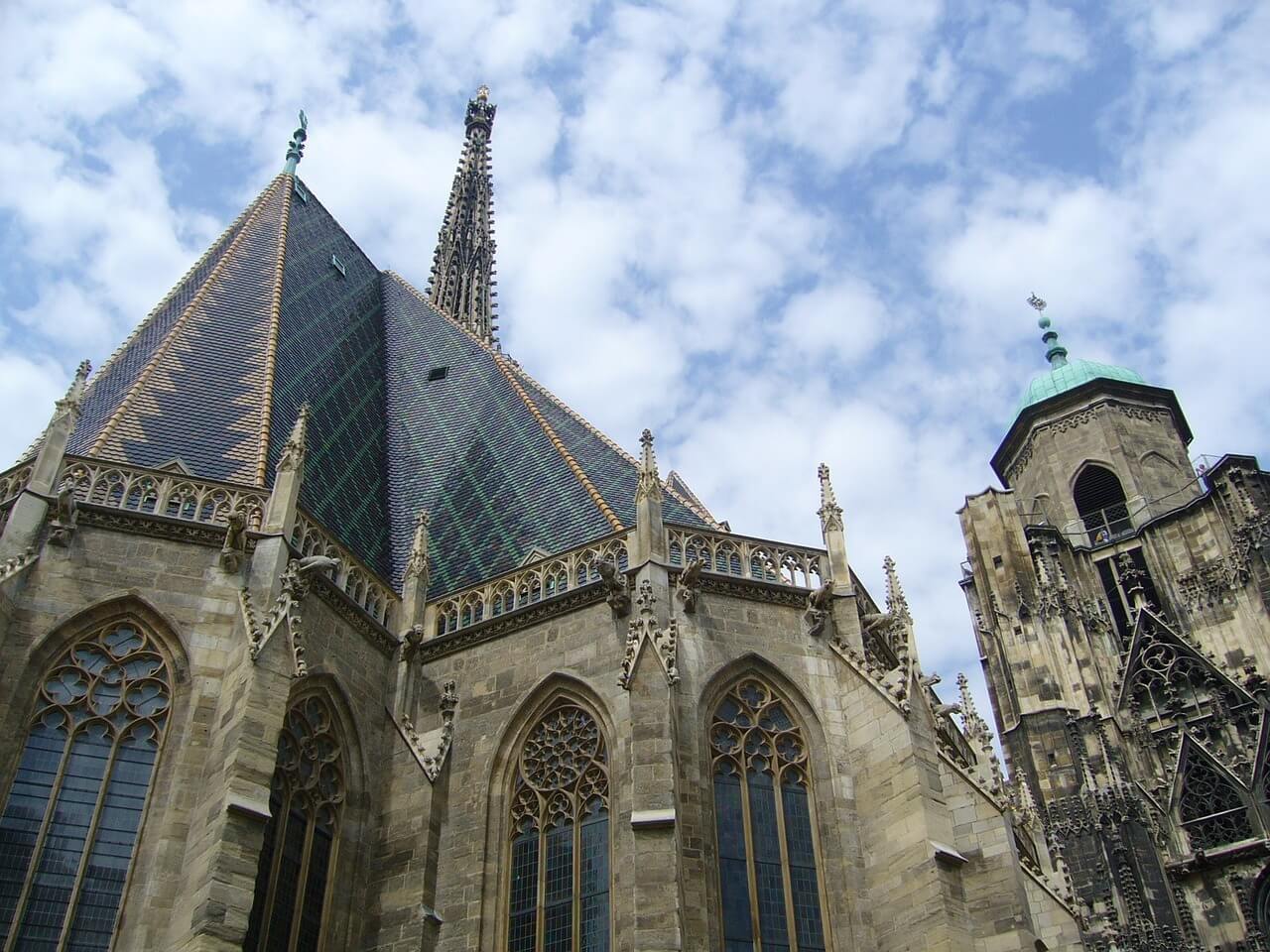
- Food Recommendation: Enjoy a luxurious meal at Cantinetta Antinori Gastronomie GmbH and be sure to try one of the many delectable wines made on the family estate!
Vienna has a host of fascinating and significant buildings, and St Stephen’s Cathedral is one of the most revered! It is the main mother church of the Roman Catholic Archdiocese and is where the seat of the Archbishop is, therefore, it is the most important Roman Catholic church in the whole of Austria!
The exterior of the church is made of impressive limestone walls and boasts a variety of intricately detailed statues of both Romanesque and Gothic architectural styles. The most eye-catching and enchanting part of St. Stephen’s Cathedral is the decorated and colorful mosaic roof that has been made of 230,000 tiles and its intimidating Imperial Double-Headed Eagle that pops out in the black tiles!
The church’s tallest tower is known affectionately as ‘Steffl’, and it stands at a staggering 136 metres (446 feet) high. It is now renowned as an icon of the city’s skyline! The interior of the church is even more breathtaking, and your eyes might very well pop out in sheer amazement as you take in the luxurious and detailed design and artwork!
NOTE: We’re going to end our first day in Vienna at the Opera and shows usually start at 7:00 pm. We can either a) have a small snack before the show and then another at intermission or b) have a proper dinner before. If we choose plan b then we’ll need to leave St. Stephens by 5:00 at the latest. There are plenty of (expensive) restaurants around Innerstadt to choose from – just make sure you make reservations ahead of time.
- Cost: Free! But it is €5.50 to enter the towers.
- How long should I stay here? Depends on how much you want to eat before the next destination. If you just want to eat a bit, you can spend more time at the church.
- Getting there: St. Stephen’s is practically across the square from St. Peter’s.
7:00 PM – Vienna Opera House
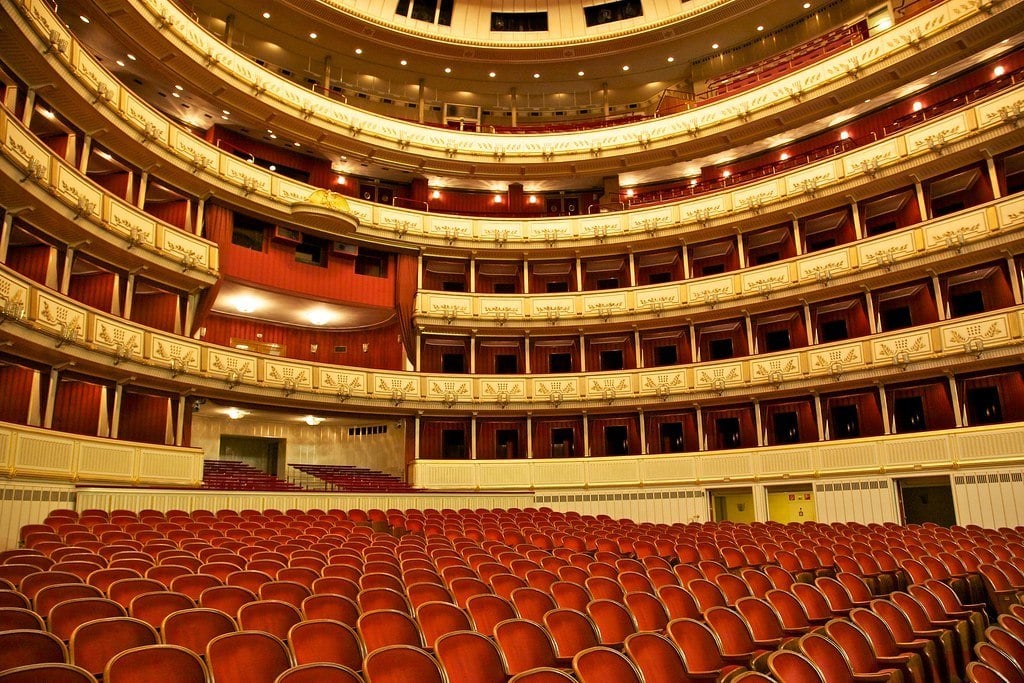
The Vienna State Opera House is one of the most famous and revered opera houses in the entire world, and it hosts a large variety of performances that are rich with culture and tradition. It is a true legacy of Vienna’s artistic accomplishments.
Each season, the schedule will feature 350 shows of more than 60 different operas and ballets! Every night there is a world-class artist among a permanent ensemble of Vienna Opera House members, accompanied by an orchestra. The orchestra is also impressively made up of the same artists from the Vienna Philharmonic Orchestra.
Enjoy world-class performances for a dazzling night out in Vienna! You can also enjoy events at the Vienna Opera House, such as special banquets and balls.
- Cost: Tickets can be anywhere from €2-315 depending on where you sit and what show is being performed.
- How long should I stay here? A typical opera is usually around 2.5-3 hours long.
- Getting there: The Vienna Opera is less than 10 minutes walk from St. Stephen’s.

Wanna know how to pack like a pro? Well for a start you need the right gear….
These are packing cubes for the globetrotters and compression sacks for the real adventurers – these babies are a traveller’s best kept secret. They organise yo’ packing and minimise volume too so you can pack MORE.
Or, y’know… you can stick to just chucking it all in your backpack…
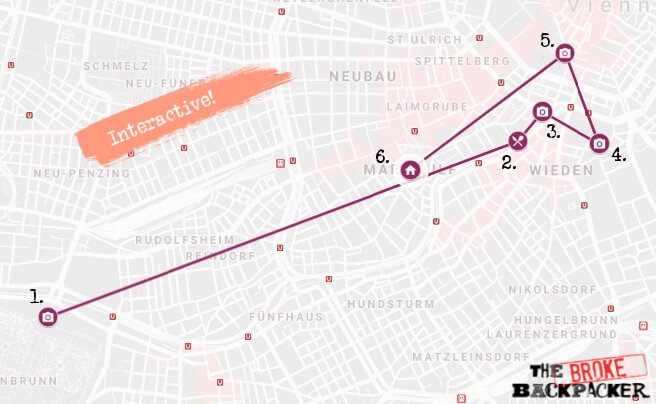
When you travel to Vienna, there are some places that you can’t miss! Enjoy your second day in Vienna with these amazing sights and beautiful places.
9:00 AM – Schönbrunn Palace
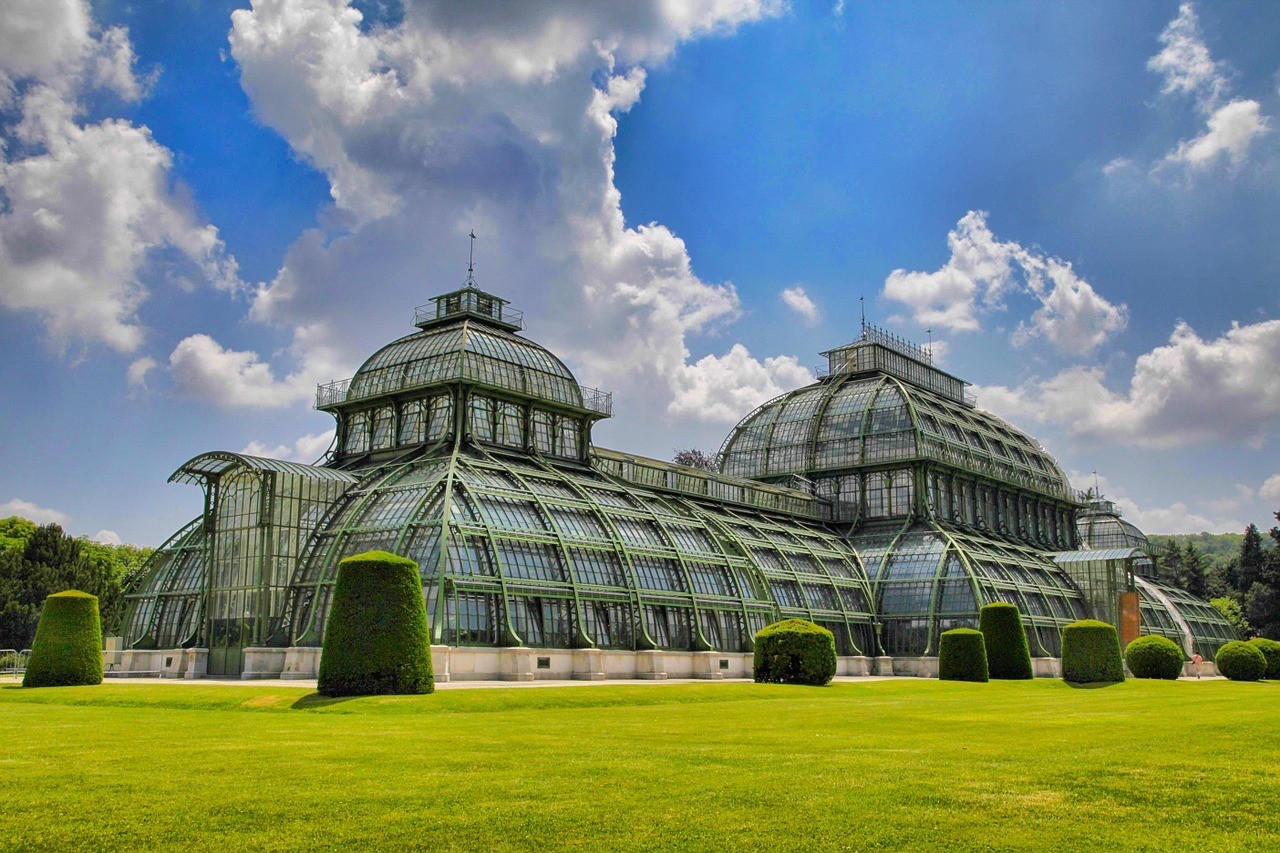
The jaw-droppingly exquisite and extravagant Schönbrunn Palace is a treasure trove of Viennese history and a place of opulent luxury! The palace, once the home of the famous Habsburg rulers, has 1,441-rooms and an unending amount of excellent features and displays throughout both the gardens and indoors. This palace was
The palace itself boasts a Baroque architectural design and is sure to make you feel like royalty as you stroll through the many halls and enjoy the mesmerizing gardens! Feast your eyes and take in one of Vienna’s most significant cultural, historical, and architectural landmarks.
Insider Tip: You can sometimes end up waiting in lines for hours and hours, so be sure to book your ticket online before arriving, so that you can skip the queue and have a guided tour!
- Cost: €16-52 depending on which pass you want.
- How long should I stay here? 1.5 hours inside and 1.5 hours in the park.
- Getting there: Schönbrunn and Hietzing are the two nearest metro stops; both are served by Line 4.
12:00 PM – Lunch at Naschmarkt
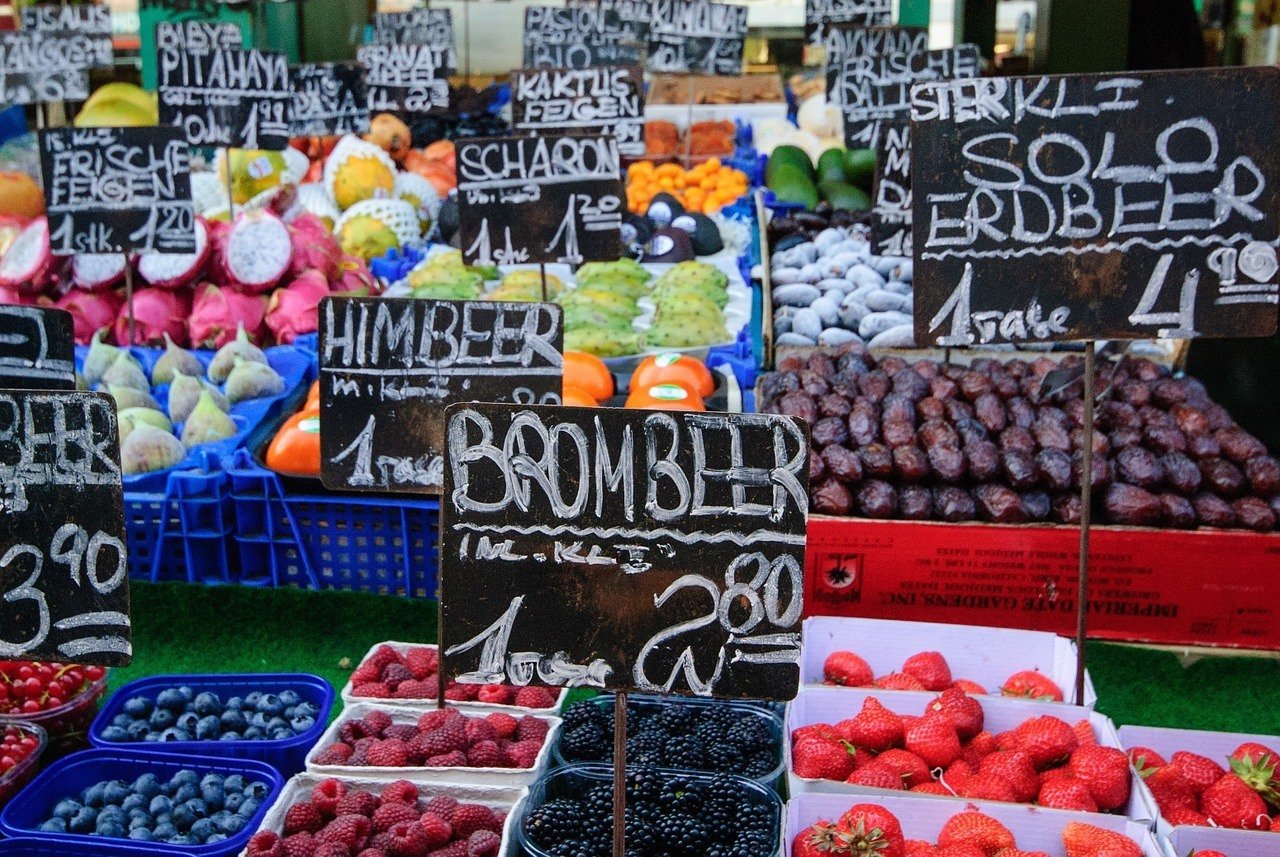
Can you imagine a market that could be described as luxurious? Vienna is probably the only place in the world where there is a luxurious authentic market. There is an endless variety and range of products. Whilst strolling, you will never cease to find something new to see, taste, and simply enjoy!
Opened in the 16th century, the market has a history and used to serve as a marketplace for the Austrian empire to sell goods to farmers from overseas and outside of the city. In today’s time, the Naschmarkt provides a vast array of services! It is a priceless place to enjoy Viennese cuisine and experience the language and culture of the local people.
Each stall is set up with the intention of catching your eye, so expect grand appearances, bright colors, and impressive displays. Fresh fruits are arranged to dazzle, food is cooked with flavorsome spices, and many ingredients are laid out. There is no better place to indulge in Viennese food! Be sure to add this onto your three day itinerary in Vienna!
The city’s melting pot of culture is showcased here in a truly fantastic way, and people-watching is one of the things you will find yourself doing. There are families that have been in Austria for centuries who make cheese and baked goods, as well as ethnic vendors who have come from all over the world to live and trade in Vienna.
The Naschmarkt is open every day of the week, except for Sundays. If you’re visiting Vienna in December, be sure to come for the Christmas markets as well!
- Cost: Varies. Meals usually cost around €15.
- How long should I stay here? 2 hours give or take.
- Getting there: Take Line 4 from Schönbrunn Palace and get off at the Kettenbrückengasse stop.
2:00 PM – Secession
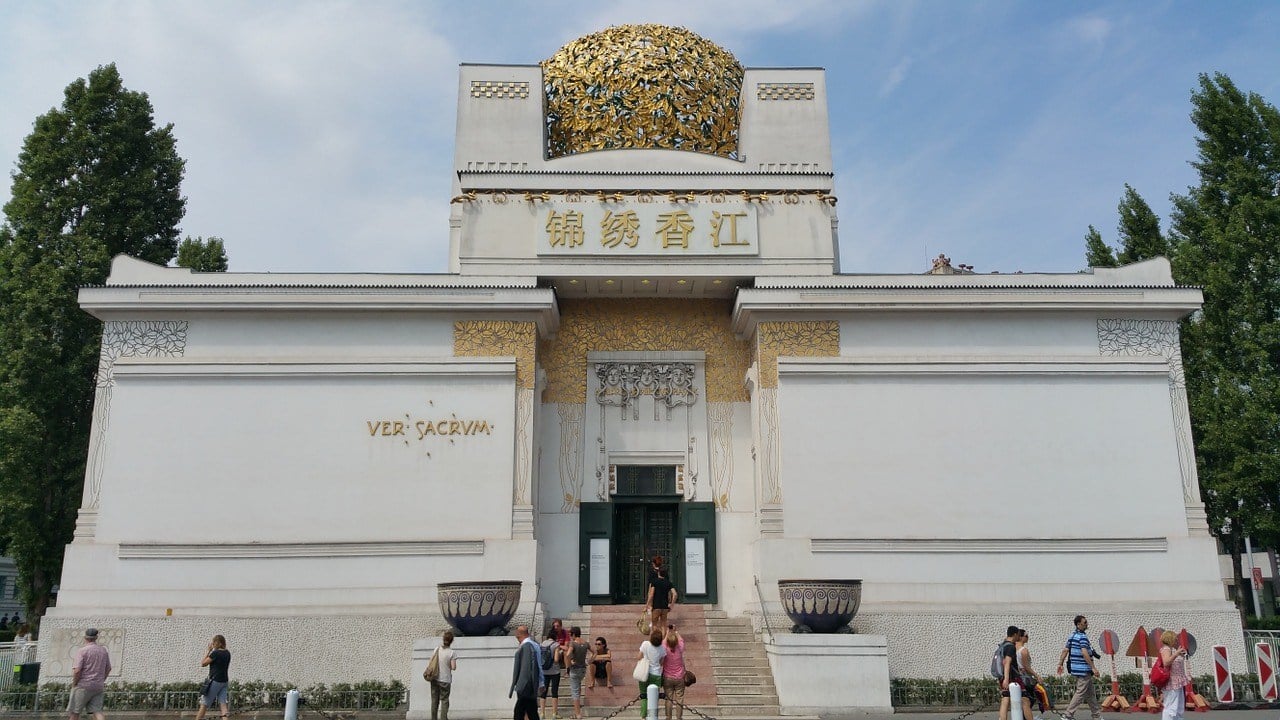
The Secession is a fascinating exhibition and structure of huge significance. Built in 1897, it marks the beginning of modern art in Vienna and pays homage to the powerful movement. When it was first introduced, it was highly controversial and clashed with the extremely traditional and conservative idea of art in that era.
Secession is a monument that honors the first designers and artists who were devoted to their forward-thinking and internationalist view of art! This is one of the very best and most interesting places to visit in Vienna !
- Cost: €9.50
- How long should I stay here? Less than an hour.
- Getting there: The monument is around 5 minutes walk from the Naschmarkt via Wienzeile Street
3:00 PM – Karlskirche
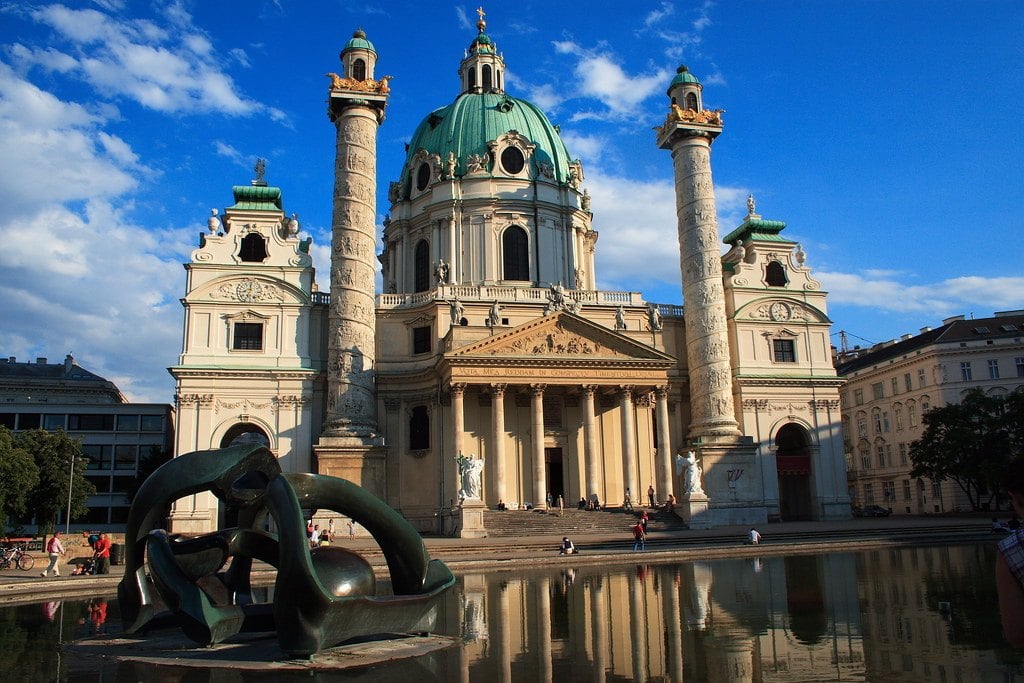
Also known as St. Charles Church, Karlskirche is a fascinating, religiously significant marvel in Vienna! One of the main features of this magnificent church is its massive cupola, which was the last piece of work done by an eminent Viennese architect, Johann Bernhard Fischer von Erlach.
Karlskirche was built in the seventeenth century, and it was constructed because of a vow taken by Emperor Charles VI during a plague epidemic in Vienna. The church pays homage to the patron saint, Saint Charles Borromeo, and you can even find exhibits in the church that display his now very old traveling clothes!
The High Altar has been renovated but maintains its original design and captivating appearance. This is one of the best places to visit in Vienna on your second day!
Insider Tip: If you are a lover of classical music and gospel, be sure to check out the church concerts performed on a regular basis.
- How long should I stay here? An hour; maybe longer if you go inside.
- Getting there: Cross the main street and Resselpark; the church is less than 10 minutes walk from the Succession.
4:00 PM – Albertina
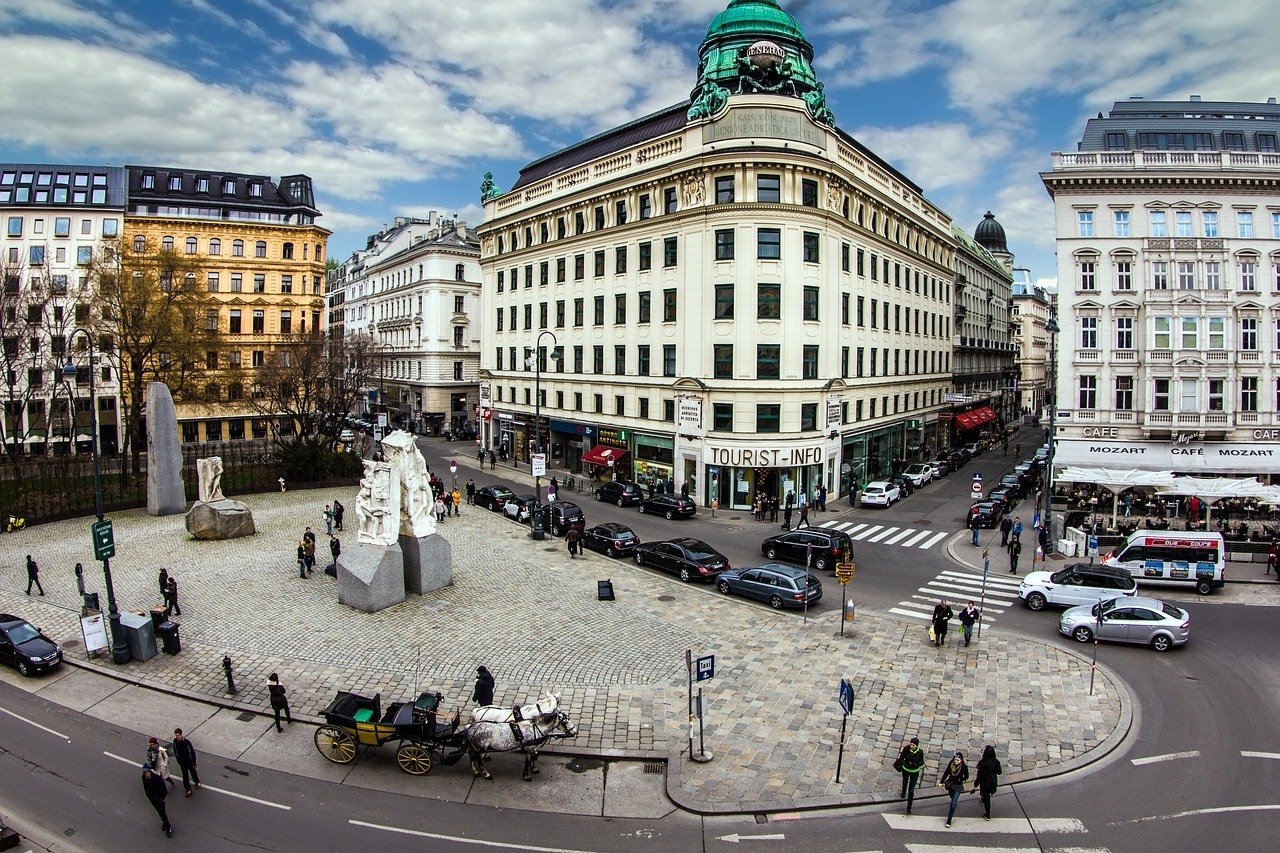
If you love all things art and drawing, then you MUST visit the Albertina during your three days in Vienna! This museum is home to over 65,000 drawings and approximately one million old master prints. In fact, it has one of the largest and most important print rooms in the whole world!
The museum is special to Vienna, but it is also a monument that holds heralds of history from days long past and can give insight into the world’s artistic past.
You can also enjoy a host of majestic graphical words from the modern era, as well as impressive photographs and architectural designs.
- How long should I stay here? Until closing (1-2 hours).
- Getting there: The museum is located back in Inner Stadt and it’s about a 15-minute walk from Karlskirche.
7:00 PM – Mariahilf Neighborhood
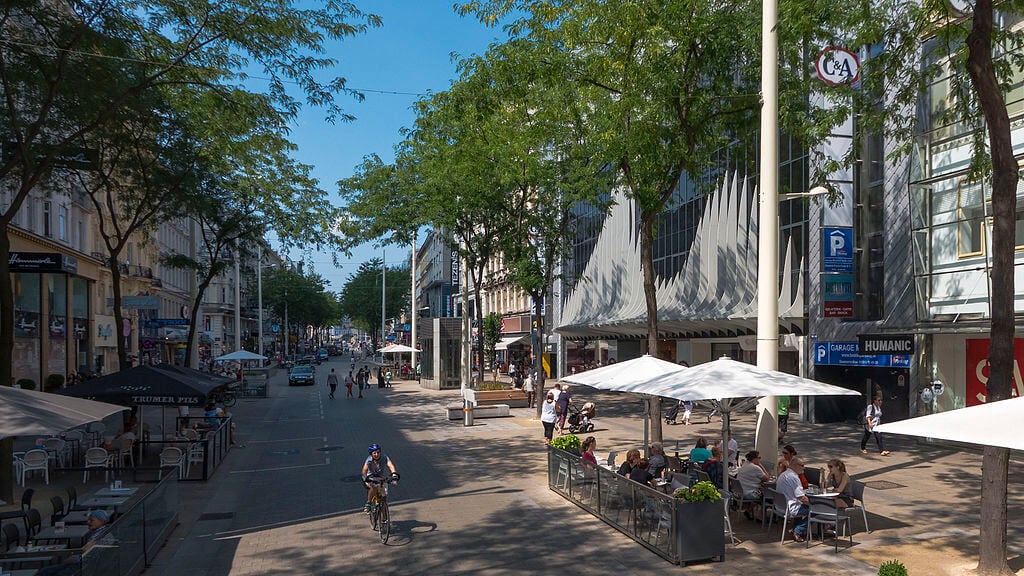
After a long day of exploring Vienna, it’s time to sit down and have a nice meal and tall stein of beer. The best area to unwind in the city is definitely the district of Mariahilf.
Mariahilf is currently one of the trendiest neighborhoods in Vienna is very popular with younger crowds. Some of the coolest Viennese cafes and bars are located around this quarter so it makes for an excellent place to blow off some steam and get stuck in a long conversation. There are a lot of students around so the conversations may veer towards the academic what’s currently ailing society.
Cafe Kafka is one of the most notorious coffee house in the area and worth dropping by for a quick drink. Fair warning though: it can be noxious inside as smoking is allowed indoors here.
Secret Garden is a very charming vegetarian restaurant tucked away in an even more charming back alley of Mariahilf.
Finally, Stehbeisl is one of the best bars in Vienna thanks to the ambiance – imagine fancy dive with cheap beers and pictures of American rockers.
- Cost: €3-4. €10-15 for an affordable dinner.
- How long should I stay here? As long as you want!
- Getting there: You’ll need to backtrack past Kunsthistorisches and beyond the MuseumsQuartier. A bit of a walk from the Albertina but still less than 20 minutes away.
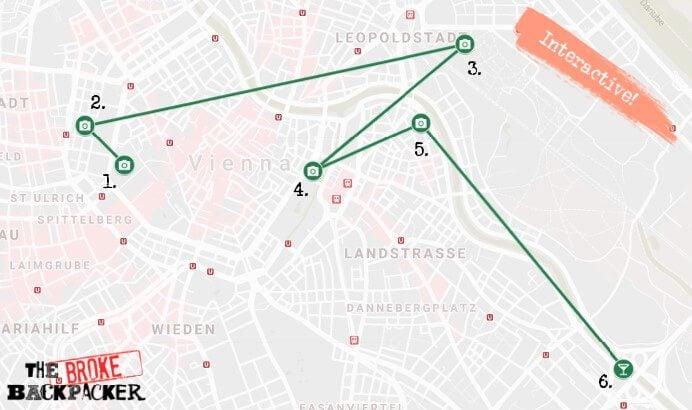
Are you wanting to know which places to visit in Vienna? Well, our itinerary covers a variety of places to go and things to do during your visit. If you plan on spending a weekend in Vienna , three days, or even a week, these activities will guarantee that you have an amazing time!
9:00 AM – Volksgarten
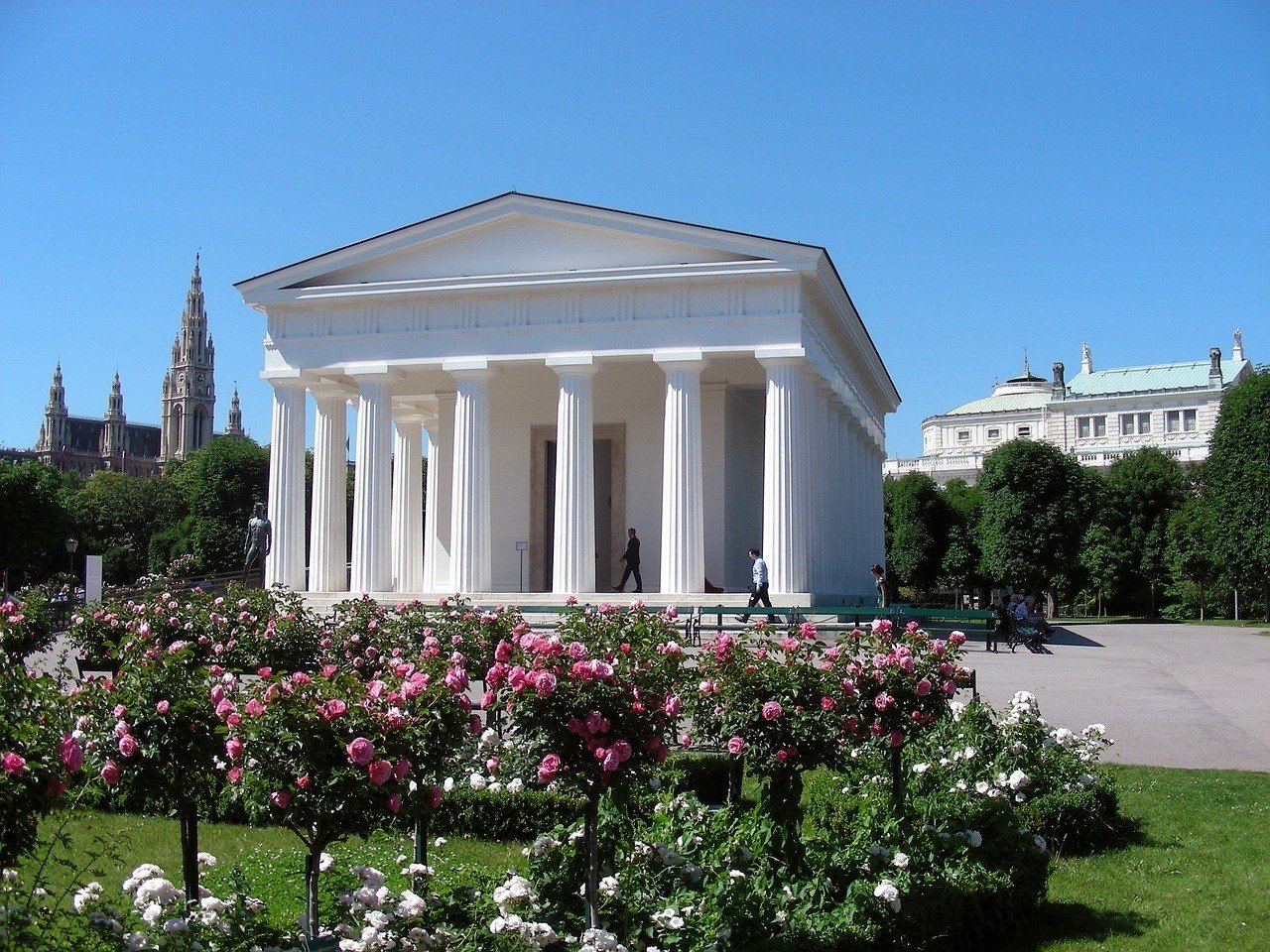
The Volksgarten is an extremely scenic public park that is apart of the Hofberg Palace, and it is well worth seeing! The park itself was built over the historical site of the city fortifications that got destroyed by Napoleon in 1809.
The park boasts historical value, pristine gardens, soothing fountains, and a gorgeous place to stroll about and enjoy one of Vienna’s most sculpted flower and bush formations. Start your morning easy and get the cobwebs out of your eyes before we start day 2 of our Viennese itinerary.
After you finish your walk in the park, be sure to drop by Café Landtmann in front of the Rathaus. It is one of the most famous coffee houses in Vienna and was one of Sigmund Freud’s favorite places to frequent.
- Cost: Free.
- Getting there: Take Line 2 and get off at Volkstheater.
10:00 AM – Rathaus
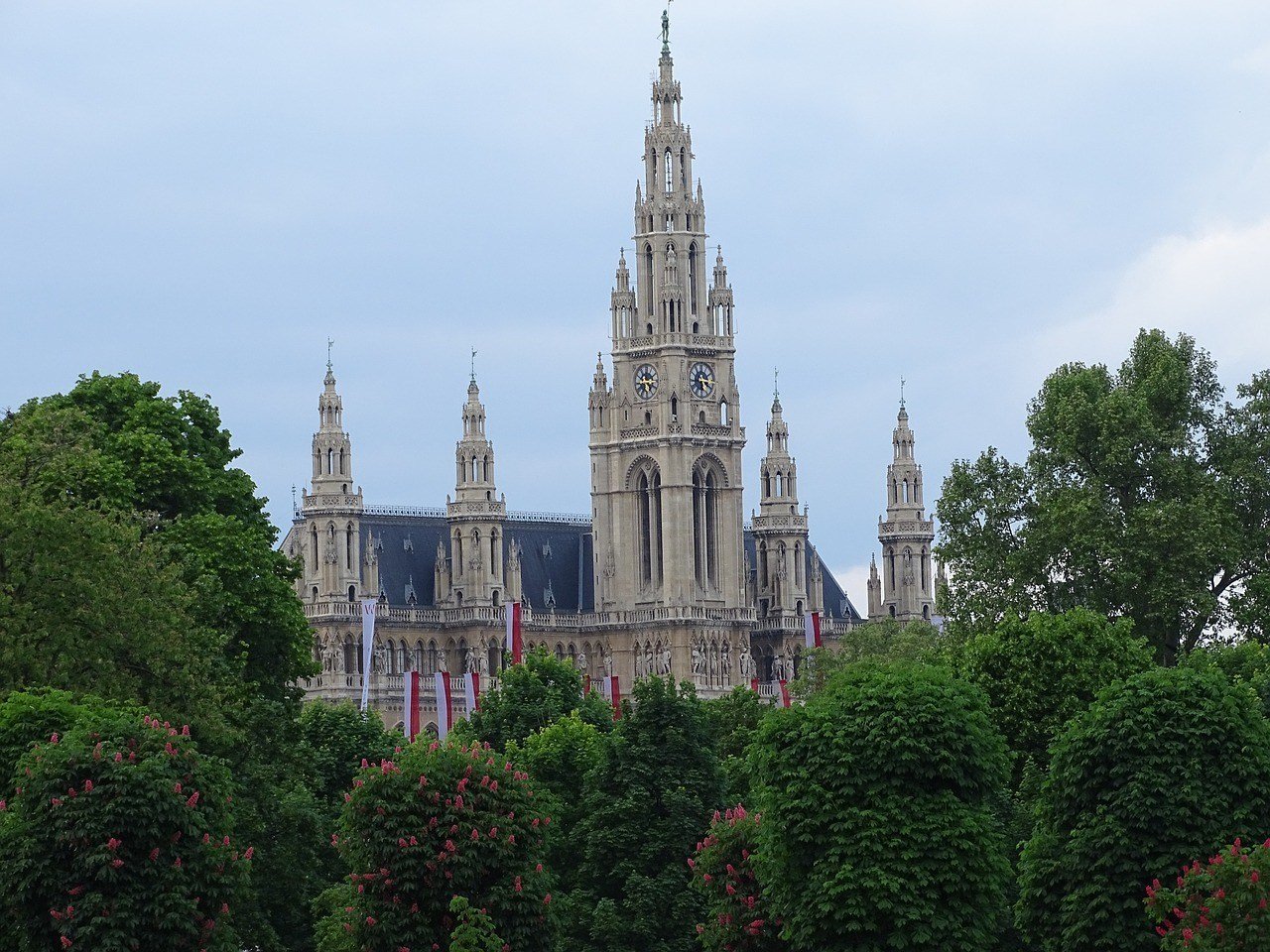
The Rathaus is Vienna’s City Hall. It is also the most expensive monument that has been built in Vienna during the 19th century! It was originally constructed between 1872 to 1883 and has an incredible neo-gothic design.
There is a lovely 100-meter tall tower that resembles a cathedral bell tower, and it sticks out like an oddly beautiful sore thumb! The tower is topped by a significant statue of a regal armored knight holding a lance. In fact, you will find statues of Viennese nobels all over the Rathaus grounds.
One of the must-see sights is found on the eastern side of the building, and it is a wonderful loggia that leads you into the interior of Rathaus. From here, you can walk up a sleek staircase to view the extravagant banquet hall.
- Cost: Guided tours can be bought on-site to see the halls but there’s not much time today.
- How long should I stay here? An hour.
- Getting there: The Rathaus is across the street (Universitätsring) from the Wolksgarten.
12:00 PM – Prater
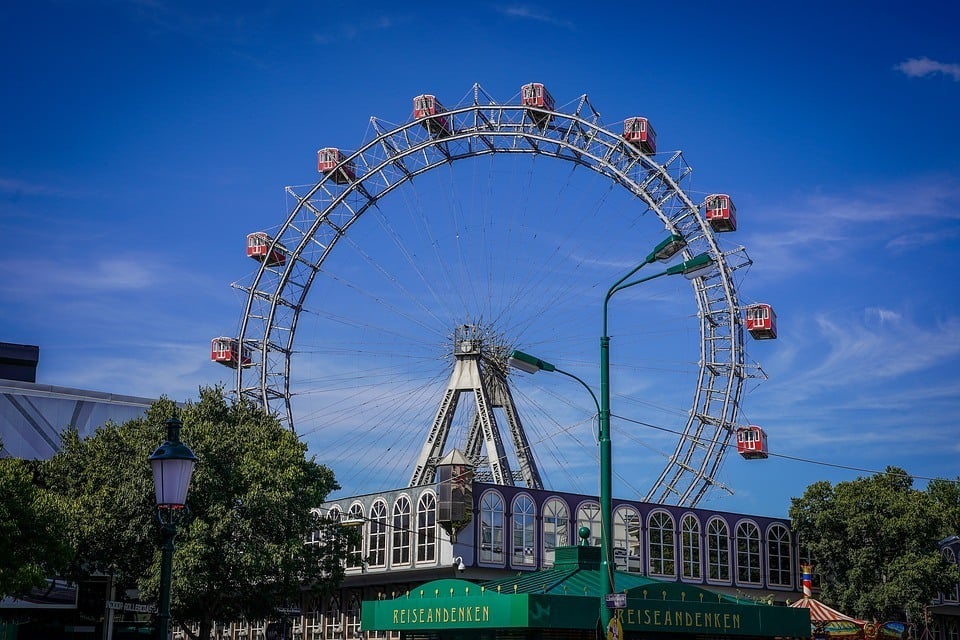
Officially known as Wurstelprater , Prater is one of the most fun and exciting amusement parks in Vienna! Not only will you find a host of incredible sites, rides, and uncanny food stalls, but you can also enjoy an iconic ride on Vienna’s most popular and world-renowned symbol – the Wiener Riesenrad Giant Ferris Wheel. Movie buffs will also interested to hear that this Ferris wheel is where one of the most famous scenes from The Third Man – an iconic movie starring Orson Welles and made in Vienna – was filmed.
For those who are not interested in the theme park, there’s still plenty of green space to wander around. We suggest grabbing a wurstel (sausage) or something else to go from one of the stands back at Wurstelprater and then having a little picnic on a hill somewhere.
- How long should I stay here? 3-4 hours.
- Getting there: Take the U-Bahn (Line 2) from the Schottentor stop near the Rathaus and get off at Messe-Prater.
3:00 PM – Museum of Applied Arts
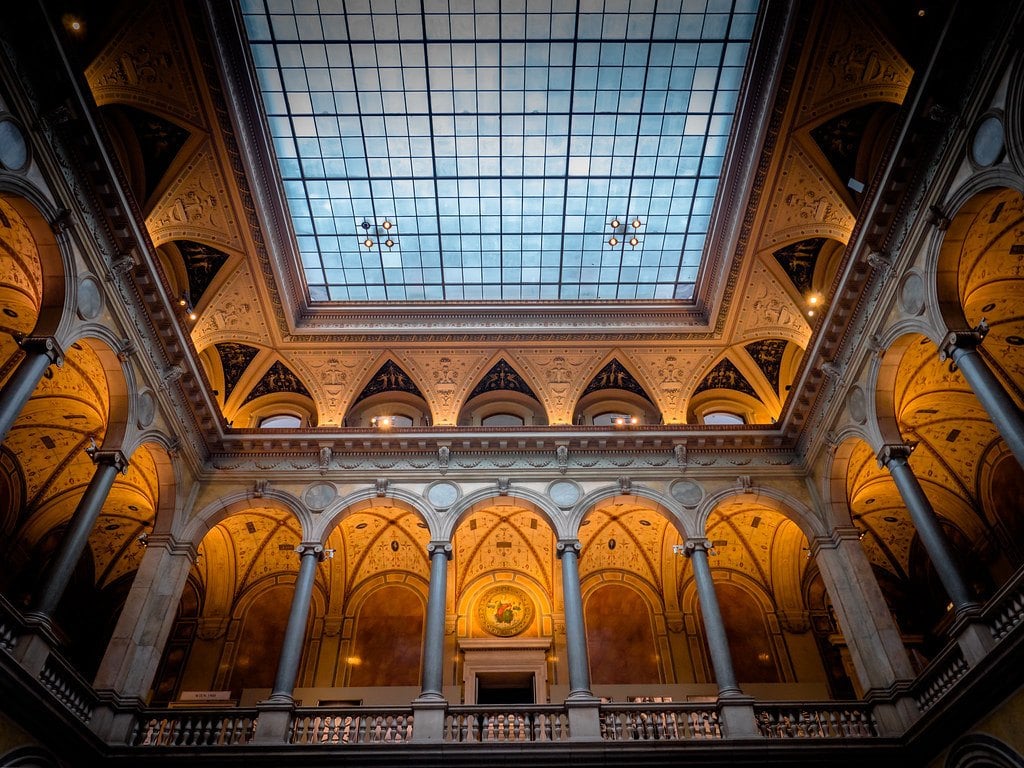
Also known as MAK, the Austrian Museum of Applied Arts is an extraordinary museum and one of the most fabulous structures in Vienna! One walk around here will have you feeling inspired and invigorated with a fresh new set of eyes to lay on the world. It has been around since the eighteenth century and has a lot to boast about in terms of its function and architectural properties!
The museum traces the artistic history of Austria and emphasizes current art accomplishments. You will find every kind of exhibition displayed here, from baroque glassware to industrial design awards. The museum is also known for hosting remarkable temporary exhibits. It will be sure to add a sense of excitement to your visit, and you may be lucky enough to see one!
The building of the Museum of Applied Arts is a masterpiece in itself, and you could spend plenty of time admiring the ceiling, which is a gorgeous neo-renaissance design. This one-of-a-kind museum is a museum of Austrian art, design, and also history. It offers a huge variety of insight into all of these fascinating areas!
- Cost: €12.
- Getting there: From the beginning of Wurstprater, it’s about 10-15 minutes walking back across the Danube Canal.
5:00 PM – Hundertwasser Apartment House and Museum
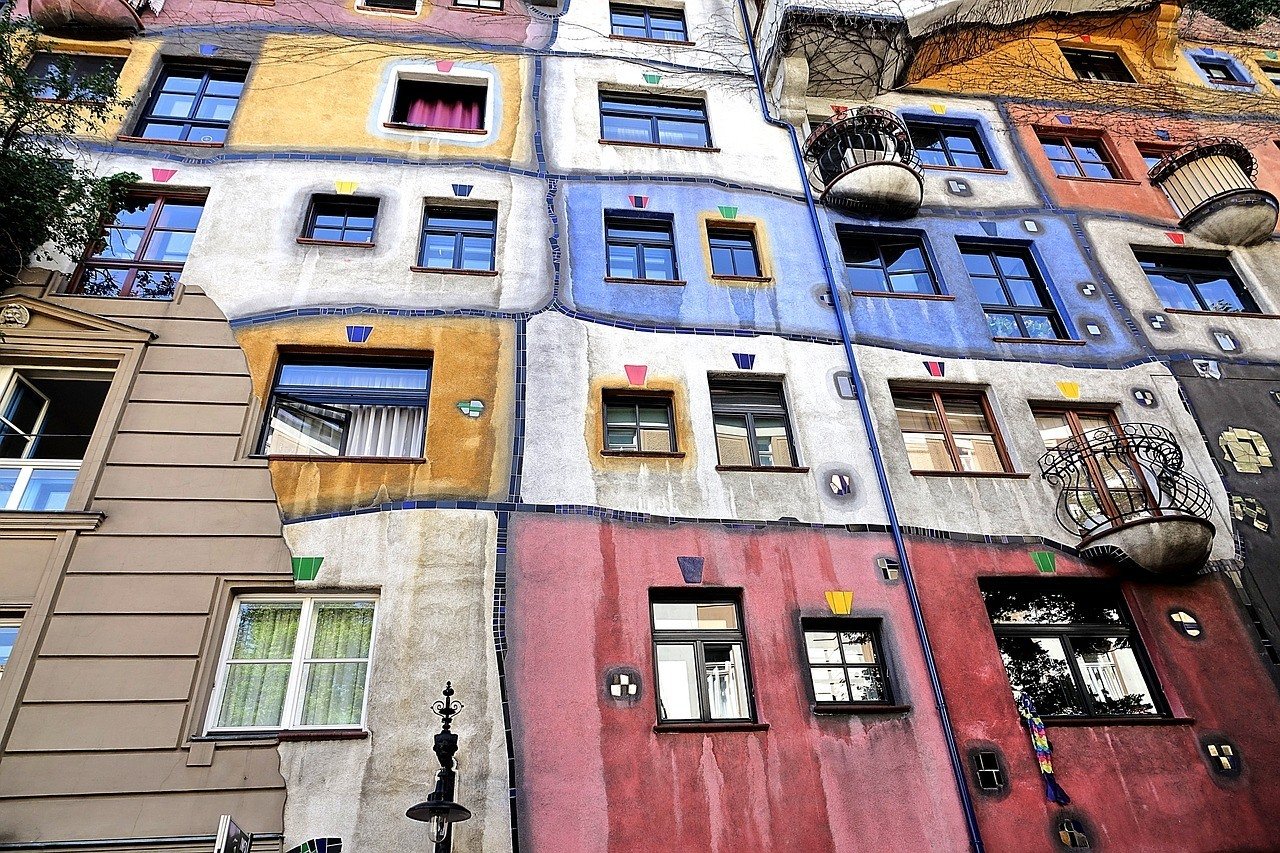
The artist in which this entire adventure pays homage to is Friedensreich Hundertwasser, and -although his name might be a tongue twister- it is well known to all Viennese households. The Apartment House is one of his very first and very influential designs. He was an architect with a love for out-of-the-box thinking and a dream to inspire people all over the world to create their own paradise on earth!
The apartment is one of Vienna’s highlights and shows off remarkable Antoni Gaudi style architecture. It is a real sight to behold and an eye-catching gem on your three day itinerary in Vienna.
The Hundertwasser Village is found just opposite the house, and there is a building that has an entire forest for a roof! The village itself is a small shopping center, complete with a handful of beautiful souvenir shops.
The museum is a short walk from the apartment and provides excellent insight into the world of this famous Viennese artist! The museum building has a beautiful interior design and is worth having a look at. You can also enjoy a selection of his artwork and become inspired by someone who has left a magnificent footprint of love and art as his legacy.
The Hundertwasser Apartment House can be seen from outside all day every day, however, the infoshop is only open from 9 am to 5 pm. You can see the village every day from 9 am to 6 pm and the museum from 10 am to 6 pm.
- Cost: €11.
- How long should I stay here? 1 hour is fine.
- Getting there: From the Kunsthaus, it’s a 5-minute walk to Hundertwasser.
7:00 PM – Danube Canal
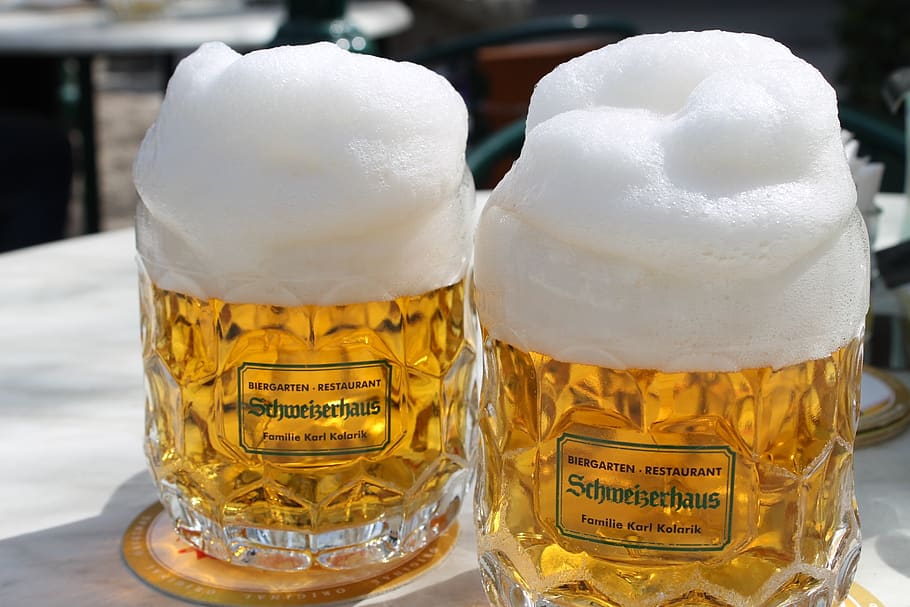
Spend your last day in Vienna lounging by the lazy Danube Canal. Whilst a fairly unremarkable sight on its own, during the summer the canal can get pretty busy with pedestrians. Lots of people come here at the end of the day to relax and drink beers with friends!
There are lots of bars and restaurants around the Danube Canal. Strandbar Herrmann is probably the best of the bunch and features some excellent DJ sets. There’s also Badeschiff Wien, similar to Strandbar, as well as Motto am Fluss, which is a bit fancier. Regardless of which you end up choosing, relaxing with a large beer and some chips is the best way to end your Vienna itinerary.
- Cost: €4-7 for a drink. €10-15 for a dinner.
- How long should I stay here? The rest of the night!
- Getting there: Find Lowengasse street and then grab Tram 1 at Hetzgasse stop. Ride for a couple stops on then Strandbar will be on the right.
Need a place quick? Here’s the best neighborhood in Vienna
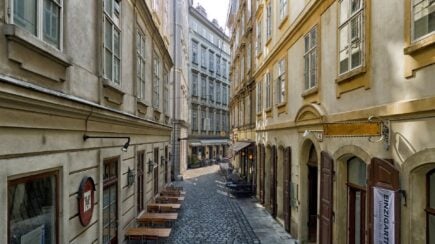
Innere Stadt
Innere Stadt is the most central neighbourhood in Vienna, and where most of the historical sights are located. It is your best option to stay there if you are visiting the city for the first time, as you will be close to everything and in the centre of the action.
- Get a slice of Austria’s most famous cake at the Sacher Hotel
- Get a glimpse of the Habsburg’s family life at the Hofburg
- Visit Stephansdom, Vienna’s most famous religious building
Ready to go BEYOND our three day Vienna itinerary? Here some other places to check out around the city!
Central Cemetery
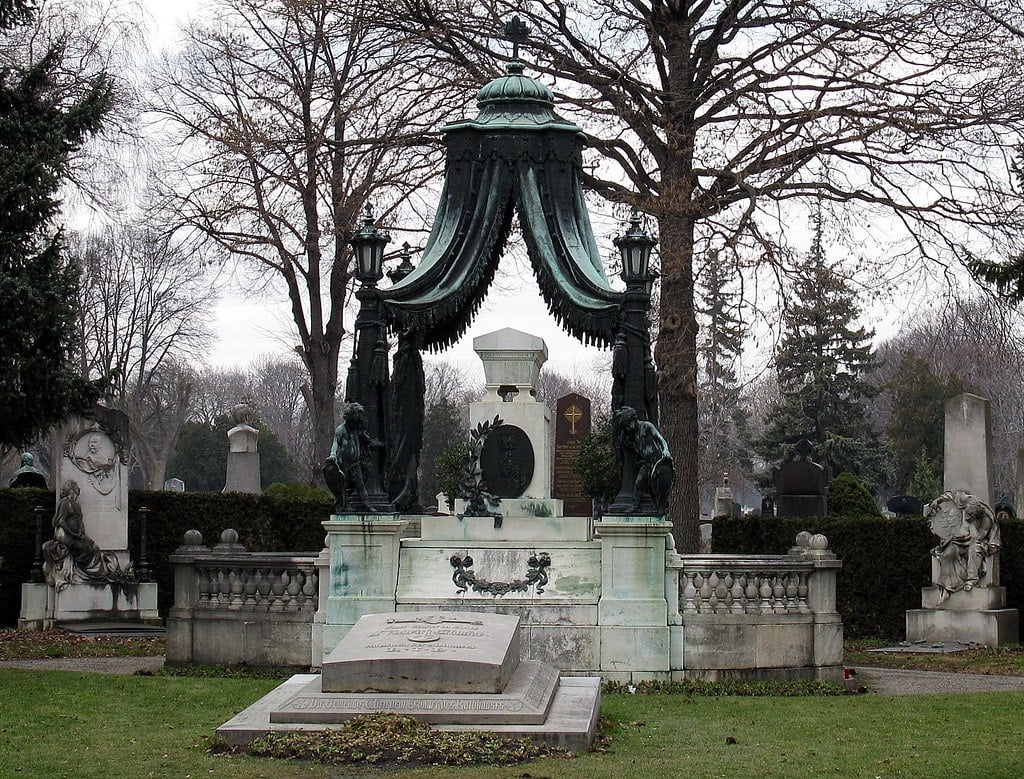
If you want to know what to see in Vienna that is unusual and mysterious, then the Zentralfriedhof (Central Cemetery in English) definitely falls into that category! Some may not be comfortable with it, and therefore you can skip this option if that is the case, however, there is a serene atmosphere and a sense of beauty found at this cemetery that is unique to Vienna.
The Central Cemetery’s origins have a rich history, and it was built due to the overwhelming jump in population (approx. one million inhabitants) in 1874. It is the largest and most beautiful cemetery in Austria and one of the largest in the world.
The cemetery is full of ancient monuments and gorgeous statues. You will also find a beautiful church through the main gate, known as the Church of St. Borromeo.
Take the chance to relish your life whilst in a place that honors the dead and enjoy the way this cemetery has found a way to celebrate the lives of those who have passed.
Insider Tip: To get the full spectrum of the Central Cemetery, it’s best to book a tour!
- How long should I stay here? 1-2 hours.
- Getting there: The Central Cemetary is pretty far away from the city center. To arrive, you’ll need to take commuter train S7/S2 or tram 71, not the U-Bahn.
Wien Museum Mozart Apartment
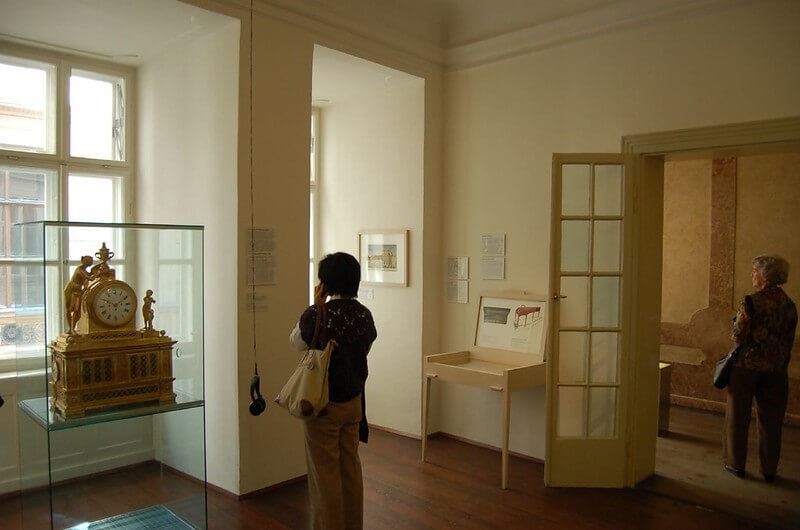
One of the best things to see in Vienna in three days for all history and classical music lovers is to visit Mozart’s Apartment at the Wien Museum. You can walk in the footsteps of this iconic, revered, and gifted musician.
Feel the ambiance of this special place, a place where Mozart once sat and wrote his world-famous music! You can even glimpse the very same views he had and feel the inspiration that came forth from it all.
The apartment has been untouched since 1787 when Mozart last lived here, and it is a true monument of the composer’s long and rich legacy.
There is also a Mozart Museum onsite that has incredible historical knowledge about the life Mozart lived in Vienna, as well as insight into his musical masterpieces.
Dive into this beautiful, significant spot and learn about one of the world’s most gifted musicians ever to grace us with his talent!
- How long should I stay here? Around 1 hour.
- Getting there: Mozart’s apartment is located very near to St. Stephens Cathedral. Stephansplatz is the nearest U-Bahn stop (Line 1 and 3).
The Belvedere Palace
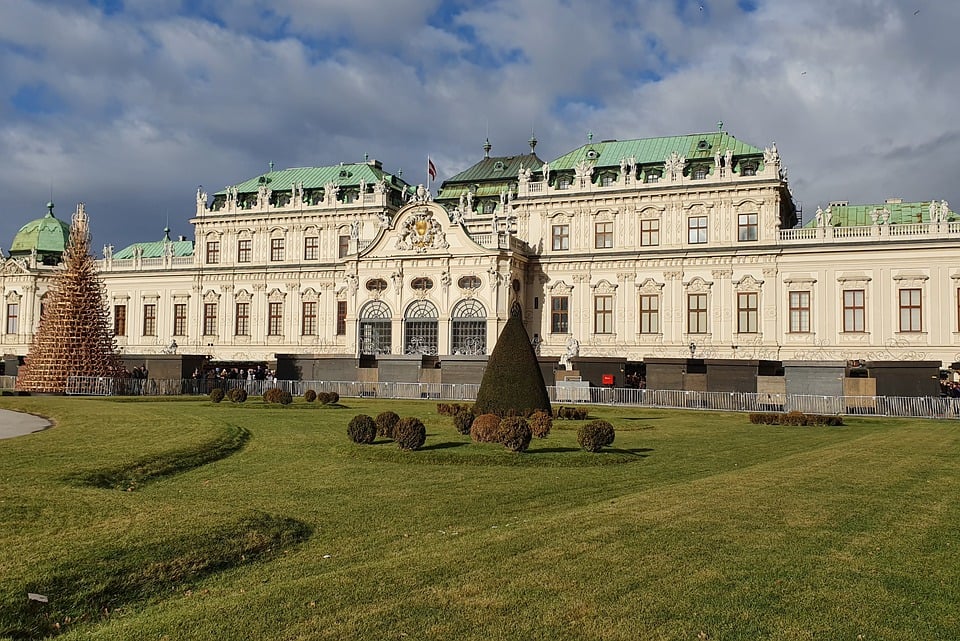
The Belvedere Palace is very similar to the Schönbrunn Palace: both are formally royal estates turned museums, both are opulently designed, and both are quite massive (though the Schönbrunn is bigger).
What The Belvedere offers that the Schönbrunn Palace does not though is one of the finest collections of art in Vienna, including one of the most hyped paintings in the modern era: The Kiss by Gustav Klimt. Considered by many to be a tour-de-force and even greater than the Mona Lisa , buying a ticket for the Belevedere Museums is worth seeing The Kiss alone.
There’s more to the Belvedere than just Klimt’s masterpiece though. The museum features other works of art by Klimt’s contemporaries and predecessors and the halls of The Belevedere itself are still remarkable. Be sure to find the Marble Hall in Upper Belvedere and then look up at the ceiling.
- How long should I stay here? 2-3 hours.
- Getting there: The D Tram will drop you off right in front of The Belvedere.
MuseumsQuartier
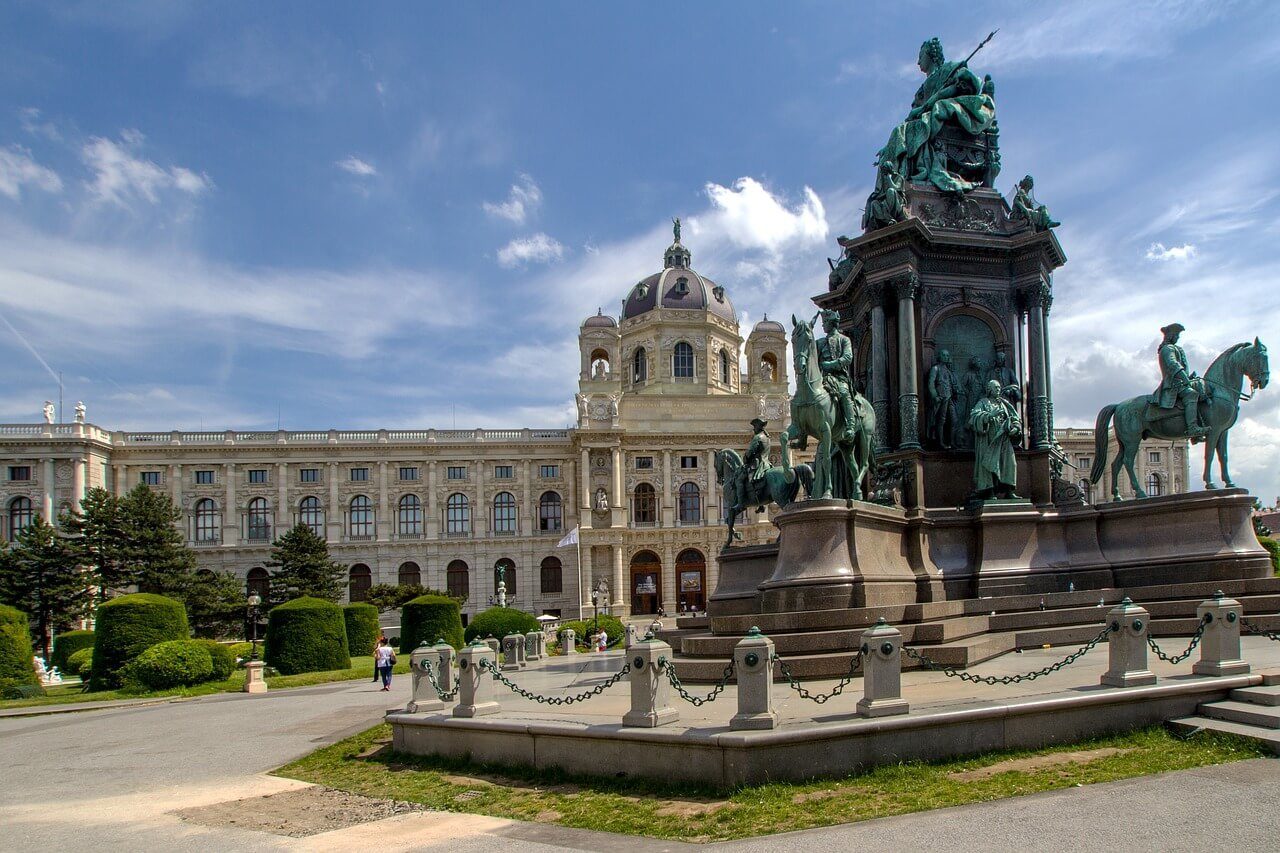
The MuseumsQuartier is a semi-enclosed area of Vienna that is made up of 4-5 different museums. It’s a good place to visit in Vienna if you want to see a couple of different exhibitions in a row without having to walk around the city.
The Leopold Museum is probably the most popular attraction in the district as it features the most impressive collections. Dedicated mostly to the modernists and the Succesionist movement, this museum features works of art from many of the greatest Viennese painters, including Schiele, Klimt, and more. The Schiele is particularly impressive and shouldn’t be missed by anyone interested in his work.
The MUMOK located across the plaza from the Leopold. This is one of the leading contemporary art museums in Vienna and features much more modern pieces from recent decades. It’s a bit more minimal and less crowded than the Leopold and is best for those who like both art and technology together.
Other institutions of note in the MuseumsQuartier are the Architekturzentrum Wien (architecture) and the ZOOM Kindermuseum (children’s).
- Cost: €20,90 for all four museums. Individual tickets vary.
- How long should I stay here? Depends on how many museums you visit.

Stash your cash safely with this money belt. It will keep your valuables safely concealed, no matter where you go.
It looks exactly like a normal belt except for a SECRET interior pocket perfectly designed to hide a wad of cash, a passport photocopy or anything else you may wish to hide. Never get caught with your pants down again! (Unless you want to…)
When traveling the world, it’s vital that you choose a time of year that suits your individual travel needs and desires. Knowing when to plan a trip to Vienna depends on what you want to see, how you want to experience it and whether or not you want to visit during peak season. Our Vienna itinerary will share some options to help you plan your trip!
Vienna has an oceanic climate, with pleasantly warm summers and icy dry winters. Peak season in Vienna is during spring and summer, with summer falling between the warm months of June to September. This is when most people flock to enjoy the good weather and get all of their sightseeing done in the sunshine.
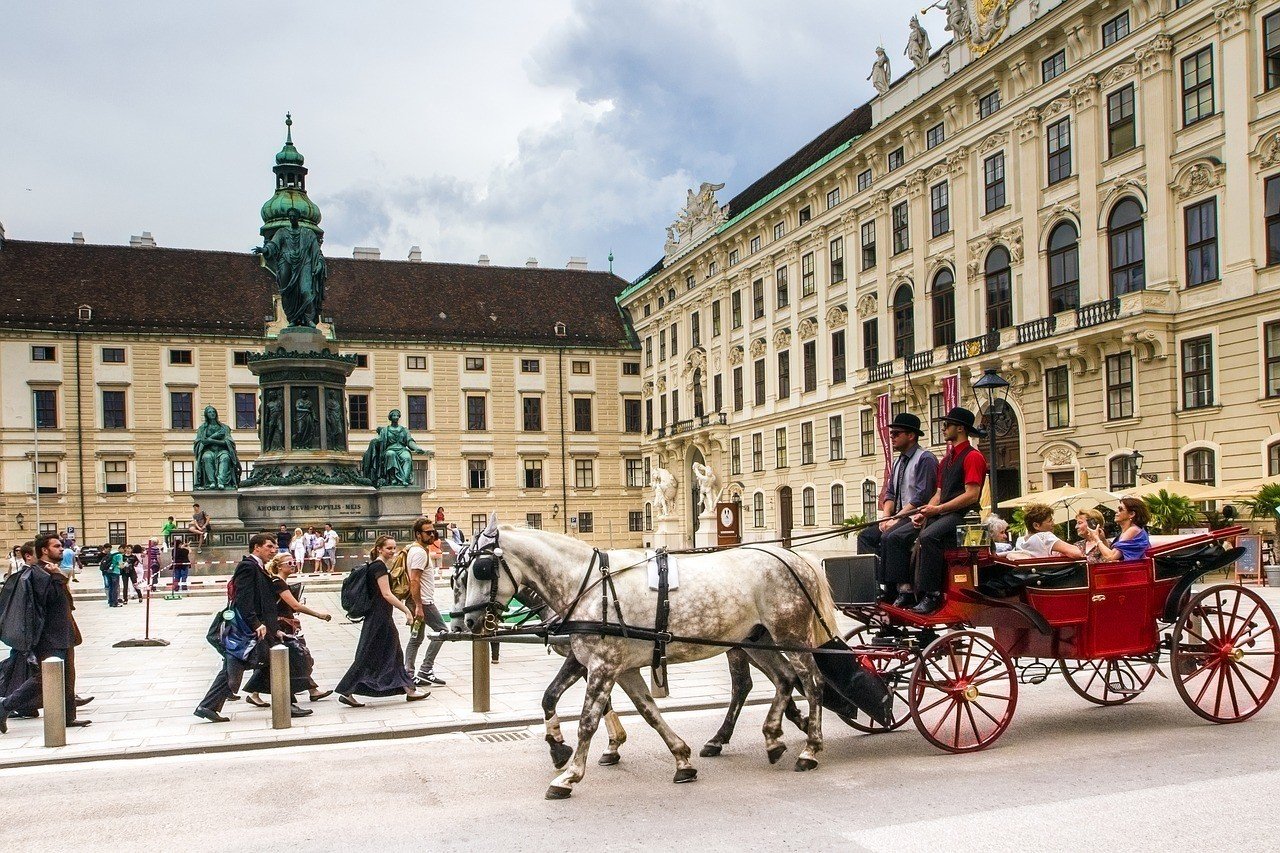
If you want to experience a winter wonderland (complete with snowfall and Christmas markets ) then visiting Vienna in December is perfect. If rainy days spent in coffee houses sounds like something you want to make the best of, then visit in June, as this is when Vienna has the most rainfall on average.
The best periods to visit Vienna are typically between April and May, or September and October. The weather is delightful and mild, with no extremes of any kind during these months. The upside of visiting during these months- as opposed to peak season- is that the prices of accommodation stay reasonable and don’t skyrocket.
Vienna has a truly impressive public transport network. Practically every part of the city is serviced by some sort of transit whether it be by bus, tram, or metro. Such connectivity makes backpacking in Vienna extremely easy.
For a city of its size, Vienna’s underground metro network is very impressive. The metro, or U-Bahn , is composed of six different lines that pretty much cover all of the top sights in Vienna . Even if you’re staying in the middle-of-nowhere Vienna like Donaustadt, you can still be in the city center in a half hour.
When using the metro, note that there are no turnstile kiosks where you would validate your ticket to gain entry BUT you still need to stamp it at a separate machine like it was back in the Industrial Fuckin’ Revolution.
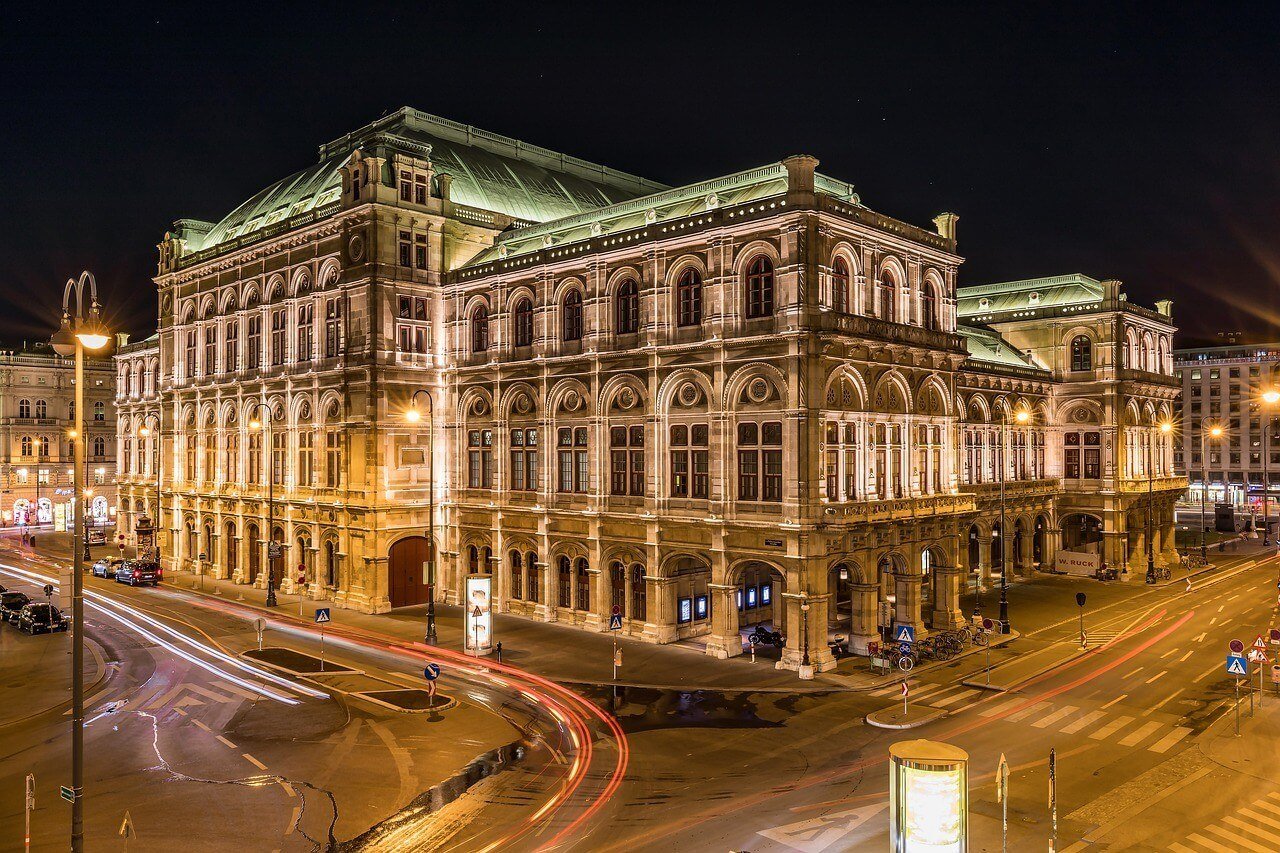
What the U-Bahn doesn’t cover, trams and buses do. The tram network extends very far out into the outer neighborhoods of Vienna -. Ottakring, Funfhaus, and Wahring all have dedicated lines. So, again, don’t feel cut-off if you’re staying further outside the city center.
At 2.40 euro, tickets for public transport are a bit on the expensive side. They’re only good for one ride as well, which is a bit annoying. Since there are very few if any places that require to show a ticket, some people take a risk and ride without one. I’ll let you make that call yourself whether or not it’s worth dodging the occasional tram cop.
If you’re spending more than three days in Vienna and think that it would be worth it, buy a transit pass. You can buy a 48-hour pass for 14.10 euros or a 72-hour pass for 17.10 euros.
Depending on when you visit Vienna, you’ll need to pack accordingly i.e. warm clothing in the winter and lighter clothing in the summer; perhaps some outdoor gear as well if you plan on going to the Austrian Alps. For information on what to pack, refer to our general backpacking packing list article.
Although Vienna is not a prime spot for crime, it is always good to know some general knowledge about keeping yourself and your belongings safe while enjoying our Vienna itinerary. In fact, Vienna is a preferred travel destination because of it’s low crime rate, so we don’t expect you will run into trouble, but it is always better to be safe than sorry.
You may come across a lot of “Mozarts” dotted around Vienna, and these are typically panhandlers trying to sell tickets to concerts or performances. To get them to back off, simply state a strong ‘no’ and move on. You should be left alone. Buy your tickets from companies directly, as you don’t want to fall prey to a scam.
While traveling in Vienna, be aware of the cyclists. The cyclists in Vienna are super fast, and it can be easy to bump into them if you don’t look where you are going. Avoid this by keeping vigilant on the roads. There is a section clearly marked on the roads for cyclists, so this isn’t a major issue, but just make sure not to veer into this section by accident.
Keep in mind all of the general safety rules, such as not leaving your belongings unattended in a public space and making sure you don’t walk around with your handbag open wide. Try to avoid walking alone at night, as it is always safer to have a trusted company with you whilst walking.
For more information about keeping safe during your travels, read our list of crucial safety tips !
Don’t Forget Your Travel Insurance for Vienna
ALWAYS sort out your backpacker insurance before your trip. There’s plenty to choose from in that department, but a good place to start is Safety Wing .
They offer month-to-month payments, no lock-in contracts, and require absolutely no itineraries: that’s the exact kind of insurance long-term travellers and digital nomads need.

SafetyWing is cheap, easy, and admin-free: just sign up lickety-split so you can get back to it!
Click the button below to learn more about SafetyWing’s setup or read our insider review for the full tasty scoop.
Find out what people want to know when planning their Vienna itinerary.
How many days are enough in Vienna?
Having 2-3 full days to explore Vienna will allow you to visit all the top attractions.
What should you include on a 3 day Vienna itinerary?
No trip to Vienna is complete without exploring these top places to visit: – Kunsthistorisches Museum – Schönbrunn Palace – Naschmarkt – Hundertwasser Apartment House
Where should you stay for a weekend in Vienna?
The Innere Stadt is the best area to stay in for a short trip. The heart of the city, it provides easy access to top attractions and is well connected to other areas.
What are the best day trips from Vienna?
Got time to explore further afield? Check out these top day trips: – Vienna Woods and Mayerling – Carnuntum – Salzburg – Hallstatt
Your trip to Vienna will be full of blissful galavanting, aesthetic scenery, unending historical knowledge, gorgeous imperial buildings, and plenty of priceless gems! Vienna has so much magic, and with our three day Vienna itinerary in hand, you will know all the best places to go and soak it all in!
The memories made on this adventure will be kept for an entire lifetime, and you will have stories to share with loved ones forever.
To make sure you can visit every hotspot, you need to have the right travel budget. Find out how expensive Vienna is , and how to use a couple of tips and tricks to keep a bit of money in your pocket. Even if you’re pushed for time then there are still some great day trips to take from Vienna too.

Share or save this post

Thank you sooooooo much for this detailed guide
Leave a Reply Cancel reply
Your email address will not be published. Required fields are marked *
Save my name, email, and website in this browser for the next time I comment.
Notify me of followup comments via e-mail.

4 Days In Vienna Itinerary To See It All
Vienna is simply gorgeous, immaculate and elegant. It has wide swathes of pedestrianized areas, gorgeous Baroque architecture, scads of museums, and to die for cafes.
The city boasts grand imperial palaces, such as Schönbrunn and the Hofburg. As the “City of Music,” Vienna was home to many of history’s greatest composers like Mozart, Beethoven, and Strauss.
To top that off, the city center is charming, filled with historic architecture and quaint cobblestone streets.
All this makes Vienna a favorite destination for me. I’m just back from another visit (this time 9 days) and I’m ready to hand over the perfect 4 days in Vienna itinerary.
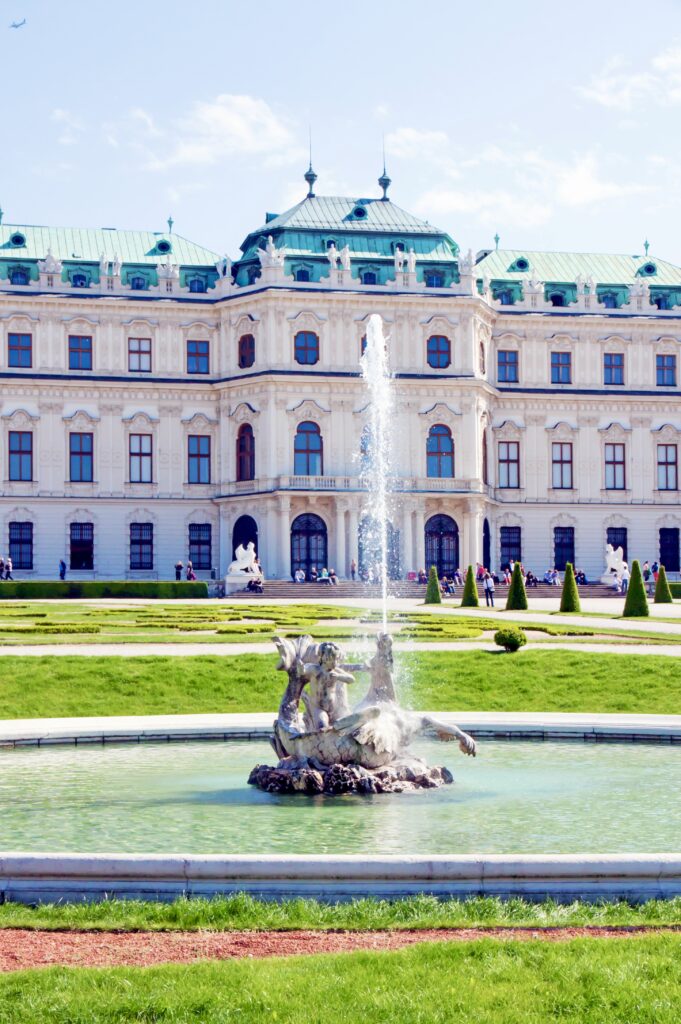
Snapshot Of 4 Days In Vienna
Here’s a quick glance of what you can see with this Vienna itinerary:
Day 1 : St. Stephen’s Cathedral, Mozarthaus, Jewish Museum, Hofburg Palace, Austrian National Library, Graben Street
Day 2 : Kunsthistorisches, Leopold Museum, Spittelberg, City Hall, Burgtheater, Freud Museum, Votive Church, Döbling
Day 3 : Secession Museum, St. Charles Church, Wien Museum, Belvedere Palace, Staatsoper
Day 4 : Schönbrunn Palace, Albertina Museum, House of Music, food tour
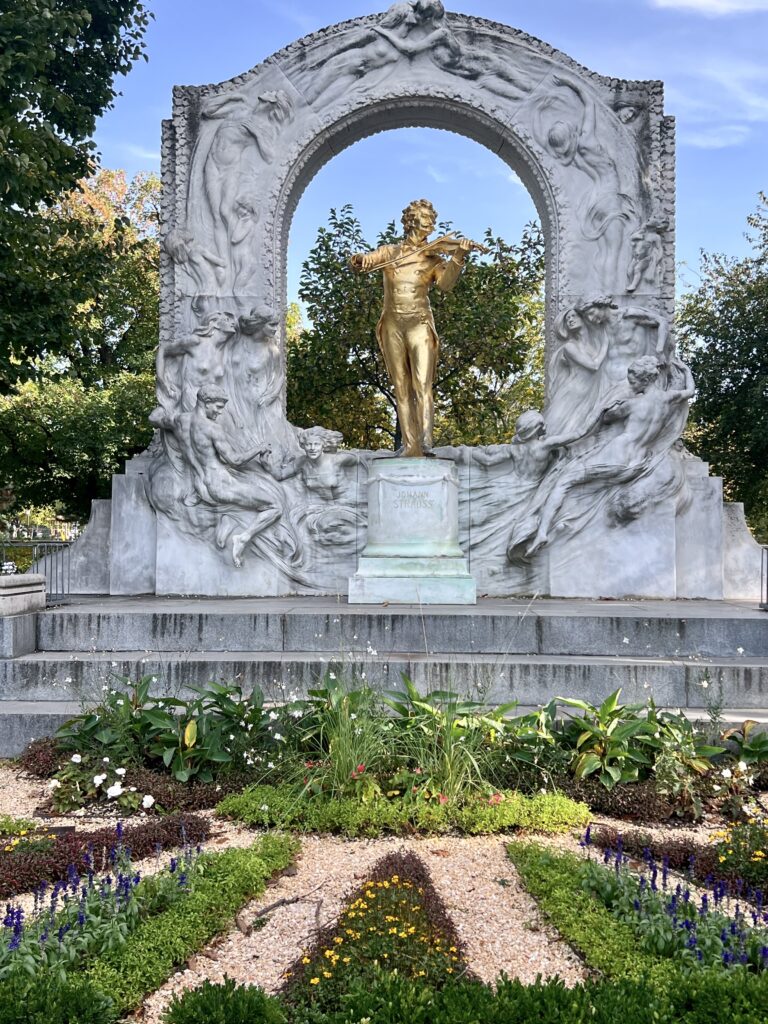
Consider pre-booking the following tickets, tours, and hotel accommodations for your convenience:
- Vienna Pass
- ci ty walking tour
- S chönbrunn Palace Skip-the-Line Tour
- Schönbrunn Palace concert
- food and market tour
- pastry tour
- Danube River cruise
- Palais Coburg
- Hotel Sans Souci Wien
- Grand Ferdinand Hotel
- Hotel Sacher Wien
- Hotel Imperial
- Hotel Indigo
- Hotel Josephine
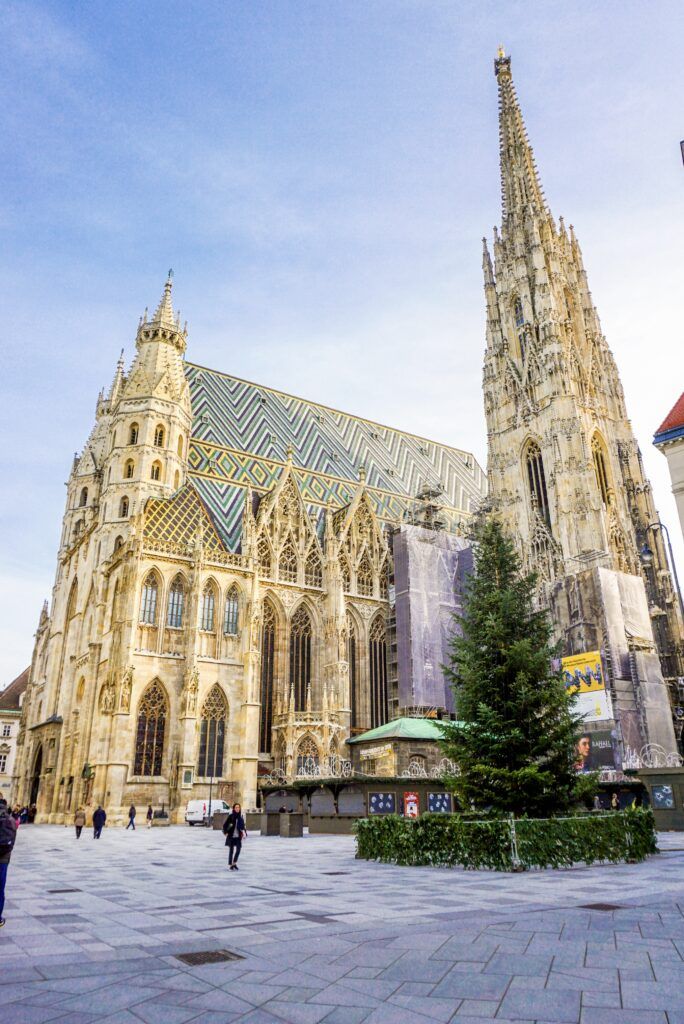
4 Days In Vienna Itinerary
St. stephen’s cathedral.
Begin your Vienna trip with a visit to is most iconic landmark, St. Stephen’s Cathedral. It’s a Gothic masterpiece, with pointed arches and elaborate tracery.
The roof is spectacular. 230,000 glazed tiles form a stunning diamond pattern in vibrant colors.
The interior is equally impressive, showcasing medieval splendor with life-sized statues of saints and biblical figures on each column, many crafted from exotic stones.
The cathedral’s has two towers — the towering 450 foot South Tower with a spiraling staircase and the shorter North Tower with elevator access.
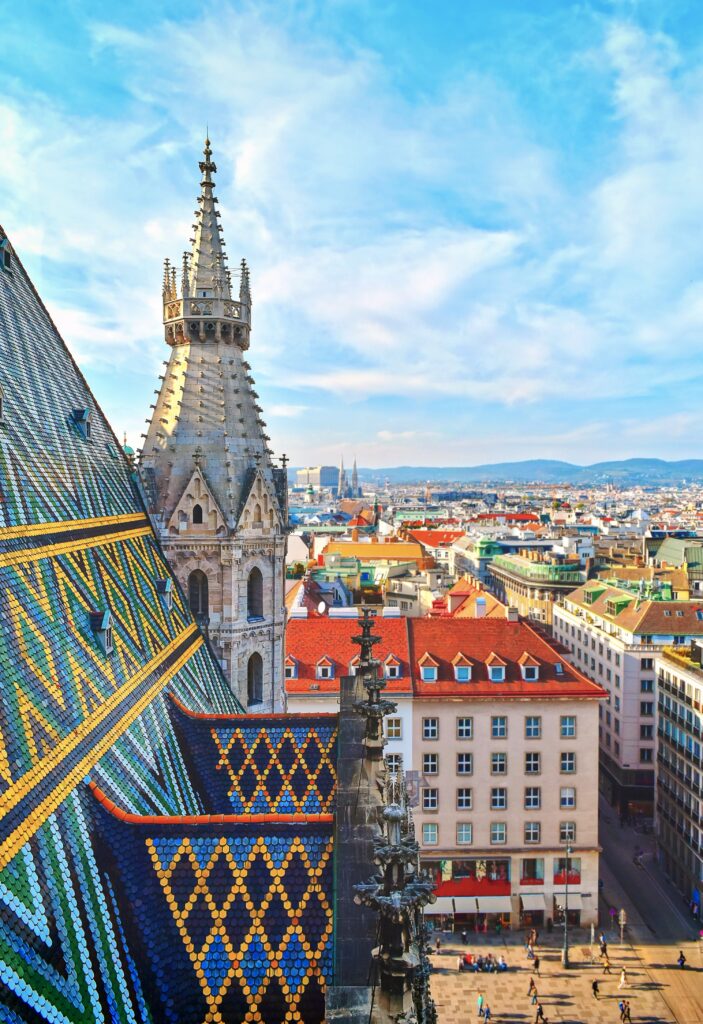
They each offer different perspectives of the city. I’ve experienced both, and each offers a great view. You can’t go wrong.
If time permits, you shouldn’t miss the catacombs. They house the sarcophagi of historical figures like emperors and archbishops.
While a small portion of the cathedral is open for free, purchasing tickets give you the full experience of this historic site.
I recommend pre-booking an all inclusive ticket to see everything and avoid long queues.
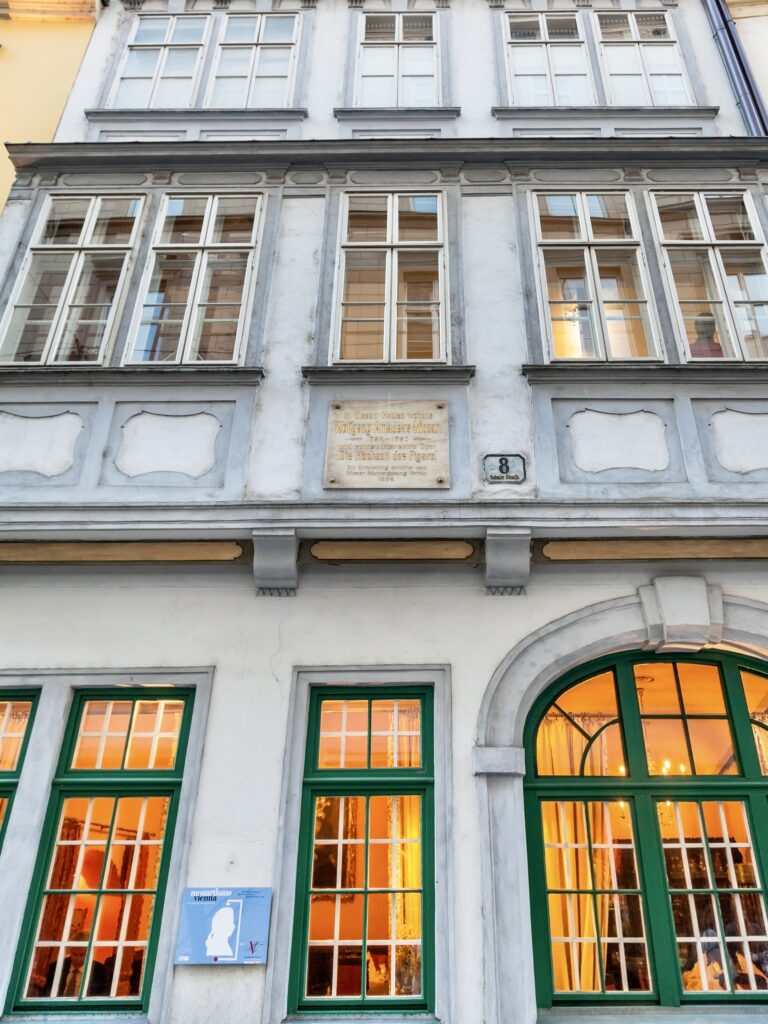
Mozarthaus or Jewish Museum
Vienna’s Mozarthaus is a small museum known as the “Mozart Apartment” or the “Figaro House.” It’s just a few minutes from the cathedral.
The museum’s chief claim to fame is that Mozart lived there for 3 years and it’s his only surviving apartment in Vienna. Mozart composed more music here than anywhere else, including the Marriage of Figaro .
The museum’s exhibits delve into Mozart’s life in Vienna, offering a glimpse into his personal and professional world. There’s not a lot of original things. But I thought it was fascinating to see what a Viennese apartment looked like in the 18th century.
You could also visit the Jewish Museum, which preserves the history and culture of Jewish communities in Austria. Established in 1988, it was the first museum of its kind to reopen in Europe after World War II.
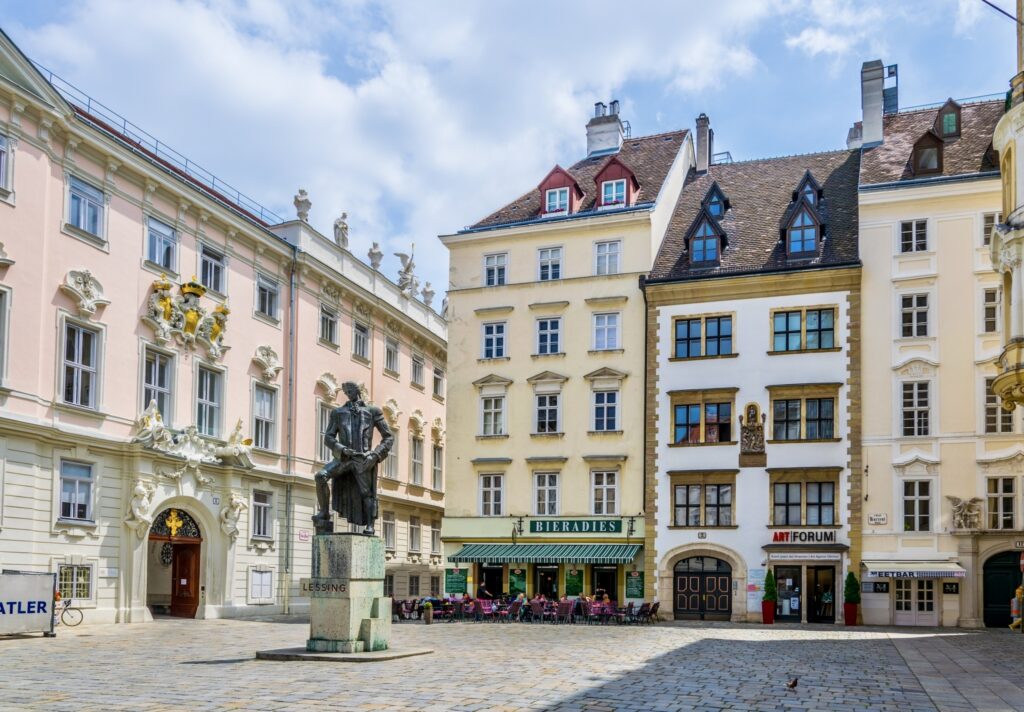
A single ticket covers two locations: the main building in Palais Eskeles and a secondary site at Judenplatz.
At Palais Eskeles, you’ll find permanent exhibitions that chronicle the society and culture of Viennese Jews. The Judenplatz museum focuses on medieval Jewish Vienna and includes the remnants of a 14th century synagogue.
Adjacent to the Judenplatz museum is the Holocaust Memorial, also known as the “Nameless Library.”
Designed by British artist Rachel Whiteread, the memorial looks like a library with its books turned inside out, symbolizing untold Jewish stories due to the atrocities of the Holocaust.
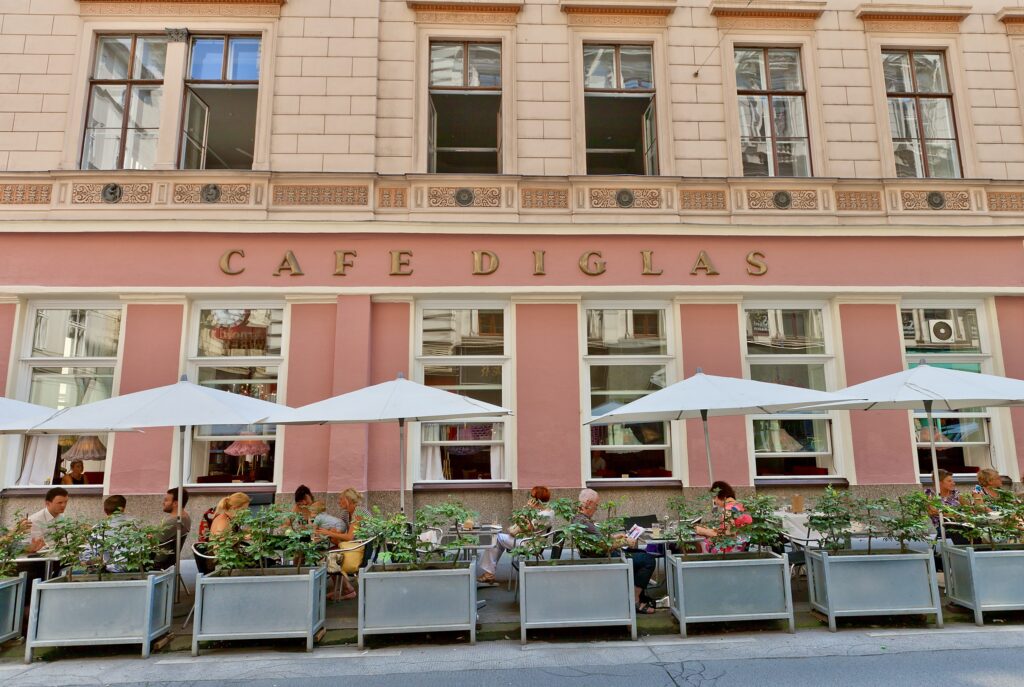
If you want to have lunch in the Jewish Quarter, reserve at the Cafe Landtmann. It’s a historic cafe that’s been round since 1873.
Cafe Diglas is another good, and generally less crowded. Then, head to the imperial palace complex.
Hofburg Palace
Hofburg Palace, the heart of the Habsburg dynasty in Vienna, was more than a royal residence. It was a hub of imperial authority and cultural vibrancy.
This sprawling complex served as the home and government seat for the imperial family, ruling over Europe’s vast territories for centuries. The palace encompasses numerous attractions.
The one most people visit is the building that houses the imperial apartments, the Sisi Museum, and the Silver Collection.
The Neo-Rococo imperial apartments of Emperor Franz Joseph and Empress Sisi boast lavish period decorations, with an abundant use of gold and red.
The Sisi Museum , opened in 2004, offers a stylish tribute to Empress Elisabeth. It has a unique, almost cult-like ambiance.
The palace’s silver collection is a testament to the opulence of the imperial lifestyle, showcasing exquisite tableware and artifacts.
If you like Crown Jewels, I also recommend a visit to the Imperial Treasury , which is part of the Hofburg complex. The museum houses a glittering collection of crown jewels and treasures from centuries of Habsburg rule.
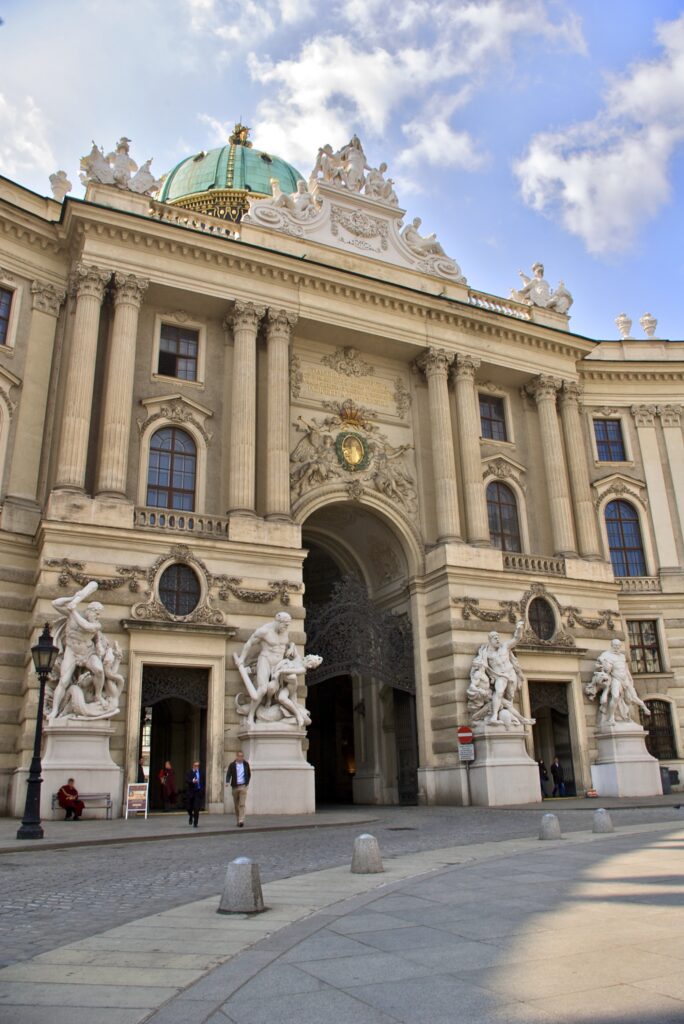
Spanish Riding School
If you’re an equine fan, you may want to visit the Spanish Riding School. It’s a historic equestrian institution, famous for its classical dressage using Lipizzaner horses.
Performances and training exercises are held in the Winter Riding School, a beautiful baroque hall designed by architect Joseph Emanuel Fischer von Erlach.
The school’s 80 minute performances attract visitors from around the world and are booked months in advance.
If you don’t want to sit through a performance, you can still take a peak. It’s possible to watch the horses’ morning exercise sessions without a reservation. They start at 10:00 am.
Tip : If you want to take a coffee break, the lovely cafe Demel is just around the corner.
>>> Click here to book a Lipizzaner performance
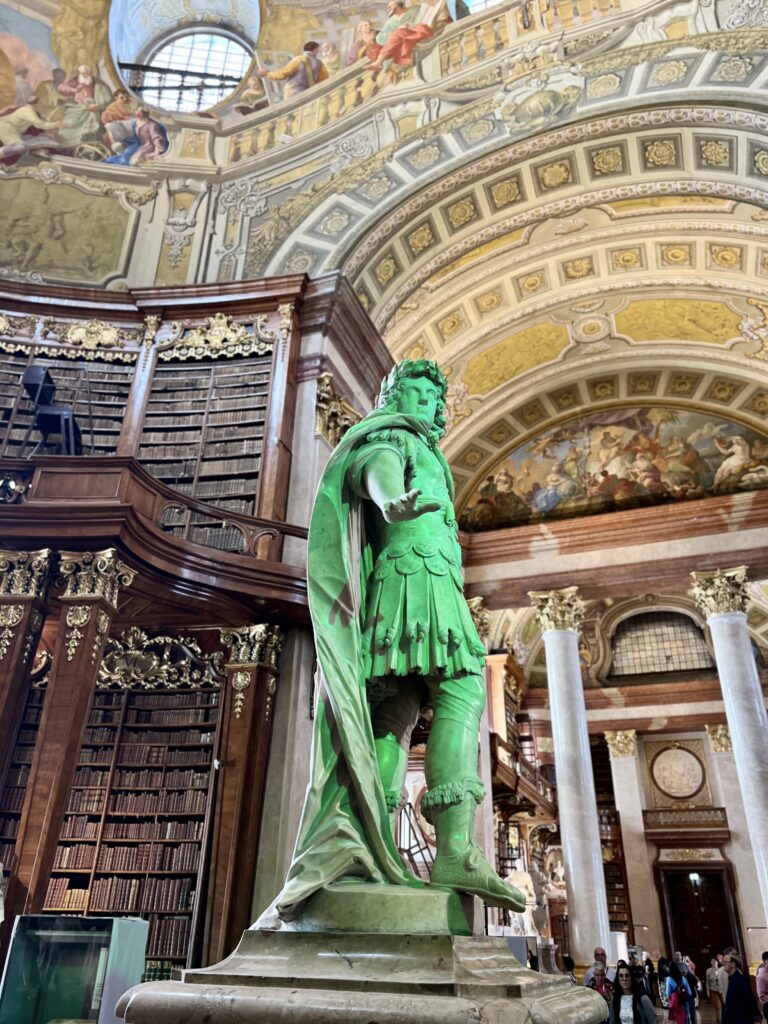
Austrian National Library
The Austrian National Library is not only the largest library in Austria, but also one of the most beautiful historical libraries in the world.
It houses an extensive collection of books and manuscripts, including over 12 million items.
Renowned for its impressive Baroque architecture, the library’s State Hall ( Prunksaal ) is a gorgeous space with magnificent frescoes, sculptures, and an exquisite collection of globes.
This library is a treasure trove for researchers, historians, and book lovers, and a key cultural and educational institution in Austria.
It’s also home to four museums: the Literature Museum, the Papyrus Museum, the Globe Museum, and the Esperanto Museum.
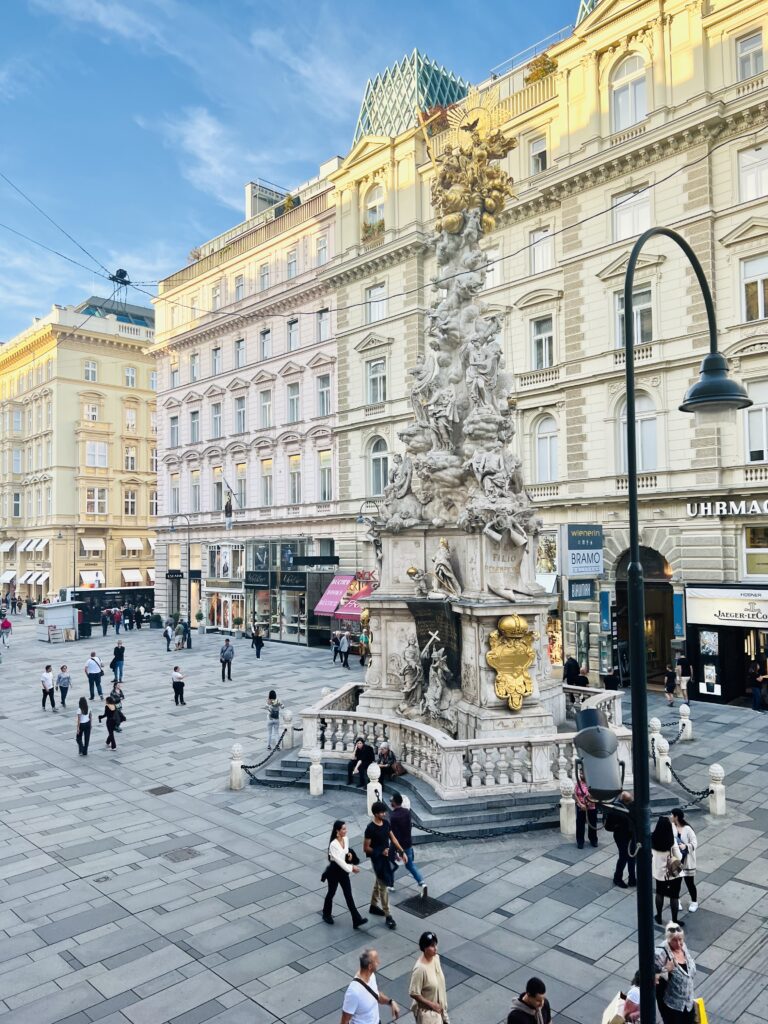
In the evening, take a pre-dinner stroll down Graben Street, one of Vienna’s most famous streets. It’s a pedestrian-only thoroughfare lined with impressive Baroque architecture, luxury shops, and renowned cafes.
Tip : If you pop into Knize, a luxury store from Vienna’s imperial past, you’ll have a great view of Graben from the second floor windows.
For dinner, here are some of my favorite restaurants in Vienna that I can personally recommend. Pick one to try each evening of your visit.
- Gastwirtschaft Praterwirt (2nd district), very light schnitzel
- Nestroy Gastwirtschaft (2nd district), great goulash
- Plachutta (1st district), for a good tafelspitz
- Zum Alten Beisl (10th district), lovely location, amazing food
- Zum Alten Fassl (5th district), cozy spot
- Meixner Gastwirtschaft, (10 district), lovely garden, super schnitzel and amazing zwiebelrostbraten
- Kikko Ba (4th district), Japanese themed snacks and cocktails
- Lola Spanisches (1st district), tapas restaurant with funky cocktails
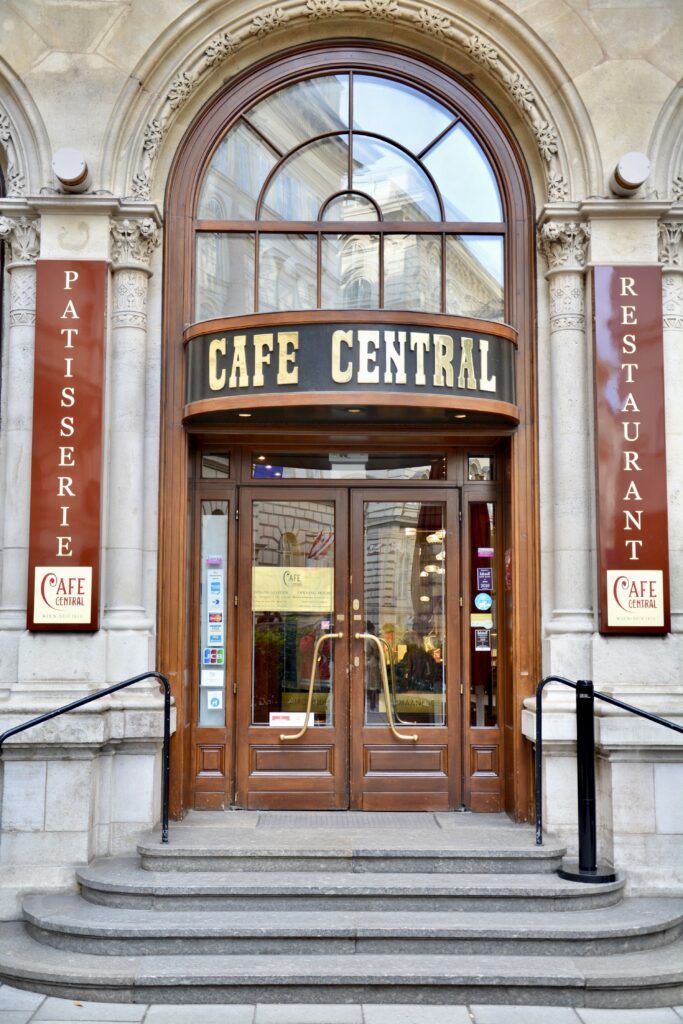
Cafe Central
Start your day off with breakfast at C afe Central . It’s the most famous of Vienna’s coffee houses.
The cafe has a beautiful Neo-Renaissance interior, with arched windows, and elegant chandeliers.
Throughout its history, Cafe Central was a popular meeting place for many of Vienna’s intellectuals, writers, and artists. It was frequented by figures such as Sigmund Freud.
Be sure to make a reservation. Even if you’re going at 7:00 am!
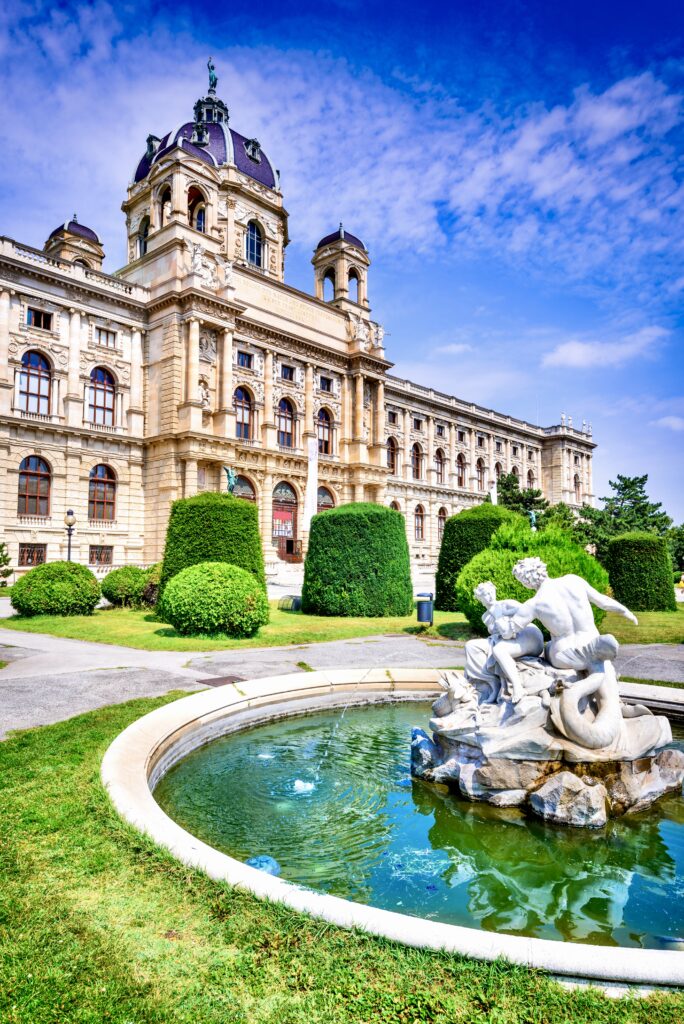
Kunsthistoriches
After breakfast, head to the Kunsthistorisches Museum , which opens at 10:00 am.
It’s Vienna’s premier art destination. The vast museum offers a unique glimpse into the artistic heritage of the Habsburg dynasty.
Visitors are greeted by the opulent marble, murals, and gold leaf in the entrance and hallways.
Spanning three floors with over 100 rooms, the museum displays an impressive array of Italian Renaissance, Flemish, French, Spanish, and German Renaissance art.
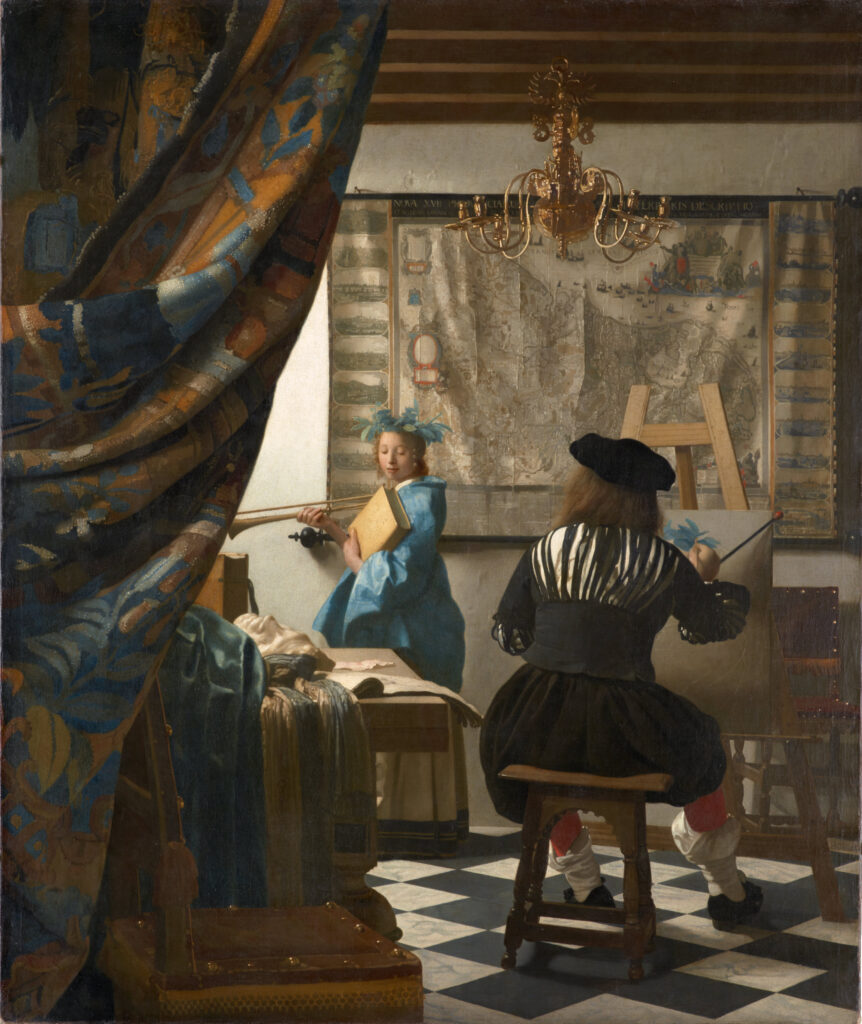
Highlights include works by renowned artists such as Rubens, Titian, Rembrandt, Holbein, Dürer, Caravaggio, and Raphael.
The museum is particularly famous for housing the largest collection of Pieter Bruegel the Elder’s paintings in the world.
You’ll also find Greco-Roman antiquities, an Egyptian collection, and Near Eastern artworks.
Tip : If you prefer natural history to fine art, exactly opposite the square is the Naturhistorisches Museum. You’ll find a menagerie of stuffed animals, dinosaur skeletons, minerals, and Bronze and Iron Age artifacts.
>>> Click here to pre-book a skip the line ticket
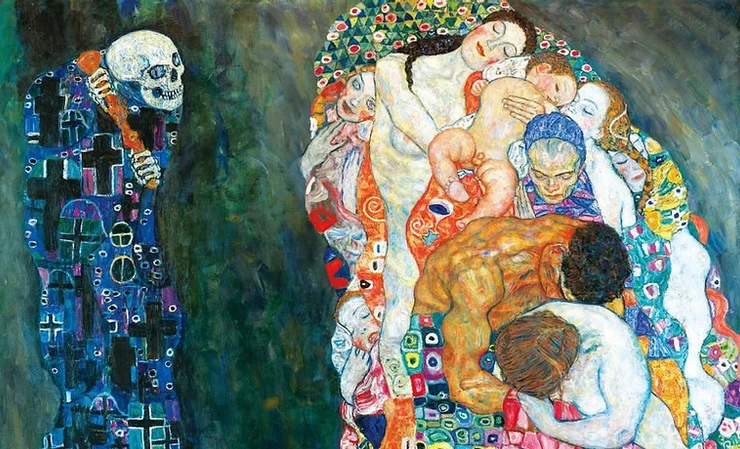
Leopold Museum
Behind the Kunsthistorisches is Vienna’s vaunted Museums Quarter.
Head through the Baroque vaulted entranceway into a central courtyard. It’s an open air cultural venue with cafes, art installations, and galleries.
Of the museums in the quarter, I like the Leopold Museum best. It’s an incredibly well designed museum with a spectacular horde of Judgenstill and Expressionist art.
You’ll find the world’s largest collection of paintings by Egon Schhiele. There are also seminal works by Gustav Klimt, Oscar Kokoschka, and more.
If you prefer contemporary art, you could opt for MUMOK instead. You’ll find works from prominent movements from the 20th century, but also avant garde pieces and performances.
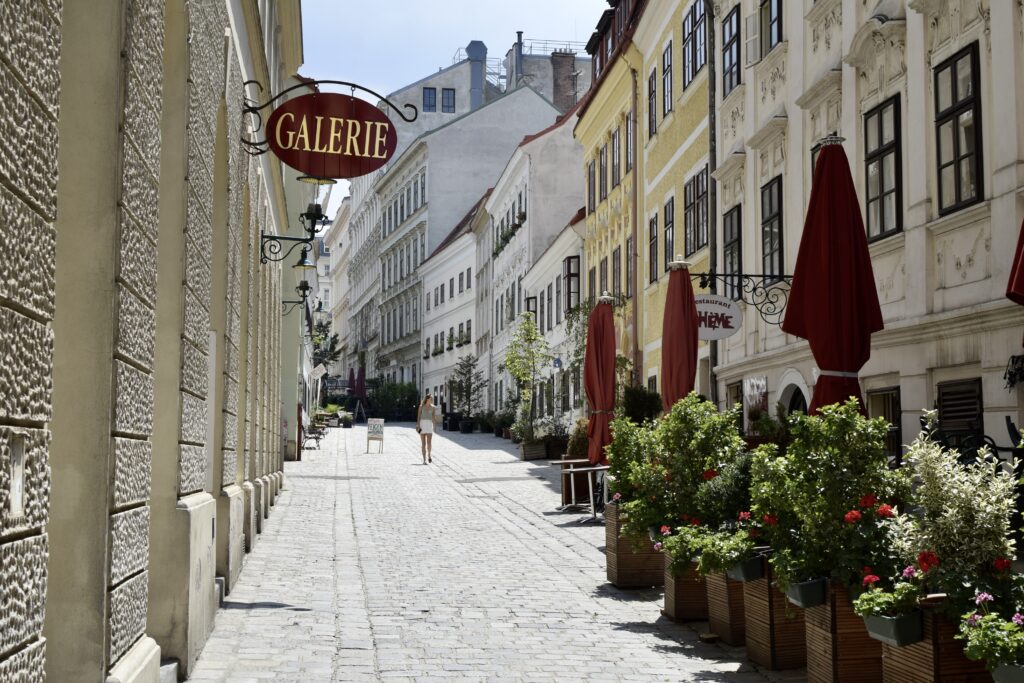
For lunch, the Leopold Museum has an excellent cafe with beautiful decor. Another good restaurant spot in this area is Milo.
You could also lunch is the Spittelberg neighborhood near Museum Quarter. This is a quaint charming area with cobbled streets that has barely changed since the 18th century.
You’ll find cozy Viennese coffeehouses, stylish bistros, and beer gardens.
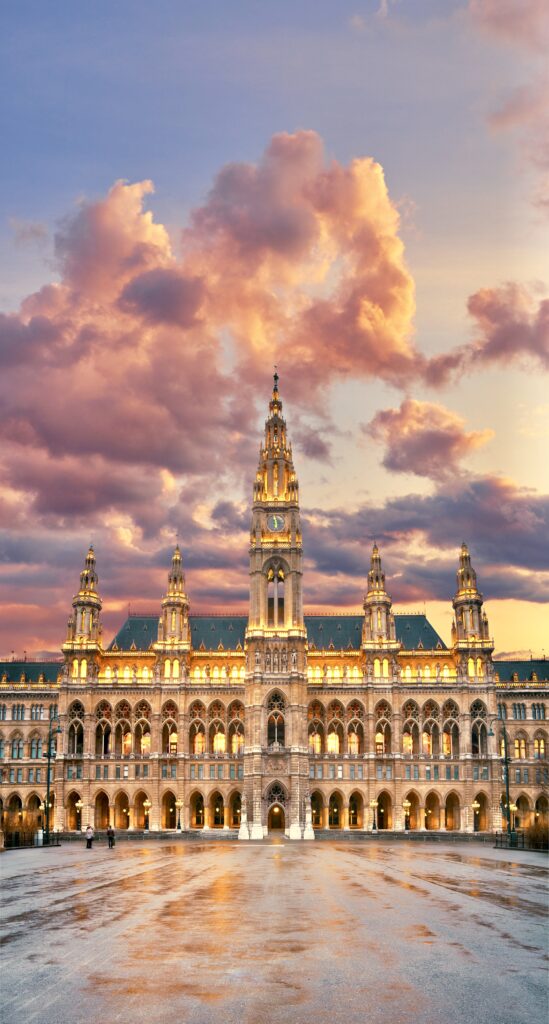
After lunch, take a stroll along the Ringstrasse. Ogle he Austrian parliament Building, the Rathaus, the Burgtheater, and the University.
The Vienna Rathaus is a striking, and massive, example of Neo-Gothic architecture. The handsome facade is capped by five stone towers, the largest of which is 325 feet tall.
The Rathaus serves as the seat of both the mayor and city council of Vienna. In the winter, it hosts a smashing Christmas market and ice skating rink.
Tip : You can only tour the Rathaus at 1:00 pm on Monday, Wednesday, and Friday.
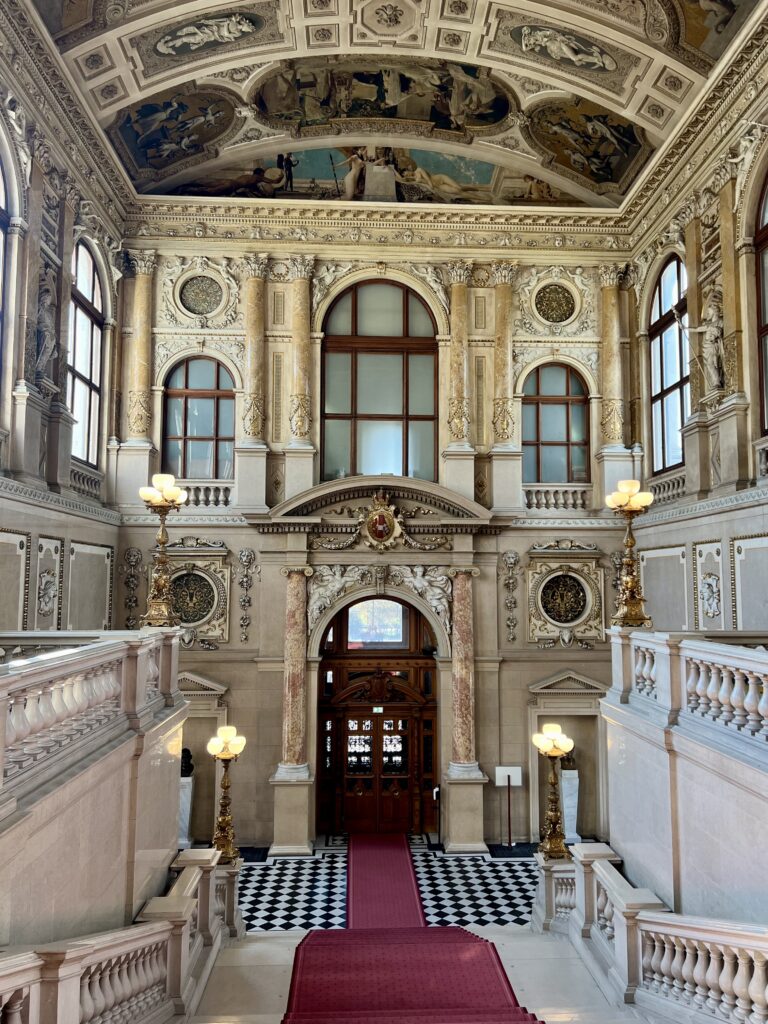
Burgtheater
Directly opposite the Rathaus is the elegant facade of the Burgtheater. It was build in the 1880s to house Vienna’s premiere theater company.
The most impressive features of this remarkable building are the two huge entrance halls on either side of the auditorium. Both are decorated with frescos painted by Gustav Klimt and his brother.
If you want to take a tour of the Burghtheater, check the website .
Most of the tours are in German, with English tours in the summer. But I just went on a tour in October where the guide spoke in both German and English.
Tip : Across from the Burgtheater is the beautiful Church of the Minorites.
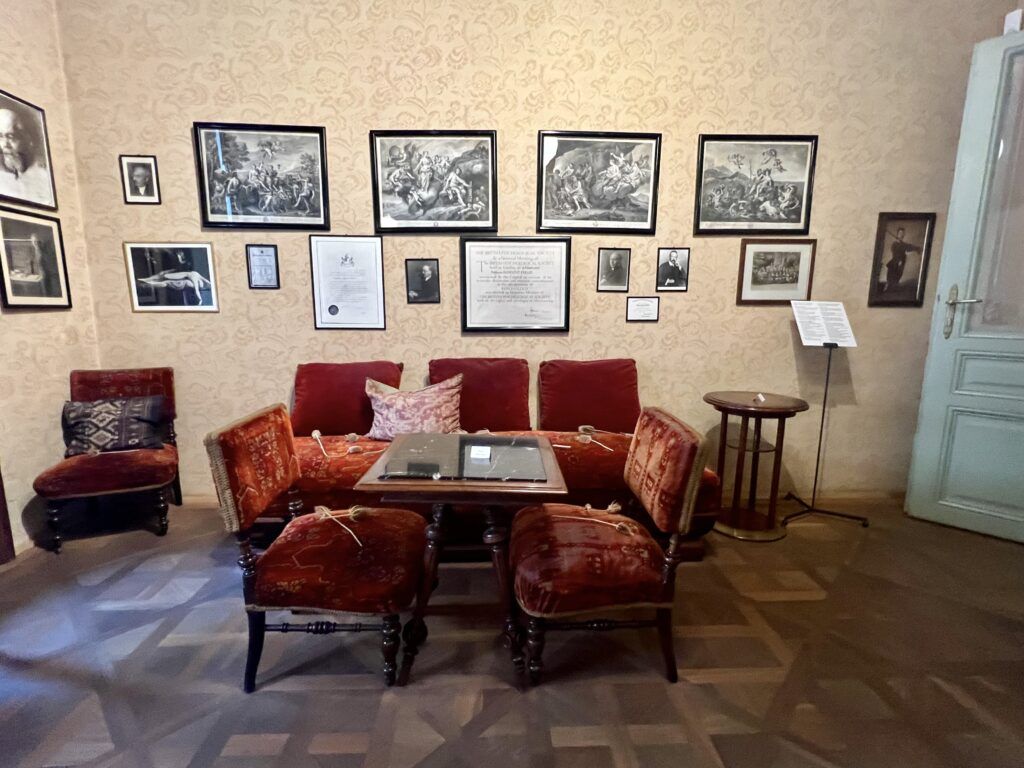
Freud Museum
Next, those with an interest in psychology should head to the Freud Museum . It’s 15 minute walk from the Burgtheater.
The museums gives you an insightful look into the life of Sigmund Freud, known as the founding father of psychoanalysis.
Freud lived and worked here for 47 years before he left in 1938 due to Nazi occupation. The museum allows visitors to explore his personal life and famous practice.
The museum was recently expanded and renovated over 18 months to the tune of $4 million, re-opening in 2020. Each room has information panels on history of the room itself and display cases on psychoanalysis.
>>> Click here to book a skip the line ticket
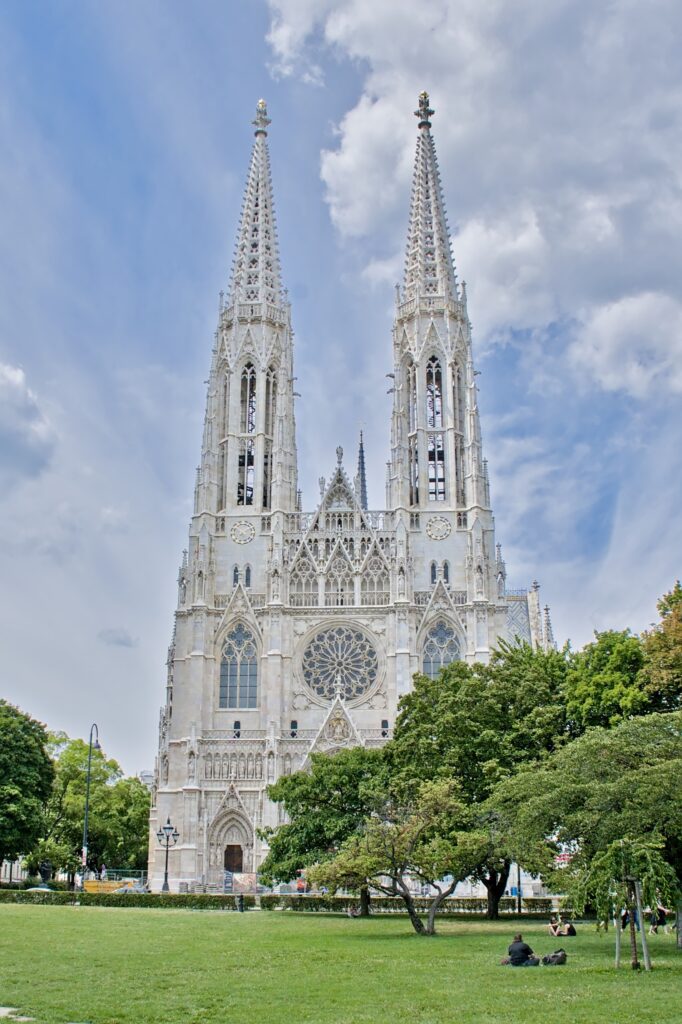
Votivekirche
While you’re in the area, take a look at the Votive Church. It was designed in the 1860s by the historicist architect Henrich von Ferstel.
The facade features two soaring, symmetrical towers that stretch towards the sky.
Inside, the church maintains a traditional Gothic design. It’s adorned with a towering vaulted ceiling, vivid stained glass windows, and an intricately designed high altar.
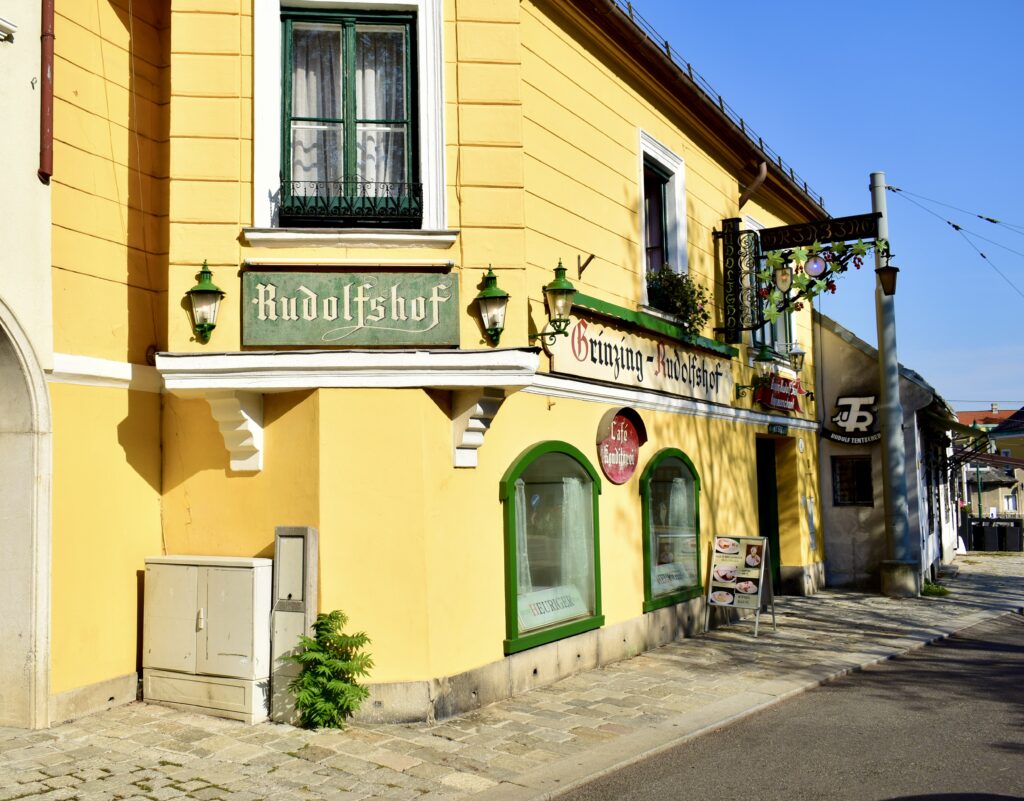
In the evening, head out to the wine gardens in Vienna, which are primarily located in the 19th district of the city, which is called Döbling.
Döbling is well-known for its picturesque vineyards and wine taverns, known as “Heuriger” in German.
These Heuriger establishments offer locally produced wine, traditional Austrian food, and a relaxing atmosphere for visitors to enjoy. Döbling’s hilly terrain and favorable climate make it suitable for vineyard cultivation, and it has a long history of winemaking.
My personal favorite is Heuriher Kierlinge.
Vienna Secession
Begin day 3 with a visit to the Vienna Secession Museum . It opens at 10:00 am and doesn’t take too long to explore.
The building itself is an iconic representation of Vienna’s Jugendstil, marking the turn of the century with artistic flair.
It’s celebrated for housing Gustav Klimt’s renowned Beethoven Frieze , a masterpiece of gilded Art Nouveau.
The frieze is displayed in a climate-controlled gallery in the basement. Klimt intended it as a symbolic interpretation of Beethoven’s Ninth Symphony, celebrated for its intricate design and thematic depth.
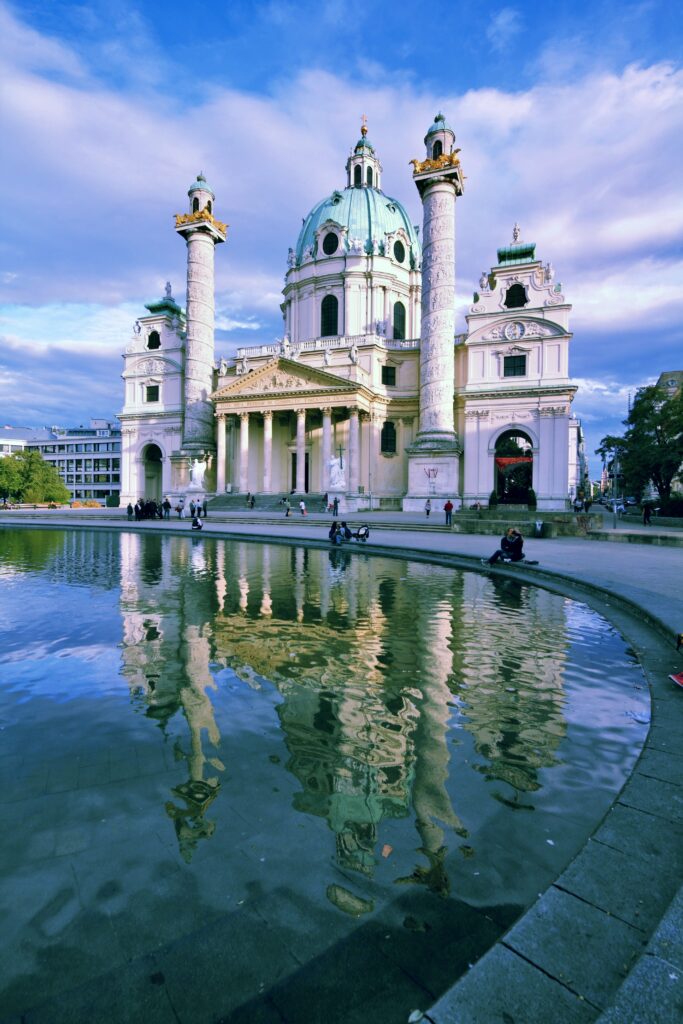
Karlskirsche
St. Charles Church is the most spectacular Baroque church in Vienna. Designed by Johannn Fischer von Erlach, the facade combines Baroque and Classical styles. The portico, flanked by Trajan-esque columns makes it seem like a Greek temple.
The church is dedicated to St. Carlo Borromeo. But it was really intended to venerate Emperor Karl VI.
Inside, you’ll find an exuberant interior featuring almost endless pastel marble and gold leaf. There is a fine illusionist ceiling fresco by Johann Rootmayr.
You can climb the tower for panoramic views and, along the way, check out the massive organ.
Tip : Keep in mind that the church isn’t free and it only accepts cash for admission, not credit cards.
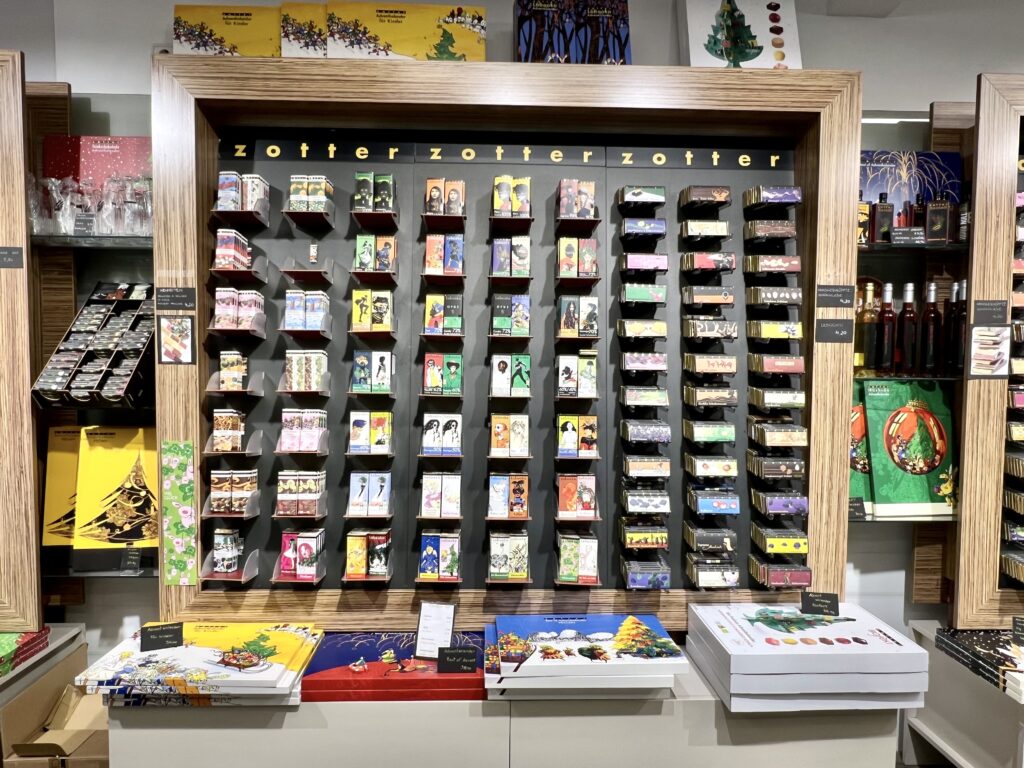
Lunch at Naschmarkt
The nearby Naschmarkt, dating back to the 16th century, is the perfect lunch spot. Stalls are piled high with breads, fish, meats, cheeses, and spices.
There are numerous small eateries and cafes that serve all manner of international cuisine, from Turkish kebabs to Japanese sushi.
>>> Click here to book a food tasting tour at the Naschmarkt
In this area, you could also have lunch at Cafe Sperl. It’s a quintessential Viennese coffee house, rich in history and tradition.
The cafe is famous for its classic Viennese interior with elegant chandeliers, marble-topped tables, polished wooden paneling, and comfortable velvet seating
Tip : If you are a fan of Art Nouveau, take a mini detour to the Otto Wagner designed Majolikahaus. The facade is completely covered in glazed ceramic to create flowing floral motifs.
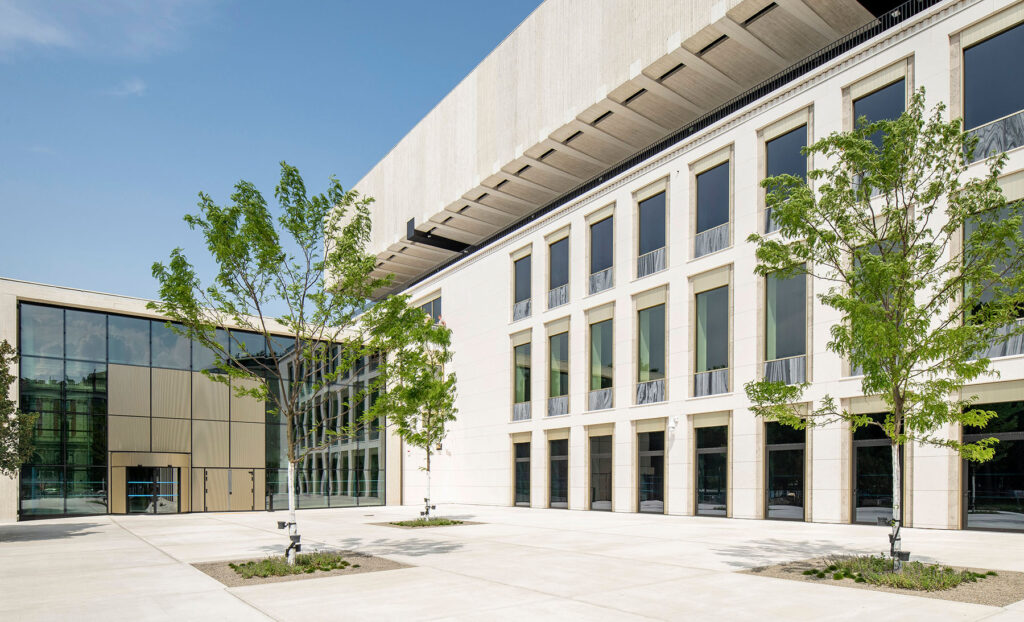
Wien Museum
At the east end of Karlplatz Square is the Wie n Museum . It’s kind of a combination art and history museum.
It’s housed in a light, modern building, which was just fully renovated and expanded. Exhibitions trace the history of the city from pre-Roman times to the present day.
The key permanent exhibit is Vienna 1900, with works from Art Nouveau and Expressionist artists Gustav Klimt, Egon Schiele, and Richard Gerstl.
The museum also hosts temporary exhibitions, drawing on its vast archives.
Tip : Admission is free for this museum.
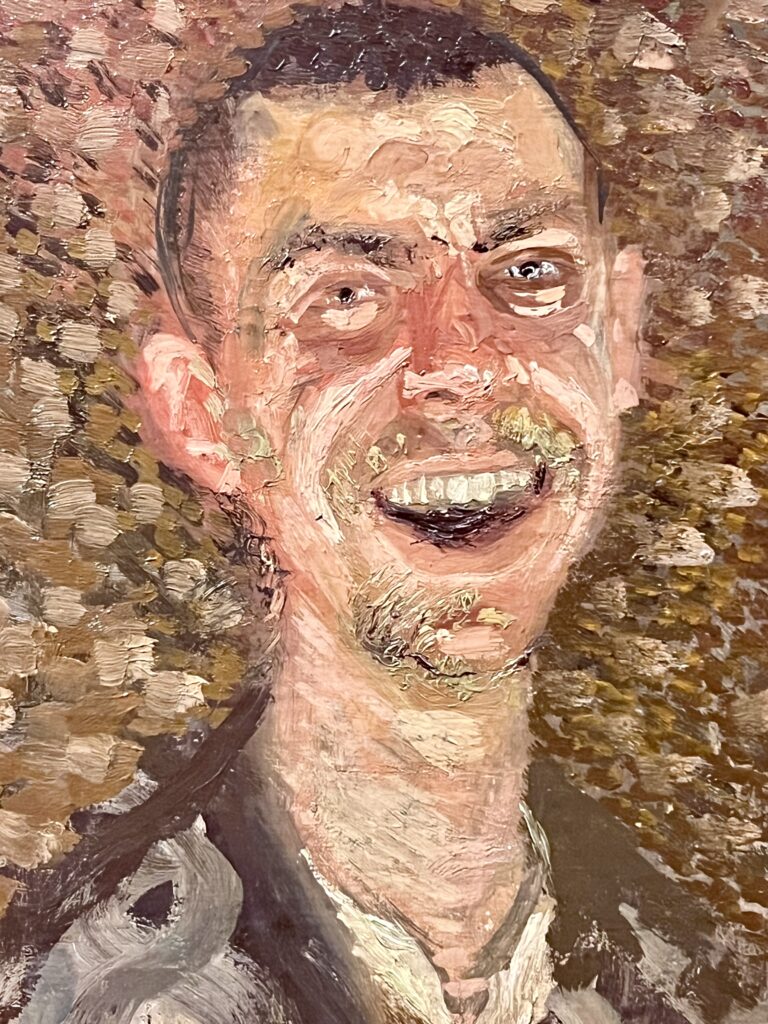
Belvedere Palace
The Belvedere Palace , a UNESCO site, is celebrated for its extravagant architectural beauty and manicured gardens.
This palace is a treasure trove of Baroque art and Austrian masterpieces from the 19th and 20th centuries. Its most famous for its extensive collection of Gustav Klimt’s paintings, including the iconic The Kiss .
The Belvedere complex consists of two distinct buildings, the Upper and Lower Belvedere, connected by a splendid 18th century formal garden.
In addition to Klimt’s works, the palace houses significant pieces by Egon Schiele and Oskar Kokoschka, who are key figures in Expressionist art, as well as earlier examples of Historicism.
Unless it’s off season, you’ll want to pre-book a timed entry skip the line ticket . To dig deep, you can also book a guided tour of the entire palace .
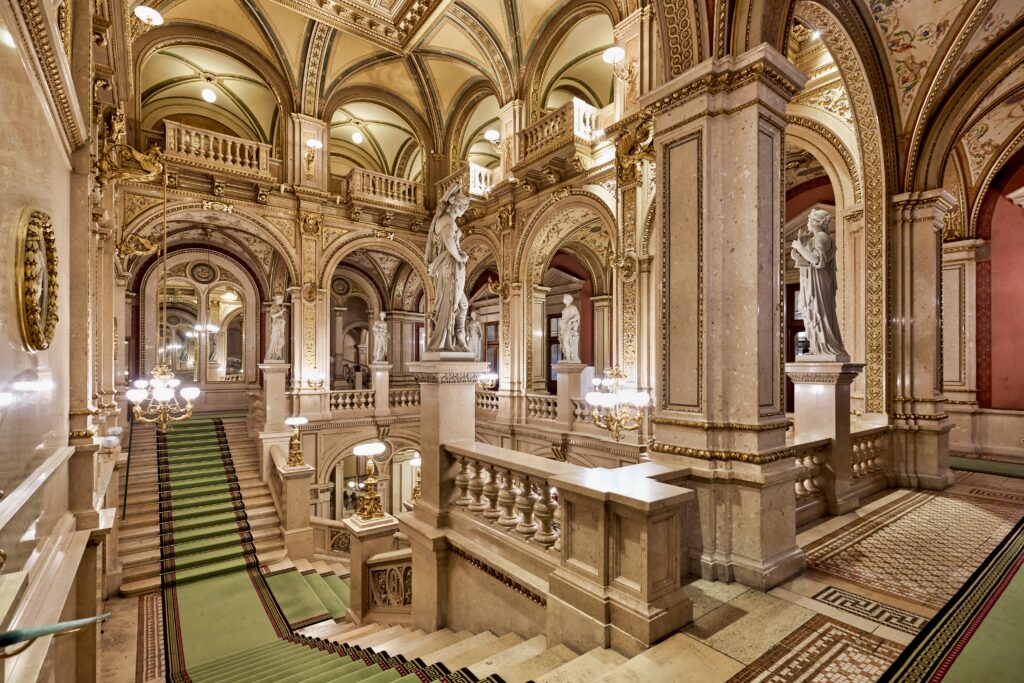
Evening: Staatsoper
The Vienna National Opera is one of the city’s most renowned cultural institutions.
It’s a grand Neo-Renaissance building. The centerpiece of the facade is a loggia adorned with busts of famous composers like Mozart, Verdi, and Beethoven.
Inside, it’s beyond opulent. A grand staircase leads up to the auditorium, with crystal chandeliers, decorative frescoes, and lots of red velvet.
You can take a guided tour of the opera house during the day, of course. But for the full experience, I suggest taking in a show. I recently saw Puccini’s Tosca and it was amazing!
Tickets are pretty pricey. And you’ll need to book well in advance to secure a seat.
Tip : The Staatsoper does offer standing room only tickets. You’ll have to queue up an hour or so in advance of the show.
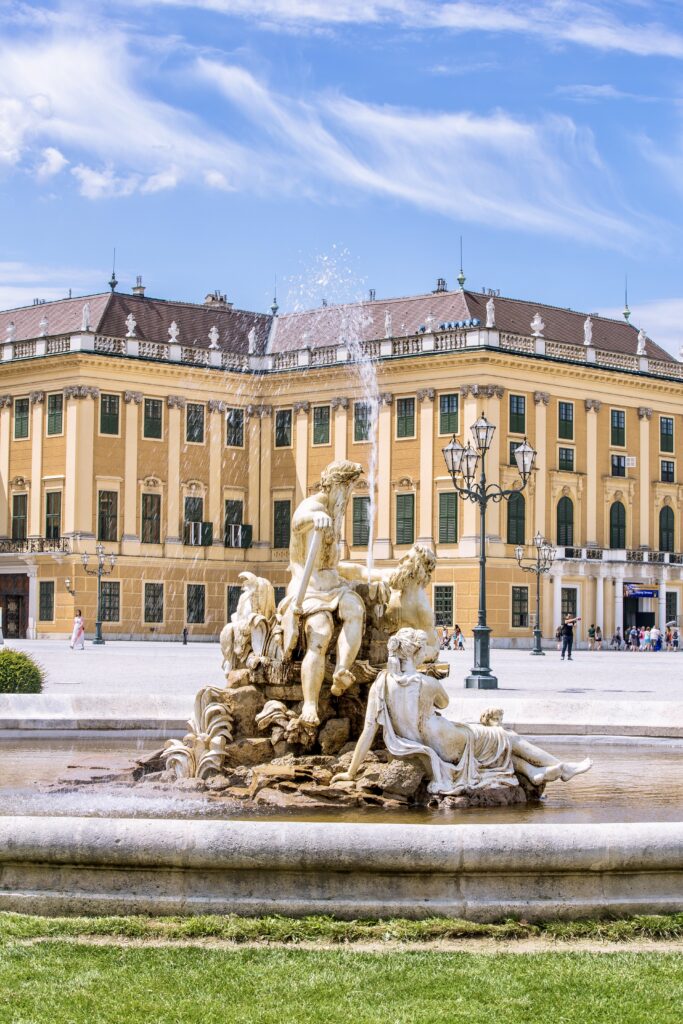
Schönbrunn Palace
In a city filled with aristocratic extravagance, the royal family had to make an extraordinary effort to impress everyone. With Schönbrunn Palace , no one could doubt the supreme wealth or power of the occupants.
The sheer size of the mustard colored palace is astonishing. It boasts one of the finest Rococo interiors in Europe, as well as extensive gardens.
You have to book a guided tour online to see the lavishly decorated imperial apartments. You can choose between the Grand Tour, the Imperial Tour, or the State Apartments tour.
For ease, or if tickets on the website are sold out, you can also book a skip the line tour on Viator or Get Your Guide . Another popular option is to book an after hours tour with dinner and a concert.
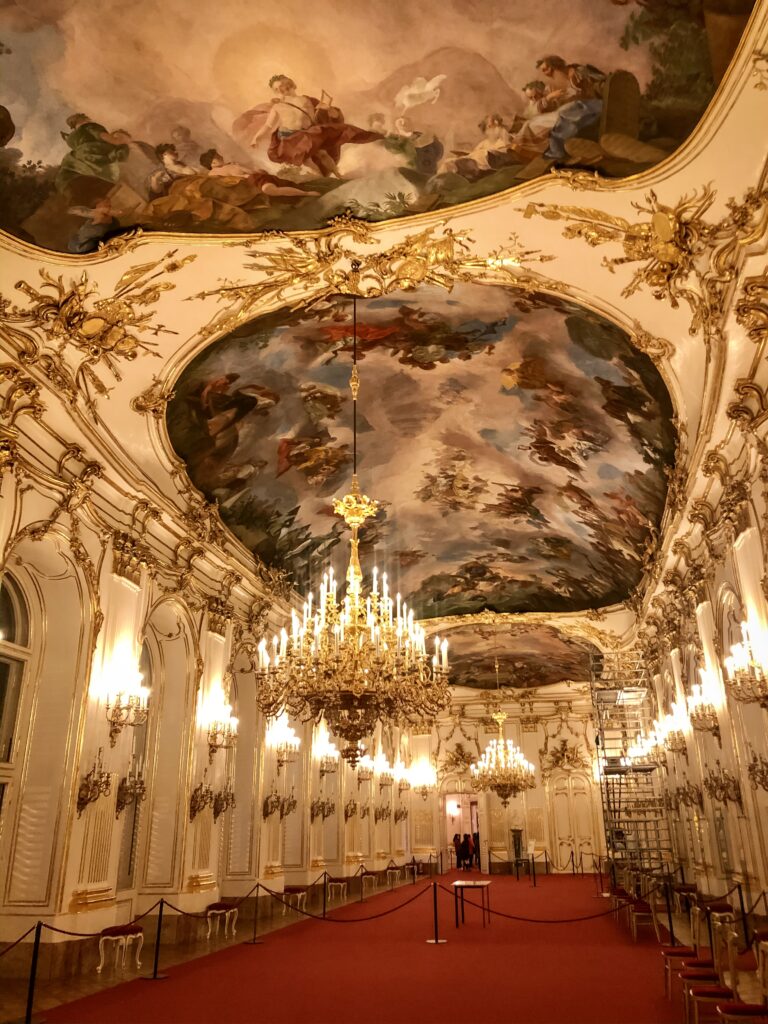
The Grand Tour is the most extensive. You’ll get to see the entire piano nobile , including the Great Gallery and the spectacular Hall of Mirrors where a 6 year old Mozart once played for the empress.
The Schönbrunn Gardens can’t be missed either. Over 160 acres, there are formal Baroque gardens, pavilions, grottos, fountains, and architectural follies.
You may want to stop for lunch at the Palmenhaus. It’s an impression iron and glass building constructed in 1882 with a brasserie.
Tip : To get to the palace from central Vienna, take the U4 (green line) of the U-Bahn (metro) and get off at the Schönbrunn stop. From there, it’s a short walk.
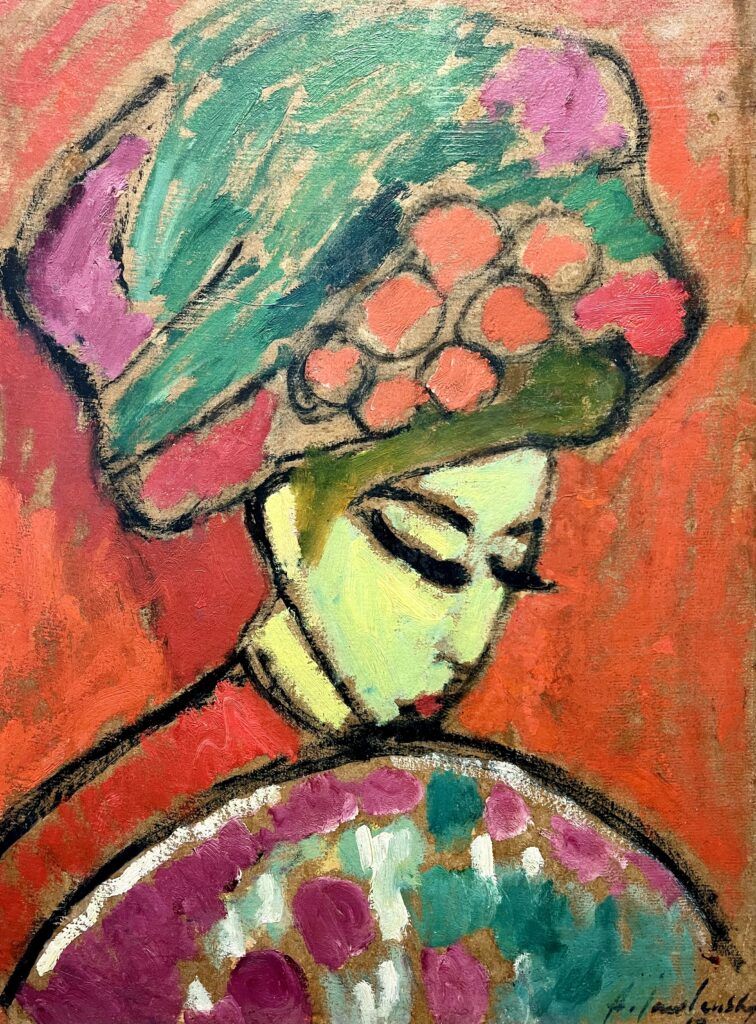
Albertina Museum or House of Music
In the afternoon after your Schönbrunn visit, head to the wonderful Albertina Museum or the House of Music . You might have time for both. The House of Music is open until 10:00 pm.
The Albertina is a pivotal cultural hub, showcasing a fantastic array of graphic art and early Modernist works. It collection of drawings include masterpieces from artists like Michelangelo, Raphael, and Albrecht Dürer.
The Albertina is also celebrated for its European paintings and sculptures from the late 19th to the mid-20th century.
They feature eminent artists such as Claude Monet, Pierre-Auguste Renoir, Vincent van Gogh, Marc Chagall, and Pablo Picasso.
>>> Click here to pre-book a ticket
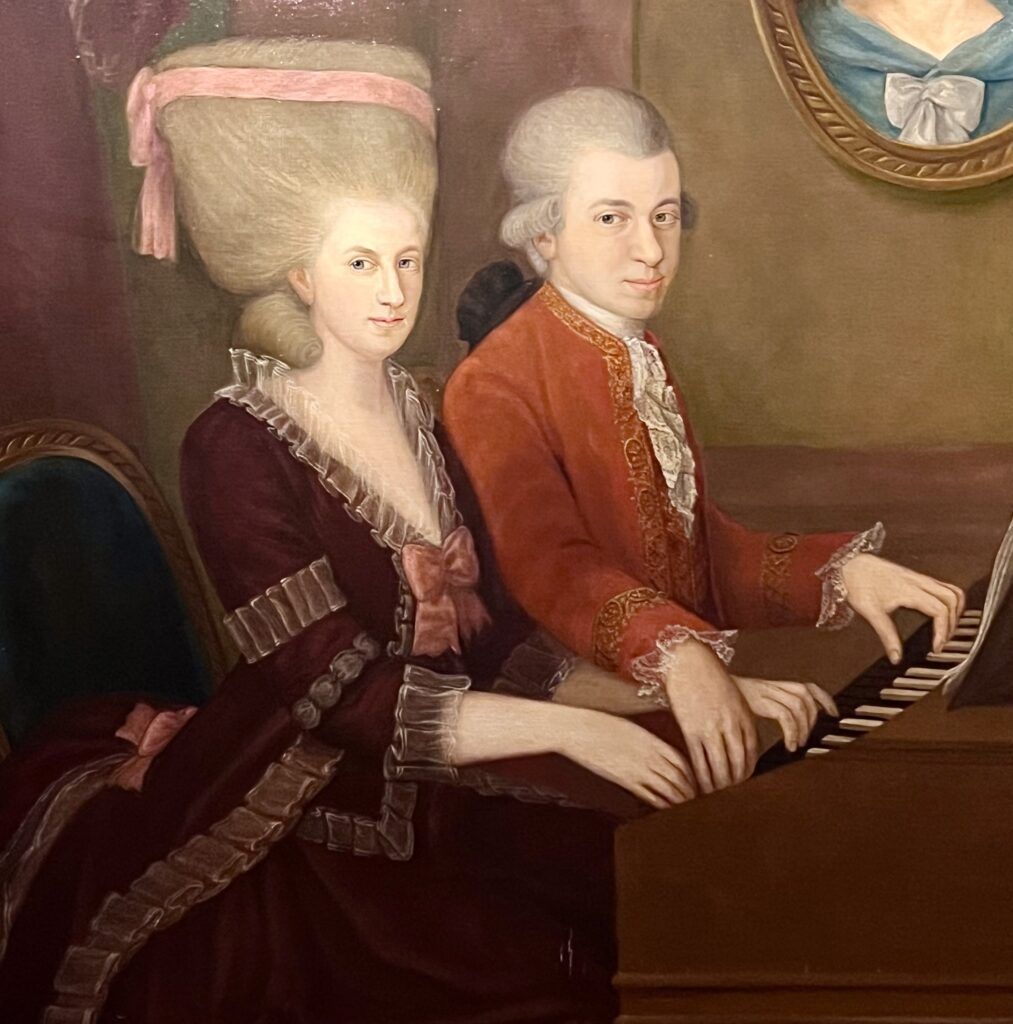
The House of Music offers an engaging and interactive journey into the world of music.
Established in 2000, this museum appeals to both children and adults. It aims to deepen the appreciation and understanding of music through hands-on experiences.
Featuring interactive and sensory displays, the museum brings the science and emotion of music to life. Visitors have the opportunity to create their own waltz, experiment with different pitches and sounds, and explore various musical instruments.
My favorite part was the sections dedicated to the “great composers,” where visitors can immerse themselves in the lives and music of Haydn, Mozart, and Beethoven.
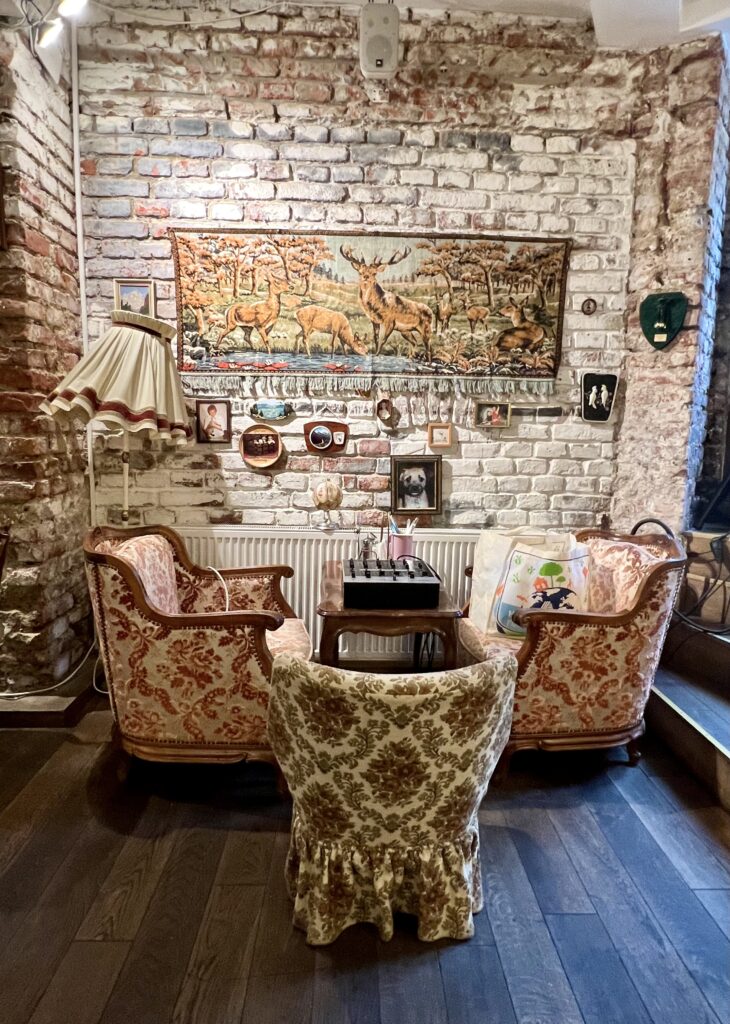
Evening: Food Tour
In the evening, try one of the restaurants I listed above or head out on a guided good tour.
I took this evening pastry tour and loved it. We used the metro to go to different districts in Vienna.
We had everything from apple strudel to goulash. And stopped in an adorable cafe, much less formal than most, called Vollpension.
Alternatively, other good evening options include attending a Vivaldi concert at Karlskirche or taking a sightseeing cruise on the Danube .
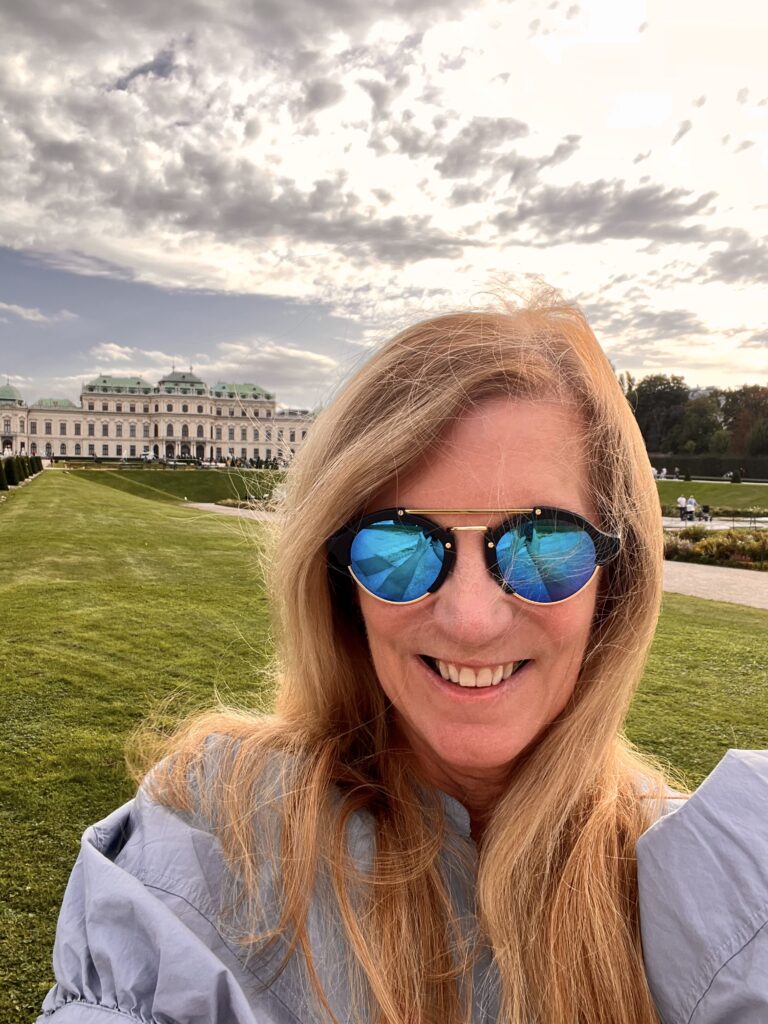
I hope you’ve enjoyed my 4 days in Vienna itinerary. You may enjoy these other Vienna travel guides and resources:
- 1 Day in Vienna Itinerary
- 3 Days in Vienna Itinerary
- Best Museums in Vienna
- Beautiful Churches in Vienna
- Beethoven Guide To Vienna
- Klimt Guide To Vienna
- Things To Do in Vienna in Winter
- Guide To the MAK Museum
- What To Do in the Wachau Valley
Pin it for later.
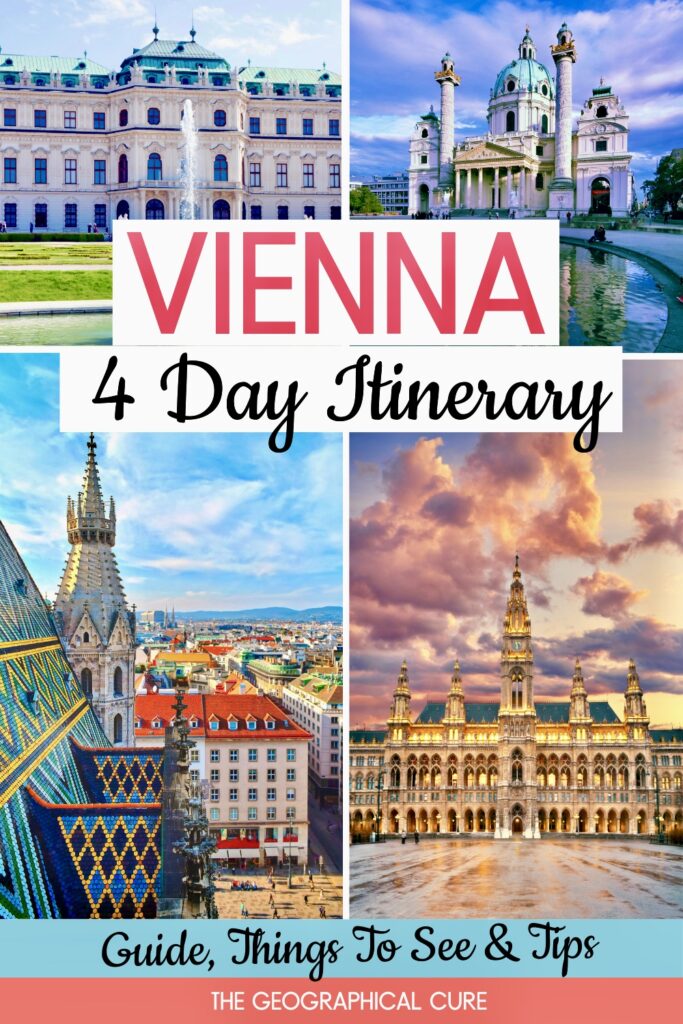
Leave a Comment Cancel reply
Save my name, email, and website in this browser for the next time I comment.
Last Updated on January 20, 2024 by Leslie Livingston
- NORTH AMERICA
- Thoughtful Travel
3 Days in Vienna Itinerary: A Perfect Vienna Trip for the Summer

Planning a trip to Vienna and feeling overwhelmed? Then this 3 days in Vienna itinerary is the perfect one for you! From where to stay, to what to see and where to eat, it’s all here!
From the moment I stepped onto the tram in Vienna, I was hooked.
The city is an intoxicating mix of imperial grandeur and vibrant modern life, with echoing melodies of Mozart and Beethoven mingling with multi-lingual chatter on every street corner.
Vienna is a literal feast for the senses. I listened to incredible music, gorged on divine cake, and sampled some of the most delicious wines the country has to offer. And don’t even get me started on the coffee!
From the morning bustle of the coffee houses (Kaffeehäuser) to the soothing hum of evening Viennese wine taverns (Heurigen), the city pulsates with contagious energy.
In this 3 day Vienna itinerary, you’ll wander through ornate palaces and museums chock-full of masterpieces. Admire Klimt’s genius, marvel at the architectural wonders of the Baroque era and spend an evening at Vienna’s famous opera house, a nod to the city’s rich cultural heritage.
Through it all, you’ll be following in the footsteps of the Hapsburgs, the historic rulers of the Austro-Hungarian Empire whose legacy is etched into the fabric of Vienna.
Ready to unwrap the layers of this fascinating city? Then let’s get cracking with this 3 day itinerary guiding you through the heart of Vienna.

VIENNA ESSENTIALS
Currency : Euro €
Language : German
Money : Most places will take cards, but this is very much a city with a cash economy, so always have some on hand.
Visit in : spring, late summer and fall
Transport : excellent public transport system of trams, metro and trains
Best for : Foodies, wine lovers, history and art fans!
4. A Night at the Opera
4. vienna by night, 5. belvedere austrian gallery, 4. book restaurants in advance, single-day vienna itinerary ideas, take a day trip from vienna, is vienna safe for solo female travel.
The features in this post were hand-selected by a picky diva (that’s me) and some of them are affiliate links. If you buy via these, I may earn a commission on some of these awesome recommendations at no extra cost to you. Thanks for your wonderful support – Cat.
3 Days in Vienna Itinerary
Who this 3 day vienna itinerary is for.
I mean, obviously, I’d love to say that this Vienna itinerary is perfect for everyone, but you actually can’t please all of the people all of the time. The last thing I want is for you to use my itineraries and feel disappointed. So I want to make sure that this Vienna itinerary will suit you!
IS THIS 3 DAY VIENNA ITINERARY FOR YOU? | I think this itinerary is for first-time Vienna visitors who love food, wine and art . It’s perfect for singles, couples and small groups. Families with younger children may not find it suitable for them.
This itinerary for Vienna in 3 days was something I created for myself while I was on my Budapest, Vienna and Prague trip . The entire visit was focused on trying to understand the fascinating history and culture of this part of the world.
I wanted to get a better idea of what the Austro-Hungarian Empire was all about – to see how it influenced the art and architecture of the region and what impact the aftermath of WW2 and the division of Europe into East and West had here.
With that in mind, this Vienna itinerary focuses on visiting sights that were important in the dying days of the Empire, tasting the food and wine of the region, meeting local people and learning about life in Vienna today.
If you’re a solo female traveller who loves food and wine, history, culture and art, then this Vienna itinerary was made for you because it was made for me!

Where to stay for 3 Days in Vienna
Where To Stay | I stayed at and highly recommend 25hours Museum Quarter . This cool hotel with an awesome rooftop bar is close to public transport links, all the museums and just a short walk to Vienna’s city centre. I know it’s a great place to stay to do this Vienna itinerary because it’s where I made it! Check availability and book here .
For other options, read my guide to the best hotels to stay in Vienna for a short trip (coming soon).
Vienna Itinerary for 3 Days at a Glance
Vienna Itinerary Day 1: Walking tour, Schönnbrunn Palace, Vienna Opera
Orient yourself to the main attractions in Vienna by starting your Vienna itinerary with a great walking tour on your first day. Head to Schönbrunn Palace to learn more about the Imperial Hapsburg dynasty in the afternoon. In the evening, enjoy the most quintessential of Viennese experiences – a night at the opera!
Vienna Itinerary Day 2: Food tour, St Stephen’s Cathedral & Tower, Vienna by Night
This is a literal taste of Vienna, with an incredible food tour that lasts most of the day. Work off your day of indulgence by heading up the tower of Stephansdom in the late afternoon before enjoying the sights of Vienna at night.
Vienna Itinerary Day 3: Hofburg Palace & Sisi Museum, Vienna Heuriger/Winery, Kunsthistorisches Museum
Break up a day of museums with a trip out to a Vienna you didn’t know existed. In summer, venture up onto the hillsides overlooking Vienna to taste the new season wines. During the rest of the year, experience the traditional wine tavern culture in Vienna’s countryside.
Vienna Itinerary for 3 Days: Day 1 Imperial Vienna
Trying to see the best of Vienna in 3 days isn’t easy, so today you’re going to have a crash course on Vienna and the Hapsburg Dynasty that shaped much of modern Europe. I recommend booking all of today’s activities in advance so that you can be sure of what time you need to be where!
1. Breakfast at Joseph Brot
Let’s kick this Vienna itinerary off the right way with a tasty breakfast! Trust me when I say you’re going to need it for the day ahead! My top pick for brunch is Joseph Brot at Albertinaplatz since it’s perfectly placed for the next item on our itinerary, right by the Albertina Museum.
I had the Eggs Florentine, which were absolutely delicious, but the classic Joseph Breakfast was also incredibly tempting! The staff are lovely, and the coffee is some of the best I had during my stay in Vienna!
Aim to get to the cafe in time to have a leisurely meal and finish no later than 9:45 am so that you’ve got time to get to the meeting point for the walking tour. I also recommend picking up a sandwich or snack for lunch while you’re here since there’s a great selection.
TIP | If you’re having breakfast at your hotel, I’d still advise that you pop into Joseph Brot for a coffee and to pick up some lunch for later in the day.
2. Vienna Walking Tour
When I get to a city for the first time, I find that the best thing to do for both orientation and to learn a bit about the place, is a walking tour. So that’s what’s up next on your 3 day Vienna itinerary! The morning is centred around the UNESCO world heritage site of Vienna’s historic centre, dating from mediaeval times.
I opted for a free walking tour because I’ve always had great experiences them in Europe. Vienna, in particular, is a great place to do one because all guides in the city must have completed formal guide training. Essentially, you’re getting a fully qualified guide for the price of a tip!
FREE WALKING TOUR | I took my walking tour with Good Vienna Tours and loved every second. My tour guide was Wolfgang (no escaping Mozart in Vienna!), and he was fabulous.
For those of you travelling on a budget, this is a fantastic chance to get an excellent tour for free, but please give generously if you can. There will be a hard sell from your guide about donating, and I know that (and the group size) can be a bit of a turn-off for people. A small group walking tour is a fantastic alternative.

SMALL GROUP VIENNA WALKING TOUR
For a more intimate small group experience, I recommend this walking tour in Vienna with a perfect 5 star rating from over 600 reviews!
The walking tour will take up a good chunk of your morning since they all last 2-2.5 hours, and you’ll finish up near St Stephen’s Cathedral. From here, it’s a 30-minute metro ride to our next stop, the grand Schönbrunn Palace.
Head to the Stephansplatz U station, take the U1 red line south (Alaudagasse) for one stop to Karlsplatz where you’ll swap to the U4 green line west (Hütteldorf) and get off at Schönbrunn. A single ticket will cost €2.40.
TRAVEL TIP | For discounted entry to multiple sites and free use of public transport for 1-3 days, get a Vienna City Card in advance so you don’t need to buy tickets at the station.
3. Schönbrunn Palace
The stunning Schönbrunn Imperial Palace is a fixture on all Vienna itineraries for a reason. It was the Hapsburg family’s summer residence and has a gorgeous park and beautiful gardens attached. When you arrive, take the time to wander the grounds and find a quiet spot to eat your picnic if you picked something up in the morning.
If you didn’t bring lunch, then there are several good restaurants on the grounds. Be sure not to miss your guided tour of the interior though! You can purchase tickets on-site, which is what I did, but I was there while half the world was still in lockdown, and I wouldn’t recommend it now. Get your tickets in advance!
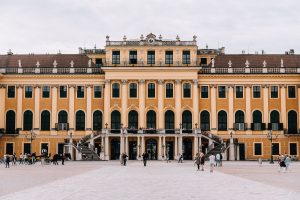
BEST SKIP THE LINE SCHÖNBRUNN TOUR
I can’t recommend this skip-the-line tour of Schönbrunn Palace and Gardens enough. The tour guides are hilarious and knowledgeable, and I always love walking past the lines!
My notes from this experience actually say, “guided tour with Michael absolutely bloody excellent”. So there you go, that’s my seal of approval!
If guided tours aren’t your thing, or you’d rather spend less time on the interiors, then you can purchase a ticket for the Grand Tour, which is a self-guided audio option. I don’t recommend it as I think you’ll get a lot more out of the guided tour, and the reviews make it seem that people were disappointed.
The guided tour of the interior of the palace will take 2 hours, so you should be finished by 5 pm, leaving you plenty of time to get back to the city for an early dinner.
I had a fabulous meal of smoked trout with cranberry cream and creamed chanterelles with dumplings at Glacis Beisl . I was lucky to get a walk-in table at about 5:30 but would recommend booking in advance . The wiener schnitzel seemed to be the meal of choice for the meat eaters!
Glacis Beisl is about 15 minutes walk from the Opera House, but you might like to eat somewhere closer to the opera, like Restaurant Bier & Bierli .
So, to level with you, I’m one of those people who’s mad about opera, thanks to my mum. We used to regularly head up to London to the opera when I was little, so this was high on my list of things to do in Vienna .
I saw Carmen, which is one of my absolute favourites, and if you’re a newbie to opera, the atmosphere here is incredible. I don’t think there’s any better place to give opera a chance than this (just don’t pick a 5 hour Wagner epic)! Most performances start at 7 pm.
INSIDER TIP | Book your opera ticket as soon as you know when you’ll be travelling to Vienna, as they do sell out. You can also get standing tickets for €13-18, which can be purchased (in cash only) 80 mins before the performance.
If you know opera isn’t your cup of tea, no worries! Enjoy a relaxed dinner, hit a swanky rooftop bar or have an early night in preparation for another full day of exploring tomorrow!
Vienna Itinerary for 3 Days: Day 2 – Taste Vienna
Whatever you do, do not have breakfast today or you’ll seriously regret it at by 2 pm! Instead, put on your stretchiest pants, grab a coffee and head to the meeting point of your food tour. In the afternoon you’ll be checking out one of the best views in Vienna before seeing the sights at night.
1. Vienna’s Best Food Tour
Ok, you got me, I haven’t been on all of the food tours in Vienna , but I did a shitload of research before I went, and this is the best-rated food tour of Vienna on the internet, so I took it. And, frankly, it blew my mind.
#1 TOP PICK

BEST VIENNA FOOD TOUR
I took and highly recommend this food tour of Vienna . It takes you to local cafés, markets and restaurants. Best of all, all the tour guides are locals who love food so you get heaps of local insights.
First thing in the morning, we went to a famous local coffee house owned by an actress and got to meet the manager. I had a Cafe Melange, which is a local Viennese version of a cappuccino (and much better, I think!). We also had a selection of breakfast sandwiches with pickles and grated horseradish, topped off with apple strudel.
Next up, we took the metro to the market for fruit and then to Tischy icecreamery where we sampled their famous frozen apricot dumplings. Genuinely phenomenal. Be sure to save space for lunch, which is a different venue depending on what the guide’s loving at the time.
On my visit, we sampled some Austrian classics – knödel (dumplings) and kaiserschmarrn (shredded pancakes), both of which will be familiar for those of you who’ve also been to the Dolomites . I made the mistake of not leaving enough space for the final tasting of goulash, but did manage to fit in a coffee!
All in all, it was one of the best value and most entertaining food tours I’ve ever done, and I made the important discovery that pickles and grated horseradish on everything is LIFE.
2. Saint Stephen’s Cathedral & Tower
Your food tour will finish at around 3:30 pm, so you’ve got time to work off some of those calories by squeezing in a visit famous Stephansdom onto your Vienna 3 day itinerary. I think going up the South Tower is a must-do on your itinerary for Vienna, but it does involve walking up a tight spiral staircase of 343 steps!
The tower is the highest point of mediaeval Vienna and gives you the most incredible views out across the city. I swear you’ll forget all about your tired legs!
TRAVEL TIP | Buy your tickets for St Stephen’s Cathedral in advance so that you don’t have to queue.
There’s no alternative access to the South Tower than those stairs, but if you can’t manage them, you can go up the North Tower instead. The views aren’t quite as good, but you can take a lift (elevator) all the way to the top.
Opening Hours: St Stephen’s Cathedral is open from 9 am to 5:30 pm, with the last entrance to the south tower at 5:15 pm.
3. Explore the 7th District
You’ve probably seen a lot of Imperial Vienna by now, so I recommend heading to the 7th district for a bit of exploring. This is one of my favourite parts of Vienna and has a much more local feel to it than a lot of the parts of the city that you’ll have seen already.
Not only is it where you’ll find coffee shops, photography stores, vintage boutiques and great vegan eats, but it’s also where you’ll find the MuseumsQuartier, home to some of Vienna’s best museums (and my favourite hotel !).
Opening Hours: Most museums are open until 8 or 9 pm one night of the week, so see if you can fit in your favourite this evening!
If you’re anything like me, you’ll still be completely stuffed from the morning’s food tour, but you could have dessert for dinner at one of Vienna’s famous cafes , Demel or Café Sacher for the famous Sacher Torte.
Depending on how tired (and full) you are by this stage, you have a couple of options. The riverside is a great spot in the evening for some bar hopping and people-watching, but if that’s not your thing then you can get an almost free tour of Vienna by night.
Get on the number 2 tram on the Ringstrasse (ring road) and watch the Vienna State Opera House, Hofburg Palace, Rathaus (City Hall) and other famous buildings glide by from the comfort of your seat. If you’d prefer to have something a bit more structured, then the Big Bus non-stop panoramic evening tour at 6:30 pm might be for you!
At this point, I’d say you’ve earned your rest, so head back to your hotel for the night.
Vienna Itinerary for 3 Days: Day 3 – Museums and Wine
This was one of my favourite days on my Vienna itinerary. What better way to break up a couple of museum visits than with a trip to some beautiful hillside vineyards?! If you’re not a wine drinker then you can very easily stay in the city for lunch, adding in another museum or activity.
1. Breakfast at Ulrich
This was one of my favourite finds in Vienna. You all know that I’m always in search of the perfect breakfast, and Ulrich is a great option. I had a fantastic shakshuka here (because I cannot go past it on a menu), but many of the clientele were enjoying their signature Ruby croissant – a chocolate croissant with pomegranate and pistachio since you’re asking!
I absolutely recommend that you make a booking at Ulrich if you’d like to come here since the place was absolutely heaving at opening time on Sunday!
2. Hofburg Palace & Sisi Museum
You can’t miss the Hofburg when you’re visiting Vienna – it’s ever-present as you walk the city streets, and you somehow always seem to end up passing it. It was once the city palace of the Hapsburgs, and now it’s home to the president of Austria!
Since it’s so large, the Hofburg is actually home to several museums, including the Imperial Treasury, National Library, Austrian History Museum and more. I think that the best part of the palace is the Sisi Museum.
TIP | I would highly recommend taking a private guided tour with skip-the-line entrance if you’re interested in really getting to know Sisi! You can also buy tickets via the official website , with options for bundled tickets with other museums.
If you’ve been following my Vienna itinerary, then you’ll have heard plenty about Empress Elizabeth, aka Sisi, already. This is an opportunity to learn more about her life and see the Imperial Apartments where she lived.
Opening Hours: The Sisi museum is open from 9:30 am to 5 pm.
INSIDER TIP | From September to June, you can hear the famous Vienna Boys Choir perform at Sunday morning mass (9:15 am) at the Hofburg Chapel. Check availability and buy tickets here .
3. Vienna Woods Winery or Heuriger
Now, we’re going a little bit out of the way here, but I think it’s such a unique Vienna experience that I really, really recommend that you make the time. Genuinely, this was one of my favourite of all my Vienna experiences, and I felt like I was hanging out with the locals!
You’re going to take either the D tram or the U4 subway line out to Heiligenstadt, which will take about 30 minutes from the Sisi museum. Depending on the time of year, venture up the hill to one of the Buschenschank, basically pop-up wineries among the vines (with amazing views) or head to a traditional tavern for lunch.
TRAVEL TIP | From April 1st to October 31st, you can take the Heurigen Express for all, or part of the return journey up the hill on Friday, Saturday and Sunday to save you a walk! This coincides with when the Buschenschank are open.
In the summer months, head up the hill to visit the Monte Nucum Buschenschank for a glass (or two) of their delightful Gemischter Satz and then wind your way back down through the vineyards, stopping at some of the other Buschenschank along the way.
In addition to Monte Nucum, I also recommend stopping at Buschenschank Windischbauer and Wagnerei . Most of the wineries have cheese plates and snacks available, but if you want a proper meal head all the way down into Heiligenstadt.
INSIDER TIP | If you’d like to visit the Beethoven Museum , be sure to go before lunch, as you often get a voucher for a complimentary wine at the Mayer am Pfarrplatz Heuriger!
In Heiligenstadt, you’ll find the Heurigen, which are traditional countryside wine taverns. I rather felt as though I was at Oktoberfest, as the staff are usually dressed in traditional costumes, and there’s often traditional live music.
A couple of great options are the Mayer am Pfarrplatz Heuriger , with its nods to Beethoven and seasonal menu, and Heuriger Zimmerman.
Opening Hours: The Buschenschank are only open in summer, usually at weekends in the afternoon, but check individual websites before you go!
4. Kunsthistorisches Museum
Assuming that you haven’t overindulged at the wineries, it’s time for the famous art history museum of Vienna! Honestly, even if you have overdone the wine, head to the Kunsthistorisches Museum because I reckon it’ll make the art somehow better.
I’m firmly of the opinion that great art is best appreciated when you’re feeling somewhat disinhibited. So, now you possibly know more about me than you need to, but you’ll also enjoy art more!
The museum is housed in an exquisite building, matching the incredible works of art you’ll find here. The famous “Tower of Babel” by Peter Brueghel is amazing, and there’s also work from artists such as Vermeer, Rembrandt, Caravaggio and more. It’s definitely one of my favourite art museums in Europe, and that’s saying something!
TRAVEL TIP | Whether you’re new to art, or just want to gain a deeper understanding and appreciation of the works you’re looking at, I highly recommend taking a private tour of the museum with an art historian . It turns a visit from interesting into fascinating.
Opening Hours: The Kunsthistorisches Museum is open from 10 am to 6 pm, except on Thursdays, when it’s late night opening to 9 pm, and Mondays, when it’s closed.
The Belvedere Palace Art Gallery is just 10 minutes away from the Kunsthistorisches Museum on Tram D. It’s famous for having the largest collection of works by Gustav Klimt, including “The Kiss”. The building itself is a beautiful Baroque palace, and the gardens are beautiful.
Honestly, after having already seen the Schönbrunn, the Hofburg and the Kunsthistorisches Museum, I didn’t feel that this was a worthwhile stop for me, but if you love Klimt, then try to fit it in.
You’ll want tickets to the Upper Belvedere to see “The Kiss”.
Opening Hours: The Upper Belvedere is open from 9 am to 6 pm daily.
Assuming that you don’t just want to go to bed after your busy day, I recommend rounding out your stay with a meal at Tian Bistro . Their all-vegetarian menu is wonderful, and the tasting menu is sublime and very reasonably priced!
Top Tips to make your Vienna Itinerary run smoothly
1. book your tickets online in advance.
Use Get Your Guide, Viator or Tiquets so that you have your tickets available on your phone without having to worry about paper! This will also mean that you don’t get tempted to buy tickets from the many hawkers around the city dressed up as Mozart!
2. Pick the right hotel location
While it can be tempting to stay on the outskirts of the city to save money, I wouldn’t recommend this in Vienna. You’ll waste time getting into the city that could be better spent exploring the museums and sights.
I recommend staying in the MuseumsQuartier at 25 Hours Museum Quarter , which has a sublime rooftop bar, amongst other things. It’s quiet in the evenings and an easy walk to public transport and the Old Town.
Your other option would be to stay in the Old Town itself, although prices tend to be considerably higher and it’s very busy until late in the evening.
3. Consider getting a City Pass
Unlike many European cities, museums in Vienna aren’t free. You’ll save money on your Vienna itinerary if you purchase a Vienna Pass , Flexi Pass or City Card in advance of your trip.
Many of the best restaurants in Vienna are extremely popular, and you’re unlikely to get a table without a reservation, especially in summer.
If you’ve got your heart set on a particular venue, book ahead so you’re not disappointed.
Vienna Itinerary with less time
If you’ve got to put together a Vienna itinerary for less than 3 days, you’re going to have a hard time of it! Unfortunately, you’re definitely not going to be able to fit it all in, no matter how quickly you dash between sights.
Here are a couple of ideas for a single-day Vienna itinerary that you can mix and match to find what works for you if the above doesn’t suit you!
- Day #1: Stephansdom, Albertina Museum, Opera House Tour, Kunsthistorisches Museum, Ferris Wheel
- Day #2: Schönbrunn Palace, Belvedere Museum, Naschmarkt, Vivaldi at Karlskirche
- Day #3: Albertina Museum, Schönbrunn Palace, Opera Performance (this would be a good alternative if you don’t want to take the walking tour on Day 1 of my 3-day Vienna itinerary)
- Day #4: Hofburg Palace & Sisi Museum, Spanish Riding School, Naschmarkt, Belvedere Museum, Stephansdom (this is a good alternative to Day 2 of my Vienna itinerary if you don’t want to do the food tour)
Vienna Itinerary with more time
Although a 3 day Vienna itinerary is incredibly popular, it does mean that you have to be fairly vicious in your culling of potential activities! Devoting most of a day to a food tour was definitely worthwhile for me, but might not be everyone’s cup of tea.
Here are some things that didn’t make it onto my Vienna itinerary but that I really wanted to do:
Vienna State Opera House Tour
If you’re a massive opera fan, then do this in addition to a night at the opera. If you don’t want to attend an opera, then this is a great way to see the incredible interiors of this iconic building. The guided tours last about 40 minutes and give you a behind-the-scenes look at what it takes to run a world-famous opera house!
Opening Hours: Tours run between 10 am and 3 pm, varying throughout the year.
Tickets: Buy online in advance . Free with the Vienna Pass and Flexi Pass .
Mozarthaus Vienna
On Domgasse, close to Stephansdom in Vienna’s beautiful Old Town, you’ll find Mozarthaus, where Mozart lived from 1784 to 1787. It’s the only one of the many homes Mozart had in Vienna that still exists today! Even if you don’t love Mozart, I’ve read that it’s one of the best places to learn about 18th Century life in Vienna too.
It’s also the perfect place for an evening classical music concert . Listen to Mozart in the place where he wrote some of the music!
Opening Hours: Mozarthause is open from 10 am to 6 pm daily but closed on Mondays.
Vivaldi at Karlskirche
This is a beautiful 18th-century Baroque-style church with spiral columns on the exterior. There’s a reflection pool in front that makes for some beautiful photography opportunities! You’ll probably walk past it during your time in Vienna. I really wanted to listen to Vivaldi’s Four Seasons here, but chose the opera instead!
Opening Hours: Vivaldi’s Four Seasons at Karlskirche starts at 8:15 pm and is on most nights
Tickets: Buy online in advance .
The Naschmarkt is Vienna’s largest and most famous market. It runs for almost a mile along Wienzelle and has existed here since the 16th century! From fruit and vegetables to seafood, sausages and Viennese specialities, the Naschmarkt has it all!
I visited this on my food tour, but would have loved to have more time here to explore. There are also numerous cafes and restaurants surrounding the market if you’d prefer to sit down to eat.
Opening Hours: Stalls start opening at 6 am and close around 7:30 pm, although some stands may be open longer. Closed on Mondays.
Tickets: For the best experience, book a 2.5 hour guided food tour in advance!
Austrian National Library
I wasn’t expecting to find so many gorgeous libraries in this part of the world, but it seems the Hapsburgs liked their literature! This is a two-story pillared and frescoed extravaganza and looks like it should be part of a movie set rather than a real life library!
Opening Hours: The Austrian National Library is open daily from 10 am to 6 pm except Thursdays until 9 pm and Mondays in winter when they’re closed.
Natural History Museum
Directly opposite the Kunsthistorische Museum, and almost a mirror image of it, you’ll find the Natural History Museum. Since I’ve been to the London version many times, I didn’t feel the need to go here, but I’ve heard that it’s really wonderful.
Opening Hours: The Natural History Museum is open from 9 am to 6 pm except on Wednesday when it’s late opening to 8 pm and Tuesday when it’s closed.
Prater Park & Ferris Wheel
Prater Park is a traditional amusement park, complete with giant ferris wheel. The ferris wheel was originally built in 1897, rebuilt after damage during WWII, and was the world’s largest all the way up until 1985! You could spend hours having fun at the park, so this is a good one for groups and families.
Opening Hours: Prater Park is accessible 24/7, but the rides tend to be open from 10 am until 1 am depending on the season. Check on the official website .
Spanish Riding School
This is one. of the most popular things to do in Vienna, although I don’t like watching animals perform, so it’s included as something you might want to do rather than something I recommend! You can, however, book a tour of the riding school, which is about architecture and history instead.
I’ve read that the training sessions can be rather dull and many people report being disappointed that they didn’t book a ticket for the actual performance.
Performances: The performances are daily at 11 am and there are occasional special events at other times. There are no performances in July.
Tickets: Book a tour online in advance. Book a performance ticket as soon as you know your visiting dates so that you don’t miss out.
Albertina Museum
This is another of the most famous art museums in Vienna and is part of the Hofburg Palace complex. You’ll see Monet, Picasso and Cezanne, as well as get access to the Hofburg Palace State Rooms as part of your entry fee.
Opening Hours: The Albertina is open daily from 10 am until 6 pm and until 9 pm on Wednesdays and Fridays.
Tickets: Buy online in advance . Discounts are available with the Vienna Pass and Flexi Pass but must be claimed in person on-site.
Hundertwasser Museum
Unfortunately, the museum was closed during my visit and won’t reopen until 2024. It’s the largest collection of works from the surrealist artist Friedensreich Hundertwasser who, bizarrely, is also incredibly popular in Whangeri, New Zealand, where I lived for many years! I absolutely recommend a visit if it has reopened by the time of your visit.
Opening Hours: Hundertwasser Museum is usually open from 9 am to 6 pm, but closed until early 2024.
If you’re lucky enough that your Vienna itinerary is 5 days or more, then I think you should definitely try to squeeze in one of the best day trips from Vienna !
The best part is that most of these are available as tours, so you don’t even need to hire a car to experience more of the beautiful countryside around Vienna.
A Day Trip to Wine Country – Wachau Valley and Melk Abbey
Leopold II founded Melk Abbey in 1089, and it’s now one of the most popular day trips to take from Vienna. The abbey is a stunning example of Baroque architecture but can only be visited with a guided tour in the winter.
This tour to Wachauau Valley includes wine tastings with a local expert, tasting locally-made produce, visiting Melk Abbey and going to a Heuriger! It’s the tour that I want to do when I’m next there.
If you’d rather visit under your own steam, take a regional train from Wien Westbahnhof to Melk Bahnhof (1 hour). From there, it’s about 800m to the abbey.
A Day Trip to Salzburg – Melk Abbey, Hallstatt and Salzburg
If wine tasting isn’t your thing, but you still want to see Melk Abbey, one of the most picturesque villages beside one of the most beautiful lakes in the world and Mozart’s birthplace, then this is the trip for you!
I recommend taking this tour ; otherwise, you’ll need to hire a car to be able to fit all this into one day.
Tickets I Recommend Purchasing in Advance For a 3 Day Vienna Trip
1. an opera performance.
The Vienna State Opera is not only world-famous but incredibly popular with locals, so I recommend booking tickets as soon as you know the dates that you’ll be in town. As far as I’m concerned, it’s a must-do on your Vienna itinerary.
If you don’t mind standing, you can pick up a ticket on the day for most performances, but it involves sacrificing some time to stand in line that could be better spent doing other things.
I was incredibly lucky to get a last-minute return on the day for a performance of Carmen, but this is very much the exception and not the rule!
2. Spanish Riding School Performance
Be aware that if you have a Vienna pass, it’s only the practice sessions that you can attend for free. If you actually want to see what all the fuss is about, you’ll need to book a performance ticket well in advance because they sell out weeks ahead.
The Schönbrunn is a massively popular stop on everyone’s Vienna itinerary, so you must book your tickets in advance to make sure that you get to do the tour you want. The audio-guided Grand Tour is included with the Vienna Pass , but I recommend doing the guided tour for a personalised approach and to see more of the Imperial apartments!
4. Food Tour
This is less of an issue if you don’t have your heart set on a particular tour, but I knew that I wanted to do the full day, and it does sell out. If you want to do the same food tour that I did (in my opinion, the best!), then book it once you know your dates!
Save Money on your 3 Day Vienna Trip with this easy hack
Like most cities in Europe, Vienna isn’t exactly cheap. Tickets to most experiences cost from €5-30 per person. It means that visiting everything on your Vienna itinerary quickly adds up.
To save money when you’re visiting Vienna, invest in a Vienna Pass or Flexi Pass . You can buy them to cover the number of days you intend to visit, and if you go to all of the attractions above, you’ll be saving about €250 on entrance fees.
The 3-day Vienna pass costs €153, and you also get free use of the hop-on, hop-off bus to get you to the venues. It’s a significant saving.
If you don’t think you’ll make full use of the Vienna Pass , then consider the Flexi Pass , which is customisable to allow free entry to over 40 sights, including almost all those included above.
How to get to Vienna
Getting to vienna by train.
This is probably the easiest way to get to Vienna, and is easily done from all major European cities. It’s how I got here when I was doing my Budapest, Vienna and Prague itinerary and I found it a breeze.
You’ll arrive into the Central Station, which is a couple of kilometres from the historic centre, and you then simply get the metro or a tram to your accommodation.
I use the ÖBB official site and app to book all my tickets for my European trips.
Getting to Vienna by Air
Vienna’s International Airport is located about 20km from the city, so you’ll need to work out how to get into the city from there. Whilst it’s easy enough to get public transport, with the S-Bahn and City Airport trains travelling into the city, I recommend a private transfer.
When you’ve just gotten off a long flight, it’s so much nicer to be able to chuck your luggage into the back of the car and get door-to-door service! Definitely book in advance to make your life easier.

BEST VIENNA PRIVATE AIRPORT TRANSFER
For a private transfer from Vienna Airport to your hotel, I recommend this service . With a review score of excellent from over 4700 reviews, they’re the best option!
Getting to Vienna by Car
If you’re road-tripping through Europe, then I’m sure you already know how to use a map! I’d recommend that you select a hotel with free parking because trying to find street parking in Vienna can be a bit of a nightmare.
You could even stay a little outside the city centre and just make use of the excellent public transport system to get around with ease.
How to get around in Vienna
Vienna is incredibly walkable, and I did this entire Vienna itinerary using my own two feet and public transportation without any issues. You can invest in a travel card, but I spent less doing single journeys than I would have with the card.
If you’ve got the Vienna Pass , a hop-on, hop-off bus is included that takes you to all the major tourist sites without the need for other transportation.
Another great option is the City Card which gives free use of public transport and discounts at lots of the major experiences.
Any Vienna itinerary is easiest if you’re staying near the sights, either the Old Town or just outside. I stayed at the 25 Hours Museum Quarter , which I found really convenient for public transport and walking into the centre without feeling overwhelmed by fellow tourists!
Vienna Frequently Asked Questions
How many days should i spend in vienna.
You should spend at least 3 days in Vienna to be able to see most of the highlights on a Vienna itinerary without feeling rushed. I did have to skip several things that I would have loved to do, so if you can spend an extra day or two, then I would recommend it!
When is the Best Time to visit Vienna?
The best time to visit Vienna for sunny weather without the crowds is early summer (May to July) or autumn (late August to October).
In May and June, you can experience the wonderful Vienna Philharmonic Summer Night Concerts in the gardens of the Schönnbrun Palace. If you’re a fan of Christmas markets, then visit Vienna in December for some of the best in Europe!
Where should I stay in Vienna?
I recommend staying in either the Old Town or just outside near the MuseumsQuartier. I stayed at the 25 Hours Museum Quarter , which I found was perfect for this Vienna itinerary.
Is the Vienna City Pass worth it?
If you’re planning to visit most of the main attractions in Vienna, then this pass will almost certainly work out to be cost-effective for you. You’ll also get free use of the hop-on, hop-off bus and skip-the-line access. You can purchase your Vienna Pass here .
Is Vienna worth visiting?
Vienna is definitely worth visiting if you love art, history, food, wine and culture. It’s a compact city that’s easily walkable, and I loved my time here.
Is Vienna expensive?
Vienna can be expensive to visit, since unlike many other European cities, the museums all have paid entrance. You can reduce the costs by purchasing a Vienna Pass , Flexi Pass or City Card in advance of your trip.
Vienna is definitely safe for solo female travellers. I did this entire Vienna itinerary on my own, using public transport and walking around the city. I felt completely safe the entire time, which isn’t surprising since the capital of Austria is ranked number 6 in the world in Mercer’s personal safety ranking !
Final Thoughts: 3 Days in Vienna Itinerary
So, there you have it, everything you need to create a perfect Vienna itinerary for your visit – I hope that you found it helpful! I really do think that Vienna is a lovely city and a great place to explore.
Drop a comment below if you’ve got any questions, and I’d love it if you would share on Pinterest and social media for other people to find.
Planning A Trip To Europe?
Check out these essential guides, travel tips, and more to help you plan your trip:
CENTRAL EUROPE | Explore the region with a perfect 2 week itinerary for Budapest, Vienna and Prague or just spend 4 days in Budapest or 4 days in Prague exploring
ITALY | Just a short distance away, plan a great Italy trip or just head straight to The Dolomites , my personal favourite!
TRAVEL INSURANCE | Don’t go anywhere without it! I use and recommend Safety Wing .
THOUGHTFUL TRAVEL | No matter where you go, always be aware of the fact that travel impacts the place and people that live there. Being a thoughtful traveller is more critical than ever. Here are my top tips to make your trip a mindful one.
PHOTOGRAPHY | Love my photos and want to know how to take better shots on your own trips? Then my photography guide is for you. Here’s all the photography gear I use too. Want to buy one of my images? Head to the Print Store .
ESSENTIAL GEAR | You’ll find my travel essentials here, and a complete guide to all my hiking gear here .
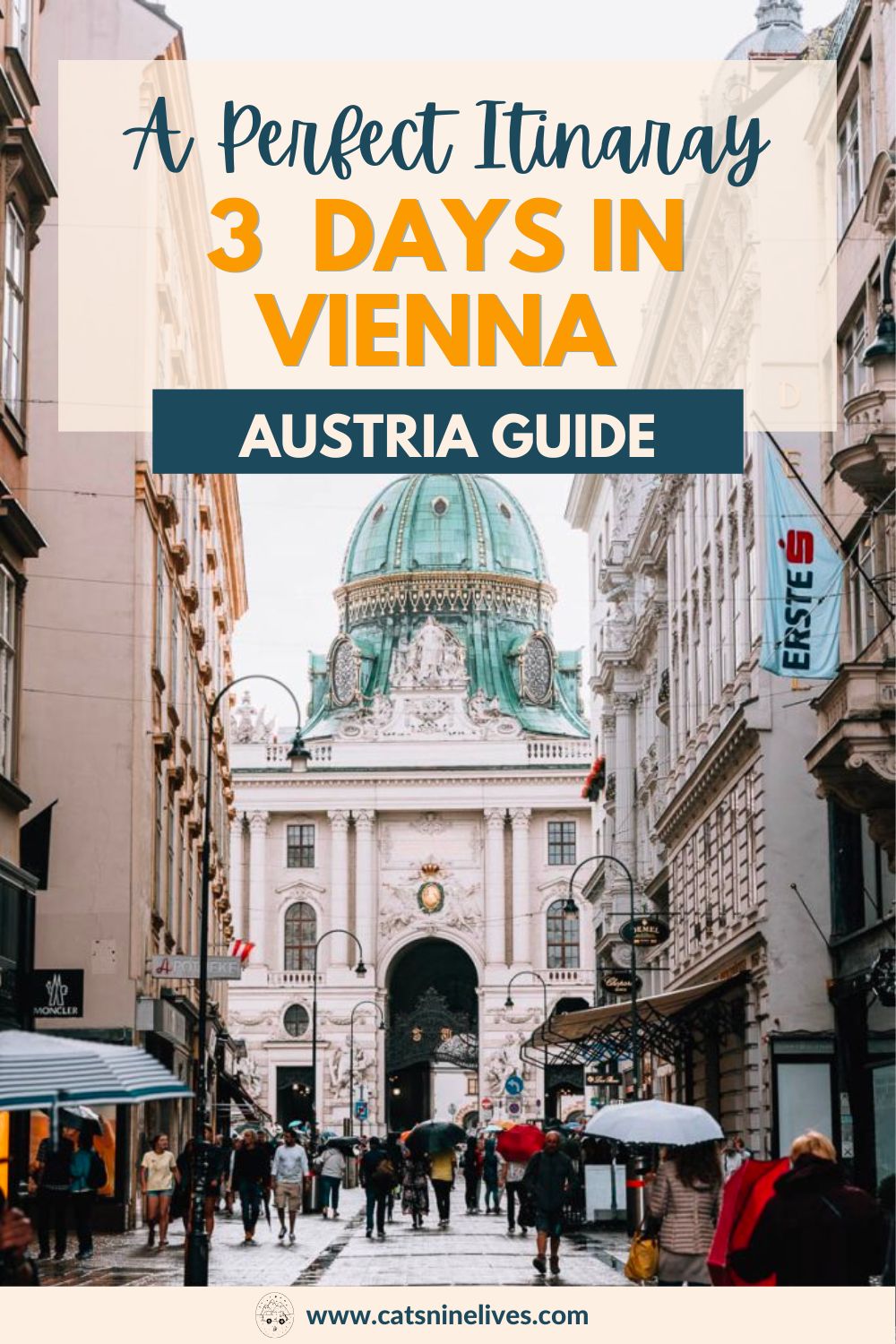
Leave a Reply Cancel reply
Your email address will not be published. Required fields are marked *
Save my name, email, and website in this browser for the next time I comment.
- More Networks

Vienna in 4 Days: An Ideal Itinerary for First-Time Visitors
Vienna has been on my bucket list for quite some time, but I actually knew almost nothing about it. Now, after seeing the best of Vienna in 4 days, I can safely say that your itinerary will not be empty. You’ll even need more time to fully explore it.
Vienna, one of the best places to visit in Austria , is where you can find incredible historical landmarks and architecture, world-class museums, amazing coffee, and drool-worthy cakes, all wrapped up in a classic European vibe.
Well, there’s a lot more to this city, but those are some of the things that you absolutely must experience while in Vienna, and here’s the itinerary that will help you do exactly that.
* This post may contain affiliate links from which I earn a commission (for more info, read my disclosure ). As an Amazon Associate, I earn from qualifying purchases.
* I try to keep the information on this blog as updated as possible, but I still recommend consulting the latest prices, opening hours, and other details on the official website of each site, hotel, and tour, as well as checking the updated public transport routes and timetables.
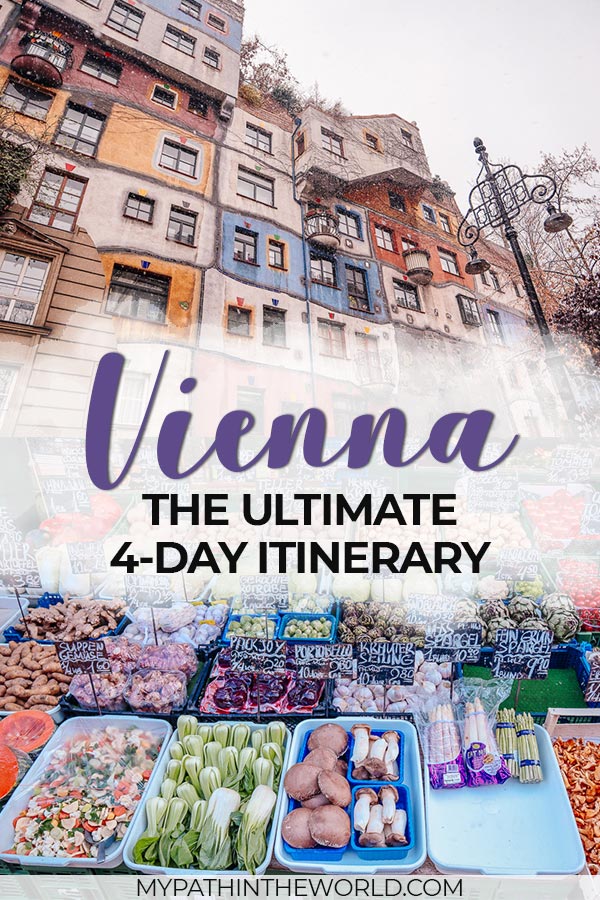
Table of Contents
4-Day Vienna Itinerary – Summary
Here’s what you’ll see in four days in Vienna:
Day 1: Schönbrunn Palace, Naschmarkt, the Spittelberg quarter.
Being such a highly-visited complex with lots of things to do and see, you might want to book a guided tour of the Schönbrunn Palace and its gardens .
Day 2: Vienna State Opera, Burggarten, the Butterfly House, Hofburg Palace.
Day 3: Hundertwasserhaus, Kunst Haus, the Vienna Ring Tram, St. Stephen’s Cathedral (one of the most beautiful European cathedrals ) + city center.
Day 4: City Hall and Parliament, Volksgarten, Maria-Theresien-Platz and its museums, MuseumQuartier.
If you want to get out of the city in one of the four days, consider taking a day trip from Vienna to Salzburg independently by train.
Alternatively, book yourself: 1. A guided day tour to Salzburg , the filming location of The Sound of Music 2. A day trip to the scenic Wachau Valley and Melk Abbey with wine tastings 3. A day trip to Hallstatt , a fairytale town in Austria
Other Things I Would Have Loved to Do in Vienna
Well, it’s impossible to do and see everything in Vienna in four days, so here are a few more experiences I would have loved to try:
- Visiting the Belvedere Palace , a UNESCO Site. Get your ticket here .
- Local wine tasting in a historic cellar .
- Visiting the historic Prater amusement park and getting on the Giant Ferris Wheel .
- Taking a Viennese coffee, cake, and chocolate tour .
You can also take a classic free walking tour of Vienna or a free night tour of Vienna that includes many of the landmarks mentioned on this itinerary.

Where to Stay for 4 Nights in Vienna
I stayed at the Ibis Styles Wien City and had a great experience.
Although it’s not located in the city center , it ticked all the boxes for me as far as price, general atmosphere and design, connection to public transportation, staff (which was available 24/7), breakfast, and room comfort.
With double, triple, and quadruple rooms, it can be a great hotel choice for couples, a group of friends, and even families. You can check the latest prices of Ibis Styles Wien City here.
If you prefer finding accommodation in the city center itself (which is pricier but more convenient), check out the highly-rated: 1. Boutique Hotel Das Tigra (mid-range) 2. Boutiquehotel Das Tyrol (4-star boutique)
For other accommodation options, see the best areas to stay in Vienna for Christmas markets .
Vienna in 4 Days – Day 1
Schönbrunn palace.
The Schönbrunn Palace is a beautiful baroque royal residence and a UNESCO World Heritage Site dating back to the Middle Ages.
Apart from being a residence of emperors and empresses (like Emperor Franz Joseph), the palace hosted important events and conferences, making people like six-year-old Mozart and Napoleon its guests.
The palace is one of Vienna’s most visited attractions, so if you want to take a tour inside it, you can book a guided Schönbrunn Palace and gardens tour in advance and skip the lines .
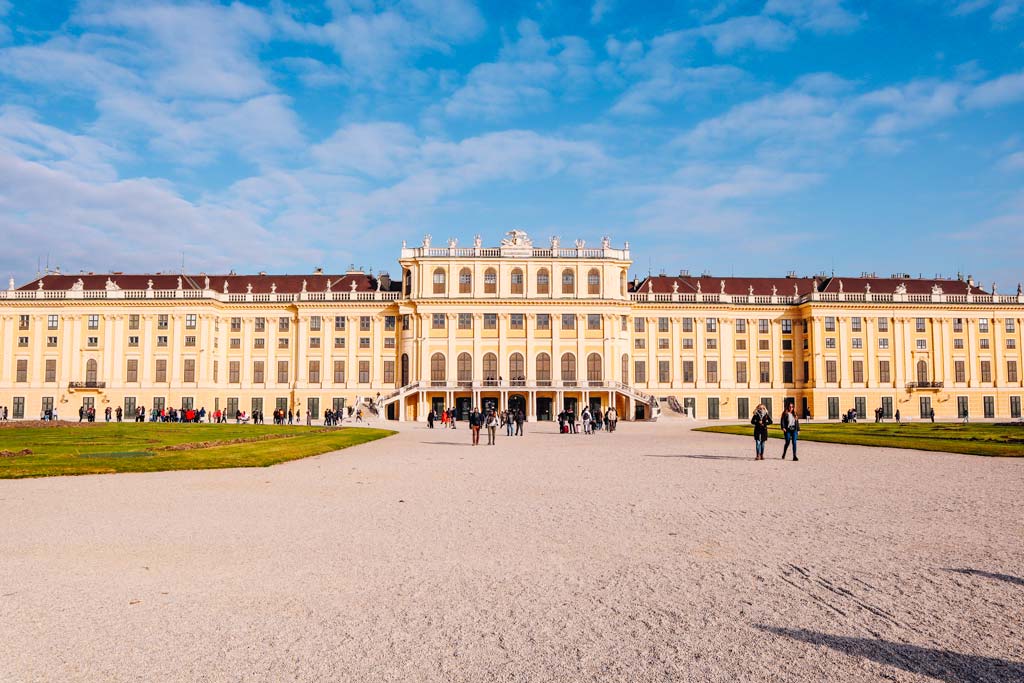
Touring the complex is free of charge, and you can easily spend a few hours wandering around the gardens.
You can also visit several other attractions (that have their own admission fee ):
- The historic Cafe Gloriette: Located on top of a hill, overlooking the beautiful gardens.
- The Imperial Carriage Museum (you can get your ticket in advance here ).
- The Orangery Garden.
- The Maze Garden.
- The Palm House.
- The Privy Garden.
If you’re visiting Vienna in winter as I did, most of these are closed, but if not, you’ll probably need more than half a day to fully explore the different activities in this amazing complex.

Naschmarkt is Vienna’s most famous market, and it offers a combo of market stands and restaurants in the same place.
To be honest, I had high expectations from this market, and it was quite underwhelming. Apart from some market shops selling beautiful produce like vegetables, bread, and cheeses, most stands were disappointing.
Also, most restaurants in the market seemed unappealing to me, and we ended up eating lunch at Neni which was one of the only spots that were packed with people.
I did like the concept and some of the stands, so I wouldn’t skip out on visiting the market.
If you want, you can also take a guided food tour of the Naschmarkt.
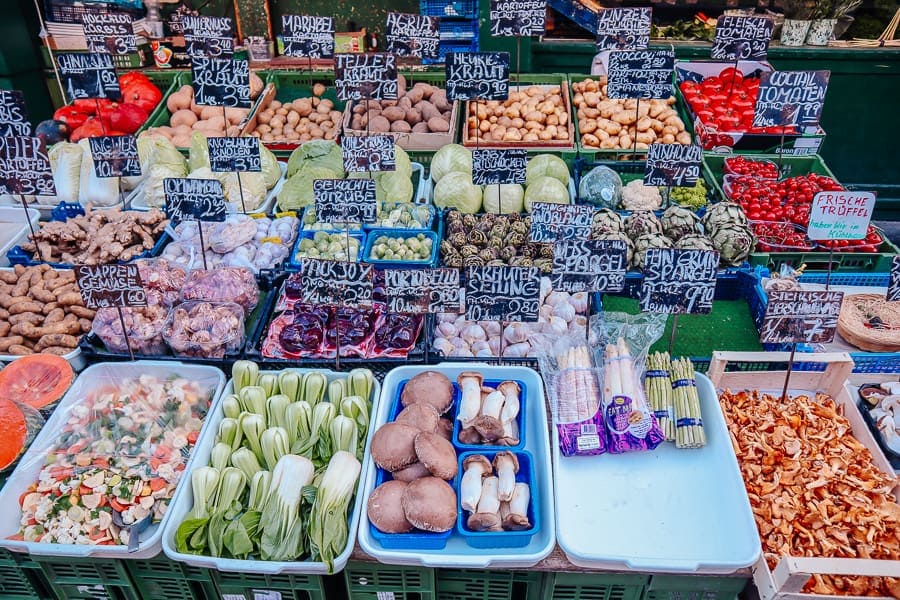
Tip #1: If you love flea markets, that’s what you’ll get if you visit the Naschmarkt on a Saturday.
Tip #2: In this area, you can find some really cool street art ( see this map for all street art spots in Vienna ) and unique buildings like Majolikahaus (Linke Wienzeile, 40).

Spittelberg Quarter
When I’m traveling to a big city, finding charming little corners like the Spittelberg neighborhood is like finding a treasure.
Although it’s a small area, it’s packed with cafes, restaurants, and bars, and its enchanting streets are the perfect place to spend an afternoon and evening.
If you’re planning a pre-Christmas visit, don’t miss Spittelberg’s Christmas market, which is super cozy and inviting.
Location: Between Breite Gasse and Sigmundsgasse.
Tip: Only about a minute away there’s a really cute hidden cafe called Cafe in der Burggasse24 (Burggasse 24) you should totally check out.

Vienna in 4 Days – Day 2
Vienna state opera.
I admit it, opera is not my cup of tea, but that doesn’t mean I can’t appreciate Vienna’s Opera House , which is one of the city’s most important landmarks.
This incredibly beautiful building from the 19th century hosts more than 60 different operas and ballet productions each season, including a yearly ball (isn’t that mindblowing?). To learn more about it, you can book a behind-the-scenes guided tour (on some days, it takes place in the morning).
If you want to see a concert, you can purchase your tickets on the opera’s official website .

Who doesn’t love to stroll around parks and gardens? It’s a great way to take a little break from sightseeing and experience another side of a city.
I particularly loved Vienna’s Burggarten . Although it’s not a big park, it seemed super charming to me. Perhaps it’s because I got to see it covered in snow, and there were still hints of green and orange underneath it.

The Butterfly House (Schmetterlinghaus)
Right next to Burggarten, you can find a quirky yet interesting attraction that will make you forget that you’re in the middle of an Austrian city.
The Butterfly House is home to hundreds of butterflies that are flying freely in a rainforest environment recreated especially for them.
Here you can learn about the different types of butterflies and their life cycle and feel like a kid when you see them happily chasing each other.
With this amount of uniqueness, you’ll probably want to take beautiful pictures, so I feel like I should give you a heads-up that the humid setting makes it a bit challenging.
Coffee Break
If there’s one thing you absolutely must do in Vienna, it’s relishing a cup of Viennese coffee and cake. Since I’m a total sucker for local cafes, this important part of the Viennese culture was right up my alley.
Now, it’s quite difficult to pick out which Viennese coffee houses to check out (even if you have 4 days in Vienna and you can go to multiple places).
However, I wouldn’t skip out on institutions like Cafe Central (Herrengasse 14) and Demel (Kohlmarkt 14).
It’s not just the amazing coffee and cakes but it’s the entire atmosphere that feels elegant, sophisticated, and inviting all at the same time. Now, let’s talk about desserts.
After tasting Cafe Central’s strudel and kaiserschmarrn (Austrian shredded pancake), and Demel’s strudel and almond cake, I have one word for you: YUM.

Hofburg Palace
Once a royal residence and seat of government, the Hofburg Palace is now a huge palace complex that houses museums (like the Sisi Museum and The Imperial Treasury ), the Spanish Riding School , and other Viennese landmarks .
The amount of time you’ll need here obviously depends on your interests. You can either stroll around the complex for free or visit a museum or two (or more).
If you do plan to visit some museums, you can skip the lines by purchasing your tickets to the Imperial Treasury .

Vienna in 4 Days – Day 3
Hundertwasserhaus.
Being a huge fan of Antoni Gaudi (Spain’s most famous architect), I was thrilled to get to know Friedensreich Hundertwasser – an Austrian artist and architect who was influenced by him.
Amongst his creations, he designed the unusual Hundertwasserhaus .
This colorful work of art is actually an ordinary residential building (I don’t know about you, but I would be more than happy to live in such a quirky building), so you can only appreciate its exteriors.
The architect also designed the adorable Hundertwasser Village , a small shopping center right next to the Hundertwasserhaus. It houses a cafe and shops selling all kinds of Hundertwasser-style products.
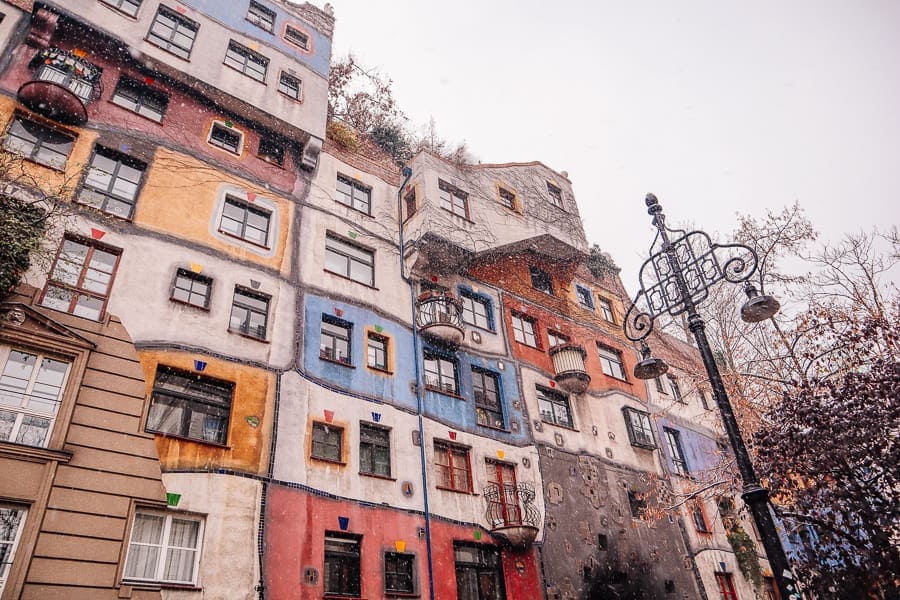
Only a few minutes from the Hundertwasserhaus, you can find the Kunst Haus, another architectural creation of Hundertwasser.
This is a museum showcasing his work, but what I liked most about the place was the cafe on the ground floor.
It was probably one of the coolest cafes I’ve visited, and the coffee and the cheese strudel I had were not too shabby either.

Vienna Ring Tram
One of the most popular things to do in Vienna is walk alongside Vienna’s Ringstrasse.
It is a circular/ring road that passes through some of Vienna’s most important landmarks, like the State Opera, City Hall (Rathaus), and the Natural History Museum.
I’ve included some of them on this Vienna itinerary, but since the road is 5.3 km long (about 3.3 miles), taking a tram that runs alongside it seemed like a great way to explore the entire route.
You can definitely do it by walking, but you might need more than four days in Vienna if you don’t want to rush it. You can also explore the Ringstrasse with a local guide.
The Vienna Ring Tram leaves Schwedenplatz every half hour, and you can buy your tickets right on the spot (look for yellow coats).
You also get a set of earphones, so that you can listen to an informative audio guide about the different sights.
Walk Alongside the Danube Canal
When you get back to Schwedenplatz, cross the street and spend some time walking alongside the Danube Canal . This is one of the biggest areas where you can find really amazing street art.
Obviously, the canal is quite long, so feel free to explore different parts of it and check out this map to find the coolest street art spots.

St. Stephen’s Cathedral
Walk towards the city center and get to St. Stephen’s Cathedral , an undeniably stunning Gothic structure from the 12th century and one of the most famous landmarks in Austria .
If the thought of climbing 343 stairs doesn’t make you cringe, you can get to the tower room and see Vienna from above (and take a closer look at the colorful tiled roof).
Also, try to spot the iron rooster on the roof, which connects to one of the most intriguing European myths and legends .

Explore the City Center (Old Town)
The area surrounding the cathedral is a maze of squares and streets packed with shops, cafes, restaurants, museums, churches, and other beautiful traditional buildings.
Take your time and explore this vibrant part of Vienna and don’t miss streets like Graben, Rotenturmstrasse, and Kärntner Strasse (as well as smaller hidden streets you’ll discover on your own).

Vienna in 4 Days – Day 4
City hall and the parliament.
Vienna’s City Hall is one of the most beautiful I’ve seen. Its Gothic style makes it look like a cathedral rather than a city hall, and that’s what makes it unique.
Apart from its stunning facade, you can take a free guided tour inside the building on certain days of the week.
In winter , the city hall square (Rathausplatz) hosts the biggest Christmas market in Vienna, and parts of it turn into a giant ice skating rink.
Not too far from City Hall, you can see Vienna’s Parliament which is one of the most important landmarks in the city.
Volksgarten
If you feel like taking a little break from sightseeing, Volksgarten is a beautiful park that would be perfect for that. It houses a few buildings, monuments, fountains, and about 3,000 rose bushes.
If you’re not visiting during springtime, there will be a lot fewer roses, but this park is still a stunning spot you must see in Vienna.

Maria-Theresien-Platz and Its Museums
Apart from being a gorgeous European public square , Maria-Theresien-Platz sits between two very significant museums: the Natural History Museum and the Art History Museum .
Both buildings were built in the 19th century, and if you look carefully, you will see that they are identical.
Another thing you can see in the square is the Maria Theresa Monument , honoring Empress Maria Theresa.
Tip: Skip the lines by buying tickets online to the Art History Museum (Kunsthistorisches Museum) or combo tickets with the Leopold Museum or the Imperial Treasury which will save you a bit of money.

Museumsquartier
If you think you’re in for just another museum complex, think again.
Vienna’s MuseumQuartier has become a cultural space where you can find all kinds of museums (including the famous Leopold Museum), performances, shops, cafes, and restaurants all in the same area.
Programs and events in the complex are constantly changing, so check the official website for the latest updates.
4 Days in Vienna – General Notes
Is 4 days in vienna enough time.
While I feel like I’ve seen many of Vienna’s highlights, I would have loved to spend at least one more day in the city itself and take 1-2 day trips.
Getting Around
Vienna’s public transportation is incredible. There are more than enough U-Bahn (Metro) and tram stations in the city so you can get anywhere easily. Simply buy a daily or multi-day travel card in advance or at one of the U-Bahn stations.
Where to Eat
We had our breakfast at the hotel, and since we had visited Vienna in late November (because Vienna is one of the top winter city breaks in Europe ), we ate most of our meals at the Christmas markets’ food stalls. So if you’re looking for recommendations for restaurants in Vienna, check out this guide .
Solo Travel
If you’re traveling alone, check out this solo traveler’s guide to Vienna (though Vienna can also be a great girls’ trip destination ).

Vienna City Card – Worth It or Not?
For unlimited use of public transportation and discounts on many attractions, I purchased the Vienna City Card .
Most attractions are pretty pricey and don’t offer free admission if you visit them on certain days or hours (unlike other attractions in Europe), so the card was great in saving me money on museums and landmarks in Vienna.
Plus, the city card offers discounts on tours of Vienna, day trips, concerts, and taxis from the airport to the city (and discounts in several cafes and restaurants).
Whether it’ll save you money or not depends on how much you’ll take advantage of these discounts .
The city card offers discounts on more than 10 attractions mentioned on this itinerary. Read more about it and get your Vienna City Card here.
Alternatively, you can also get a Vienna Pass , which is pricier but offers free entrance to many museums and attractions.
Related Posts
Planning your Vienna trip itinerary? Read more:
- Free museums in Vienna
- Cities to visit in Austria
Do you love European city breaks and were you inspired by my Vienna travel itinerary? Check out my:
- 3-day Turin itinerary
- 2-day Madrid itinerary
- 4-day Madrid itinerary
- 4-day Budapest itinerary
- 2-day Brussels itinerary
- 2-day Lisbon itinerary
- 2 days in Mostar
- 4-day Milan itinerary
- Long weekend getaways in Spain
Pin this post for later using the share button on the right bottom corner!
About Or Amir
Hey, I'm Or! I'm a passionate traveler with a severe coffee, chocolate, and pastry addiction (or any other carb for that matter). I'm always planning my next trip to Spain, Italy, or any other country in Europe, and my goal is to help you make the most of each destination.
4 thoughts on “Vienna in 4 Days: An Ideal Itinerary for First-Time Visitors”
I recently returned from a trip to Vienna and I have to say, it was a truly magical experience. The city is absolutely beautiful, with stunning architecture and a rich cultural history. I was particularly impressed by the Schönbrunn Palace and the Kunsthistorisches Museum, which both had incredible collections. The food was also delicious, particularly the pastries and coffee.
It’s such an elegant city! I can’t wait to go back!
I love your post! I am traveling to Vienna in March and I am so excited to visit! I am also traveling by bus to Salzburg. Have you ever been there? Do you have any recommendations?
Yay! I’m so happy you liked it! I LOVED Vienna 🙂 I would have also loved to take a day trip to Salzburg, but I didn’t have enough time :/
*Your emil address will not be published. By using this form you agree with the storage and handling of your data by this website
Leave a Comment Cancel reply
Save my name, email, and website in this browser for the next time I comment.
Hi, I'm Or!
I'm a passionate traveler obsessed with traveling in Europe and discovering hidden gems in each place I visit. For me, it's not about ticking destinations off the bucket list but experiencing each one of them to the fullest. Read more about me and my story.


All About Vienna
Travel guides, attractions and tips
Three Days in Vienna: How to Make the Most of Your Trip with our Ultimate Itinerary

Welcome to the enchanting city of Vienna, where history meets contemporary culture in a harmonious blend that will leave you spellbound. If you’re planning a three-day getaway to magnificent Austrian capital, look no further than our ultimate itinerary to help you make the most of every moment.
From exploring grand palaces and sampling decadent pastries to immersing yourself in world-class art and music, we’ve got you covered for an unforgettable experience in Vienna. Let’s dive into three days in Vienna packed with culture, beauty, and relaxing strolls!
Table of Contents
Day 1: Innere Stadt (Inner City), old Vienna
Exploring Vienna’s Innere Stadt (Inner City) in one day offers a glimpse into the rich history, stunning architecture, and vibrant culture of Austria’s capital. Here’s a suggested itinerary for this day:
1. Start at Stephansplatz : Begin your day at Stephansplatz, the central square in Vienna’s Innere Stadt. Admire the iconic St. Stephen’s Cathedral ( Stephansdom ) with its distinctive tiled roof and towering spire.
More about Stephansplatz.
Price : free

2. Visit St. Stephen’s Cathedral : Explore the interior of St. Stephen’s Cathedral, including the ornate High Gothic nave, the beautiful stained glass windows, and the catacombs beneath the church. Consider climbing the South Tower for panoramic views of Vienna.
More about St. Stephen’s Cathedral.
Price : Free to visit, guided tour from 10 Euro, climbing the south tower – 5.5 Euro.
3. Breakfast at Café Hawelka : Enjoy a Viennese breakfast at Café Hawelka, a historic coffeehouse located near Stephansplatz. Indulge in traditional pastries like apple strudel or Kaiserschmarrn (shredded pancake).
Café Hawelka is a historic coffeehouse located in the heart of Vienna, Austria. Here’s an overview of the place, including its address and average prices:
Café Hawelka is a beloved Viennese institution that has been serving locals and visitors alike since 1939. It is known for its cozy and nostalgic atmosphere, with its old-world charm preserved through the decades. The café’s interior features dark wood paneling, antique furniture, and vintage décor, creating a warm and inviting ambiance.
One of the highlights of Café Hawelka is its traditional Viennese pastries, including the famous Buchteln (yeast buns) and Apfelstrudel (apple cake), which are made according to time-honored recipes. The café also offers a selection of coffee drinks, teas, and other beverages, perfect for enjoying alongside a sweet treat.
Café Hawelka holds a special place in Vienna’s cultural history, having been frequented by prominent artists, writers, and intellectuals over the years. Its walls are adorned with photographs and memorabilia, reflecting its rich heritage and storied past.
Address : Café Hawelka Dorotheergasse 6, 1010 Wien, Austria
Average Prices :
- Coffee: €3-5
- Pastries: €3-6
- Light Meals: €8-12
Please note that these prices are approximate and may vary slightly depending on the specific items ordered. Additionally, Café Hawelka’s menu may include daily specials and seasonal offerings.
Overall, Café Hawelka is a must-visit destination for anyone looking to experience the timeless charm of Vienna’s coffeehouse culture while indulging in delicious pastries and beverages.
Late Morning/Early Afternoon
4. Walk along Graben and Kohlmarkt : Take a leisurely stroll along Graben and Kohlmarkt, two of Vienna’s most famous shopping streets . Admire the elegant architecture, browse the upscale boutiques, and soak in the vibrant atmosphere.
More about Graben and Kohlmarkt .

Price : Free (unless you go shopping in many hi-end shops)
5. Explore Hofburg Palace : Head to Hofburg Palace, the former imperial residence of the Habsburg dynasty. Visit the Imperial Apartments, the Sisi Museum, and the Imperial Silver Collection to learn about the lives of Austria’s emperors and empresses.
More about Hofburg Palace and Sisi Museum
Price : From 14 Euro
6. Lunch at Demel : Treat yourself to lunch at Demel, a historic pastry shop and café located near Hofburg Palace. Sample delicious Austrian specialties like Wiener Schnitzel or Tafelspitz, followed by a selection of decadent desserts.
Note : Book your table, as you will need to wait in line to be seated.
Café Demel is a renowned café and pastry shop located in Vienna, Austria. Here’s an overview of the place, including its address, average prices, and history:
Café Demel is known for its elegant and sophisticated atmosphere, featuring ornate décor, crystal chandeliers, and polished wood furnishings. The café exudes old-world charm and luxury, providing visitors with a quintessential Viennese café experience.
One of the highlights of Café Demel is its exquisite pastries and desserts, which are crafted with precision and skill by the café’s expert pastry chefs. From classic Viennese specialties like Sachertorte and Apfelstrudel to elaborate cakes and confections, there is something to satisfy every sweet tooth.
In addition to its delectable pastries, Café Demel also offers a selection of coffee drinks, teas, and light meals, making it the perfect destination for breakfast, brunch, or afternoon tea.
Address : Café Demel Kohlmarkt 14, 1010 Wien, Austria
- Pastries: €4-8
- Light Meals: €10-20
Please note that these prices are approximate and may vary depending on the specific items ordered.
History. Café Demel has a rich history dating back to 1786 when it was founded by Ludwig Dehne. In 1857, the café was acquired by Christoph Demel, whose family would go on to establish it as one of Vienna’s most prestigious pastry shops.
Throughout its history, Café Demel has been patronized by royalty, aristocrats, and celebrities, earning a reputation for excellence and quality. It has been awarded numerous accolades and honors over the years, cementing its status as a beloved institution in Vienna’s culinary scene.
Today, Café Demel continues to uphold its tradition of craftsmanship and hospitality, welcoming visitors from around the world to indulge in its delicious pastries and elegant ambiance.
Overall, Café Demel is a must-visit destination for anyone seeking a taste of Vienna’s rich culinary heritage and a glimpse into its glamorous past.
7. Walk through Michaelerplatz : Wander through Michaelerplatz, a picturesque square located in front of Hofburg Palace. Admire the Michaelertrakt, the grand entrance to the palace, and the imposing Michaelerkirche (St. Michael’s Church).
More about Michaelerplatz.
Price : Free
8. Visit the Spanish Riding School : If time permits, attend a performance or take a guided tour of the Spanish Riding School, located adjacent to Hofburg Palace. Watch the elegant Lipizzaner horses perform classical dressage routines in the Baroque Winter Riding School.
More about Spanish Riding School .
Price : From 16 Euro
9. Dinner at Griechenbeisl : Enjoy dinner at Griechenbeisl, one of Vienna’s oldest restaurants, located in the heart of the Innere Stadt. Savor traditional Austrian dishes in a historic setting filled with centuries of charm and character.
Restaurant Griechenbeisl is a historic restaurant located in the heart of Vienna. Here’s an overview of the place, including its address, average prices, and history:
Restaurant Griechenbeisl exudes old-world charm and traditional Austrian hospitality. Housed in a historic building dating back to the 15th century, the restaurant features rustic interiors with wooden beams, antique furnishings, and cozy nooks, creating a warm and inviting atmosphere.
The ambiance at Griechenbeisl is quintessentially Viennese, with a timeless elegance that transports diners back in time. Whether you choose to dine in the charming indoor dining rooms or the picturesque outdoor courtyard, you’ll be surrounded by centuries of history and character.
The menu at Griechenbeisl celebrates classic Austrian cuisine, with a focus on hearty and flavorful dishes made from high-quality ingredients. From Wiener Schnitzel and Tafelspitz to traditional Austrian desserts, there’s something to satisfy every palate.
Address : Restaurant Griechenbeisl Fleischmarkt 11, 1010 Wien, Austria
- Main Courses: €15-25
- Appetizers: €8-12
- Desserts: €6-10
History . Restaurant Griechenbeisl has a fascinating history that spans over five centuries. Founded in 1447, it is one of Vienna’s oldest restaurants, with a storied past that includes hosting famous figures such as Ludwig van Beethoven, Wolfgang Amadeus Mozart, and Johann Strauss .
The restaurant’s name, Griechenbeisl, translates to “Greek inn” in English, reflecting its origins as a gathering place for Greek merchants who lived and worked in Vienna during the Middle Ages. Over the years, Griechenbeisl has become synonymous with Viennese hospitality and culinary tradition, earning a reputation as a beloved institution in the city.
Today, Restaurant Griechenbeisl continues to delight diners with its timeless charm, delicious cuisine, and rich history. Whether you’re seeking a romantic dinner for two or a memorable meal with friends and family, Griechenbeisl offers an unforgettable dining experience in the heart of Vienna.
10. Evening Stroll : Take a leisurely evening stroll through the Innere Stadt, soaking in the enchanting atmosphere of Vienna’s historic center. Admire the illuminated landmarks and bustling streets before ending your day.
Day 1 itinerary provides a comprehensive overview of Vienna’s Innere Stadt, from its iconic landmarks and historic palaces to its charming cafés and vibrant streets. Feel free to adjust the schedule based on your interests and preferences, and don’t forget to take breaks to relax and savor the beauty of Vienna’s city center .
Day 2: Palaces and gardens
Vienna has dozens of palaces and gardens and to visit all of them you will need several, very busy, days. Here is a one day schedule to see few of them.
1. Breakfast at Café Landtmann : Start your day with a leisurely breakfast at Café Landtmann, a historic coffeehouse located near the Ringstrasse. Enjoy Viennese coffee and pastries while planning your day.
Café Landtmann is a historic coffeehouse in Vienna. Established in 1873 , it has retained its classic Viennese charm while adapting to modern tastes. The café’s interior boasts elegant decor with marble-topped tables, plush seating, and beautiful chandeliers, creating a sophisticated yet welcoming ambiance.
Café Landtmann is famous for its delicious pastries, cakes, and Viennese coffee specialties. It’s an ideal spot to enjoy breakfast, brunch, or afternoon tea, as well as a cozy setting for meetings or leisurely conversations.
Address : Café Landtmann Universitätsring 4, 1010 Wien, Austria
Average Prices:
- Light Meals: €8-15
Please note that prices may vary depending on the specific items ordered and whether you’re dining in or taking away.
History . Café Landtmann has a rich history dating back over a century. Since its opening in 1873, it has been a favorite meeting place for intellectuals, artists, and politicians, including Sigmund Freud , Marlene Dietrich, and Hillary Clinton. The café has also played a significant role in Vienna’s cultural and intellectual life, hosting literary salons, political discussions, and social gatherings.
Throughout its history, Café Landtmann has remained committed to upholding the tradition of Viennese coffeehouse culture while adapting to changing times. It has earned a reputation for excellence in both its cuisine and service, making it a beloved institution in Vienna.
Today, Café Landtmann continues to attract locals and tourists alike with its elegant ambiance, delectable treats, and historic charm. Whether you’re looking for a leisurely breakfast, a quick coffee break, or a relaxed meal, Café Landtmann offers a quintessential Viennese dining experience in the heart of the city.
2. Belvedere Palace and gardens : Head to Belvedere Palace, a magnificent Baroque palace complex located in the heart of Vienna. Explore the Upper and Lower Belvedere, marveling at the impressive architecture, stunning gardens, and world-class art collections, including works by Gustav Klimt.
More about Belvedere Palace .
Price : From 14 Euro for museums/galleries, gardens are free to visit.

3. Lunch at Plachutta Wollzeile : Make a break with a delicious lunch at Plachutta Wollzeile, a traditional Austrian restaurant located in Vienna’s city center. Indulge in classic Viennese dishes like Tafelspitz (boiled beef) or Schnitzel while reminiscing about your day exploring Vienna’s palaces and gardens.
Plachutta Wollzeile is a renowned Austrian restaurant located in Vienna, Austria. Situated in the historic Wollzeile street, the restaurant exudes traditional Viennese charm with its elegant yet cozy ambiance. The interior features classic wood paneling, crisp white tablecloths, and warm lighting, creating a welcoming atmosphere perfect for a memorable dining experience.
Plachutta Wollzeile specializes in traditional Austrian cuisine, with a focus on hearty dishes such as Tafelspitz (boiled beef), Wiener Schnitzel , and various meat and fish specialties. The restaurant prides itself on using high-quality ingredients and preparing dishes according to time-honored recipes, ensuring an authentic taste of Viennese culinary tradition.
Address : Plachutta Wollzeile Wollzeile 38, 1010 Wien, Austria
- Main Courses: €20-35
- Appetizers: €10-15
- Desserts: €8-12
Please note that prices may vary depending on the specific items ordered and the time of day.
History . Plachutta Wollzeile is part of the renowned Plachutta restaurant group, which has been serving traditional Austrian cuisine in Vienna since 1987. The founder, Ewald Plachutta, is a celebrated chef and culinary expert known for his expertise in preparing classic Viennese dishes. Over the years, Plachutta Wollzeile has earned a reputation for excellence, attracting both locals and tourists with its delicious food, impeccable service, and inviting ambiance.
The restaurant’s commitment to preserving and celebrating Austria’s culinary heritage has made it a beloved institution in Vienna’s dining scene . Whether you’re craving a comforting bowl of beef soup or a sumptuous steak, Plachutta Wollzeile offers a memorable dining experience that captures the essence of Austrian cuisine.
4. Schönbrunn Palace and gardens . Spend the afternoon exploring Schönbrunn Palace and its gardens. Take a guided tour of the palace’s opulent interiors, including the State Rooms and the private chambers of Empress Maria Theresa. Afterward, stroll through the expansive palace gardens, visiting attractions like the Neptune Fountain, the Roman Ruin, and the Gloriette.
Arrival and Entry: Arrive at Schönbrunn Palace early to avoid crowds and purchase your tickets. Consider purchasing a combination ticket that includes access to the palace, gardens, and other attractions.
Palace Tour: Start your visit with a guided or self-guided tour of Schönbrunn Palace. Explore the opulent rooms of the palace, including the Grand Gallery, the Mirror Room, and the Imperial Apartments. Learn about the history of the palace and its former residents, including Empress Maria Theresa and Emperor Franz Joseph.
Schönbrunn Gardens: After touring the palace, spend some time exploring the vast gardens surrounding the palace. Stroll along the manicured pathways, admire the ornamental gardens, and enjoy the scenic views of the palace and surrounding landscape. Be sure to visit the Neptune Fountain, the Gloriette, and the Maze & Labyrinth.
Schönbrunn Zoo: If time permits and you’re interested in wildlife, visit Tiergarten Schönbrunn , the world’s oldest zoo located on the palace grounds. Explore the zoo’s diverse habitats and see rare and endangered species from around the world.. Spend the afternoon exploring the zoo’s diverse collection of animals, including giant pandas, polar bears, and elephants. Don’t miss the Amazon Rainforest House and the Panda Garden.
Visit the Children’s Museum: If you’re traveling with children, consider visiting the Children’s Museum located within Schönbrunn Palace. The museum offers interactive exhibits and hands-on activities designed to engage young visitors and teach them about life in the palace during the time of Empress Maria Theresa.

5. Dinner at Zum Schwarzen Kameel : After touring Schönbrunn Palace, take an underground or taxi ride back to the city center.
Zum Schwarzen Kameel is a historic restaurant and delicatessen located in the heart of Vienna. Established in 1618, it is one of Vienna’s oldest and most renowned culinary establishments. The interior of Zum Schwarzen Kameel exudes old-world charm and elegance, with ornate decor, marble countertops, and Art Nouveau-style accents.
The restaurant’s dining rooms are inviting and stylish, providing a sophisticated backdrop for enjoying a meal or a glass of wine. In addition to its restaurant, Zum Schwarzen Kameel also features a delicatessen offering a wide selection of gourmet foods, including cheeses, cured meats, pastries, and wines, perfect for purchasing as gifts or enjoying at home.
Address : Zum Schwarzen Kameel Bognergasse 5, 1010 Wien, Austria
- Appetizers: €12-18
- Desserts: €8-15
History . Zum Schwarzen Kameel has a storied history that dates back over 400 years. Originally founded as a tavern and guesthouse in 1618, it quickly became a favorite gathering place for Vienna’s aristocracy and intellectuals.
Over the centuries, Zum Schwarzen Kameel has evolved into a celebrated culinary destination, known for its impeccable service, exquisite cuisine, and luxurious ambiance. The restaurant has welcomed countless dignitaries, celebrities, and discerning diners from around the world, earning a reputation as one of Vienna’s most prestigious dining establishments.
Today, Zum Schwarzen Kameel continues to uphold its legacy of excellence, offering guests a taste of Viennese culinary tradition in an elegant and timeless setting. Whether you’re enjoying a leisurely lunch, a romantic dinner, or a casual meal at the delicatessen, a visit to Zum Schwarzen Kameel is sure to be a memorable experience.
6. Evening stroll through Volksgarten and Burggarten . An evening stroll through Volksgarten and Burggarten in Vienna offers a delightful experience of nature, history, and relaxation. Here’s a info about what you might encounter during your stroll
Volksgarten . As you enter Volksgarten, you’re greeted by the soothing sounds of rustling leaves and the fragrance of blooming flowers. This meticulously landscaped garden, situated near the Hofburg Palace, provides a tranquil escape from the bustling city streets. In the evening, the garden takes on a magical quality as the sun begins to set, casting a warm glow over the pathways and flowerbeds.
As you meander through Volksgarten, you’ll encounter a variety of features, including:
Rose Garden : Admire the vibrant colors and delicate fragrance of the roses in the garden’s renowned Rose Garden. This meticulously maintained area showcases a stunning array of rose varieties, providing a feast for the senses.
Neoclassical Temples : Discover the garden’s neoclassical temples and monuments, which add a touch of grandeur to the landscape. These architectural gems offer a glimpse into Vienna’s rich history and cultural heritage.
Statues and Sculptures : Take a moment to appreciate the statues and sculptures scattered throughout the garden, each telling its own story and adding to the park’s artistic appeal.
Fountains : Pause by the tranquil fountains, where you can watch the play of light on the water and listen to the soothing sounds of cascading waterfalls.
Burggarten . Continuing your evening stroll, you’ll arrive at Burggarten, another picturesque garden located adjacent to the famous Ringstrasse. Here, the atmosphere is equally serene, with lush greenery and manicured lawns providing a verdant backdrop for your walk.
As you explore Burggarten, you’ll encounter several notable features, including:
Palmenhaus : Marvel at the majestic Palmenhaus, a striking glass greenhouse housing a diverse collection of tropical plants and exotic palms. Lit up at night, the Palmenhaus casts a soft, ethereal glow, creating a captivating sight.
Mozart Monument : Pay homage to one of Vienna’s most beloved composers at the Mozart Monument, located in the center of Burggarten. This elegant statue commemorates Wolfgang Amadeus Mozart’s time in Vienna and serves as a fitting tribute to his musical legacy.
Pond and Fountain : Pause by the tranquil pond and fountain, where you can watch the play of light on the water and listen to the soothing sounds of cascading waterfalls.
Peaceful Pathways : Follow the winding pathways and shaded alleys as they lead you through the garden, offering moments of quiet contemplation and reflection amidst the urban bustle.
As you conclude your evening stroll through Volksgarten and Burggarten, you’ll emerge feeling refreshed, rejuvenated, and inspired by the beauty of Vienna’s green spaces . Whether you’re enjoying a leisurely walk with loved ones, capturing photographs of the scenic vistas, or simply reveling in the serenity of nature, this experience promises to be a memorable highlight of your time in the city.
Price : Free.
Day 3: Arts and Culture
On the third day of your trip to Vienna, immerse yourself in the rich art and culture of this vibrant city. From world-renowned museums to stunning architecture, there is no shortage of activities to fill your day.
1. Breakfast at The Guesthouse Vienna Brasserie . This café is a stylish and contemporary and located in the heart of Vienna. Situated within The Guesthouse Vienna hotel , the café offers a sophisticated yet relaxed ambiance, with modern decor, sleek furnishings, and large windows that flood the space with natural light. The atmosphere is inviting and welcoming, making it an ideal spot for everything from a casual coffee break to a leisurely brunch or afternoon tea.
Guests can enjoy a range of culinary delights at The Guesthouse Vienna Brasserie, including freshly brewed coffee, specialty teas, and an array of delicious pastries, cakes, and light snacks. The menu features both classic Viennese specialties and international favorites, all prepared with the finest ingredients and presented with exquisite attention to detail.
Address: The Guesthouse Vienna Brasserie Führichgasse 10, 1010 Wien, Austria
History . The Guesthouse Vienna Brasserie is part of The Guesthouse Vienna hotel, a boutique hotel that opened its doors in 2013. Since its inception, the hotel and café have quickly become popular destinations for both locals and visitors to Vienna, thanks to their combination of modern design, impeccable service, and culinary excellence.
While The Guesthouse Vienna itself is a relatively new addition to Vienna’s hospitality scene, it has quickly garnered acclaim and recognition for its commitment to providing guests with a memorable and authentic Viennese experience. The café, in particular, has earned praise for its delicious food and beverages, as well as its stylish and inviting atmosphere.
Whether you’re stopping by for a quick coffee, indulging in a leisurely meal, or simply taking in the ambiance, The Guesthouse Vienna Brasserie promises to provide a memorable and enjoyable dining experience in the heart of Vienna’s historic city center.

2. Start your arts and culture day at the Kunsthistorisches Museum , one of the most prestigious art museums in Europe. Located in a grandiose building that resembles a palace, this museum houses an impressive collection of masterpieces from renowned artists such as Rembrandt, Vermeer, and Raphael. Take your time exploring the different galleries and don’t miss out on the spectacular ceiling frescoes by Gustav Klimt.
More about Kunsthistorisches Museum .
3. Next, take a short walk to the nearby Naturhistorisches Museum (Natural History Museum). This museum may not be as well-known as its sister museum but it is equally fascinating. Here you can discover an extensive collection of minerals, fossils, and taxidermy animals from around the world. The highlight of this museum is definitely the Venus of Willendorf – a prehistoric fertility figurine that dates back over 25,000 years.
More about Naturhistorisches Museum .
Price : From 15 Euro
4. For lunch, head to Naschmarkt – one of Vienna’s oldest and largest outdoor markets. Here you can find a wide variety of local produce as well as international delicacies. Grab some traditional Viennese dishes like schnitzel or goulash at one of the many restaurants or food stands dotted throughout the market.
Naschmarkt is Vienna’s largest and most famous outdoor market, offering a vibrant mix of culinary delights, fresh produce, specialty foods, and international cuisine. Stretching over a kilometer in length along the Wienzeile, Naschmarkt is a bustling hub of activity that attracts both locals and tourists alike. The market is divided into two main sections: the food market, where vendors sell fresh fruits, vegetables, meats, cheeses, and spices, and the flea market, where shoppers can find an eclectic array of antiques, clothing, jewelry, and household goods.
Naschmarkt is not only a place to shop for groceries and unique treasures but also a culinary destination in its own right. Alongside the market stalls, visitors will find numerous cafes, bars, and restaurants offering a diverse selection of cuisines from around the world. Whether you’re craving traditional Austrian fare, exotic Middle Eastern dishes, or gourmet street food, Naschmarkt has something to satisfy every palate.
Address: Naschmarkt Wienzeile, 1060 Wien, Austria
- Produce: Prices vary depending on the season and vendor.
- Street Food: €5-15 per dish
- Restaurants: €15-30 per person for a meal
Please note that prices may vary depending on the specific items purchased and the vendor or restaurant.
History. Naschmarkt has a long and storied history that dates back to the 16th century when it began as a simple fruit and vegetable market outside the city walls of Vienna. Over the centuries, the market evolved and expanded, becoming a bustling marketplace where traders from across Europe came to buy and sell their goods.
In the late 19th century, Naschmarkt underwent significant redevelopment, with the construction of permanent market stalls and the addition of covered market halls. This transformation helped Naschmarkt solidify its reputation as Vienna’s premier market and culinary destination, attracting a diverse array of vendors and visitors from near and far.
Today, Naschmarkt remains a beloved institution in Vienna, beloved for its vibrant atmosphere, diverse offerings, and rich history. Whether you’re shopping for fresh ingredients, sampling international cuisine, or simply soaking in the sights and sounds of the market, a visit to Naschmarkt is an essential experience for anyone exploring the Austrian capital.
5. Visit Albertina Museum . Albertina is an important art museum in Vienna, whose extensive collection of drawings and prints was started by Duke Albert of Saxen-Teschen, who moved his personal collection to the palace.
More about Albertina Museum .
Price : from 12 Euro

6. To end your day on a high note, attend a performance at one of Vienna’s famous concert halls such as Musikverein or Konzerthaus . This is your chance to experience Vienna’s rich musical heritage with performances by renowned orchestras or chamber ensembles.
Price : From 20 Euro
7. Evening stroll. End your last day in Vienna with a walk along Ringstrasse Boulevard – often referred to as “the ring” – which encircles Innere Stadt. Here you will see some of Vienna’s most magnificent buildings such as Parliament House , City Hall (Rathaus), and Burgtheater illuminated at night.
8. If you’re in the mood for some traditional Viennese entertainment, head to a Heuriger – a traditional wine tavern where you can enjoy local wine and live music. Alternatively, you can also experience Vienna’s vibrant nightlife scene at one of its many bars or clubs.
With so much history and culture to explore, day 3 in Vienna is sure to be an unforgettable experience. Make sure to wear comfortable shoes as there will be plenty of walking involved, but the sights and sounds of this beautiful city are well worth it.
Recommended hotels
Vienna is a city that combines rich history and culture with modern charm. With its stunning architecture, delicious cuisine, and vibrant nightlife, it’s no wonder that Vienna is a top tourist destination. If you’re planning a trip to this beautiful city and looking for the perfect place to stay, we’ve got you covered with our list of recommended hotels.
1. Hotel Sacher Wien
If luxury is what you seek, look no further than Hotel Sacher Wien . This five-star hotel has been in operation since 1876 and is known for its impeccable service and elegant design. Located in the heart of Vienna’s historic center, it offers easy access to popular attractions such as St. Stephen’s Cathedral and the State Opera House. The rooms are spacious and tastefully decorated with modern amenities like flat-screen TVs and marble bathrooms. Be sure to try the famous Sachertorte at their renowned on-site café.
2. Grand Hotel Wien
Another luxurious option located in Vienna’s city center is the Grand Hotel Wien. This grand dame has been welcoming guests since 1870 and boasts opulent rooms with high ceilings, chandeliers, and antique furnishings. The hotel also offers a spa, fitness center, and multiple dining options including an award-winning restaurant serving Austrian delicacies.
3. Boutiquehotel Das Tigra
For those seeking a more intimate experience, Boutiquehotel Das Tigra is an excellent choice. Located in Vienna’s first district – Innere Stadt – this four-star boutique hotel offers stylishly decorated rooms with comfortable beds and modern amenities such as Nespresso machines. Its central location allows for easy exploration of Vienna’s main sights on foot.
4. Sofitel Vienna Stephansdom
With its sleek contemporary design by renowned architect Jean Nouvel, Sofitel Vienna Stephansdom stands out among traditional Viennese hotels.With floor-to-ceiling windows offering panoramic views of the Danube River and the city skyline, this five-star hotel is a visual delight. The rooms are modern and spacious, with luxurious bathrooms featuring rain showers and Hermès toiletries.
5. Hotel Sans Souci Wien
Located in Vienna’s trendy Neubau district, Hotel Sans Souci Wien offers a unique blend of contemporary design and Viennese charm. This boutique hotel also features an excellent spa with a sauna and steam bath, perfect for relaxing after a day of sightseeing. Be sure to try their restaurant’s innovative fusion cuisine.
No matter which hotel you choose from our recommended list, you’re sure to have an unforgettable stay in Vienna. Book now and get ready to explore this magnificent city!
How to move around Vienna?
Vienna is a beautiful city with plenty to see and do, but navigating around it can be intimidating for first-time visitors. However, with a little bit of planning and the right information, getting around Vienna can be an enjoyable experience. In this section, we will outline the various modes of transportation available in Vienna and provide tips on how to make the most out of each option.
1. Public Transportation
The public transportation system in Vienna is efficient and well-connected, making it the ideal choice for traveling within the city. The main modes of public transport include buses, trams, and trains operated by Wiener Linien. You can purchase single tickets or day passes at any station or ticket machine using cash or credit cards. These tickets are valid for all forms of public transport and allow you to transfer between them without having to buy another ticket.
Pro tip: Consider purchasing a 72-hour Vienna Card which offers unlimited access to all forms of public transport as well as discounts on popular tourist attractions.
One of the best ways to explore Vienna is by foot! The city has many pedestrian-friendly areas that are perfect for strolling while taking in its stunning architecture and cultural sights. Walking also allows you to stumble upon hidden gems that may not be mentioned in guidebooks.
Pro tip: Wear comfortable shoes as some parts of the city have cobblestone streets which can be challenging to walk on.
Biking is another popular mode of transport in Vienna, thanks to its extensive network of bike lanes and rental services like Citybike Wien. You can rent bikes at any station using a credit card and return them to any station across the city.
Pro tip: Be sure to follow traffic rules while cycling in the city as Viennese drivers are known for their strict adherence to road regulations.
Taxis are readily available throughout the city and offer a convenient way to get around, especially if you are short on time. However, taxis in Vienna can be expensive, so it is advisable to negotiate the fare before getting in.
Pro tip: Consider using ride-sharing services like Uber or Bolt for a more cost-effective option.
5. Hop-On Hop-Off Bus
For a hassle-free way to see all the top attractions in Vienna, consider taking a hop-on hop-off bus tour. These buses operate on different routes and allow you to get off at any stop of your choice and explore at your own pace before hopping back on.
Pro tip: Buy your tickets online in advance for discounted rates and to avoid long queues at ticket booths.
6. Getting from and to the airport
The most convenient and quickest way is by taking the City Airport Train (CAT), which takes only 16 minutes to reach Wien Mitte station in central Vienna. This train operates every 30 minutes between 5:36 am and 11:39 pm daily. Another option is taking the S-Bahn (suburban train) line S7 or S2 which also stops at Wien Mitte station but takes slightly longer than CAT.
If you prefer a more affordable option, you can take a bus or shuttle service from the airport to different parts of Vienna . There are regular buses operated by Postbus or Blaguss that run between the airport and various stations within the city center. You can also book a shared shuttle service or private transfer for added convenience.
There is always option of taxi, but this is most expensive way to travel.
Navigating Vienna can be overwhelming at first, but with these transportation options and tips, you’ll be able to move around like a local in no time. Make sure to plan your trip ahead of time and consider purchasing a Vienna City Card which offers unlimited use of public transportation as well as discounts on attractions and activities. Now that you know how to get around, let’s dive into our ultimate itinerary for three days in this magnificent city!
What souvenirs you can buy and where?
When visiting Vienna , you will undoubtedly want to bring home some souvenirs to remember your trip by. Luckily, the city offers a wide variety of unique and traditional items that are perfect for taking home with you. From delicious treats to intricate crafts, here are some top souvenirs you can buy and where to find them while in Vienna.
Food & Drink Souvenirs
One of the most popular food souvenirs in Vienna is Mozartkugeln, or Mozart balls. These chocolate confections are named after the famous composer Wolfgang Amadeus Mozart, who was born in Salzburg but spent much of his life in Vienna. You can find these delectable treats at any souvenir shop or specialty chocolate store throughout the city.
Another must-try souvenir is Sacher Torte, a rich and decadent chocolate cake invented by Franz Sacher in 1832. The original recipe remains a well-guarded secret at Hotel Sacher , but you can purchase pre-packaged versions at various shops around town.
For those who enjoy a good cup of coffee or tea, Vienna has plenty of options for souvenir mugs and blends. Visit one of the many coffeehouses around the city to pick up a mug featuring an iconic Viennese landmark such as St. Stephen’s Cathedral or Hofburg Palace. You can also purchase traditional Viennese coffee blends like Wiener Melange or Einspänner to take home with you.
Handicrafts & Arts
Vienna is known for its rich history of arts and crafts, making it an ideal place to pick up unique souvenirs. One popular item is Augarten porcelain, which has been produced in Vienna since 1718 and features fine hand-painted designs on delicate white porcelain pieces.
For those interested in fashion and accessories, visit one of the many boutiques selling Dirndls (traditional Austrian dresses) or Lederhosen (leather trousers) for a truly authentic souvenir. You can also find beautifully crafted jewelry, including pieces made with the famous Swarovski crystals.
Other notable souvenirs include hand-blown glassware, wooden toys, and hand-painted Easter eggs. These items can be found at markets and specialty shops throughout Vienna, such as Naschmarkt and Spittelberg Christmas Market.
Books & Music
As the birthplace of many famous composers, Vienna is also an excellent place to pick up music-related souvenirs. Visit one of the many music stores in the city to purchase sheet music or recordings by Mozart, Beethoven, or other Austrian musicians.
If you’re interested in literature, Vienna has several bookstores that sell both classic and modern works by Austrian authors. Stop by Shakespeare & Company for a unique selection of English books or visit one of the larger chain bookstores like Thalia or Libro.
There are plenty of fantastic souvenirs to choose from in Vienna. Whether you prefer food and drink items, handicrafts and arts, or books and music,
With so much to see and do in Vienna, it can be overwhelming trying to plan a short trip. However, with our ultimate itinerary, you can make the most of your three days in this beautiful city. From exploring historical landmarks and indulging in delicious Viennese cuisine to experiencing the vibrant culture and nightlife, our itinerary has something for everyone. We hope that this guide has given you all the information you need to create an unforgettable trip to Vienna. So pack your bags and get ready for an amazing adventure!
2 thoughts on “ Three Days in Vienna: How to Make the Most of Your Trip with our Ultimate Itinerary ”
- Pingback: Best day trips from Vienna | All About Vienna
- Pingback: Three Days in Vienna: How to Make the Most of Your Trip with our Ultimate Itinerary | gotravelyourself.com
Comments are closed.
Privacy Overview

IMAGES
VIDEO
COMMENTS
Vienna Walking Tour Itinerary. The walking tour is approximately 5.5 km (3.4 miles) long and takes you past Vienna's highlights, the city's most iconic cafes, and through some of the city's main shopping areas. This walk can be rather demanding, particularly in the summer.
Takes about 90 minutes without too many pauses. Book a VR walking tour * of the city. See also: Overview of Vienna tours. This is part 1, which takes you from the opera house to the edge of the central Hofburg complex. Part 2 covers the Hofburg, Part 3 a section of the Ring, and Part 4 takes you back through the old town to the cathedral.
Part 1: you begin at the Staatsoper and walk to the edge of the Habsburg's Hofburg palace complex. Part 2: historical Michaelerplatz square and through the Hofburg to Heldenplatz square. Part 3: along a stretch of the old town city limits flanked by many of Vienna's most famous buildings. Part 4: back through the pedestrianised centre to ...
The result are two neat day itineraries of museum, coffeehouse and bar visits, street walks, a shopping tour and tips on concerts with music from that era. Get inspired by these Vienna 1900 walks. To acquire a 360-degree understanding of the era, read my compact one pager about Fin-de-Siècle Vienna before your walk.
Free walking tour of Vienna Austria! This fun guide takes you to all the best spots and is great if you're visiting Vienna for one day. ... 2 Week Albania Itinerary: Beaches to Mountain Towns; Vienna Walking Tour Things to Know. In total, this free Vienna walking tour route is 3.5 miles or 5.6 km long. You can start and end at any point!
Quick Guide: The Best Walking Tours of Vienna Austria #1 TOP PICK. Vienna Old Town Highlights Walking Tour. ⭐ ⭐ ⭐ ⭐ ⭐ 2 1/2 hours, 6 People or Less. BOOK NOW #2 PICK. ... The Ultimate One Day Itinerary (2024) January 29, 2024 March 19, 2024. Read More Day Trip to Salzburg, Austria: The Ultimate One Day Itinerary (2024) Who We Are.
Location: Vienna's Historic City Center Cost: Free, Self-Guided (Museum and sight costs below) Style: Do-It-Yourself Walking Tour (Self Guided) Start: State Opera House (Karlsplatz Metro stop) End: Museum Quarter (Volkstheater Metro stop) Walking Distance: 2.5 miles Time: 90 minutes for walk (with sights 4-5 hours) Fun Scale: 9.5 out of 10
Vienna Walking Tours. This unusual tour to Gasometer city is a must for architecture fans. The listed Gasometers are among the best off-path places to visit in Vienna. The buildings beautifully blend 19th century industrial design with contemporary updates. My favourite takeaway from the tour was to learn about the exceptionally closely knit ...
Follow these 12 expert designed self-guided walking tours to explore the city on foot at your own pace. All Cities; Create Your Own Walk; Articles; Self-Guided Walking Tours to Explore Vienna, Austria. ... Article (B): 2 Days in Vienna - Itinerary and Travel Tips.
14 Oberndorf bei Salzburg. 15 Bad Voslau. 16 Zürs. 17 Mühlbach am Hochkönig. 18 Obermoos. 19 Brixen im Thale. 20 Biberwier. Enjoy a guided walking tour of central Vienna and see the city's most popular highlights. See where Mozart lived, and discover the beauty of St. Stephen's Cathedral.
22. Vienna at First Glance a Private Walking Tour for First Timers. Simply the best "Introductory Tour" covering "Inner City Highlights" "Walk Vienna with Friends" is the motto we live. We…. 23. Vienna Like a Local: Customized Private Tour. Get to know the city through the eyes of a passionate local.
To see Vienna in 2 days, start your first day outside its world-renowned Opera House - the Vienna State Opera. Also known as the Wiener Staatsoper, this Opera House first opened its doors in 1869 and has since received a global reputation. Its facade is grand and striking, a beauty that deserves to be admired.
30. Small-Group Schönbrunn Palace Half-Day Tour with a Historian Guide. 49. Historical Tours. 2-3 hours. Visit the Baroque gem in Austria's crown on this small-group half-day Schönbrunn Palace tour in Vienna. Follow a historian…. Free cancellation. Recommended by 97% of travellers.
guided walking tour; guidebook; By using Wien Pass (€149 for 3 days) you will save €61. sightseeing - €135 (all sites from the itinerary except Karlskirche) hop-on hop-off buses - €36; boat cruise - €24; walking tour - €15; Total without the card - €210 If you use the card - €149 Total savings - €61
Vienna itinerary overview - the best of Vienna, Austria. I've put together itineraries for 1, 2, 3, and 5 days in Vienna. ... Taking a guided walking tour through Vienna's historic center is an excellent way to get to know the city's imperial past. This tour not only covers the capital's major landmarks but also provides insights into ...
Itinerary. You'll start at. Stephansplatz. Stephansplatz, 1010 Wien, Austria. ... Private Vienna Walking Tour. 36. Historical Tours. from . $318.09. per group (up to 15) 2023. LIKELY TO SELL OUT* Budapest Small-Group Day Trip from Vienna. 99. Historical Tours. from . $230.34. per adult.
2 Days in Vienna Itinerary Overview. Day 1: St. Stephen's Cathedral, Time Travel Vienna, Albertina, Lunch at Augustinerkeller, Natural History Museum & Kunsthistorische Museum, City River Cruise, Giant Ferris Wheel. Day 2: Schönbrunn Palace, Military History Museum, Belvedere Palace, Rooftop Bar, Dinner at Zwolf Apostkeller.
A Little Bit About this 3-Day Vienna Itinerary. Where to Stay in Vienna. Vienna Itinerary Day 1: Innere Stadt and Neubau. Vienna Itinerary Day 2: Schönbrunn, Weiden, and Mariahilf. Vienna Itinerary Day 3: Leopoldstadt and Landstrabe.
Here's a quick glance of what you can see with this Vienna itinerary: Day 1: St. Stephen's Cathedral, Mozarthaus, Jewish Museum, Hofburg Palace, Austrian National Library, Graben Street. Day 2: Kunsthistorisches, Leopold Museum, Spittelberg, City Hall, Burgtheater, Freud Museum, Votive Church, Döbling.
Vienna Itinerary Day 1: Walking tour, Schönnbrunn Palace, Vienna Opera . Orient yourself to the main attractions in Vienna by starting your Vienna itinerary with a great walking tour on your first day. Head to Schönbrunn Palace to learn more about the Imperial Hapsburg dynasty in the afternoon. In the evening, enjoy the most quintessential of ...
The popular Big Bus Hop On, Hop Off tour comes with a 24-hour or 48-hour validity, with options for a guided walking tour, or river cruise. The Vienna Hop On, Hop Off City Tour comes with a validity of 24, 48, or 72 hours. Both tours offer audio commentary and onboard wifi, and feature a number of stops.
4-Day Vienna Itinerary - Summary. Here's what you'll see in four days in Vienna: Day 1: Schönbrunn Palace, Naschmarkt, the Spittelberg quarter. Being such a highly-visited complex with lots of things to do and see, you might want to book a guided tour of the Schönbrunn Palace and its gardens. Day 2: Vienna State Opera, Burggarten, the ...
With so much history and culture to explore, day 3 in Vienna is sure to be an unforgettable experience. Make sure to wear comfortable shoes as there will be plenty of walking involved, but the sights and sounds of this beautiful city are well worth it. Recommended hotels. Vienna is a city that combines rich history and culture with modern charm.